Early Los Angeles Street Lights
Historical Street Lights of Los Angeles |
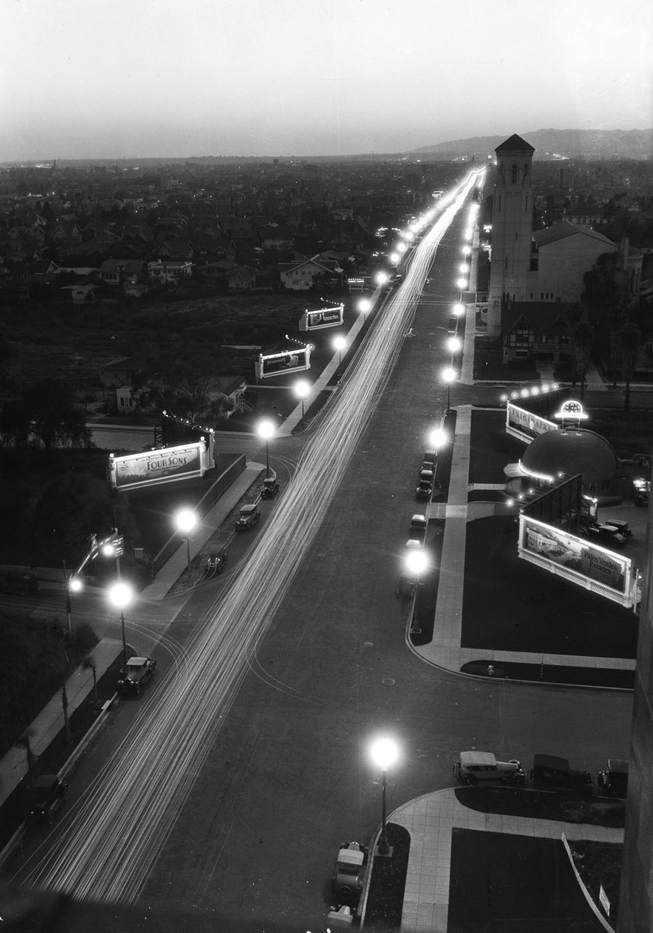 |
|
| (1928)*^ - Aerial evening view of a well lit Wilshire Boulevard. The original Brown Derby restaurant is visible on the right. Note how many signboards on both sides of Wilshire. This photo was taken just after the new "Wilshire Special" streetlights were installed on both sides of Wilshire between Park View and Fairfax Ave. The tallest building in view is the Wilshire Christian Church (today Oasis Church). |
Historical Notes Wilshire Boulevard was designated by The Octagon Museum of the American Architectural Foundation as one of the 'Grand American Avenues'. For nearly a half a century it was decorated with the Wilshire Special pole and lantern along nearly six miles of its length. |
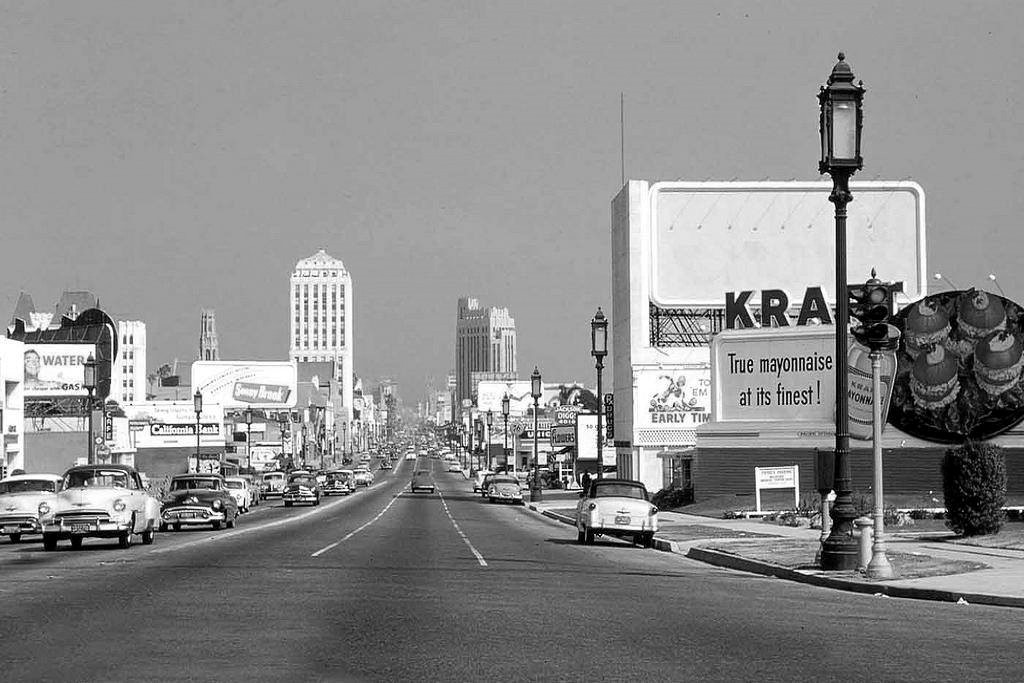 |
|
| (ca. 1952)^.^ – View looking east on Wilshire Boulevard from S. Wilton Place showing “Wilshire Special” streetlights lining both sides of the street. Three tall buildings can be in the distance (l to r): St. James' Episcopal Church, Wilshire Professional Building (N/E corner of Wilshire and St. Andrews) and the Pellissier Building (S/E corner of Wilshire and Western). |
Wilshire Special
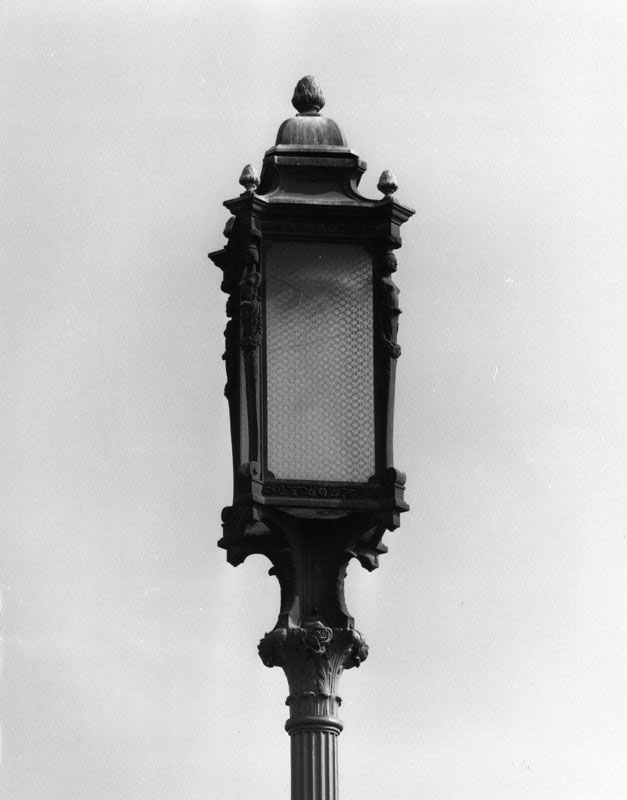 |
(n.d.)* - Close-up view showing a ‘Wilshire Special’ streetlight. Each lantern is guarded by four silent, Thumbelina-sized, bare-breasted women. |
|
Historical Notes The idea of a specialized electrolier for a business district was particularly popular in the late 1920s. The best known was the Wilshire Special, installed in 1928 along Wilshire Boulevard from Park View to Fairfax. In the 1930s these ornate electroliers were also installed on the remaining sections of Wilshire all the way to downtown. Other upscale commercial districts, such as Westwood Village, followed suit with their own special types. |
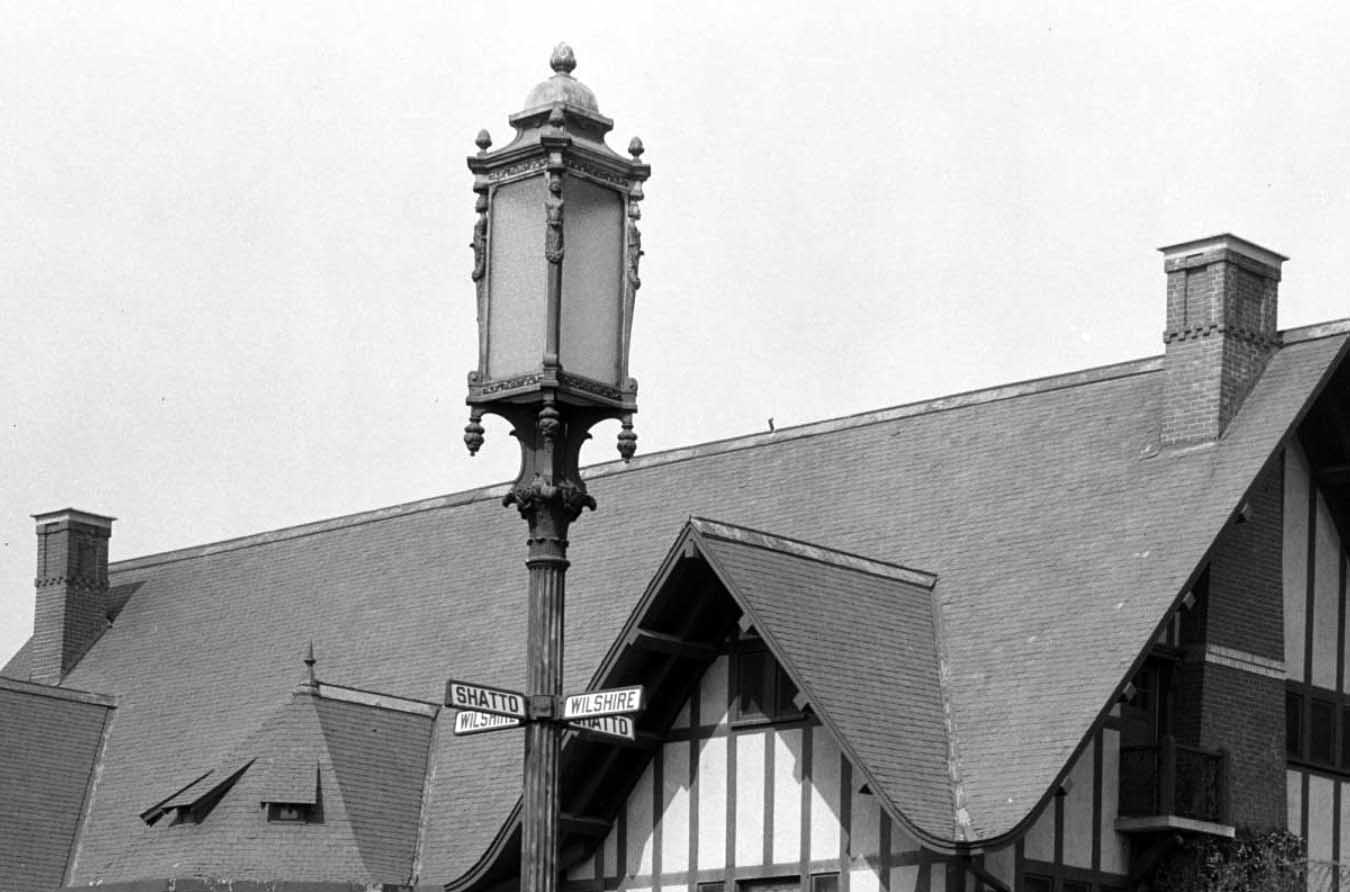 |
|
| (1931)^ – Close up view of a Wilshire Special located on the NW corner of Wilshire Blvd and Shatto Pl. Note how the street signs were attached to the post of the the streetlight. Today a 7-story mixed-use housing building stands at this corner. |
Historical Notes Each lantern is guarded by four silent, Thumbelina-sized, bare-breasted women. |
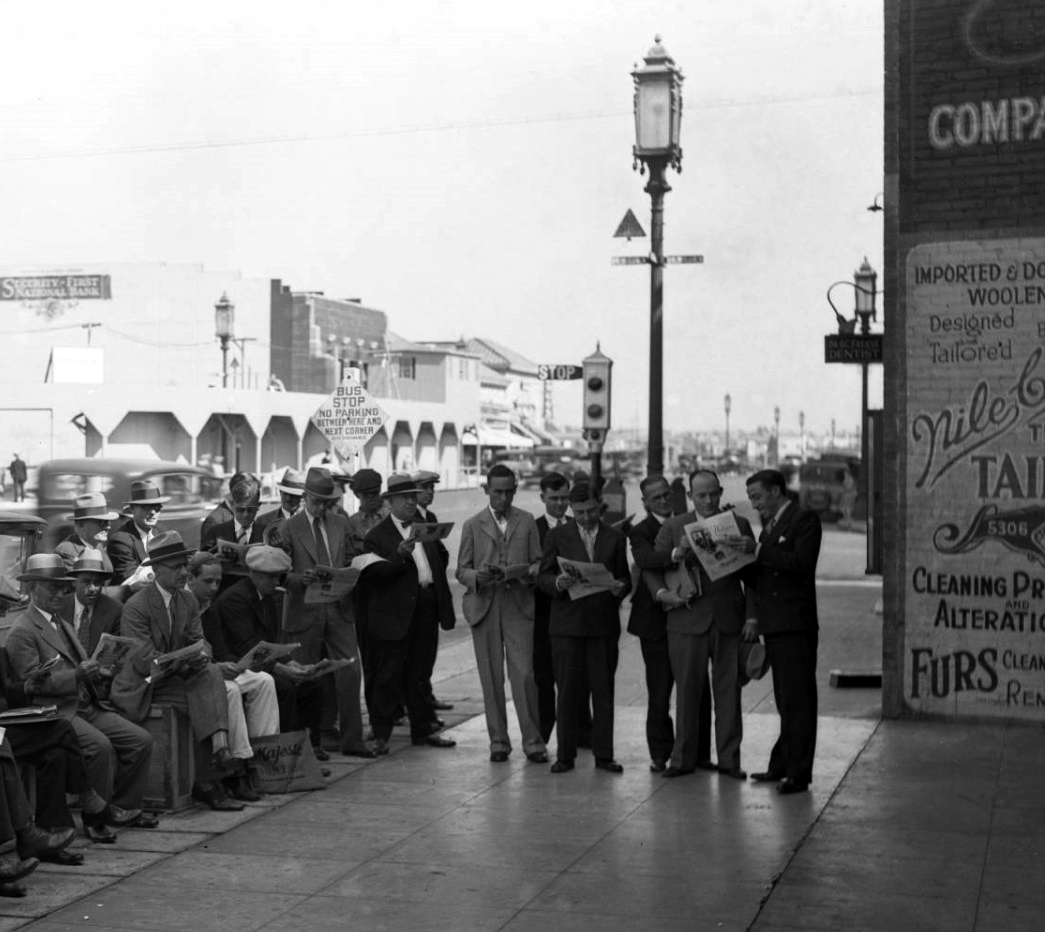 |
|
| (1929)*# - A large group of men, most of whom are reading newspapers, are seen sitting and standing near the SW corner of Wilshire and La Brea. It turns out they are also listening to a live radio broadcast of the World Series in front of Sturgis Radio Store located to the right (out of view). Across the street on the NE corner can be seen the construction site for the new E. Clem Wilson Building where the Gilmore Gas Station once stood. The Art-Deco Security-First National Bank Building sits just to the east of there. Note the "Wilshire Special" streetlights and the Semaphore traffic signal on the corner. |
Historical Notes The above location, SW corner of Wilshire and La Brea, is where the new Purple Line station is being constructed today (2019). Click HERE for contemporary view. |
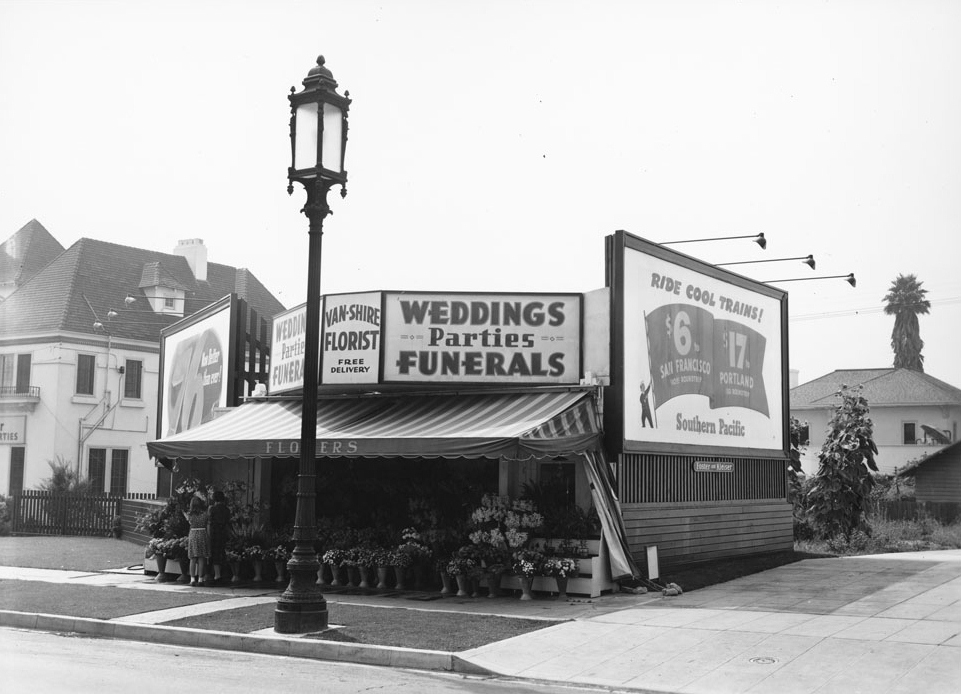 |
|
| (ca. 1928)*# - Close-up of one of the many "Wilshire Special" streetlights that were prevalent along Wilshire Boulevard during the late 1920s and 1930s. The lamp post sits in front of the Van-Shire Florist open-air shop. To the left of the entrance, a young girl and woman look at the arrangements. Bilboards on either side of the shop advertise Union 76 gasoline and Southern Pacific railroad. The sign reads "Ride cool trains! $6 to San Francisco. $17 to Portland". |
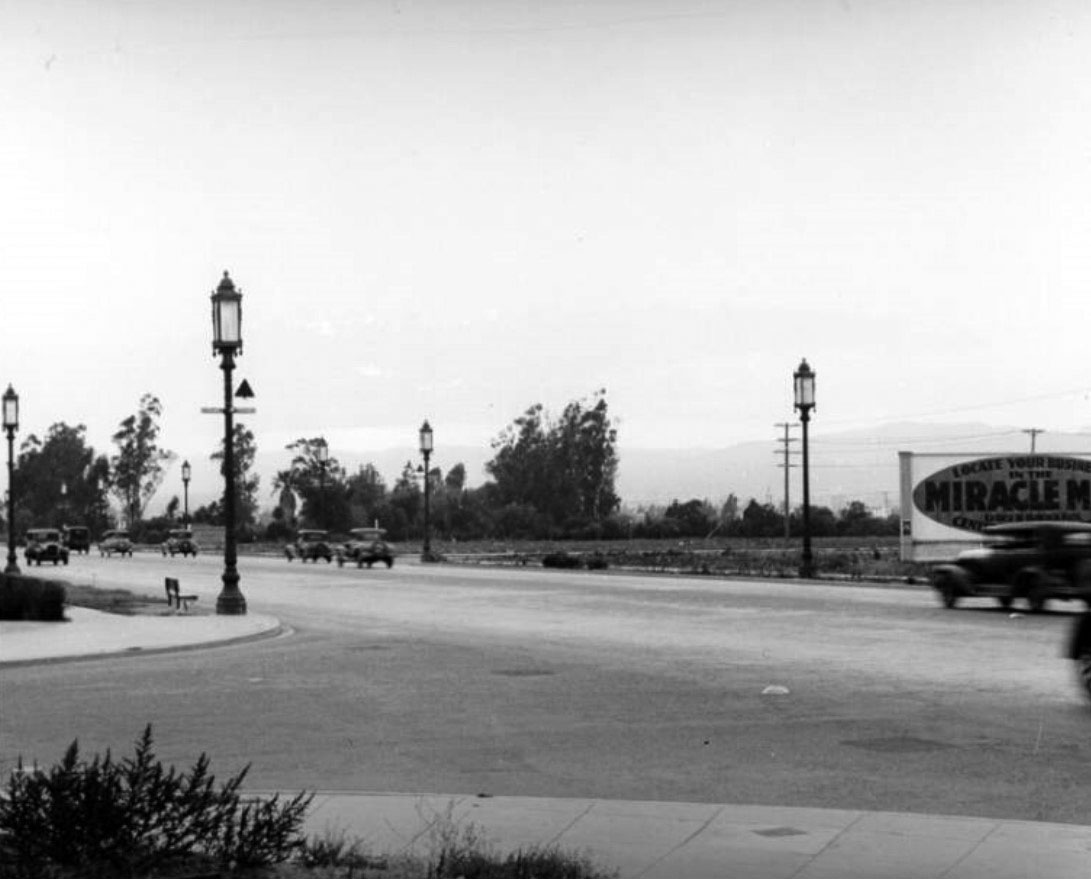 |
|
| (1930s)^ - View of Wilshire Boulevard looking northwest across Masselin Avenue with "Wilshire Specials" lining both sides of the street.. A sign just barely in the picture on the right advertises for businesses to locate in the "Miracle Mile" on Wilshire Blvd. The La Brea Tar Pits can be seen in the distance. |
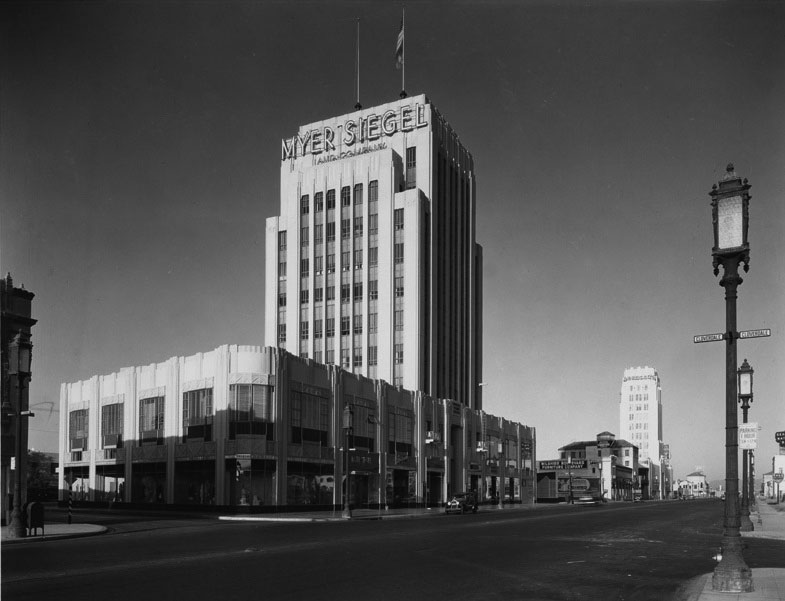 |
|
| (1931)^*# - View is looking west on Wilshire in the Miracle Mile showing Wilshire Special streetlights lining both sides of the Boulevard. On the left is the Dominguez- Wilshire Building (aka Myer Siegel Building) with the Wilshire Tower Building seen in the distance. |
.jpg) |
|
| (1930s)** - A "Wilshire Special" stands tall in front of a men's clothing store, Phelps-Terkel, 5550 Wilshire at Burnside Avenue. |
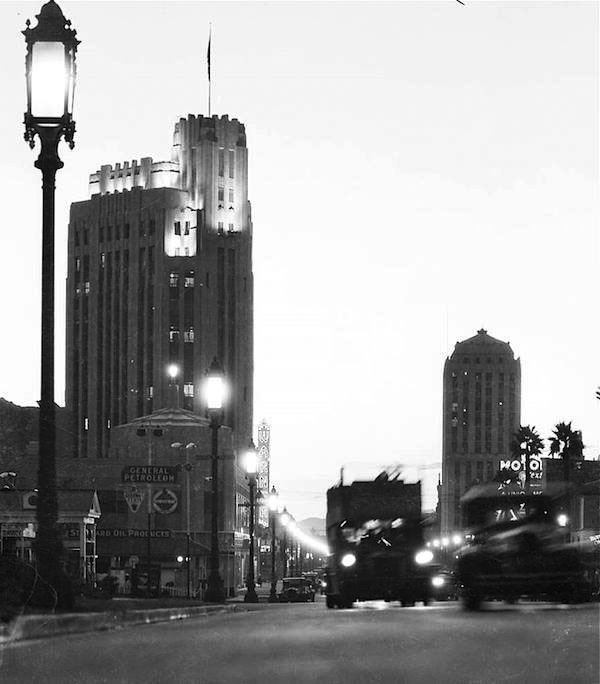 |
|
| (1931)*^ – "Wilshire Specials" light up the street during rush hour traffic. The view is looking west on Wilshire Boulevard with double-decker bus seen heading towards the camera. The Pellissier Building and Warner Theatre (now Wiltern Theatre) are seen lit up on the left. The Wilshire Professional Building is on the right and further back. |
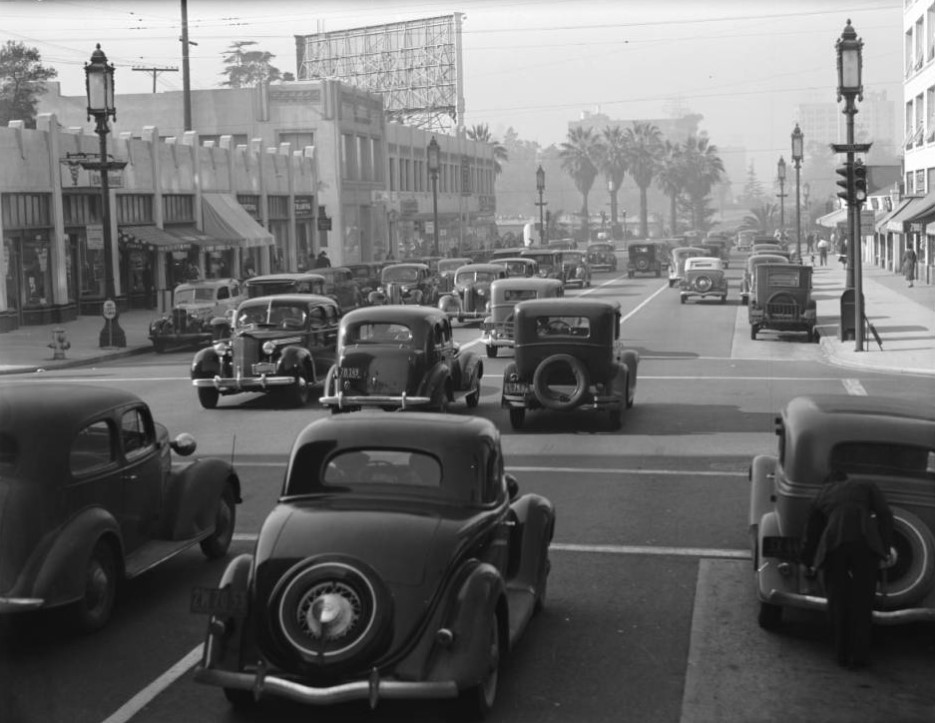 |
|
| (1937)*^- View of Wilshire Boulevard at Bonnie Brae Street looking west toward Westlake Park showing Wilshire Specials lining both sides of the street. These Wilshire Specials were installed in the early 1930s after the street was widened and name changed from Orange Street to Wilshire Boulevard. |
Historical Notes As of 2008, approximately 100 "Wilshire Specials" still remain over the distance of about one-and-a-half miles along Wilshire Boulevard. The original lanterns are solid bronze and stand 7½ feet tall from the base of the lantern to the top of the finial.^^ Click HERE to see contemporary views. |
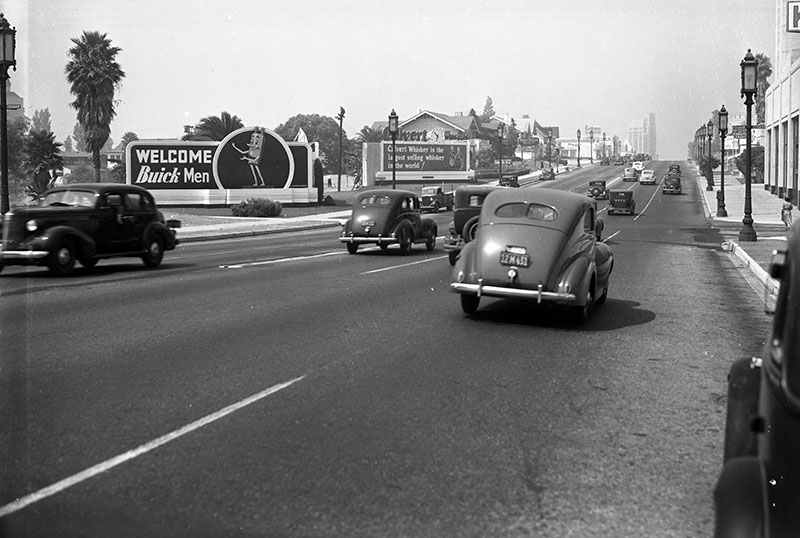 |
|
| (1939)^ - Looking west on Wilshire Boulevard toward Alexandria Avenue with Wilshire Specials lining both sides of the street. Visible are billboards advertising Buick automobiles and Calvert Whiskey, as well as a few homes and commercial buildings; in the distance (upper right) is the Wiltern Theatre. |
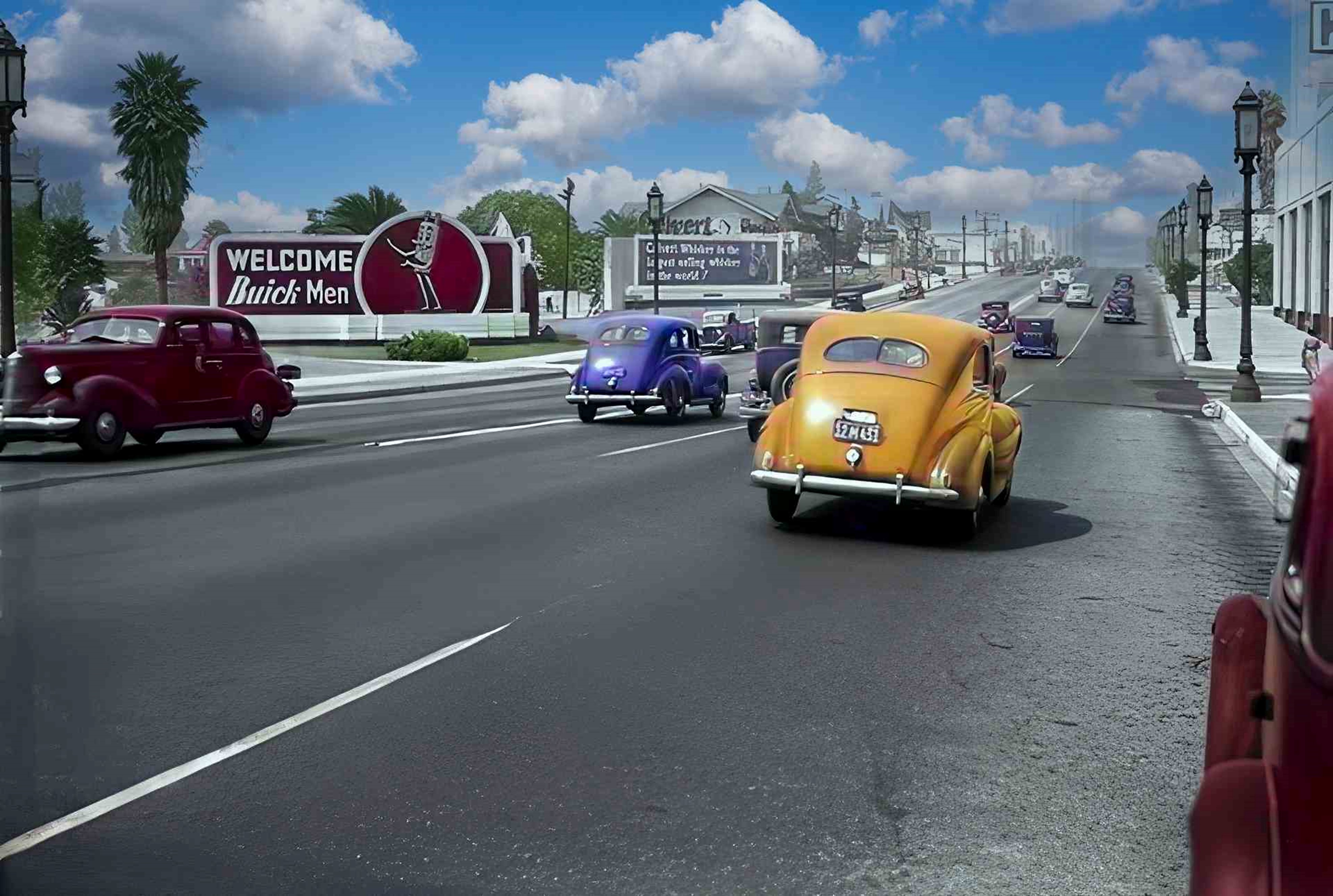 |
|
| (1939)^ - Looking west on Wilshire Boulevard toward Alexandria Avenue with Wilshire Specials lining both sides of the street. Visible are billboards advertising Buick automobiles and Calvert Whiskey, as well as a few homes and commercial buildings; in the distance (upper right) is the Wiltern Theatre. Image enhancement and colorization by Richard Holoff. |
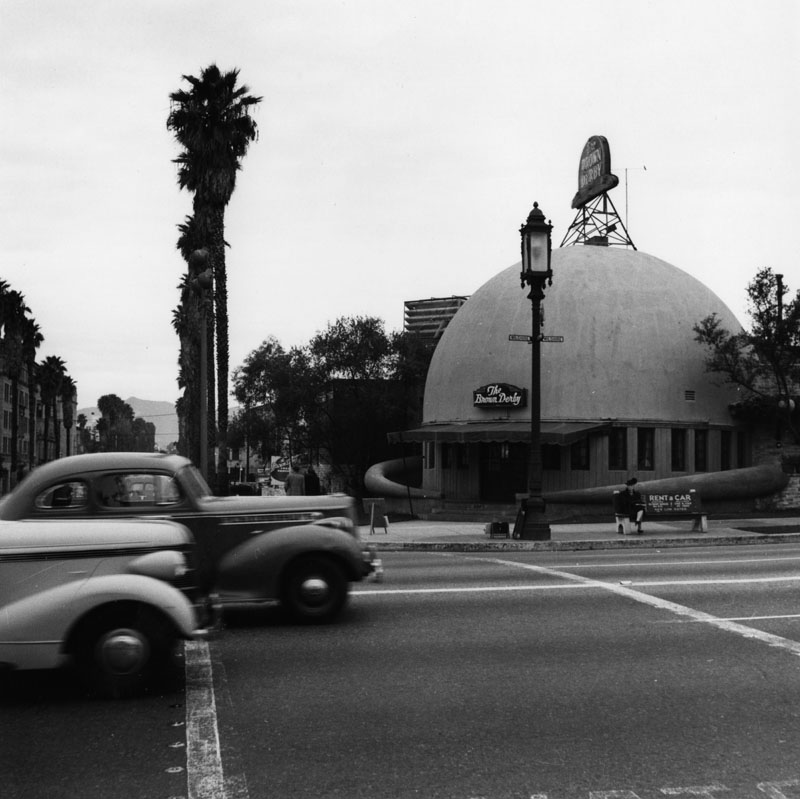 |
|
| (ca. 1940)^ - Cars travel east down Wilshire Boulevard, where it crosses S. Alexandria Avenue (left), right outside the Brown Derby Restaurant. An original "Wilshire Lantern" street light is seen on the corner. |
Historical Notes After being sold in 1975 and renovated, the Brown Derby Restaurant was finally replaced in 1980 by a shopping center known as the Brown Derby Plaza. The domed structure was incorporated into the third floor of the building and accommodates a cafe. A Korean mini-mall occupies the site today. The Brown Derby chain included restaurants in Hollywood, Beverly Hills, and the Los Feliz area. The Los Feliz Brown Derby at 4500 Los Feliz Blvd is the last remaining branch of the chain still extant and in operation.^* |
* * * * * |
Bridge Lighting
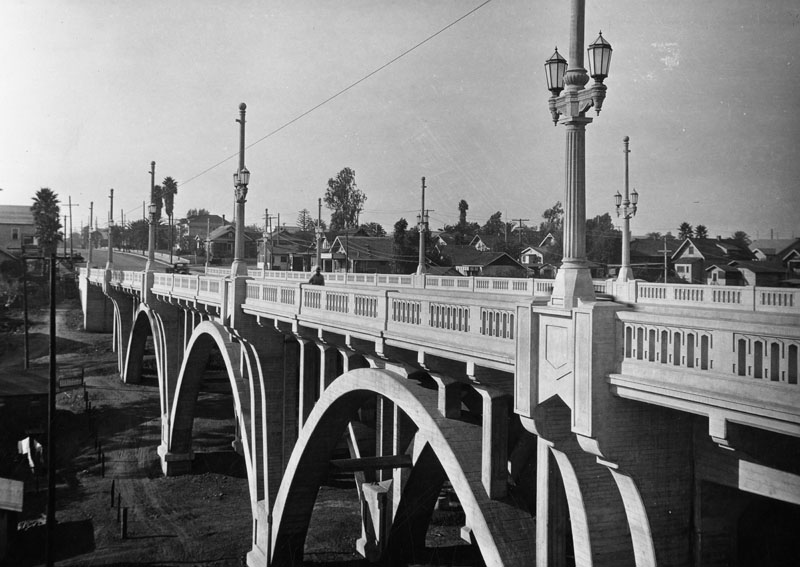 |
|
| (1928)^ - View of the ornate two-lamp electroliers on the arch bridge located at Fourth and Lorena Streets in Boyle Heights, not long after in was built in 1928. The bridge, a declared city of Los Angeles historic monument, No. 265 (Click HERE to see the LA Historic-Cultural Monuments List), is located in a residential neighborhood, as indicated by the various homes present in the background. The electroliers shown here are the same design as those used on the 1st Street Birdge seen in previous photo. |
Historical Notes Special ornamentation was common on bridges constructed between 1900 - 1925. These poles serve two purposes: 1) to hold the decorative streetlight lantern and 2) to support the overhead wire for the Los Angeles Railway (LARy) streetcars that used this viaduct.^^ |
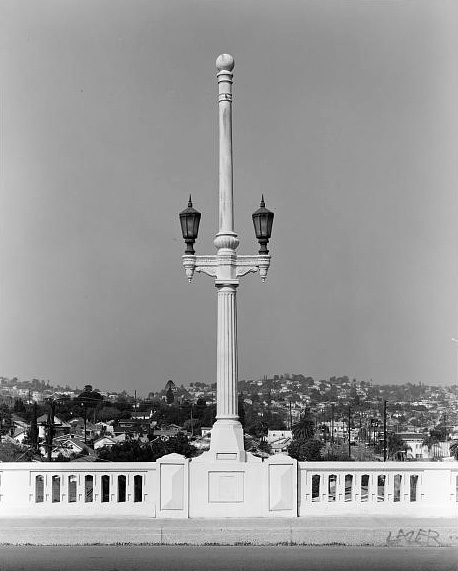 |
|
| (2001)#* - View looking north/northeast showing the ornamental lamp detail on the Fourth and Lorena Street Bridge. |
Historical Notes See More Bridge Lighting (College Street Bridge; First Street Bridge; Fourth Street Viaduct; Fourth and Lorena Streets Bridge; Glendale-Hyperion Bridge; Macy Street Bridge; Mulholland Bridge; Sixth Street Bridge; Washington Blvd Bridge) |
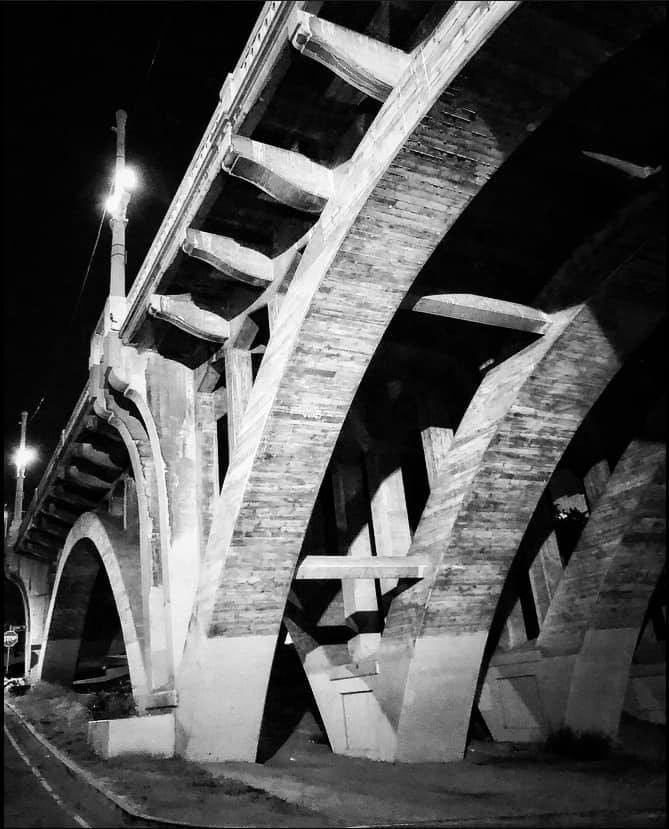 |
|
| (2022)* - Looking up toward the ornamental dual-lamp streetlights on top of the Fourth and Lorena Street Bridge from underpass. Photo by Carlos G. Lucero |
* * * * * |
Downtown
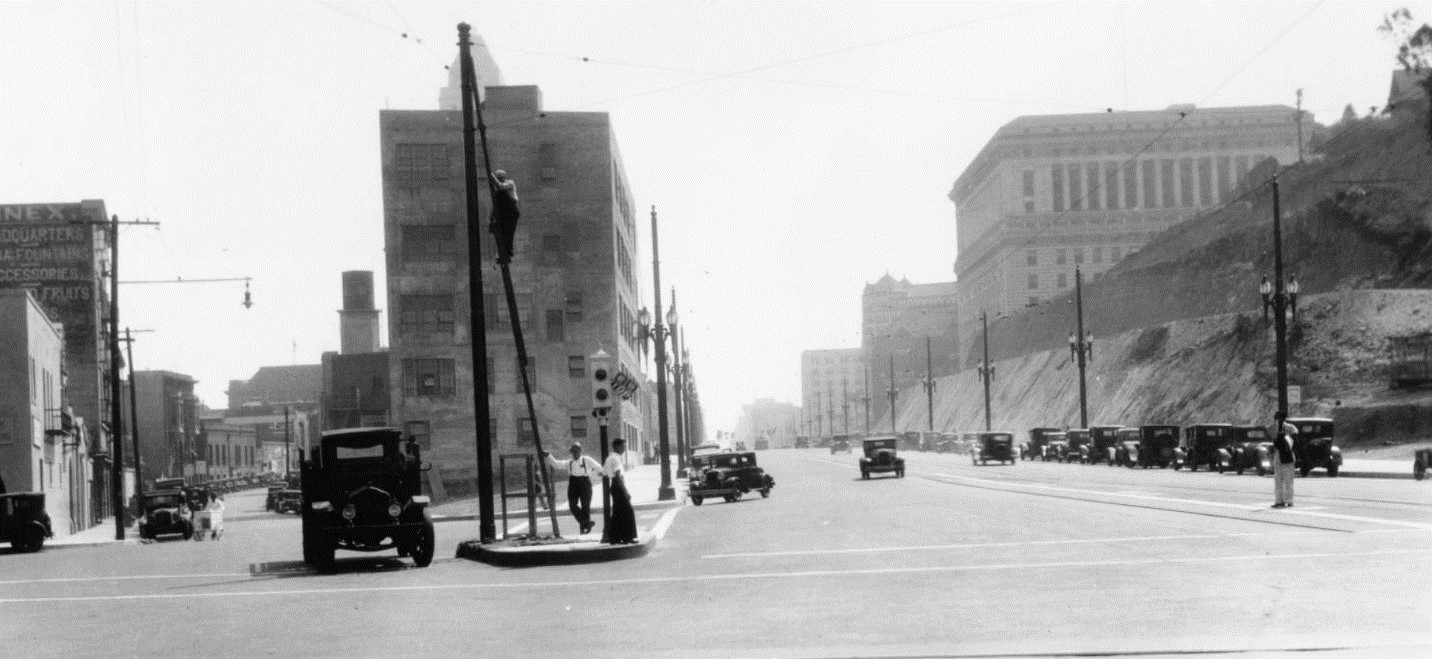 |
|
| (ca. 1928)*^ – View looking south on Spring Street from Sunset Boulevard. Two-lamp streetlights hanging almost at mid-post extend down both sides of Spring Street. The posts are also used to support the streetcar wire. A man is seen climbing a pole without streetlights that supports streetcar cables. |
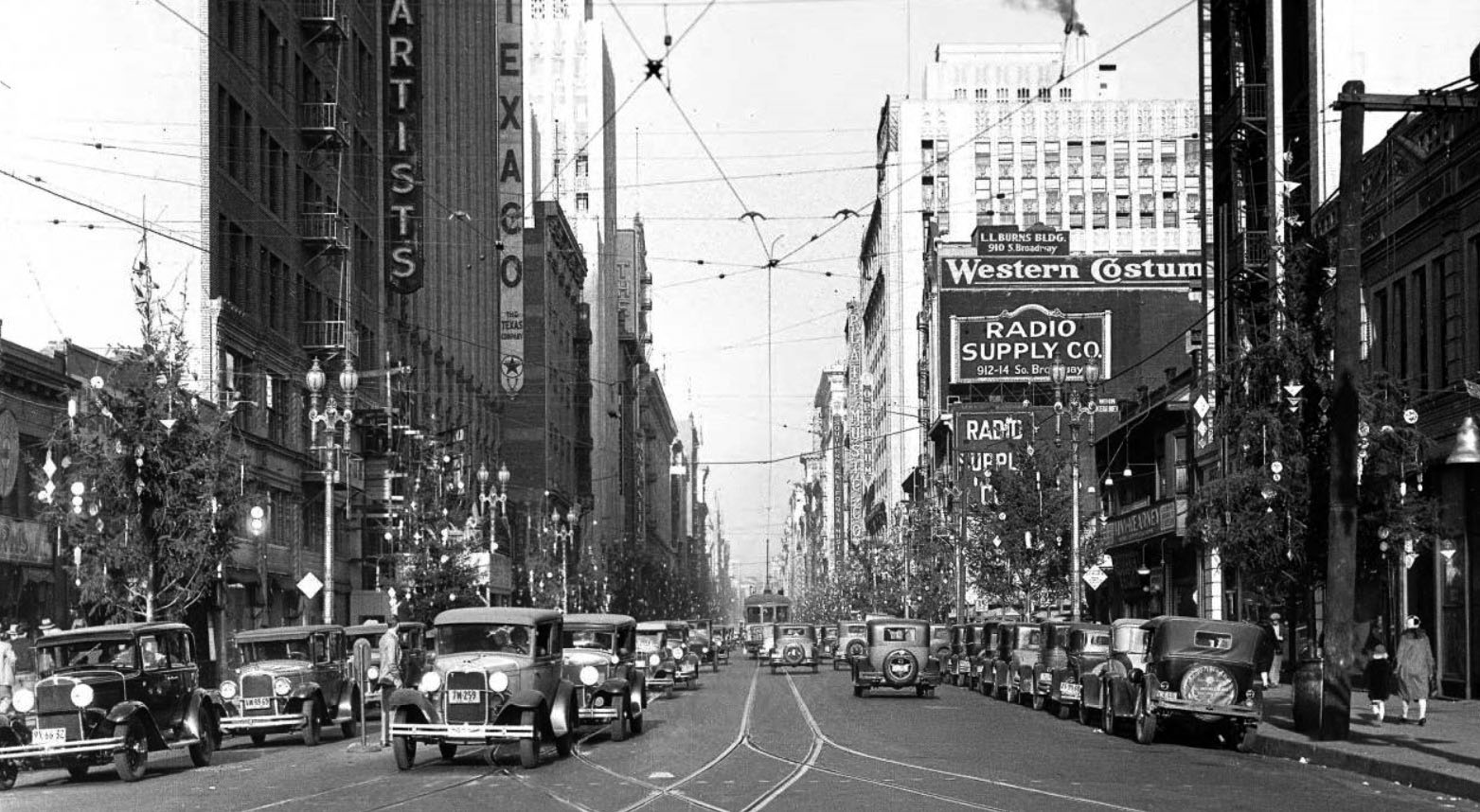 |
|
| (ca. 1930)*^ – View looking north on Broadway from just north of 10th Street (later Olympic Boulevard*). The United Artists Theater Building is at left along with the Texaco Building. The streets are aligned with dual-lamp streetlights and Christmas trees. |
Historical Notes *In 1932, the entire length of the 10th Street, from East L.A. to Santa Monica, was renamed Olympic Boulevard for the Summer Olympics being held in Los Angeles that year.^* |
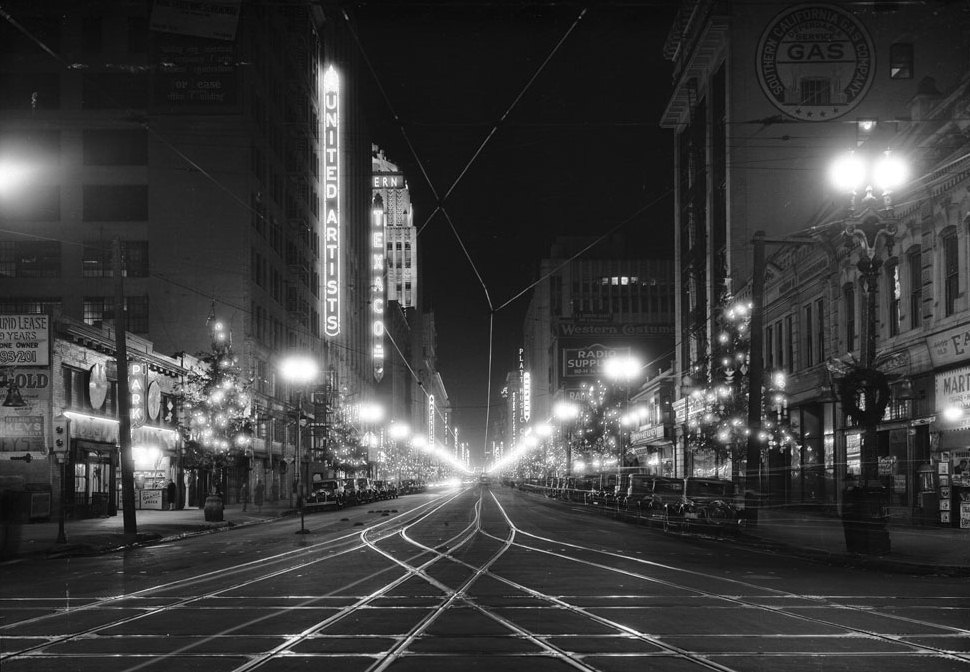 |
|
| (1930)*^ – View looking north on Broadway from 10th Street (now, Olympic Boulevard). The street is illuminated by streetlights, electric signs, and lights on the Christmas trees. |
* * * * * |
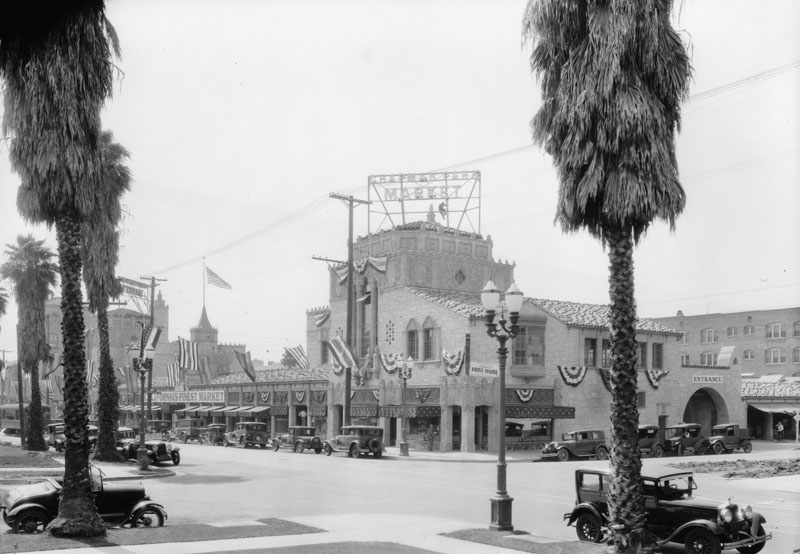 |
|
| (ca. 1929)^ - Double-lamp electroliers stand on the corner of West 6th Street and Alexandria Avenue. Chapman Park Market can be seen across the street. |
Metropolitan Streetlight Standard (Hollywood)
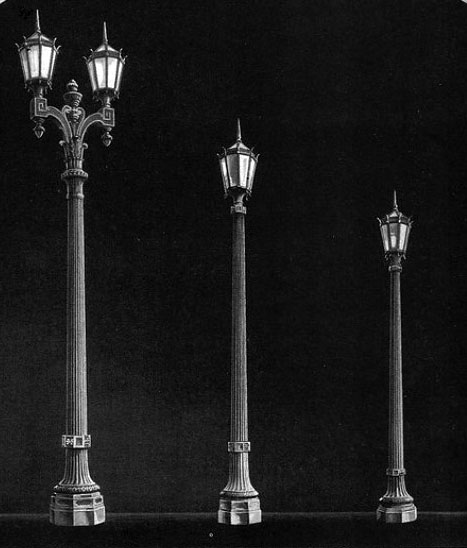 |
|
| (1925)^ - From a page in their 1925 Union Metal Manufacturing Co. Catalog: "The Metropolitan Family”. From left to right: Two Light Business District Standard, Business or Semi-Business District type of Standard, and Residential and Parkway Standard. |
Historical Notes The "Metropolitan" models were developed especially for Hollywood, but ultimately found their way onto the "best" streets of surrounding communities. |
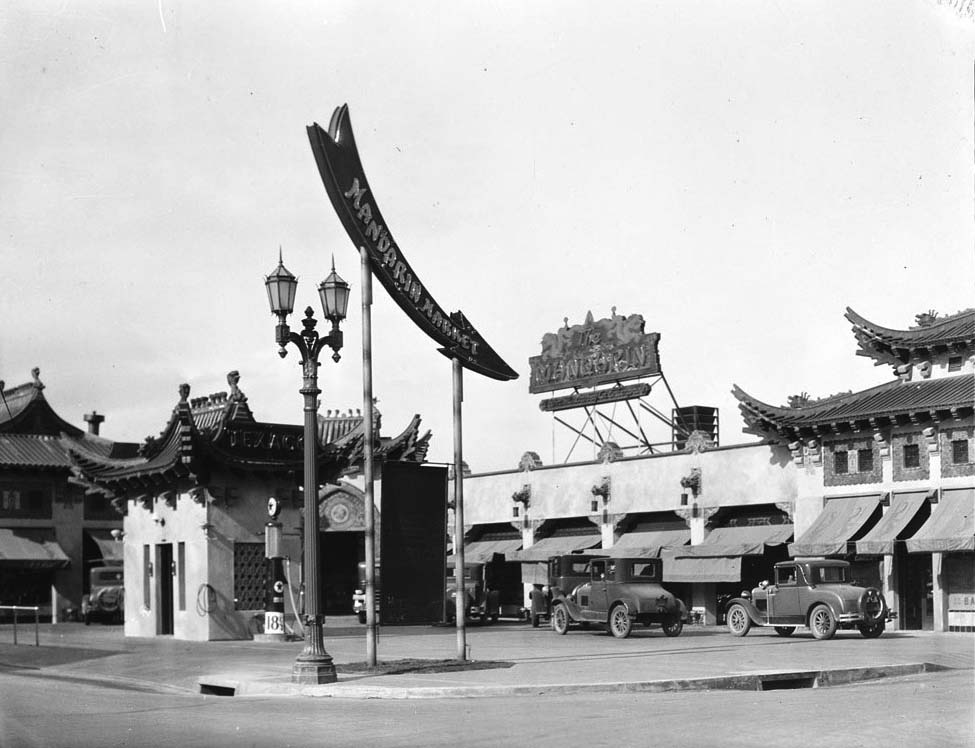 |
|
| (ca. 1929)* - View of the ornate two-lamp 'Metropolitan' electrolier in front of the Mandarin Market located on the northeast corner of La Mirada Avenue and Vine Street. |
Historical Notes In the late 1920s and 1930s, many of this type of streetlight were installed in various parts of the City, but none more than in the Hollywood area. |
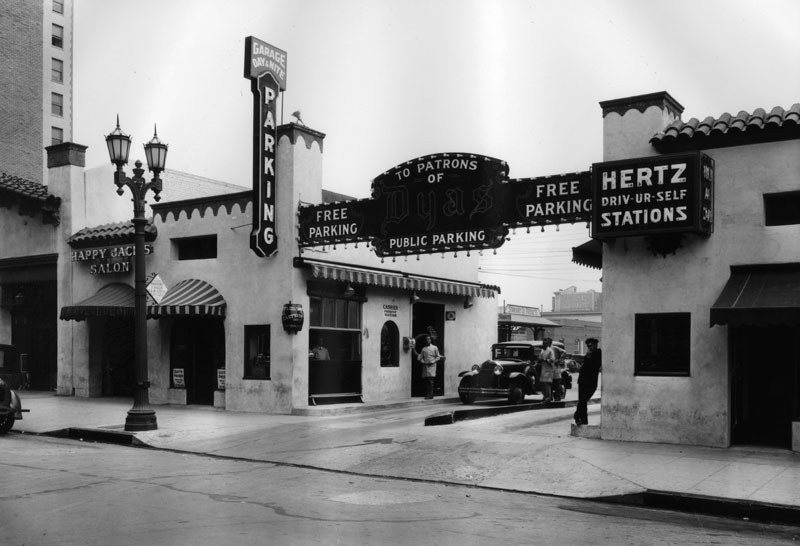 |
|
| (1930)* - A two-lamp Metropolitan streetlight in front of th Hollywood-Vine service station and parking garage. |
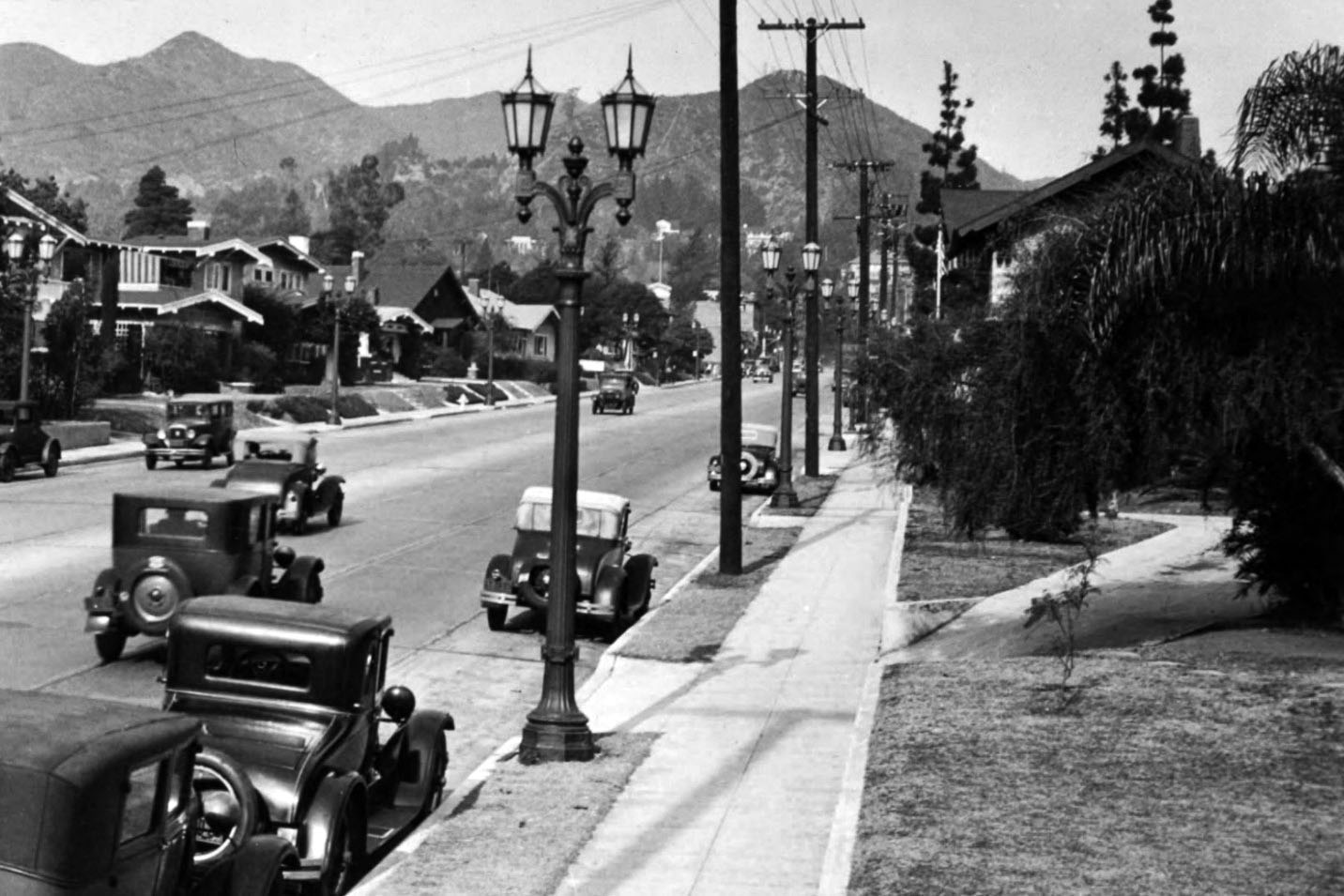 |
|
| (1932)* – View looking north on La Brea Ave from Sunset Boulevard showing Metropolitan Streetlights lining both sides of the street. Click HERE for contemporary view. |
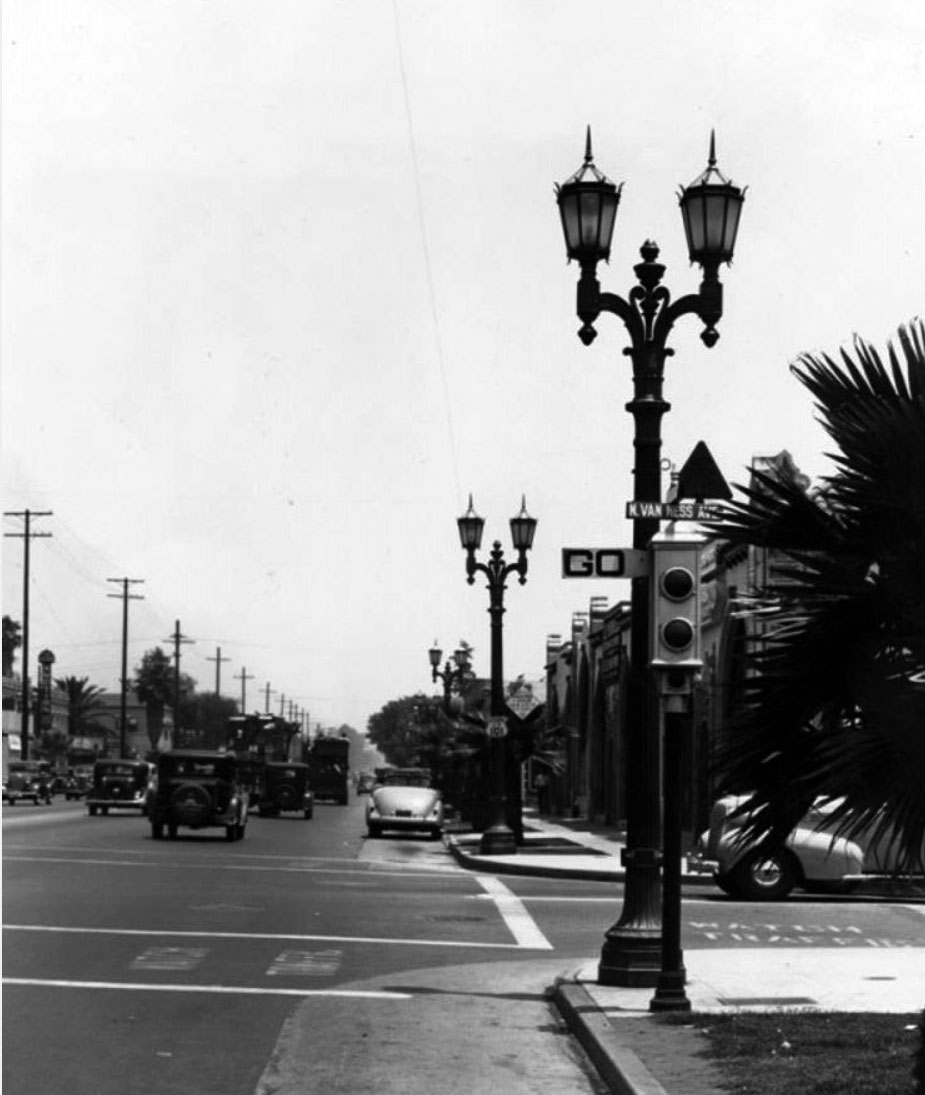 |
|
| (ca. 1937)* – View looking east on Sunset Boulevard at Van Ness Avenue showing early traffic signal and dual-lamp Metropolitan street lights that was common in the Hollywood area since the late 1920s. |
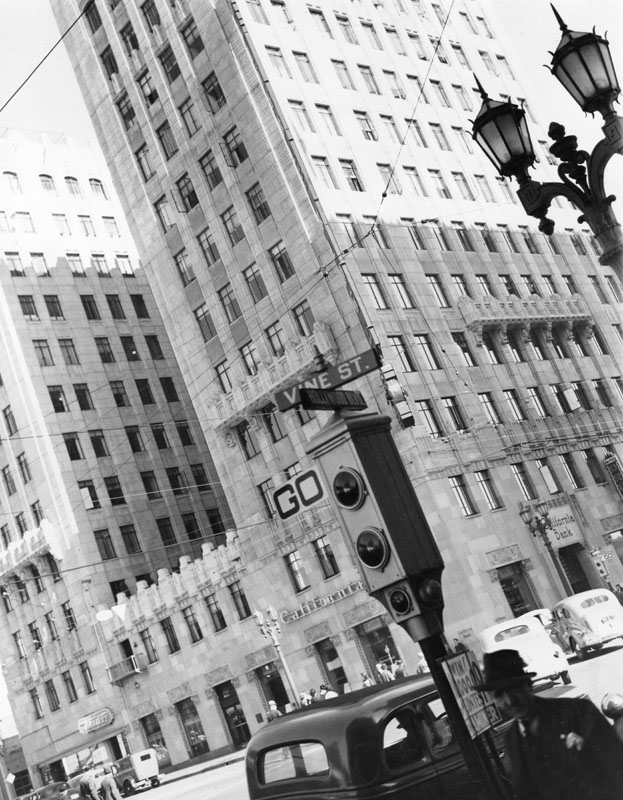 |
|
| (1938)^ - Traffic signal and Metropolitan Streetlight at Hollywood and Vine, looking northeast, with the Equitable Building in the background. |
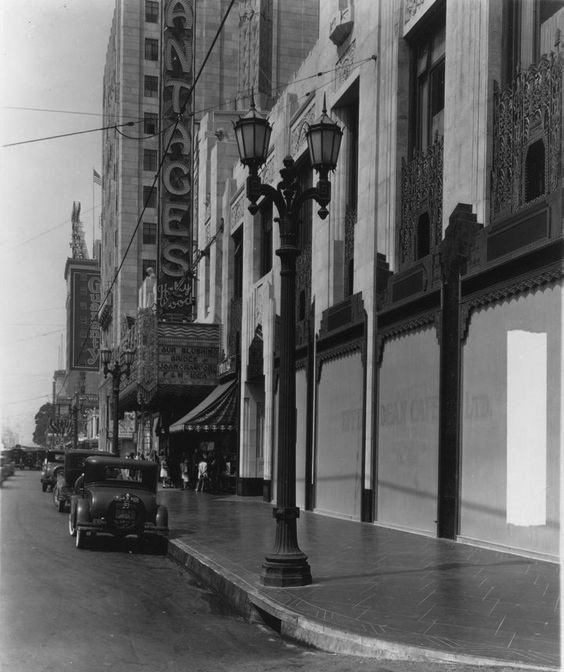 |
|
| (1930s)^ - Street view looking west on Hollywood Boulevard from Argyle Avenue showing Metropolitan Electroliers lining the street in front of the Pantages Theatre. The intersection of Hollywood and Vine is in the distance. |
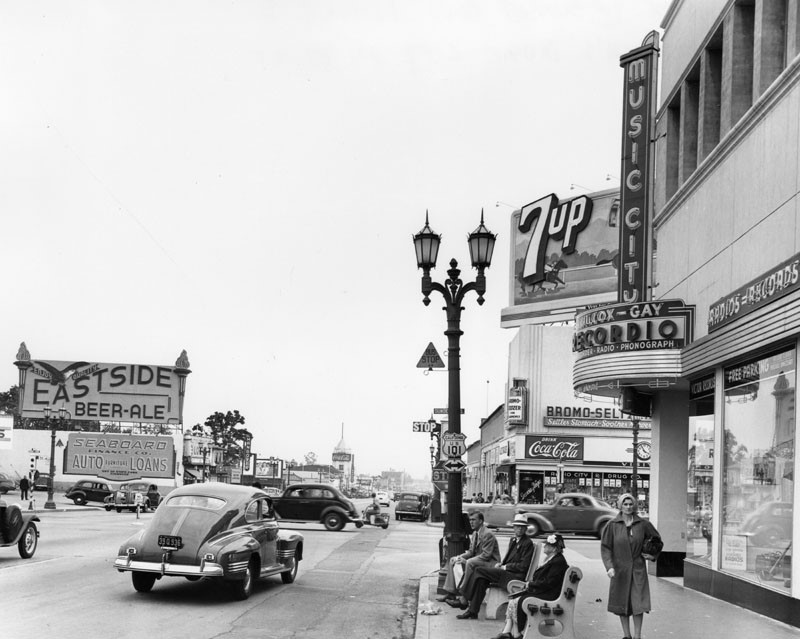 |
|
| (ca. 1945)* - Looking south on Vine Street at Sunset Boulevard showing a Metropolitan Streetlight standing on the NW corner in front of Wallichs Music City. |
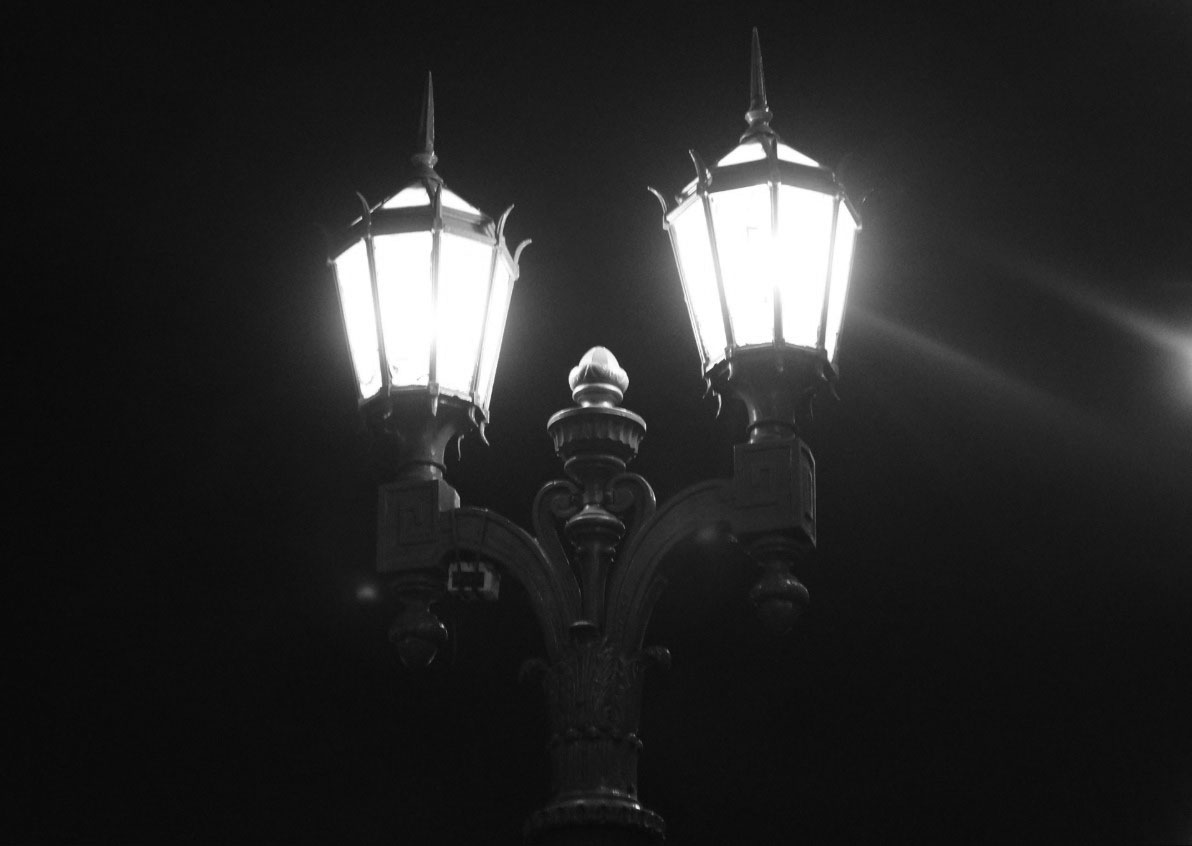 |
|
| (2017)^ – Close-up view showing a two-lamp ‘Metropolitan’ streetlight located on Ivar Street, just south of Hollywood Blvd. Photo courtesy of Glen Norman |
Historical Notes The ‘Metropolitan’ is still quite common in Hollywood. They started to appear around 1924 and are celebrating their 95th Anniversary this year (2019). |
'Pacific' Dual Lamp Streetlight (UM-1747)
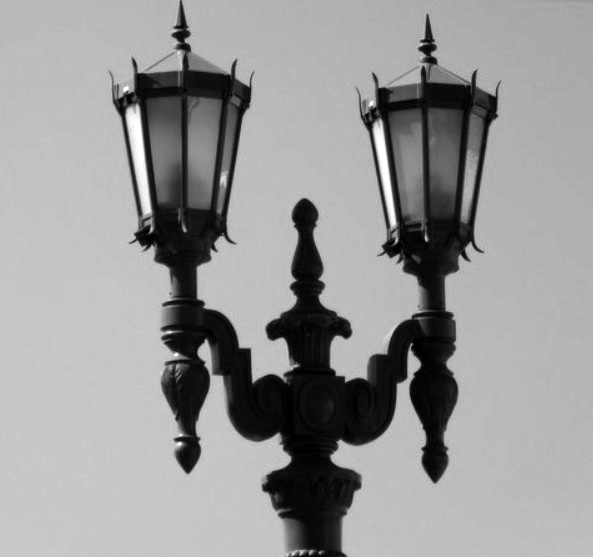 |
|
| (2019)^ - View showing a UM 1747 'Pacific' dual-lamp Electrolier located on Pico Boulevard west of Downtown L.A. This is from Union Metal's Pacific Line. It's a replica of the original UM's installed in the 1920s (see next photo). The 'Pacific' looks similar to the 'Metropolitan' seen in previous photo. |
Historical Notes This street light was installed around 2014. Manufactured by Union Metal (‘Pacific’ line), the same company that manufactured the circa 1920s originals (which can still be found West of Robertson). |
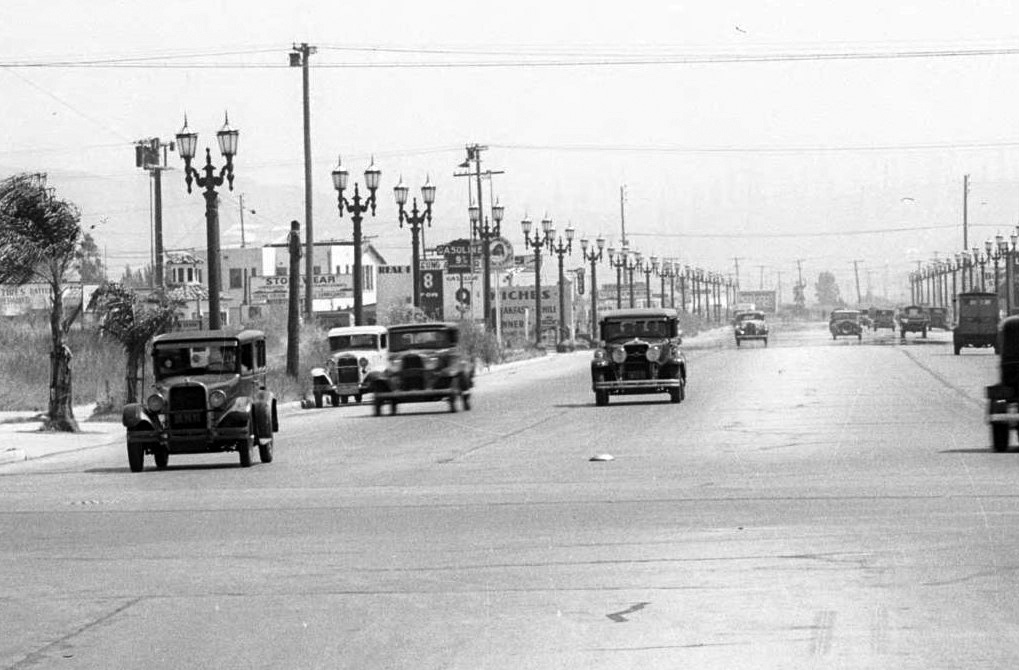 |
|
| (1935)* - View looking south on La Cienega at Pico Boulevard showing a dual-lamp Union Metal "Pacific' streetlights lining both sides of the street. |
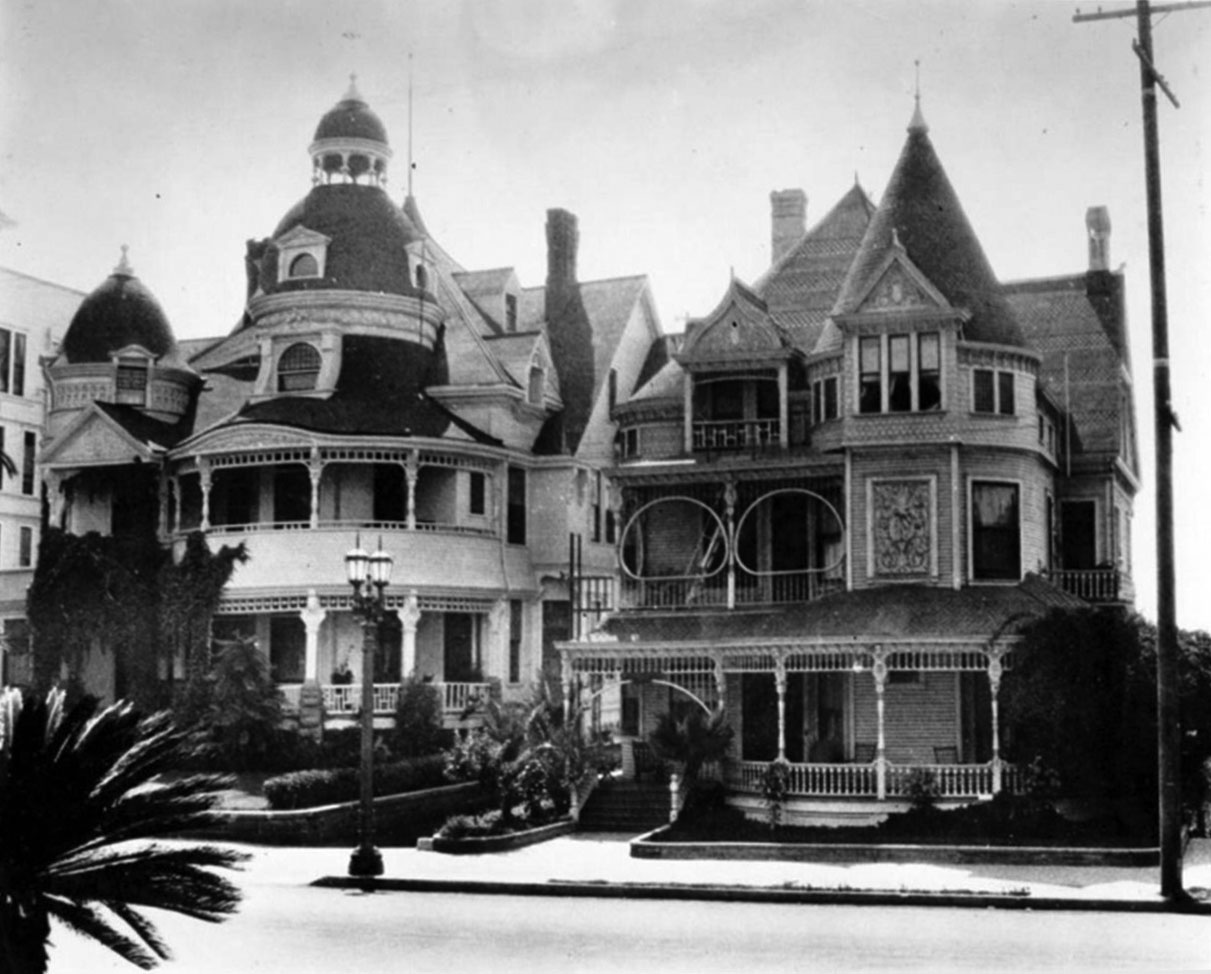 |
|
| (ca. 1930s)^ - View from across the street on Bunker Hill of two Victorian style hotels on the 100 block of S. Grand Ave., the Richelieu (at 142) on the right and the Hotel Melrose (at 130) on the left. A dual-lamp 'Pacific' stands in front of the buildings. |
Historical Notes If still standing today, the view from the porch of these buildings would be that of Disney Hall, located directly across the street, on the other side of Grand Ave. Click HERE to see more in Early LA Historic Buildings (1800s). |
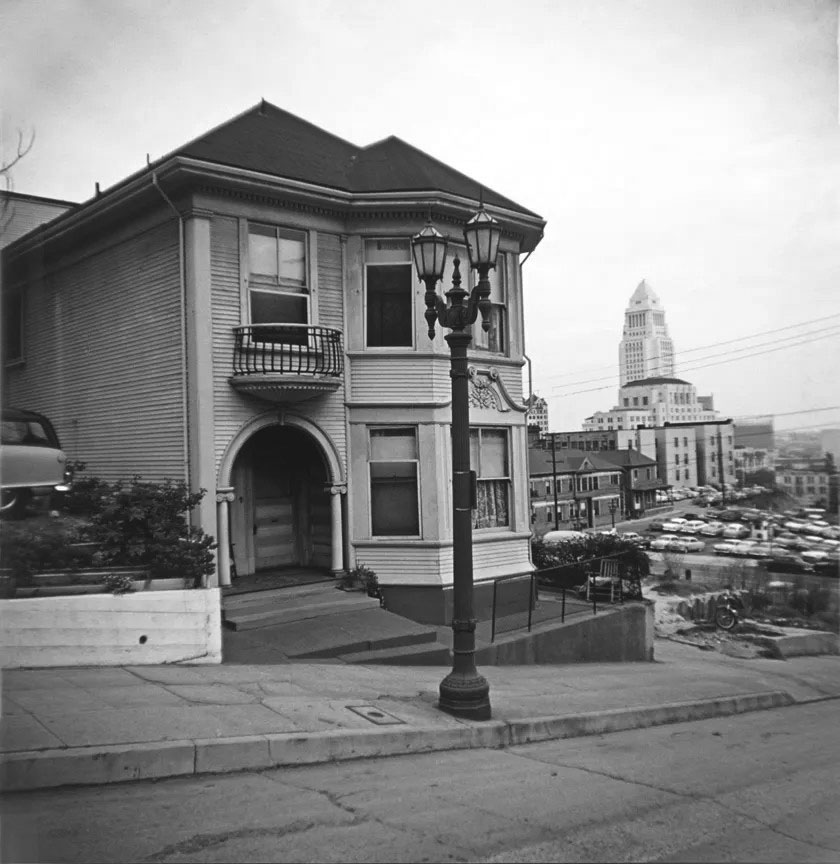 |
|
| (ca. 1965)* – A decorative dual-lamp ‘Pacific’ (UM-1747) stands in front of the Koster House, a Queen Anne style residence at 507 W. Second Street on Bunker Hill. The Los Angeles Times Building, and City Hall are seen in the distance on the right. |
Historical Notes The above street light is a Union Metal UM-1747 "Pacific" model with GE Form 18-B lanterns. They were found all over Bunker Hill until the neighborhood was bulldozed into oblivion. Only one Bunker Hill example survives as of 2021. It's on the East side of Olive Street, just South of 4th Street. Click HERE to see more 'Pacific' UM 1747 dual-lamp streetlights (Contemporary Views) |
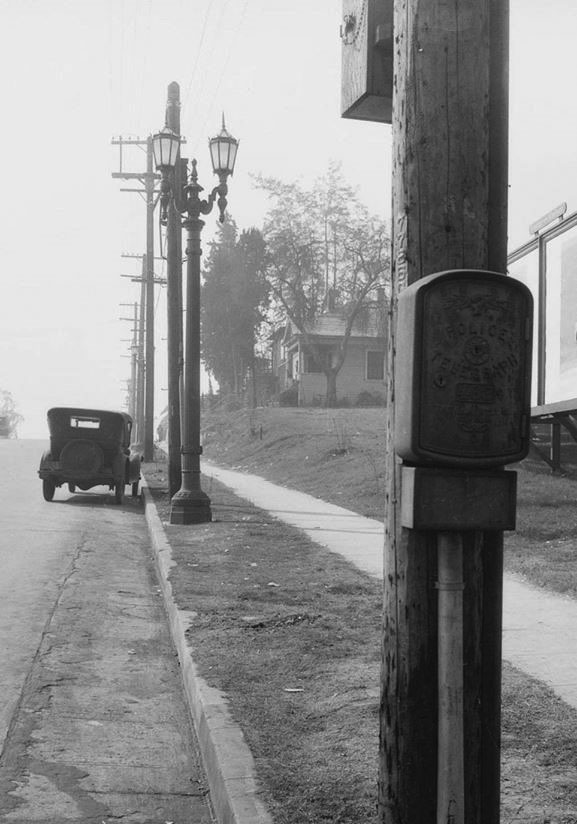 |
|
| (1930)^ – View looking south on Alvarado Street at Temple Street showing a Police Call Box mounted on a power pole in the foreground with an ornate two-lamp 'Pacific' (UM 1747) streetlight seen in the background. |
Historical Notes The LAPD installed call boxes in 1903. Before that, officers had to go to headquarters on foot with a message, or headquarters had to send a runner to find them. Call boxes let officers check in at intervals, using a key to unlock the box. Later—probably in the Thirties—dial telephones replaced the direct lines. And much later, walkie-talkies made call boxes obsolete.* |
* * * * * |
Streetlight Time Switches
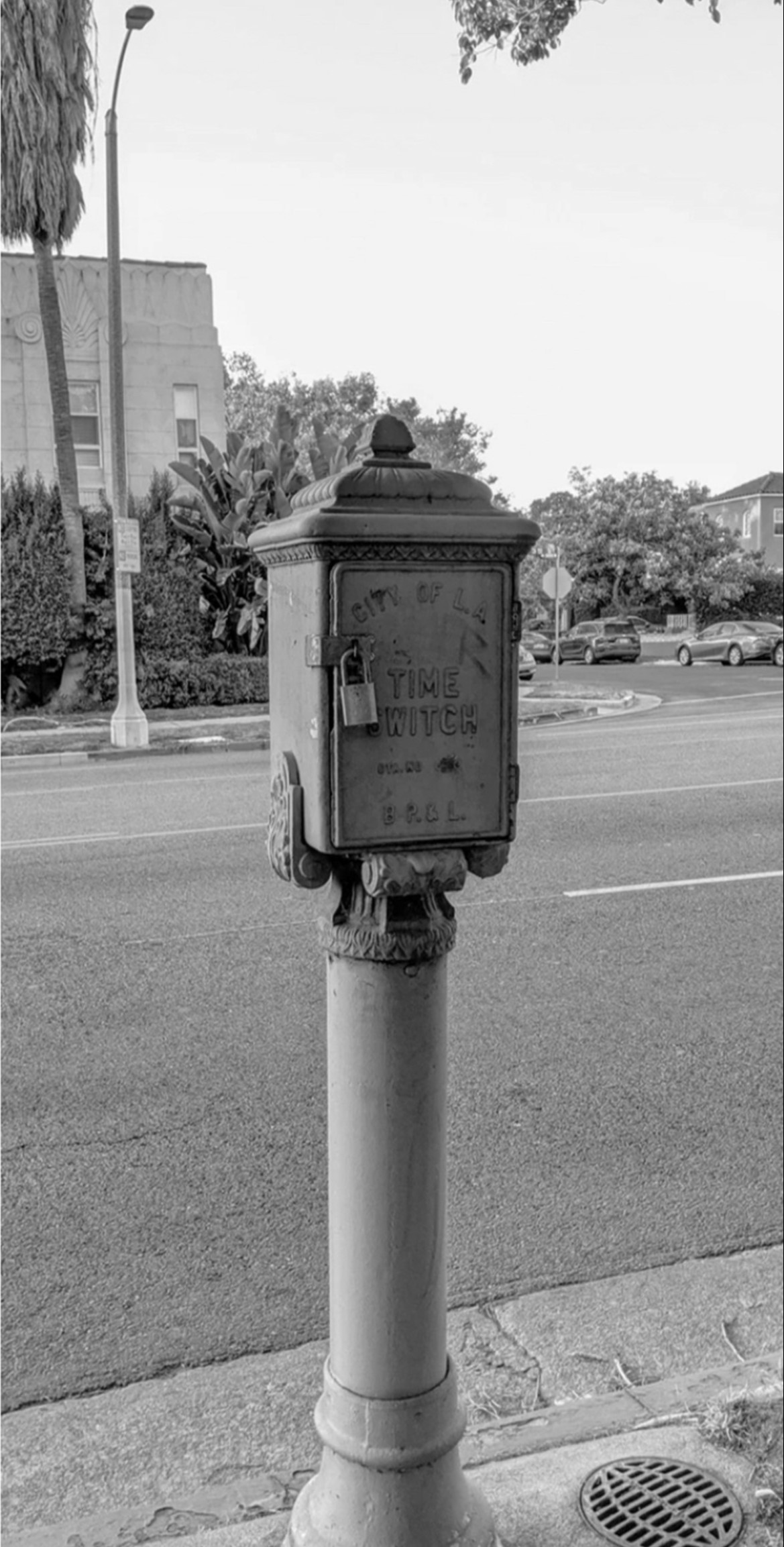 |
|
| (ca. 2010s) - An old LA Bureau of Power and Light streetlight time switch is seen here at 3rd Street and Mansfield Avenue. Photo courtesy of Michael Navarro |
Historical Notes Both high voltage and low voltage time switches were installed in the early part of the 1900s by the Bureau of Power and Light. These were used to control streetlight electrolier circuits through the city. Some of these still exist today. |
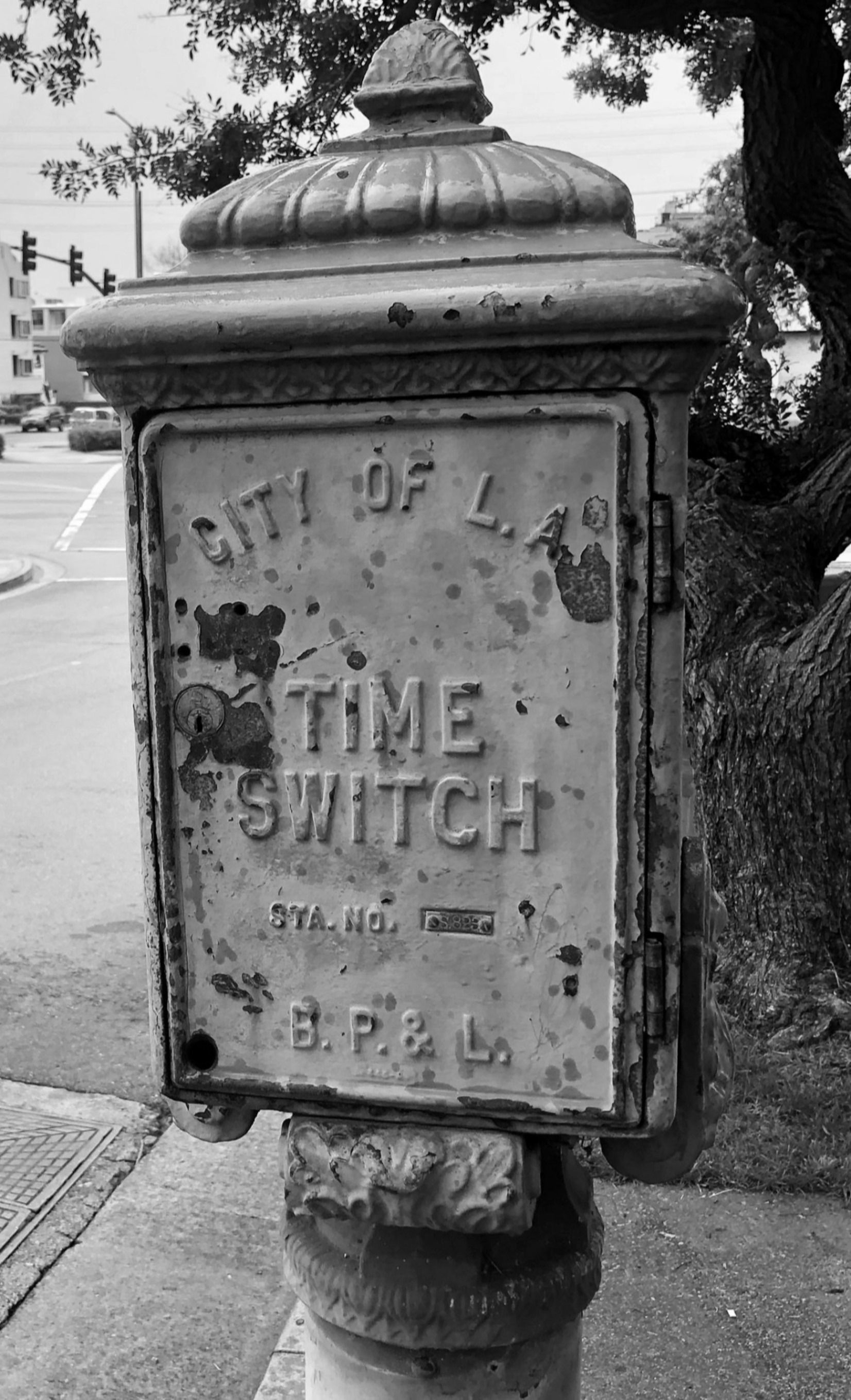 |
|
| (ca. 2010s) - Close-up view of a streetlight time switch installed by the L.A. Bureau of Power and Light in the early 1900s. Photo courtesy of Michael Navarro |
Historical Notes The keystone Iron Steelwork Company from Los Angeles (1917-1928) made fire alarm/police call boxes, streetlight time switches, and fire hydrants. Some streetlight time switches are still in service while others are not but remain for historical value throughout the city. More detailed information can be found on these time switches in a 1947 DWP Streetlight Manual (Page 24). |
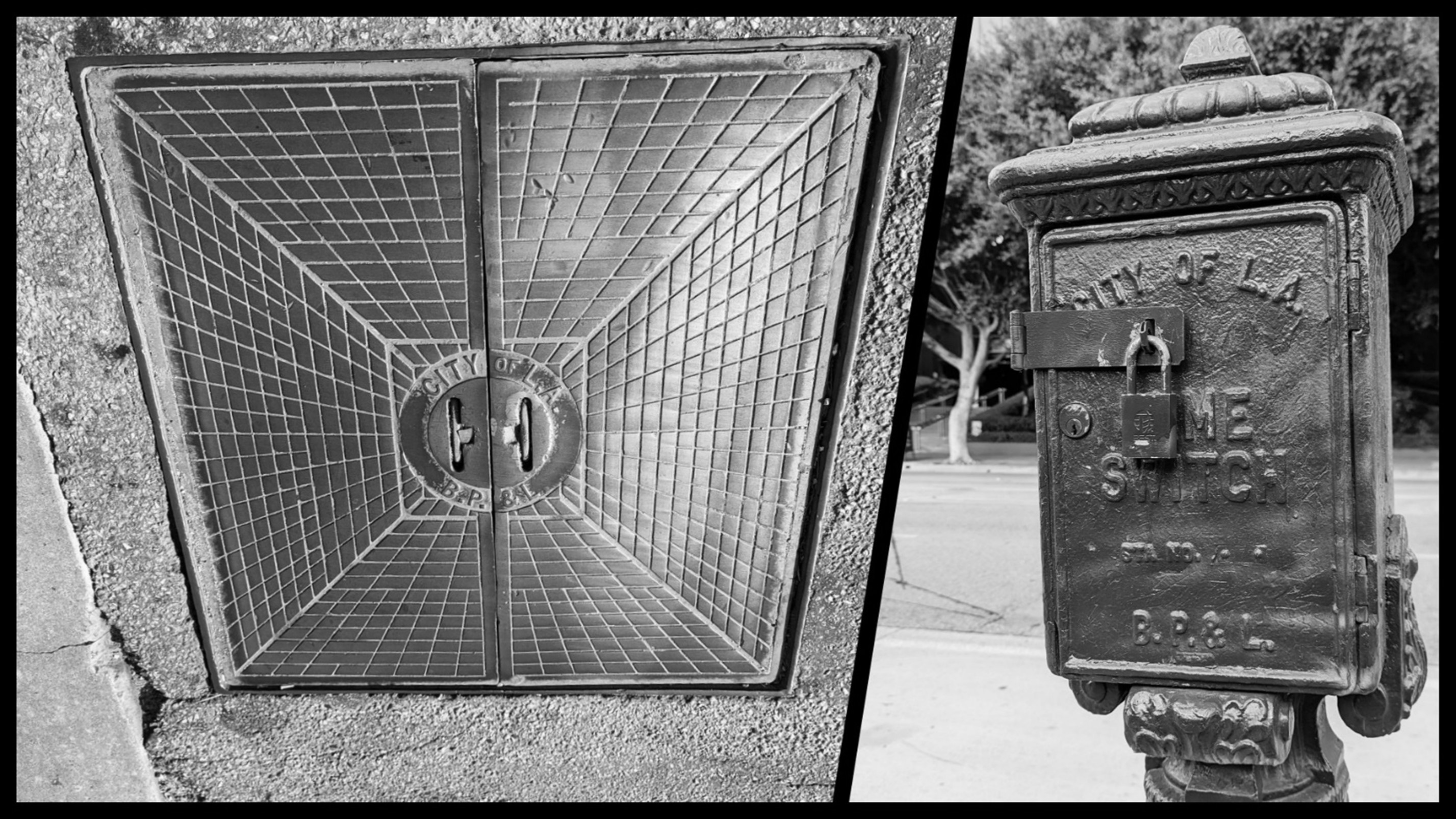 |
|
| (2023)* - An old LA Bureau of Power and Light manhole cover (left) and time switch pedestal (right) located on Wilshire Boulevard. Photo Courtesy of Esotouric's Secret Los Angeles |
* * * * * |
The Winslow (Five-Globe Llewellyn Electrolier)
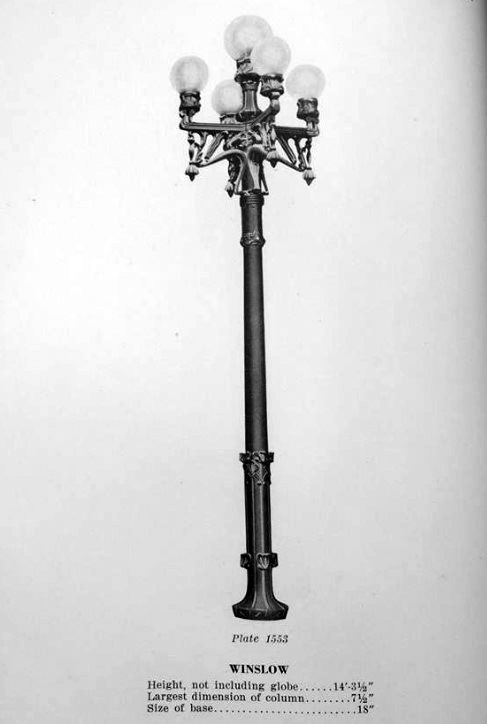 |
|
| (1928)^ - The "Winslow" electrolier shown here in the 1928 Llewellyn Iron Works Catalog. This streetlight was found on Hill Street in downtown Los Angeles. |
Historical Notes The most common of the incandescent multiple globe electroliers of the early 1900s were those manufactured by the Llewellyn Iron Works of Los Angeles. The firm became so identified with this style of street light that any multiple globe electrolier became commonly known as a Llewellyn. The Llewellyn Iron Works, founded in 1889‐1890, was one of the largest metal working facilities in Los Angeles. It manufactured structural steel – including that for the Bradbury Building.^ |
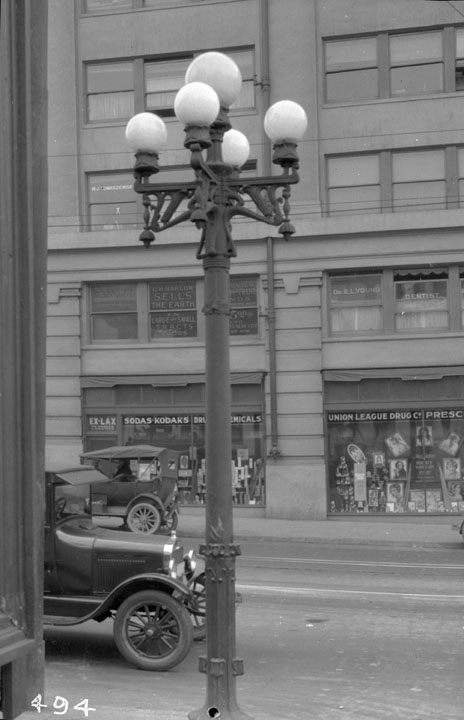 |
|
| (ca. 1931)^ - Close-up view of an early 5-globe street light ('Winslow') on the corner of Second and Hill streets |
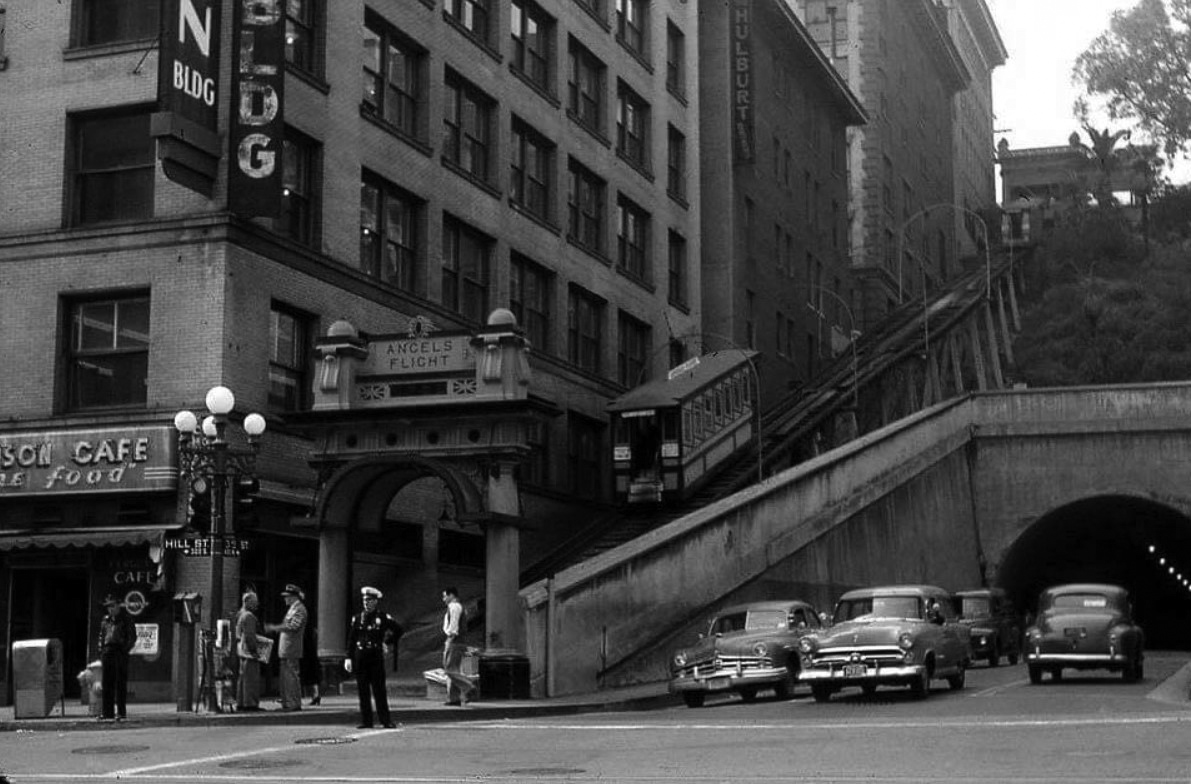 |
|
| (1950s)^ - View looking at the SW corner of 3rd and Hill streets showing a “Winslow” 5-bulb electrolier in front of Angels Flight with the Third Street Tunnel seen on the right. Note that the Llewellyn has lost one of its arms to accommodate the new R-Y-G traffic signal. |
Historical Notes There are no 5-bulb Winslow Eletroliers left today. The model is extinct. |
* * * * * |
Five-Globe Electroliers
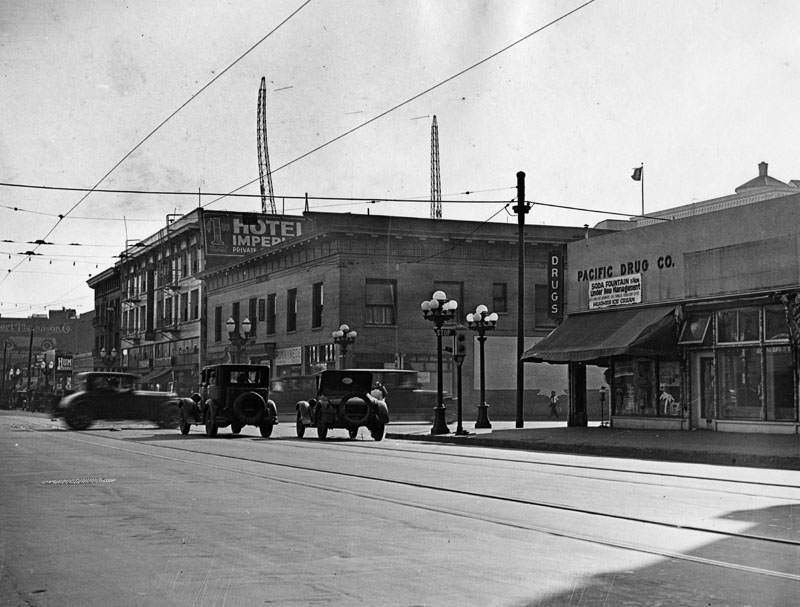 |
|
| (1931)^ - Street lights at the corner of Grand Avenue and 9th Street. |
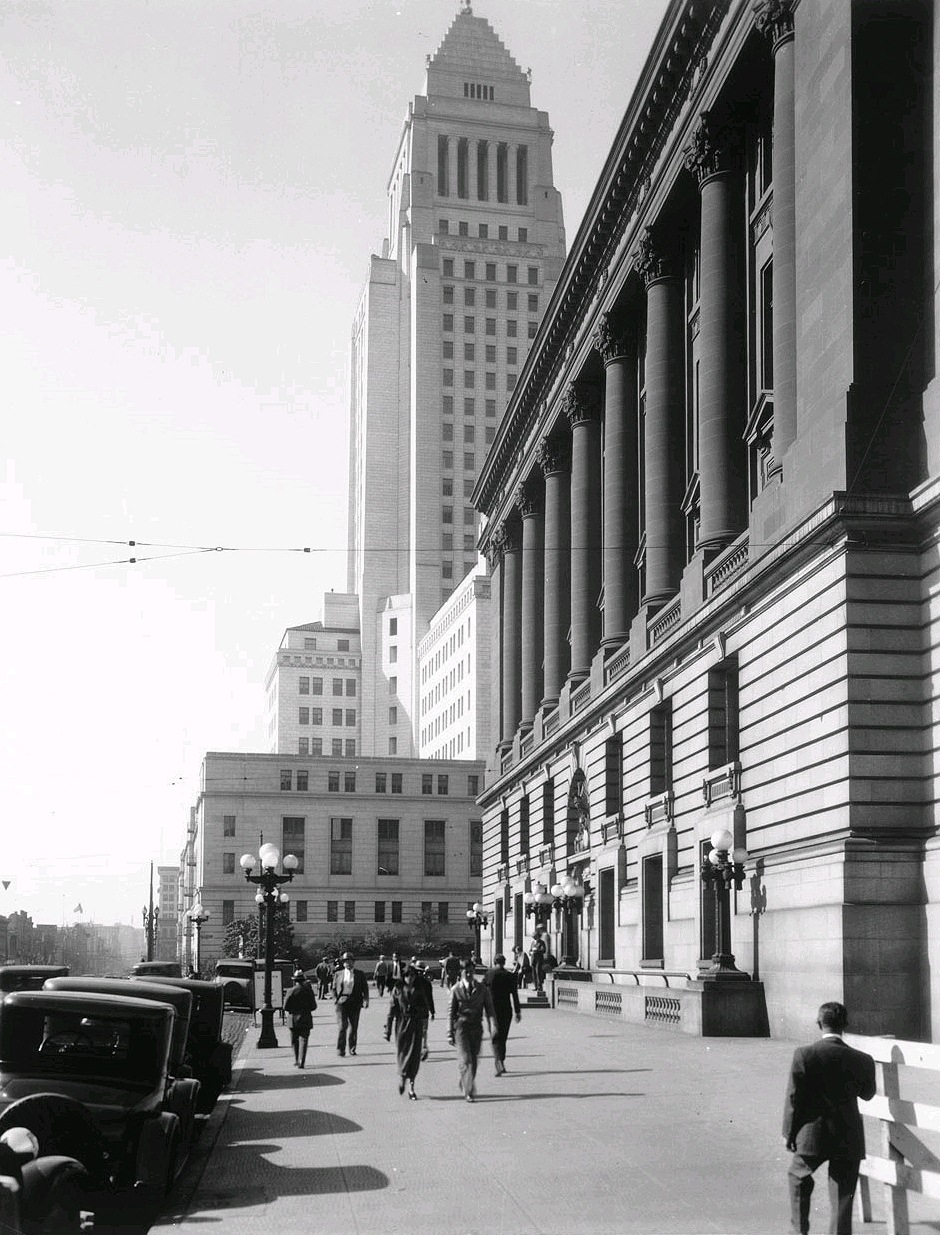 |
|
| (1931)^^* - Looking south on Main Street at least seven 5-bulb decorative lamps can be seen in front of the old Federal Building/Post Office adjacent to City Hall. |
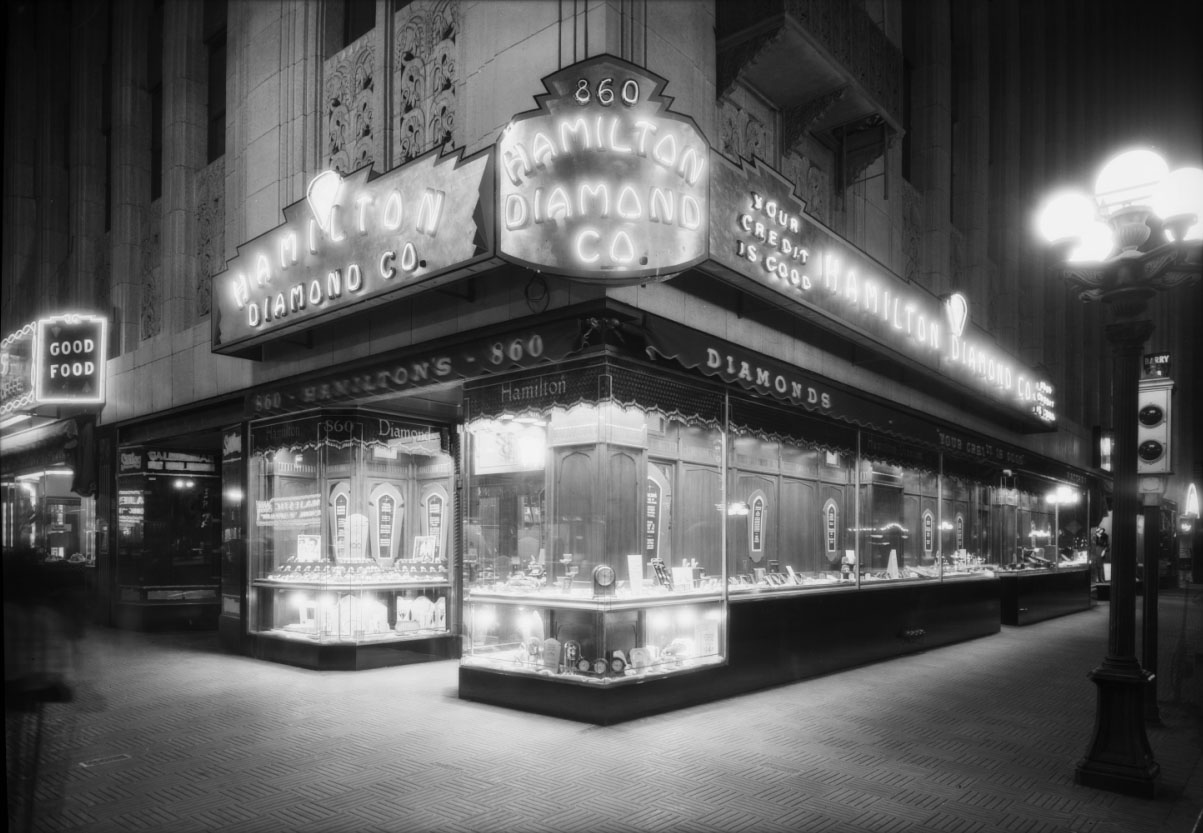 |
|
| (1930)*^^ - A 5-lamp ornate electolier helps light up the northeast corner of Broadway and 9th Street with the Hamilton Diamond Company store in the background. |
Click HERE to see more 5-globe Llewellyn Electroliers (1900+) |
* * * * * |
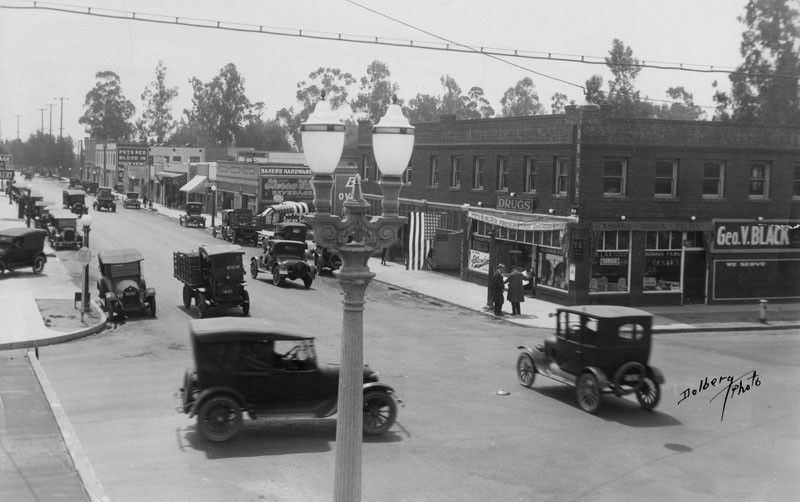 |
|
| (1920s)^ - An ornate dual-lamp streetlamp stands tall on the SE corner of Los Feliz Boulevard and San Fernando Road. |
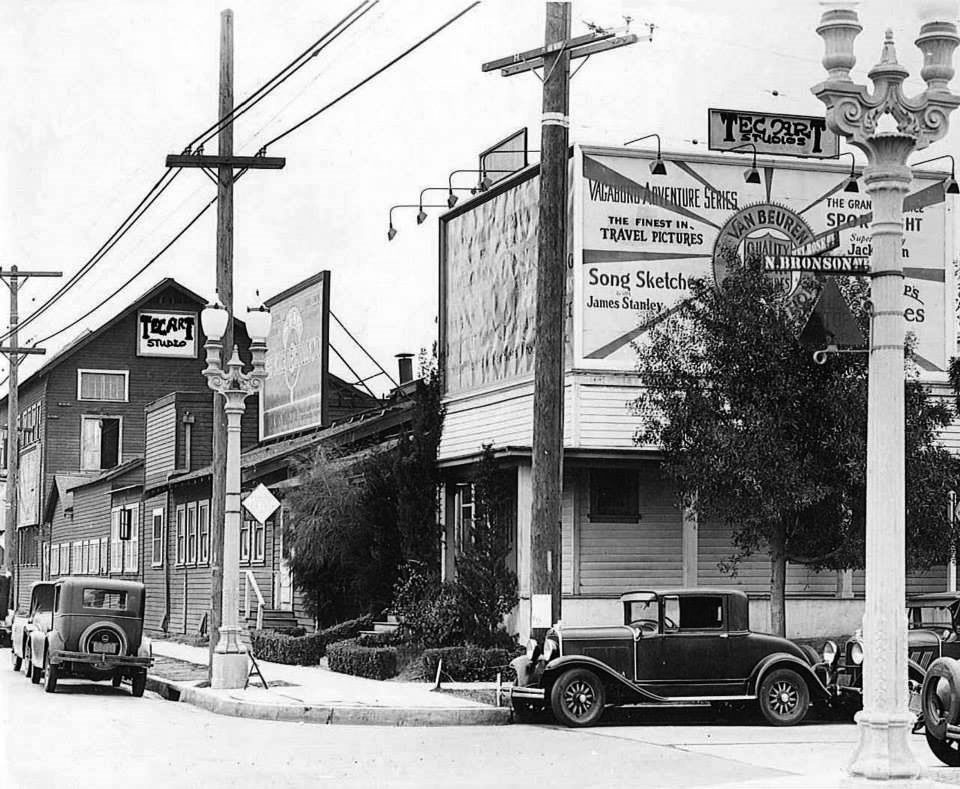 |
|
| (1927)^^* - View looking southeast at the intersection of Melrose and Bronson avenues showing two ornate dual-lamp electroliers. Today, Raleigh Studios is located at this corner. |
Historical Notes The twin street lights along Melrose were the Marbelite 1900 model, distinguished by its squarish base. The Melrose lights were removed around 1950, but there are a few survivors fairly close by. Wilshire Boulevard on the west side also had similar streetlights in the 1930s. |
Then and Now
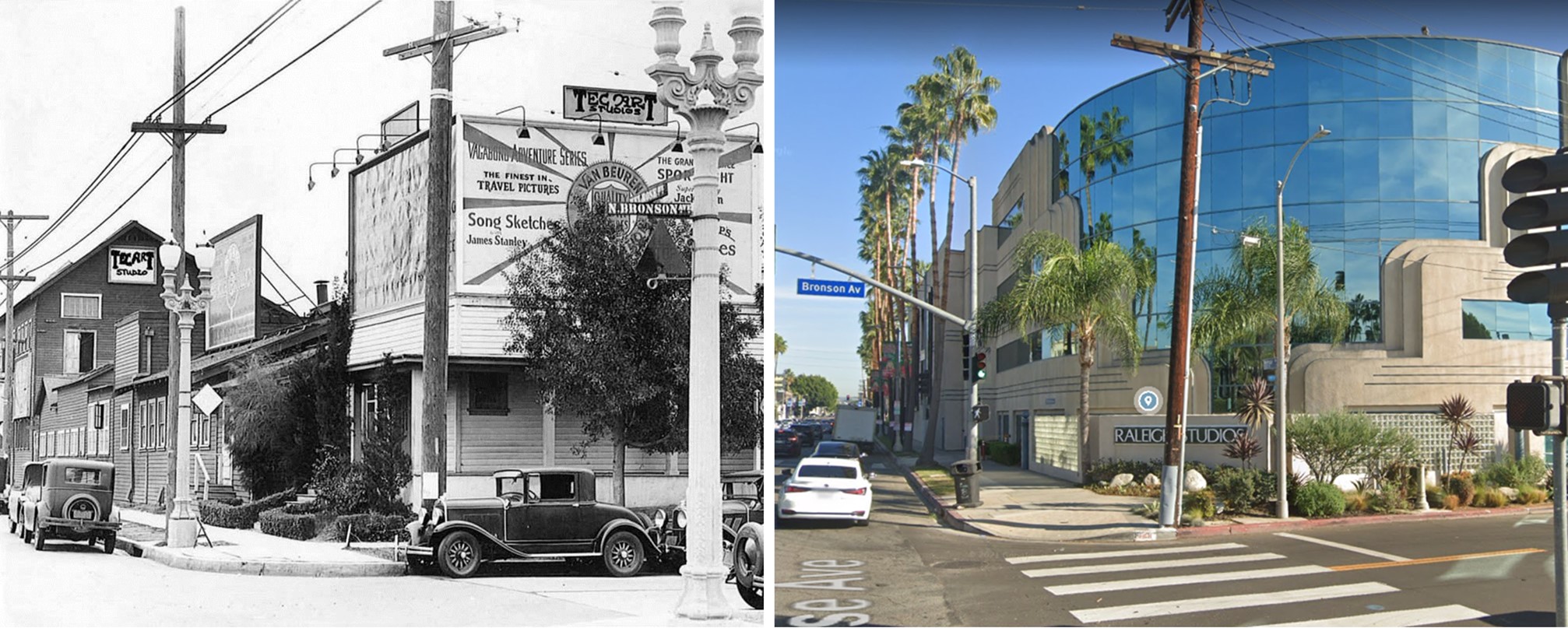 |
|
| (1927 vs 2021) - SE Corner of Melrose and Bronson. |
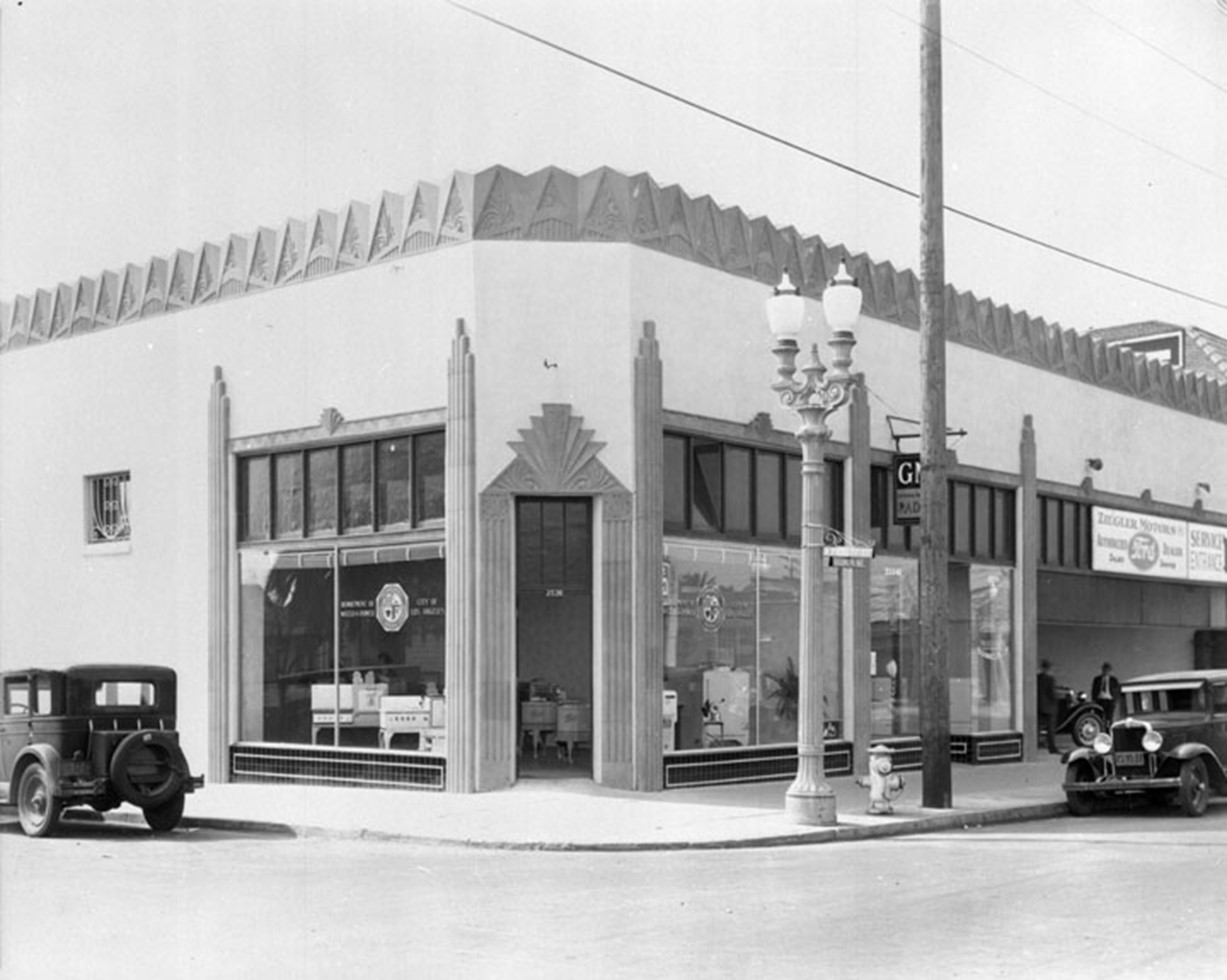 |
|
| (1933)* - View of a dual-lamp electrolier in front of the Art Deco-Style DWP commercial branch office on Brooklyn Avenue. |
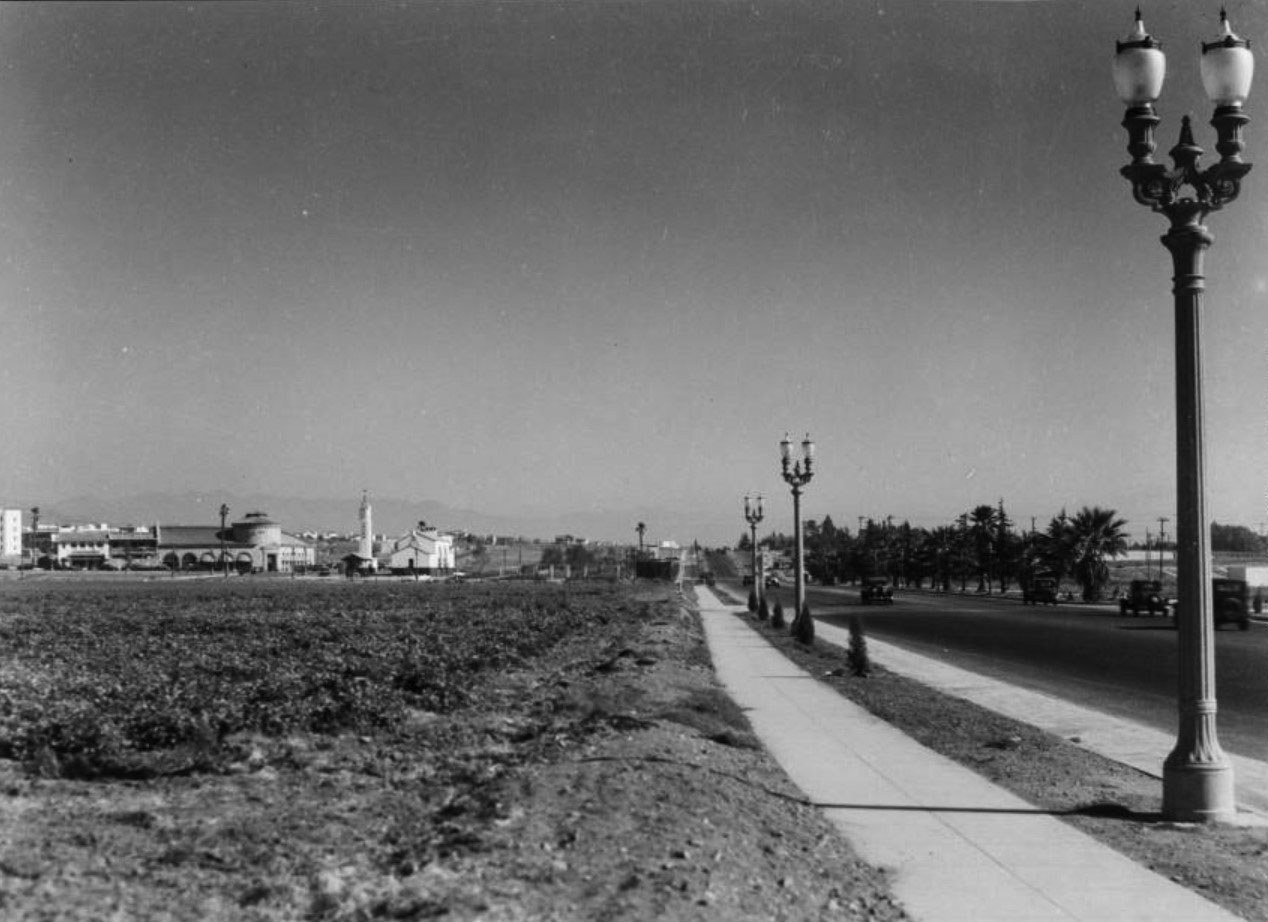 |
|
| (ca. 1930)*** - View looking east showing dual-lamp electroliers on Wilshire Boulevard with the new Westwood Village development seen in the background on the left. |
.jpg) |
|
| (ca. 1931)^ - Early dual-lamp streetlights running along Wilshire Boulevard. Note the dirt road. |
.jpg) |
|
| (1931)*^ – Close-up view showing an ornate dual-lamp streetlight near the NW corner of Fairfax and Drexel avenues with two women followed by two girls walking on the sidewalk nearby. The Richfield Gas Station on the corner is selling regular gas for 8½ cents/gal, with Ethyl going for 11½ cents. Note the beautiful two-lamp streetlight on the corner. |
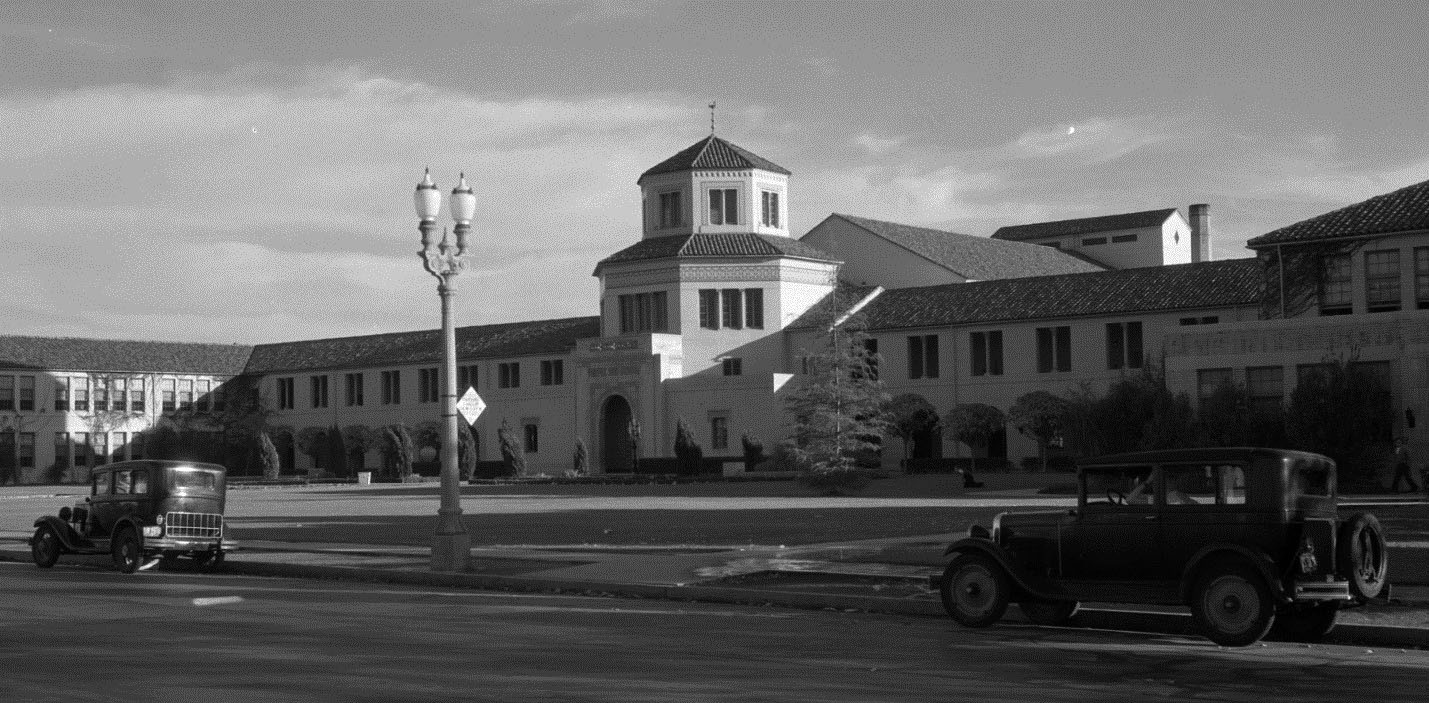 |
|
| (1931)* – View showing a dual-lamp streetlight in front of Fairfax High School located on the south side of Melrose Avenue east of Fairfax Avenue. |
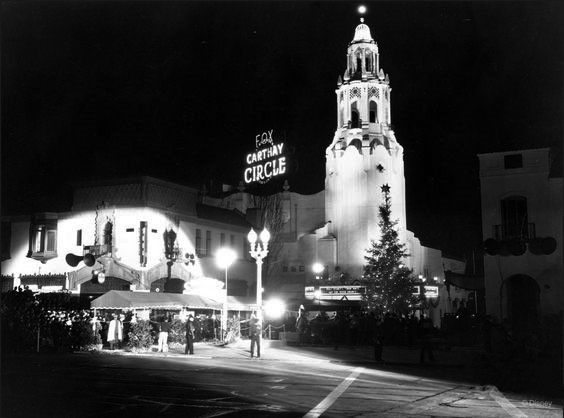 |
|
| (1937)^x^ – Dual-lamp electrolier tries to compete with a spotlight during a premiere at the Carthay Circle Theatre, 6316 San Vicente Boulevard. |
.jpg) |
|
| (ca. 1930s)* - Ornate dual-lamp street lights in a residential neighborhood.* |
 |
|
| (ca. 1938)* - The same type of dual-lamp streetlight as previious photo but in a commercial area. This view looking west on Whittier and Vancouver in East Los Angeles includes from right to left: a Safeway market (5128 Whittier Boulevard), the United Artists Theater, and the Vega Building shops. |
Westinghouse--Llewellyn "California Special"
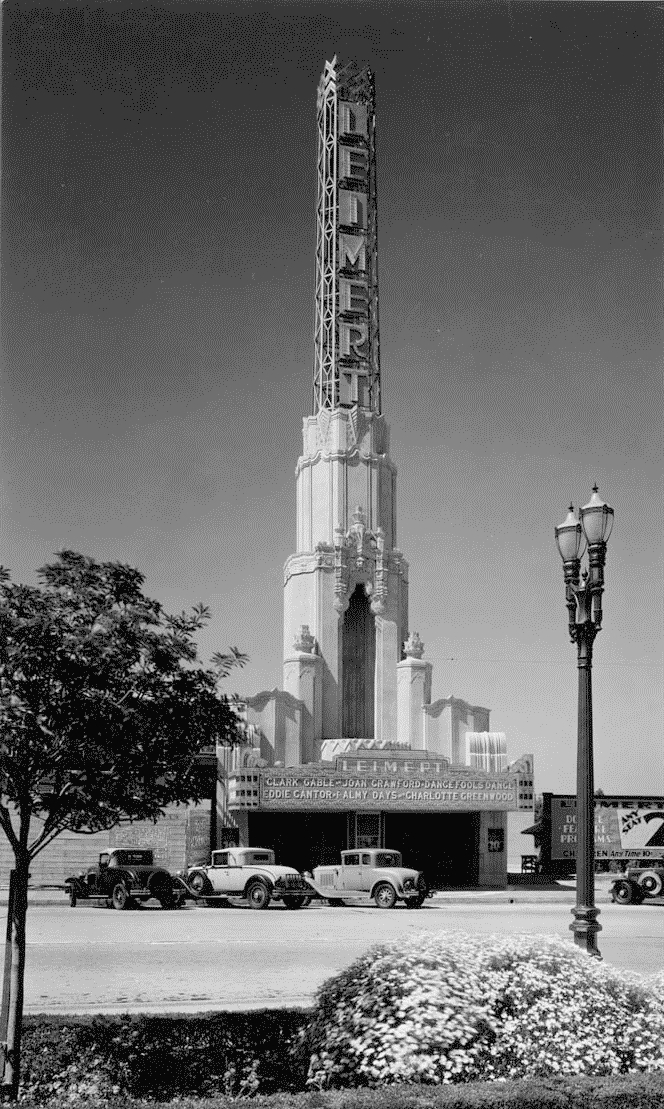 |
|
| (1933)^*# - A dual-lamp "California Special" streetlight stands across the street from the Leimert Theatre at 3341 W. 43rd Pl. in Los Angeles. The theater still stands today in Leimert Park as the Vision Theater. |
Historical Notes The “California Special” was designed by Westinghouse, but produced locally by Llewellyn Iron Works. Chris Burden dubbed these "The Magnolia Double" for his Urban Light sculpture down on Wilshire Blvd. Today, there are still plenty of these to be found on the Magnolia Boulevard between Lankershim and Cahuenga. They were previously found in Leimert Park. Single lamp versions use to line Burbank and Magnolia Blvds. in Burbank, but those are all gone, too. There are eight "California Specials" found around the El Portal Theatre in North Hollywood, four on Lankershim and the other four around the corner on Weddington. These are 21st Century transplants. The California Special was never found on either of those two thoroughfares. |
Sixth Street Bridge
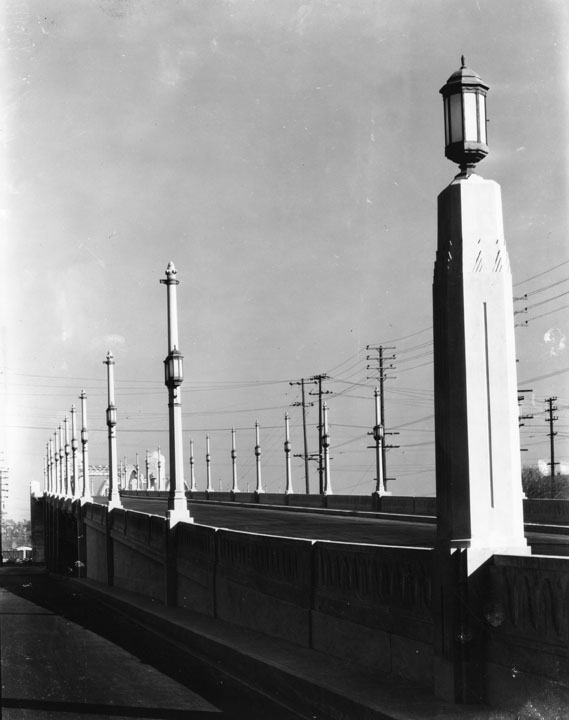 |
|
| (1933)* - Standing on the street beside the bridge, you can see across part of the roadway of the Sixth St. Bridge. The bridge lighting, with its unique design, is placed every few feet. |
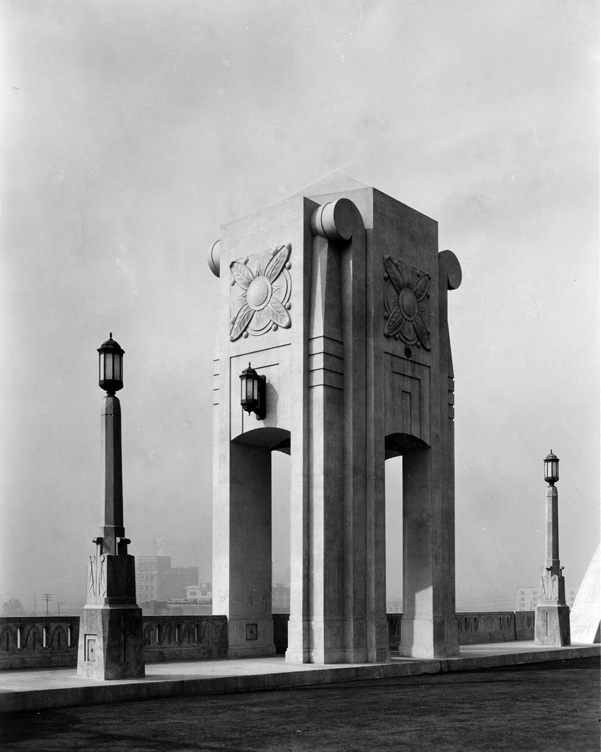 |
|
| (ca. 1933)^*# - View near the center of the Sixth Street Bridge. |
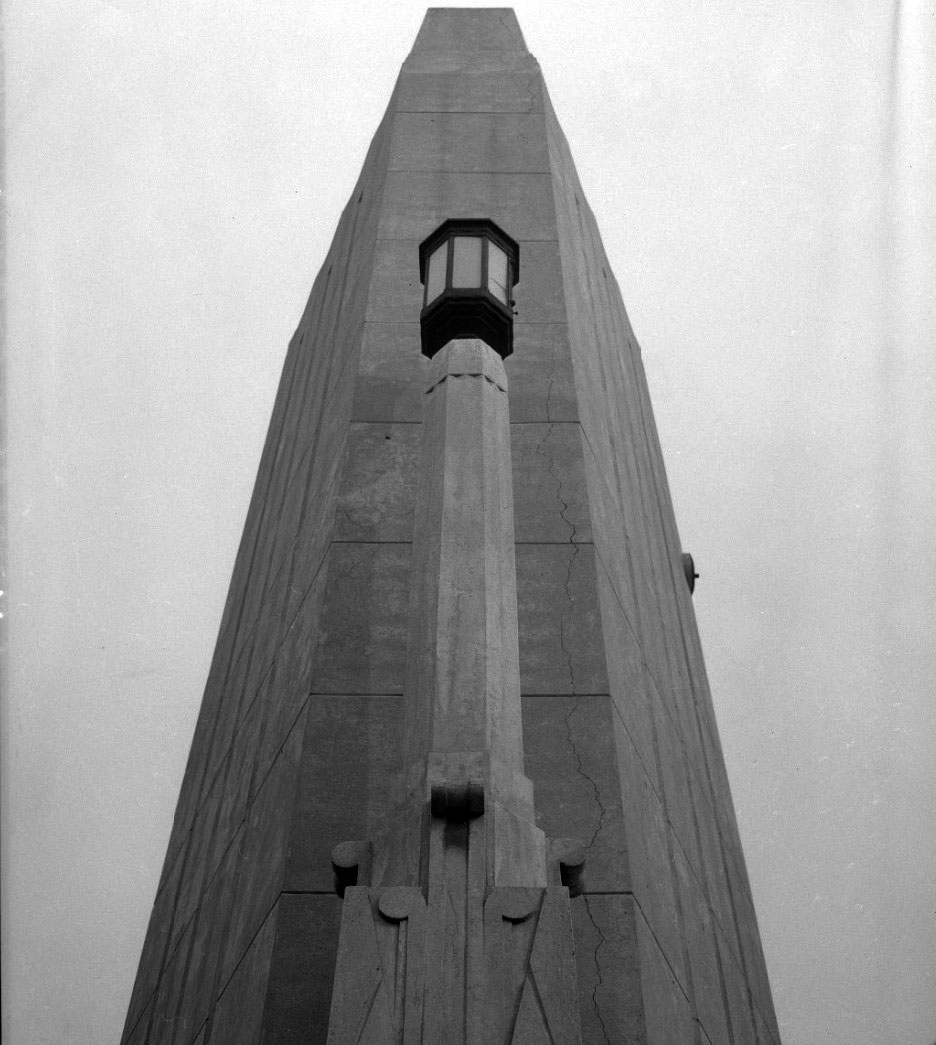 |
|
| (ca. 1930s)* – Close-up view showing an ornate concrete streetlight in front of a pylon-tower on the Sixth Street Bridge. |
Macy Street Bridge
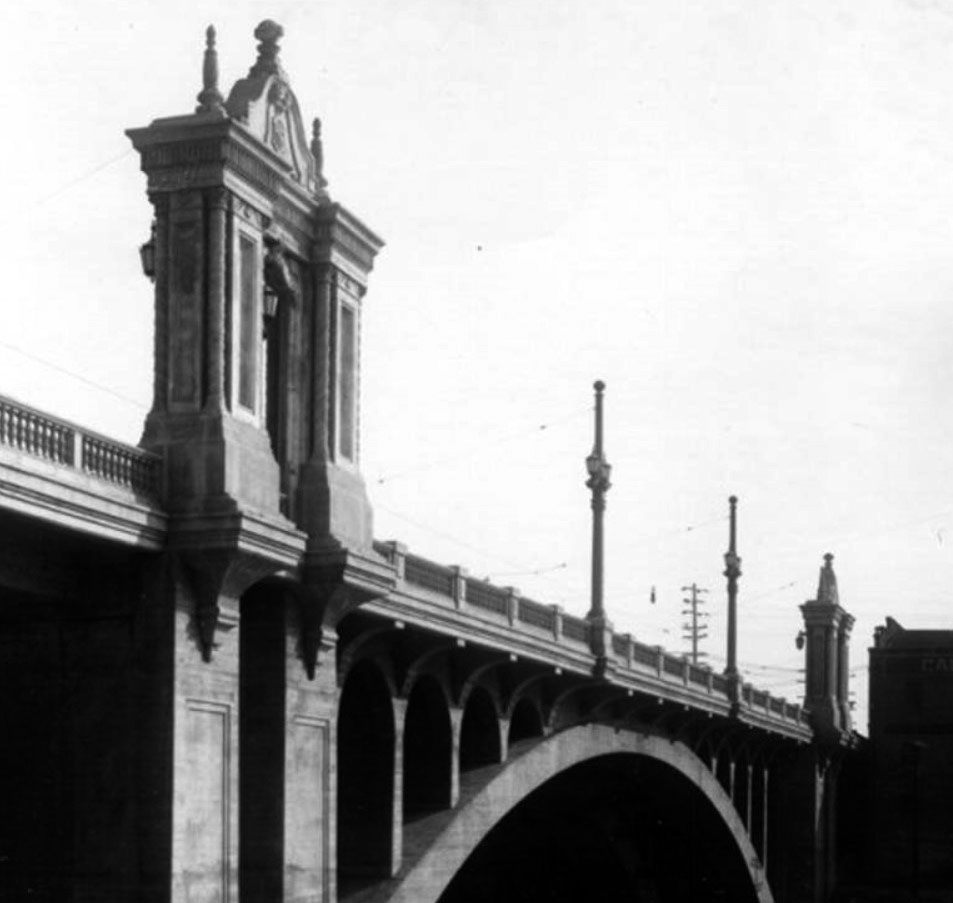 |
|
| (1933)* - Looking up at the Macy Street Bridge from the ground below. The bridge has dual-lamp electroliers with trolley cable connected to top of the posts. There are also four large pillars (two at each end) with ionic and doric columns and ornate streetlights. |
Historical Notes Originally called the Macy Street Viaduct/Bridge, the Cesar E. Chavez Avenue Viaduct is the second bridge built during large bridge-building program in Los Angeles during the 1920s. The first bridge located on this spot was a wooden, kerosene lamp-lit covered bridge, built in 1870. It was later replaced with a small metal truss bridge. |
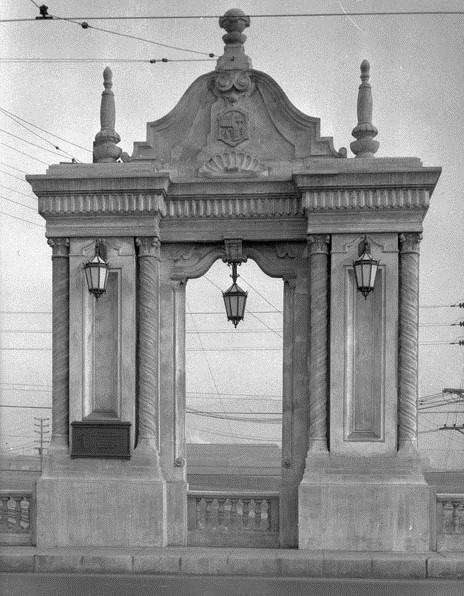 |
|
| (ca. 1933)* - One of four identical decorations on the Macy Street Viaduct, a bridge over the Los Angeles River that is now Cesar Chavez Avenue. The viaduct is in Spanish Colonial Revival style with ionic and doric columns and ornate streetlights. |
Washington Boulevard Bridge
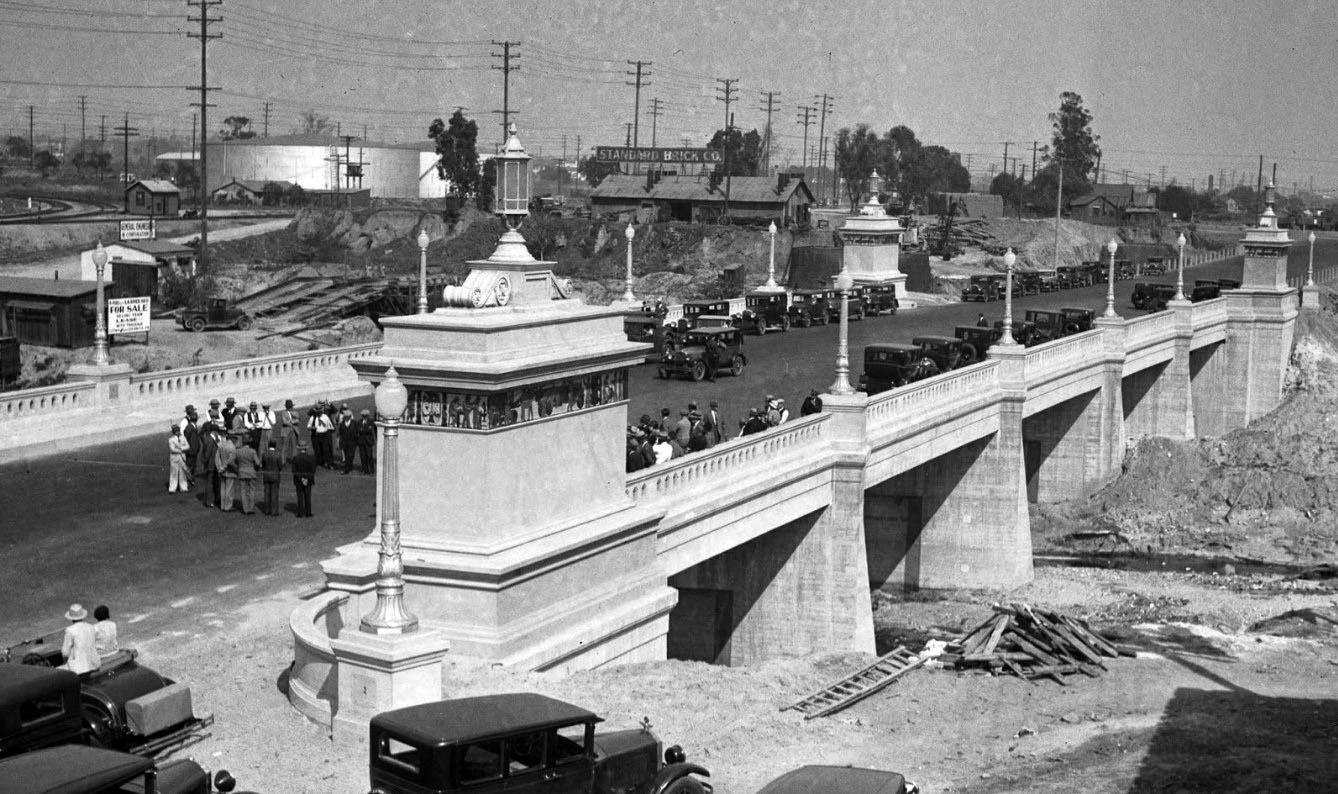 |
|
| (1931)* – View showing opening day ceremonies at the East Washington Boulevard Bridge over the Los Angeles River. The five-span T-girder bridge sits on wide pier walls. Note the two different styles of streetlights running along both sides of the bridge. Photo date: March 31, 1931 |
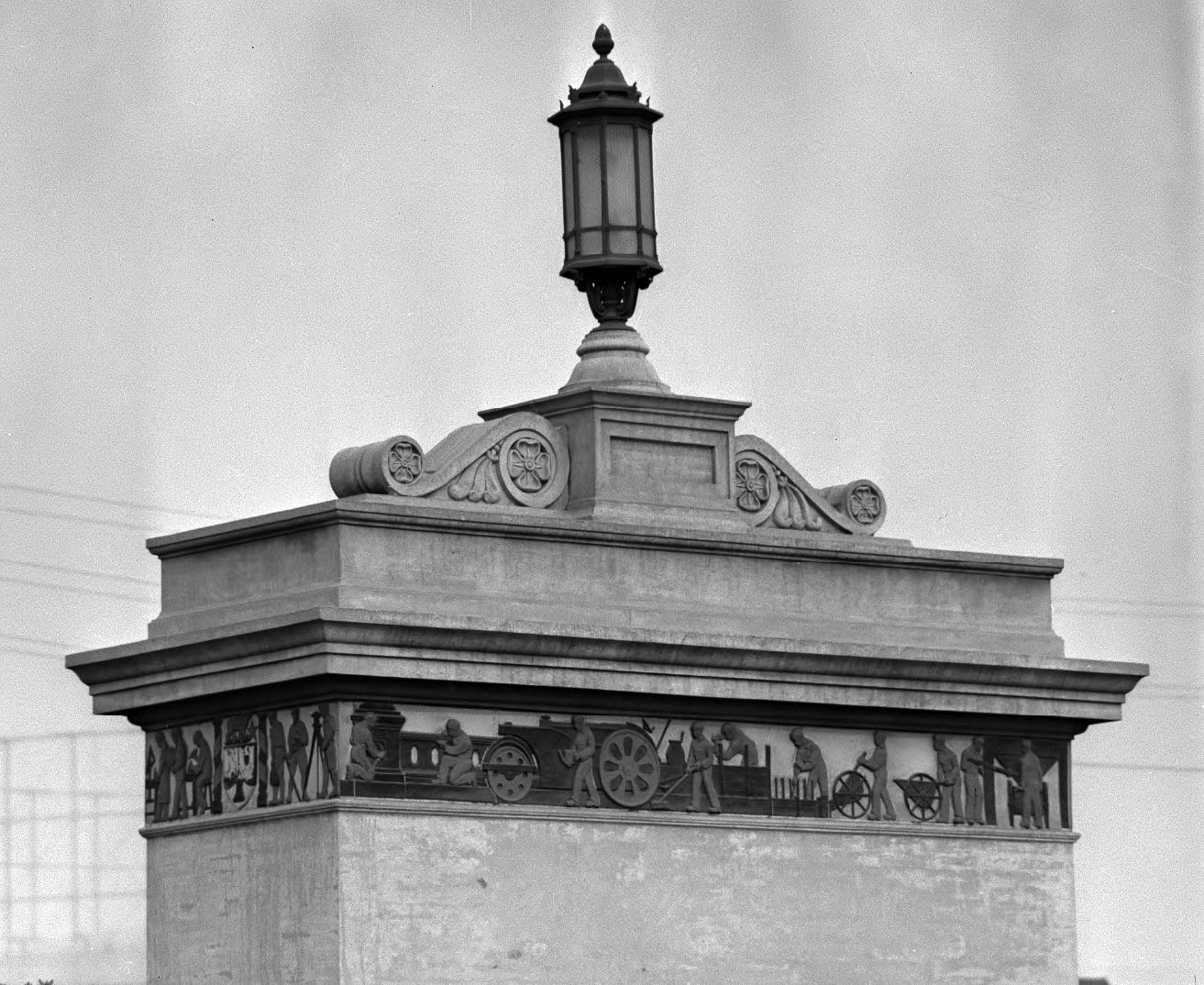 |
|
| (ca. 1930s)* - View showing one of four ornamental streetlight posts lcoated on the ends of East Washington Boulevard Bridge. Each base supports a large lamp and also has figures in relief that depicts the various industries located in the area. |
Historical Notes See More Bridge Lighting (College Street Bridge; First Street Bridge; Fourth Street Viaduct; Fourth and Lorena Streets Bridge; Glendale-Hyperion Bridge; Macy Street Bridge; Mulholland Bridge; Sixth Street Bridge; Washington Blvd Bridge) |
General Hospital
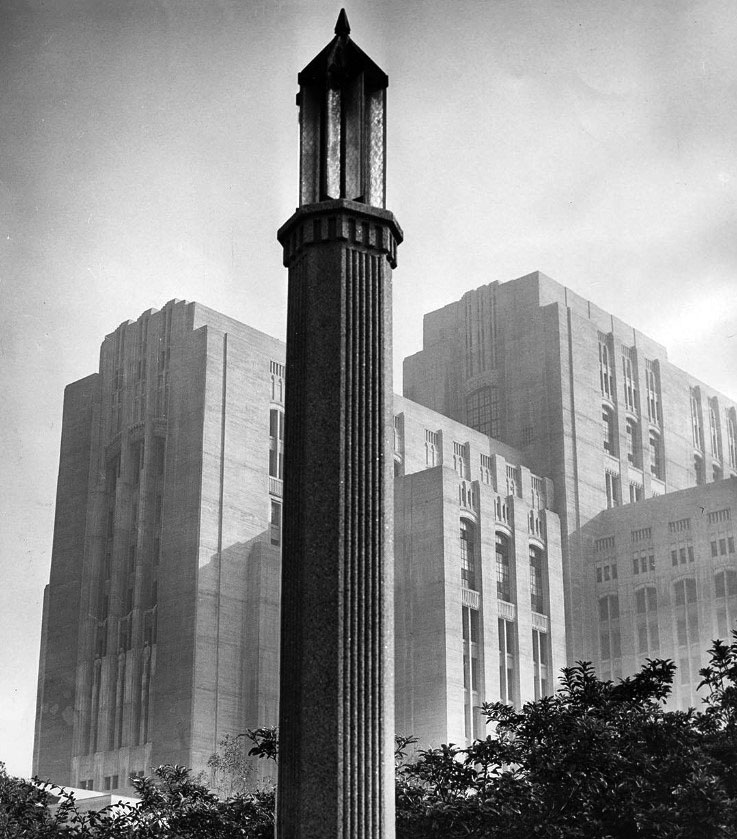 |
|
| (n.d.)^x^ - Looking up at a streetlight that resembles a light house in front of the Art Deco style Los Angeles County General Hosiptial, built 1930 to 1933. LA Times Archives |
Historical Notes The site of numerous significant events in the history of public health, the Los Angeles County + USC Medical Center contains one of the city's most recognizable Art Deco buildings. The facility is located in Los Angeles' Lincoln Heights neighborhood and has previously been known as County/USC and Los Angeles County General Hospital. Click HERE to see more Early Views of the LA County General Hospital. |
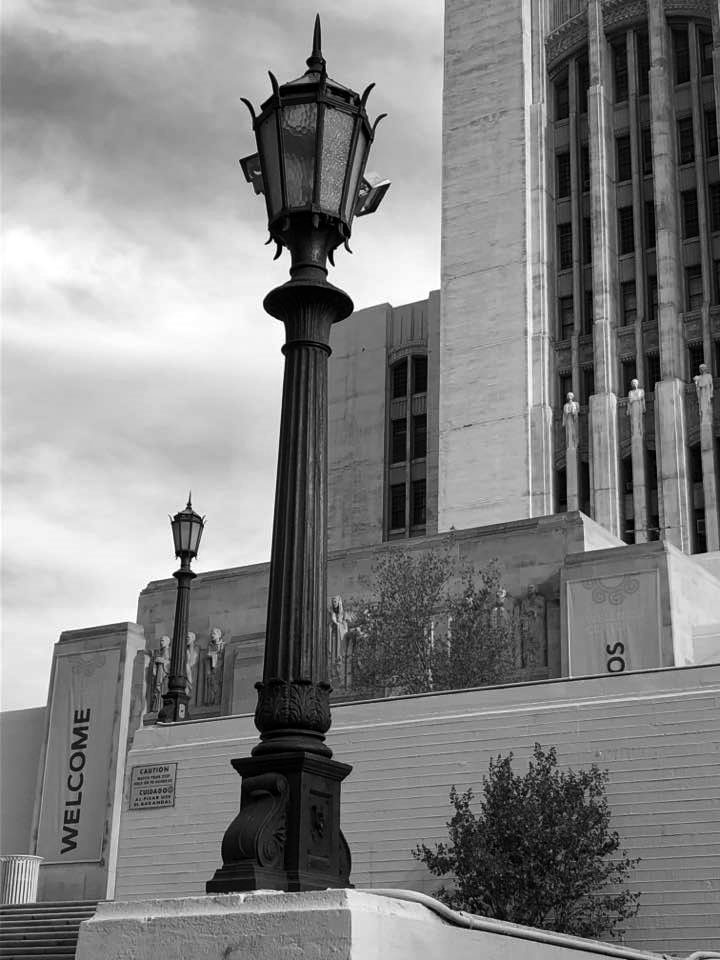 |
|
| (n.d.)^x^ – Ornate street lamps in front of L.A. General Hospital Hospital. Note the high relief scultpures on the front face of the building. Photo courtesy of Eward Grad |
Wilshire Specials
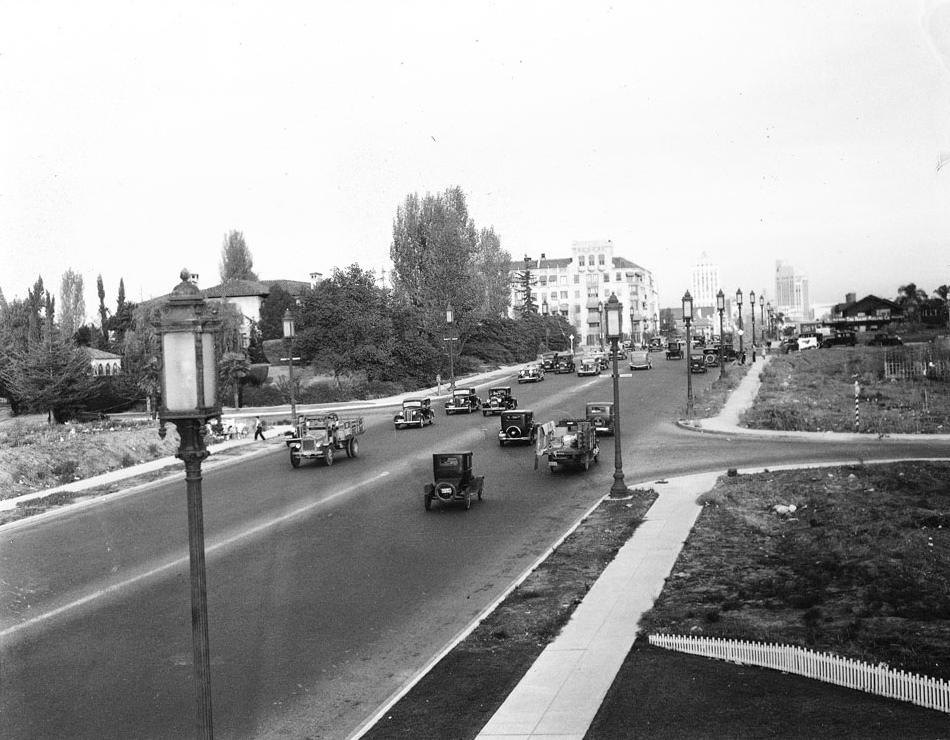 |
|
| (1934)*^ - Photograph of a view of the intersection of Wilshire Boulevard and Crenshaw Boulevard, 1934. At center, a wide, two lane boulevard can be seen extending into the distance where highrise buildings can be seen while at center, a narrower road intersects the wide boulevard. To the left of the center foreground, a street lamp can be seen, beginning a procession that extends down the right side of the road. |
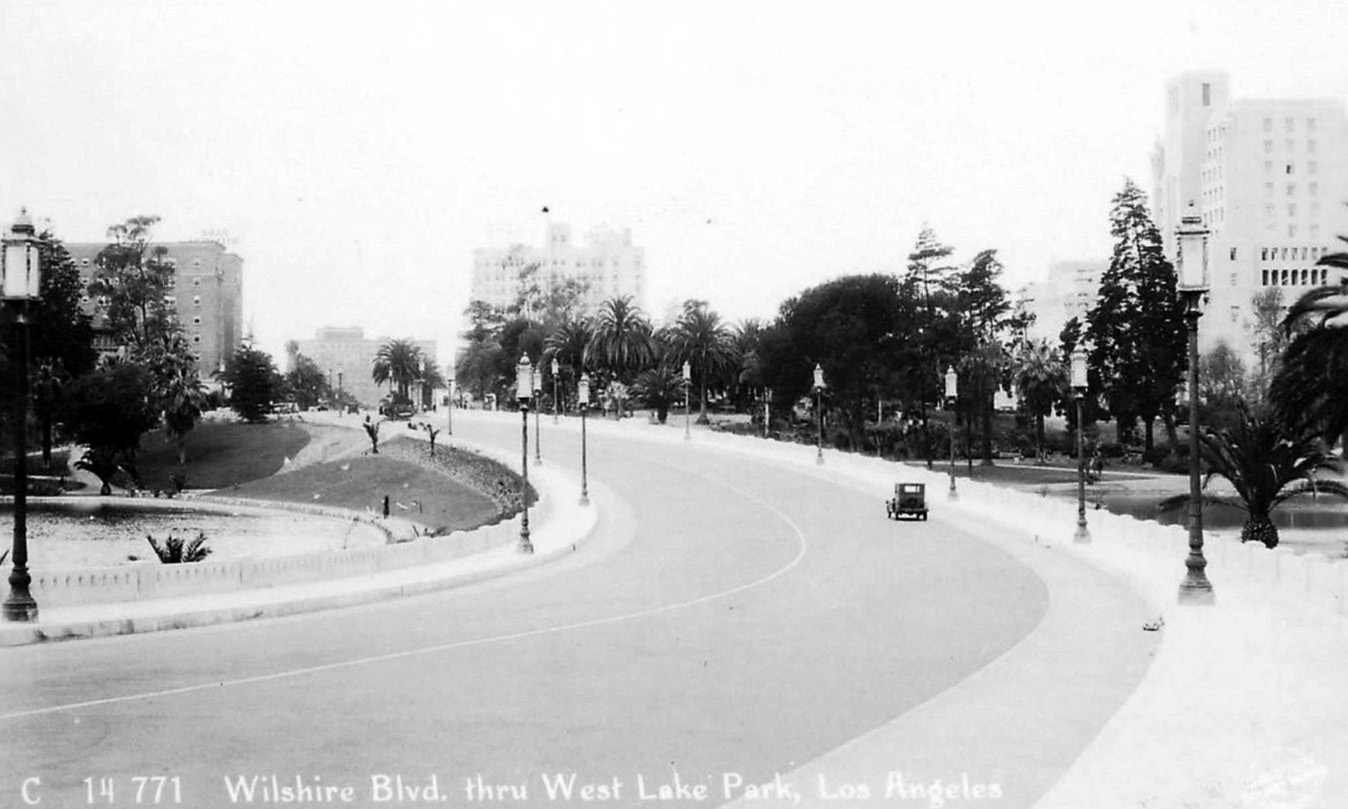 |
|
| (ca. 1934)^^* – Street view looking northwest showing "Wilshire Blvd. thru West Lake Park" (later MacArthur Park) with the "Wilshire Special" streetlights on both sides of the street. |
Historical Notes On May 7, 1942, the Los Angeles Park Commission renamed Westlake Park in honor of Gen. Douglas MacArthur. The decision to rename the park, which had been known as Westlake Park for more than 50 years, was made in preparation for an observance of MacArthur Day on June 13th.*^ Refurbished Wilshire Specials can still be found in downtown LA. (Click HERE). |
Olympic Boulevard
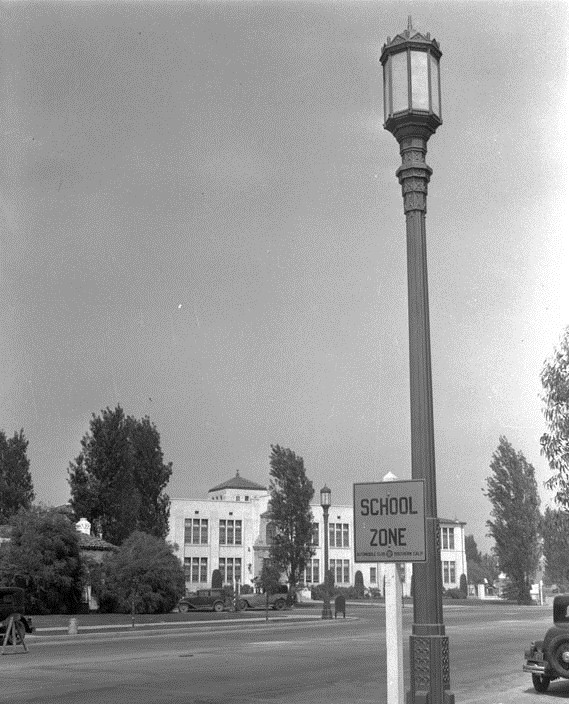 |
|
| (1934)* - Caption reads: Close-up of new standard in Olympic Boulevard ornamental lighting system, serviced by the Power Bureau – with officials representing State, County and City governments in attendance, the Olympic Boulevard street lighting system was placed in service May 16, 1934, adding another brilliantly lighted thoroughfare to the many already served by the Bureau of Power and Light. |
UCLA
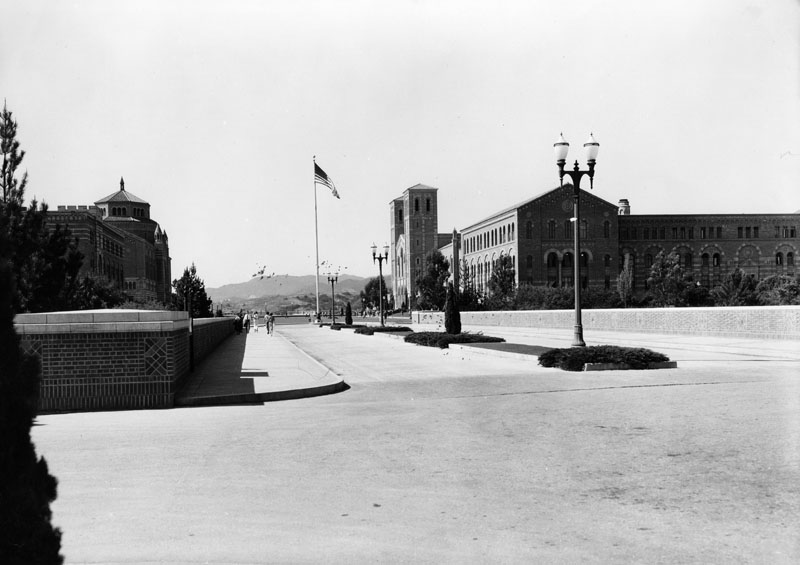 |
|
| (ca. 1935)^ - View looking west at the bridge which connects Hilgard Avenue to the main campus quadrangle at the U.C.L.A. Westwood campus. Decorative two-lamp streetlights can be seen along the center median. |
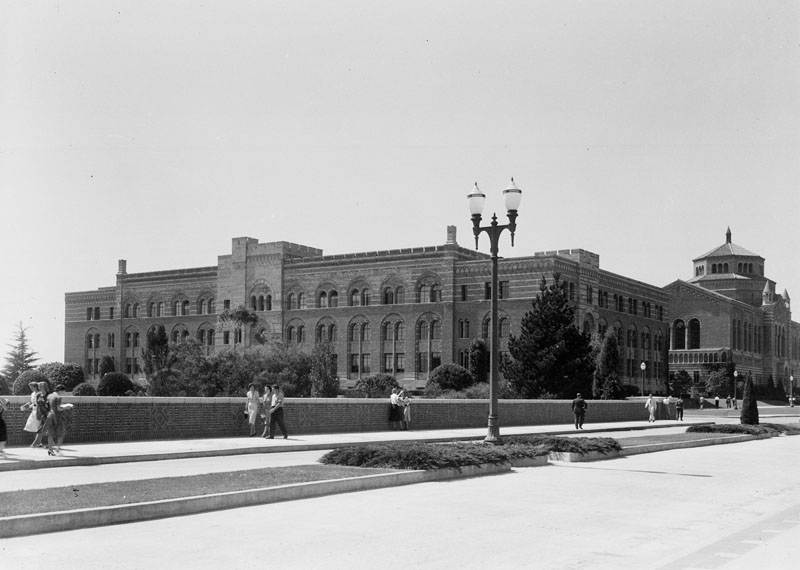 |
|
| (ca. 1935)* - A decorative two-lamp streetlight stands tall in the center median of the road that cross the bridge road connecting Hilgard Avenue to the main campus quadrangle at UCLA. Click HERE to see more in Early Views of UCLA. |
Beverly Boulevard
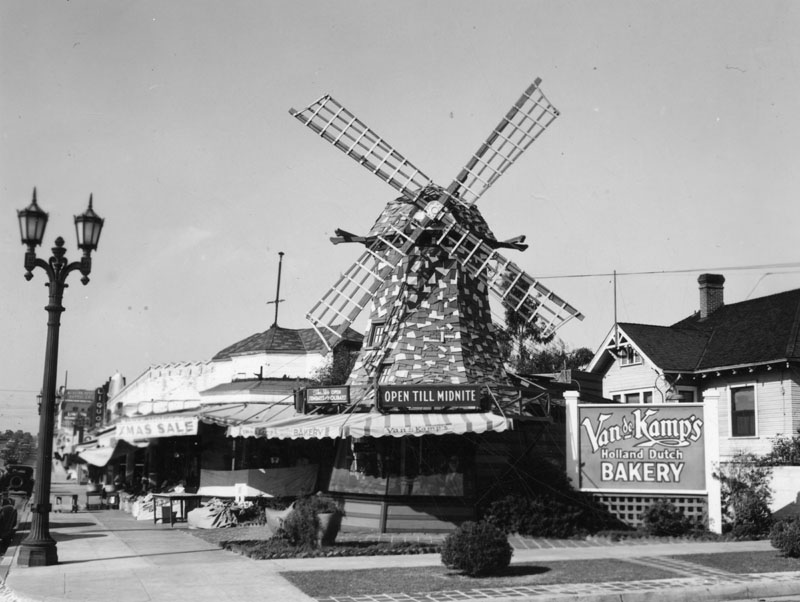 |
|
| (1935)^ - An ornamental two-lamp electrolier standing in front of Van de Kamp's Bakery on Beverly Boulevard and Westmoreland Street, looking west. |
* * * * * |
Hollywood (Metropolitan Standards)
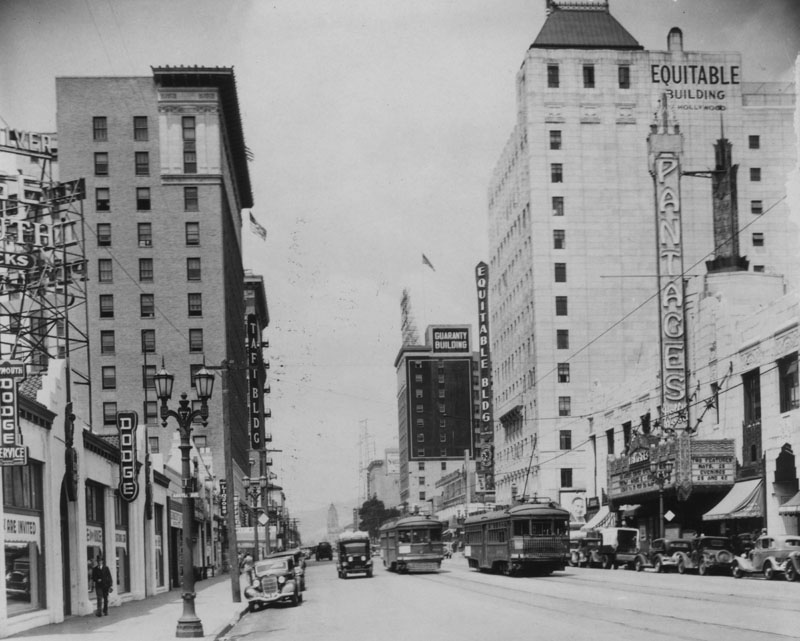 |
|
| (1936)^ - View looking west down Hollywood Boulevard from the intersection with Argyle Avenue. Note the decorative electroliers on the left side of the photo. These type of lamps, called Metropolitans, were found throughout Hollywood as early as the late 1920s and many still exist today. |
 |
|
| (1930s)^v^ - Close-up view showing a Metropolitan-style two lamp electrolier at the northwest corner of Hollywood Boulevard and Argyle Avenue with the Pantages Theatre seen in the background. |
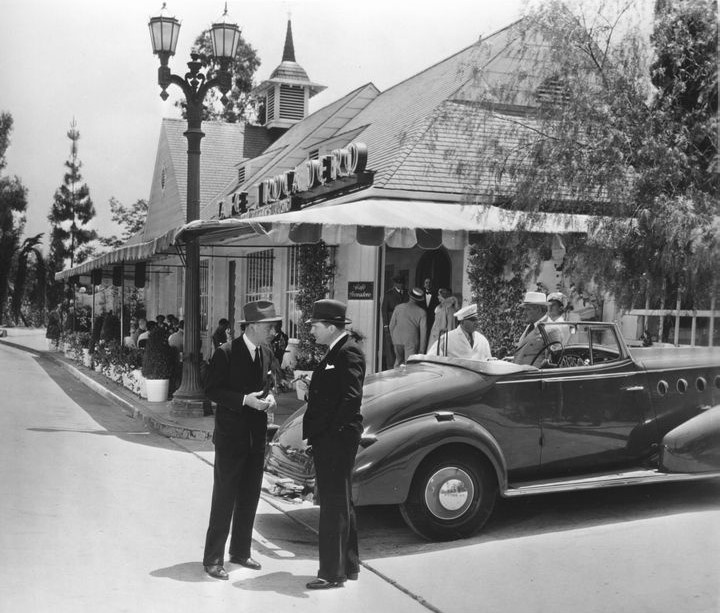 |
|
| (1936)^** - View of patrons at the Cafe Trocadero on the Sunset Strip in what is now West Hollywood. Note how the the awnings drape around the ornate dual-lamp Metropolitan streetlight. |
Historical Notes Among the celebrities who frequented the Trocadero were Fred Astaire, Bing Crosby, Cary Grant, Myrna Loy, Jackie Gleason, Henry Fonda, Judy Garland, Lucille Ball, Desi Arnaz, Jean Harlow, and Norma Shearer. The Trocadero was featured in the 1937 movie A Star is Born starring Janet Gaynor and Fredric March.*^ |
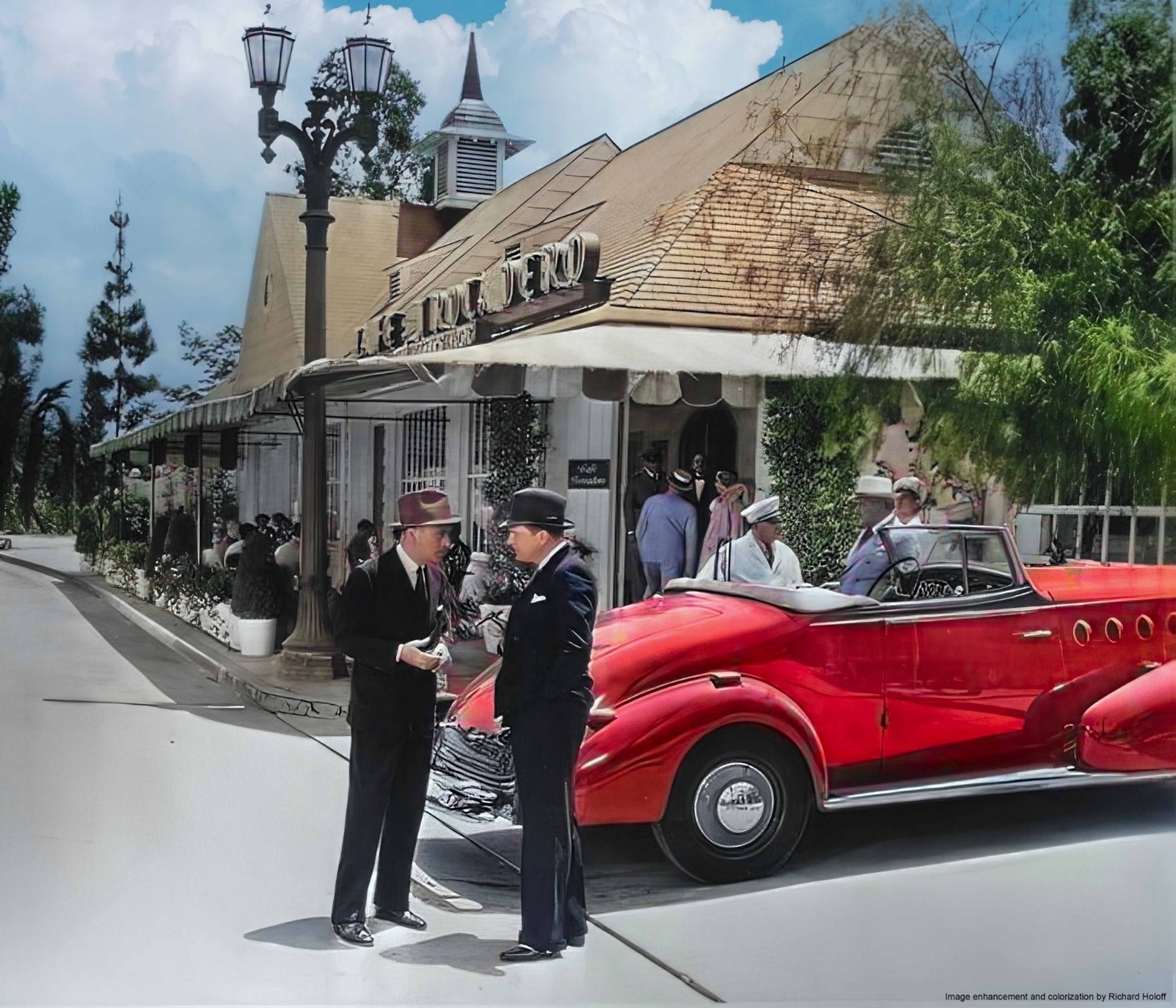 |
|
| (1936)* - Patrons at the Cafe Trocadero before the nightclub was remodeled. Note how the awnings drape around the post of the ornate dual-lamp streetlight. Image enhancement and colorization by Richard Holoff. |
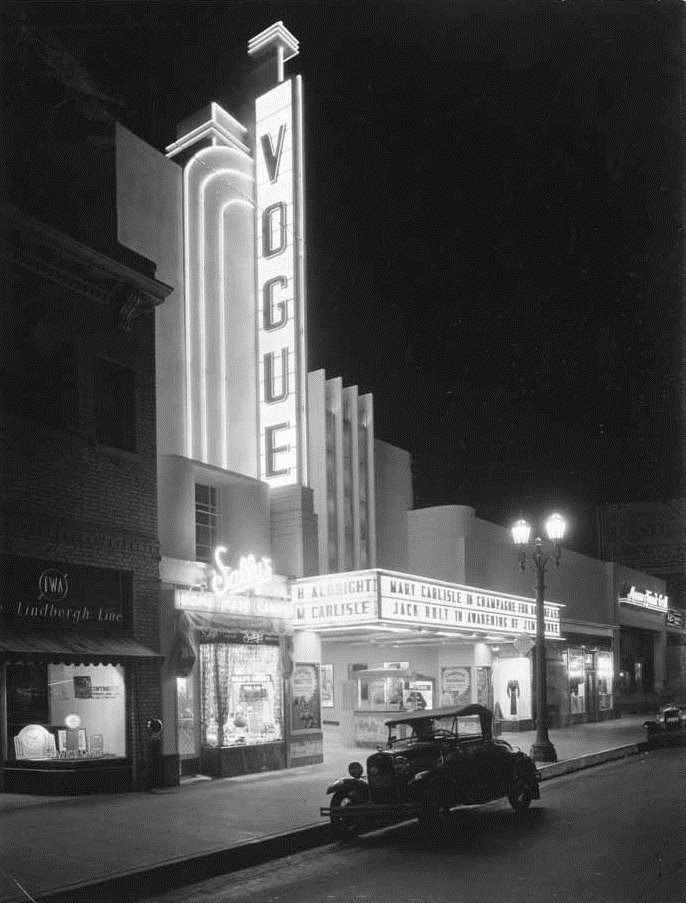 |
|
| (1935)*^^- View of an illuminated two-lamp Metropolitan electrolier in front of the Vogue Theater located at 6675 Hollywood Boulevard. Click HERE to see more in Early Views of Hollywood. |
* * * * * |
Downtown
 |
|
| (1935)^ - View of a singular 5-bulb streetlight standing guard in front of the U.S. Hotel on the corner of Market and North Main Street. The hotel was built in 1862 and demolished in 1939. |
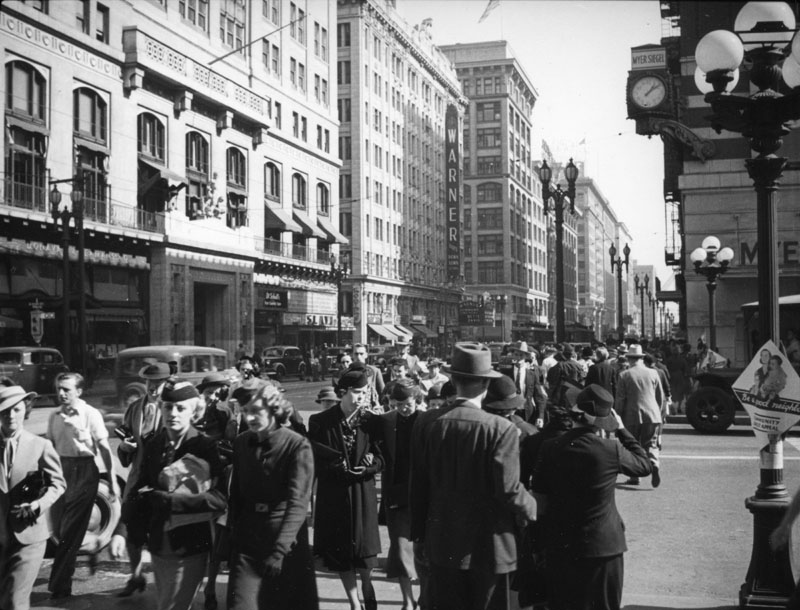 |
|
| (1937)^ - View of busy Broadway and 7th Street. Two different styles of streetlights are seen merging at this intersection. The two-lamp electroliers run up and down Broadway while the 5-lamp electrolier reside on 7th Street. |
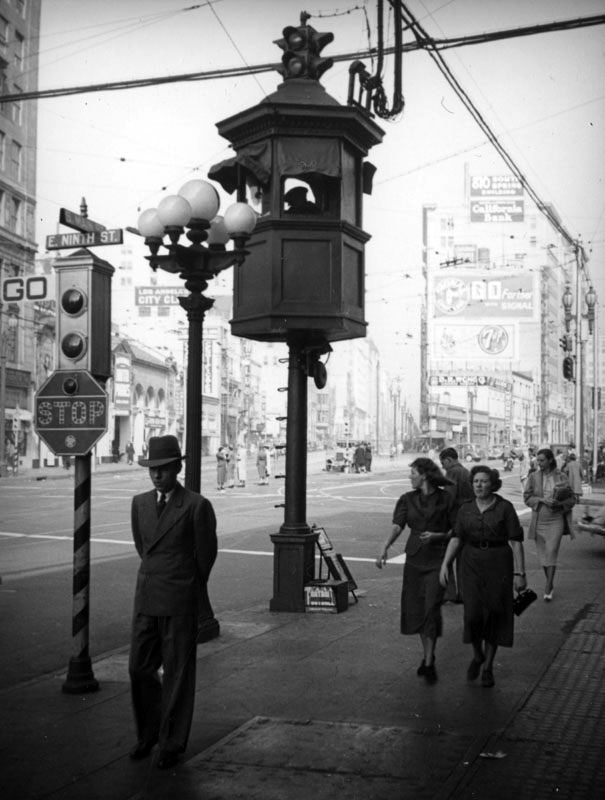 |
|
| (ca. 1937)* - Ornate five-lamp electrolier stands between a traffic signal and a switchman’s tower used to control the flow and path of streetcars through the intersection. This is a view of Main looking north from Ninth St. to where Spring and Main streets converge. |
* * * * * |
Combination Streetlight-Trolley Poles (UM-2502)
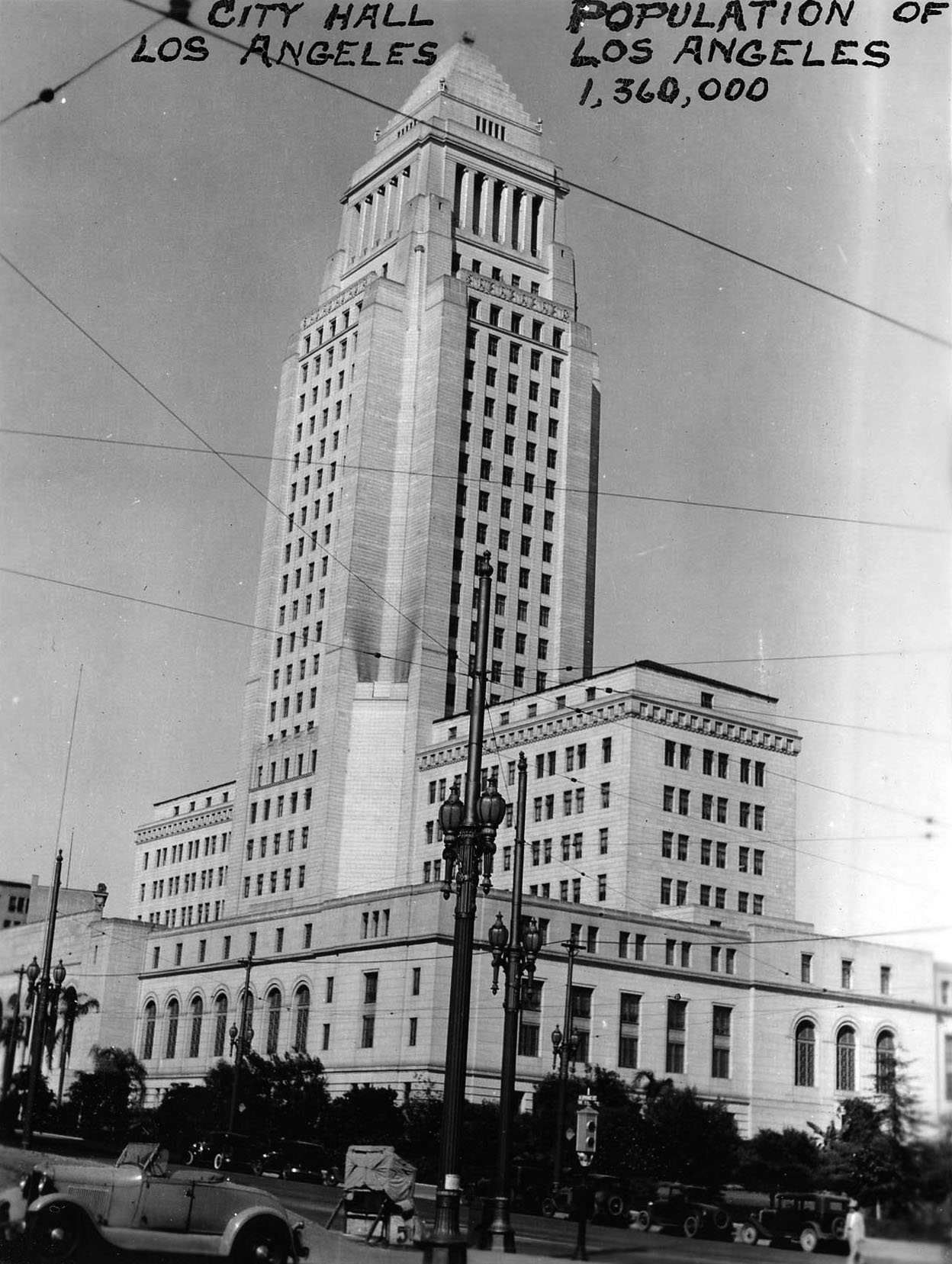 |
|
| (1934)^^^ – View looking northeast toward City Hall showing two-lamp combination streetlight trolley poles at the intersection of Spring and 1st Street. |
Historical Notes Southern California was once home to the world's largest interurban electric railway system, the Pacific Electric Railway. Los Angeles also boasted the Nation's fifth largest urban trolley system, the Los Angeles Railway. This combination streetlight trolley pole on North Main Street is representative of many different styles of steel and concrete decorative poles used to support the 600-volt DC wires which supplied power to the streetcars and interurbans of the two companies.^^ |
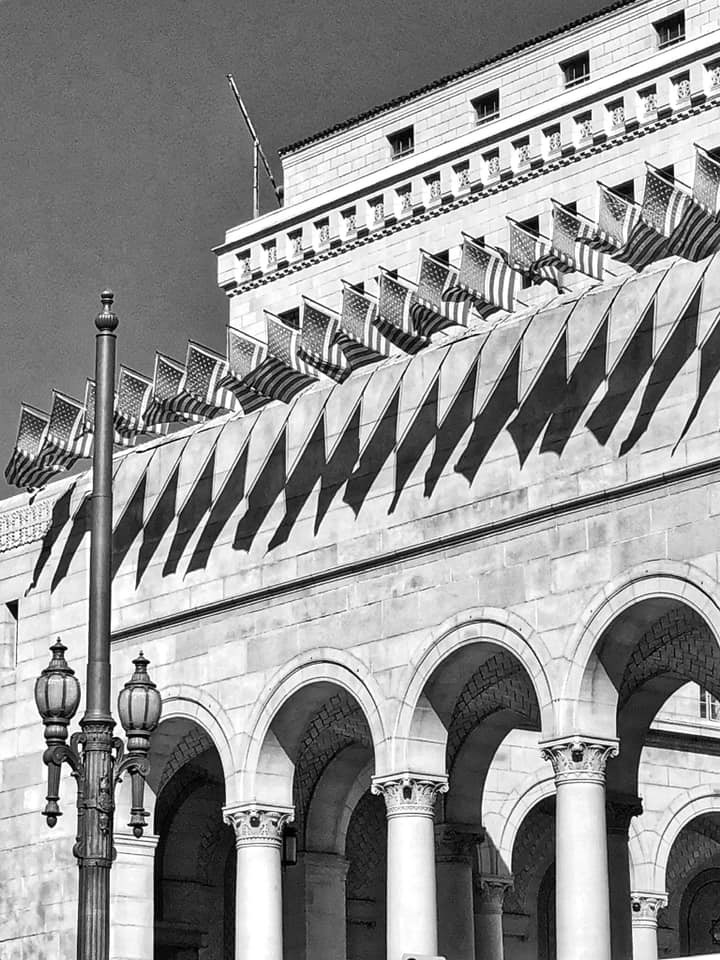 |
|
| (2020)^.^ – These streetlights still exist today in front of City Hall. Despite the fact that there are no longer any electric streetcars running up and down Spring Street, several of these streetlights have been preserved, but of course, without the streetcar wires. Photo by Carlos G. Lucero |
Historical Notes One of the most significant variations of the UM (United Metal)-1906 dual-lamp streetlight was the UM-2502, which contained an extended center pole from which trolley wires could be suspended. Extant examples remain along Spring Street, between Cesar E. Chavez Avenue and First Street.* |
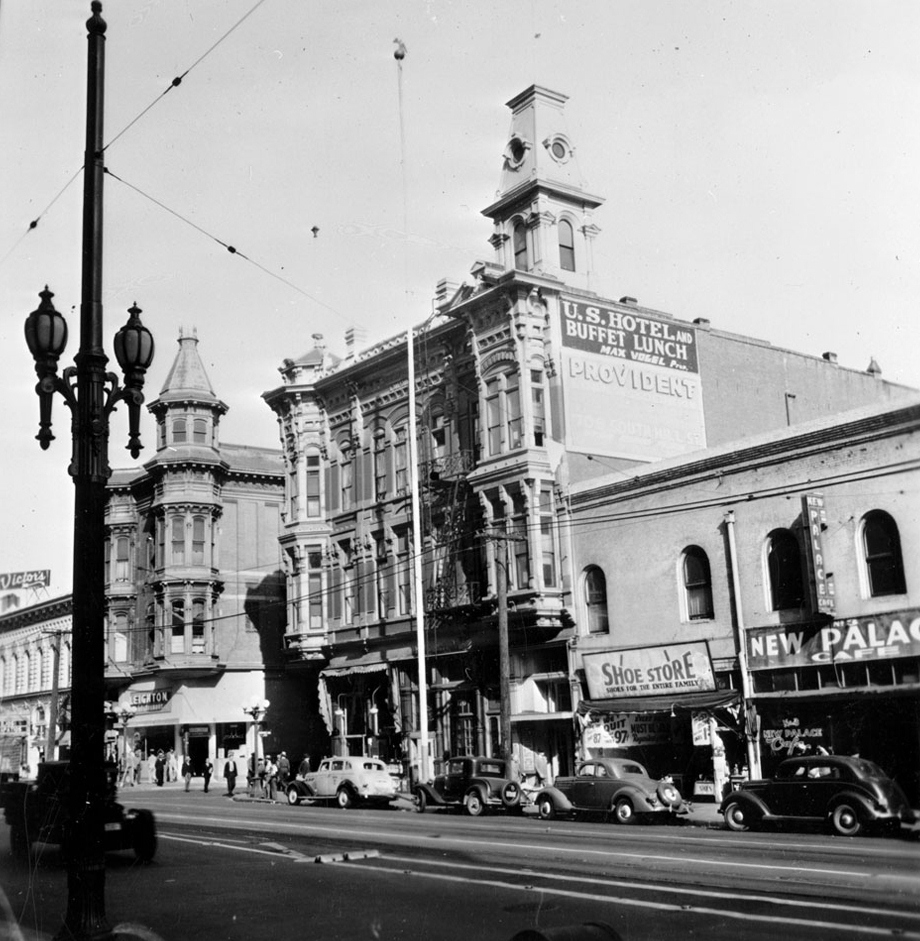 |
|
| (ca. 1937)*^ - Photograph showing a two-lamp combination streetlight trolley pole opposite the U.S. Hotel at 170 North Main Street. |
Historical Notes Variations of the UM-1906, the UM-2502, and similar dual uprights by other manufacturers also still exist in a number of outlying areas, generally neighborhood commercial in nature. They include the south side of Magnolia Avenue from Lankershim to Vineland and north side of Magnolia from Cleon to Cartwright in North Hollywood-Valley Village; 3400-3700 Slauson Avenue in Hyde Park; Seventh Street between Union and Garland Avenues in Westlake; La Cienega Boulevard between Airdrome Street and Olympic Boulevard, and Seventh Street between Catalina and Hoover Streets In the Wilshire area.* |
* * * * * |
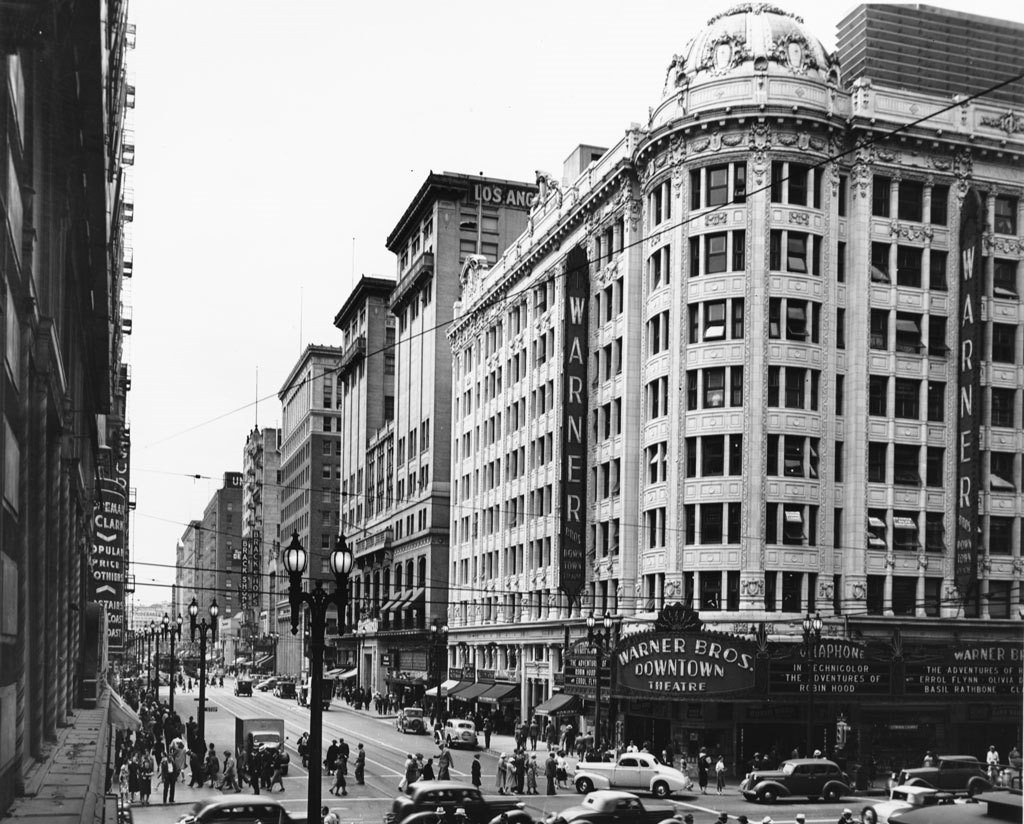 |
|
| (ca. 1938)*^ - View looking west on 7th Street at Hill. Two-lamp electroliers run up and down both 7th and Hill. The Warner Bros. Downtown Building is seen on the northwest corner. The Los Angeles Athletic Club sits just to the west of Warner Bros. on 7th Street. |
Westwood Specials
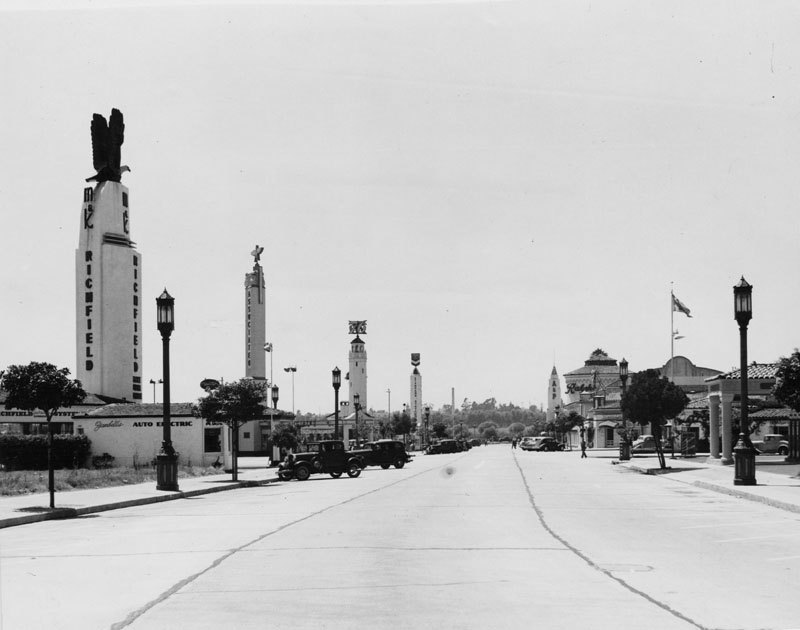 |
|
| (ca. 1937)^ - View of Westwood Boulevard in 1937. The ornate streetlights stand in front of a multitude of gas stations and retail stores. These streetlight electroliers are similar to those seen on Wilshire Blvd. except for the base of the posts, which have a different design. These lamps were called 'Westwood Specials'. |
Historical Notes Westwood Village adjacent to the University of California at Los Angeles (UCLA) was decorated in the early part of the century with the Westwood Special, notable for the blue and gold ceramic tile around its base. These were replaced with modern lights in the early 1960's when Westwood Village determined to become the brightest lighted commercial area in the world using 1,000-watt mercury vapor lamps.^^ |
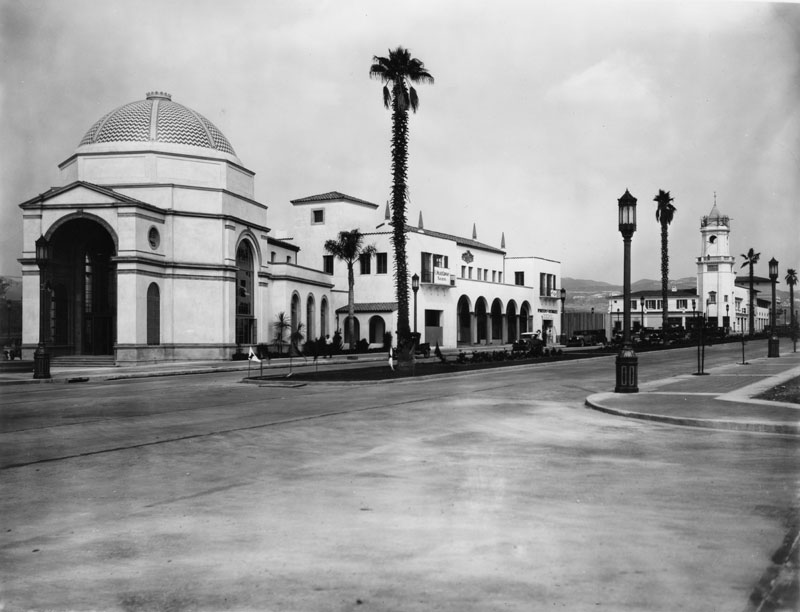 |
|
| (ca. 1930)^ - A view of Westwood Boulevard's Bank of America building, P. J. Walker Company and Phelps Terkel. This northwest corner of Westwood Boulevard and Broxton Avenue is called "The Dome," and it served as offices for the Janss Investment Company when built. The 'Westwood Special' streetlights can be seen on both sides of the street. |
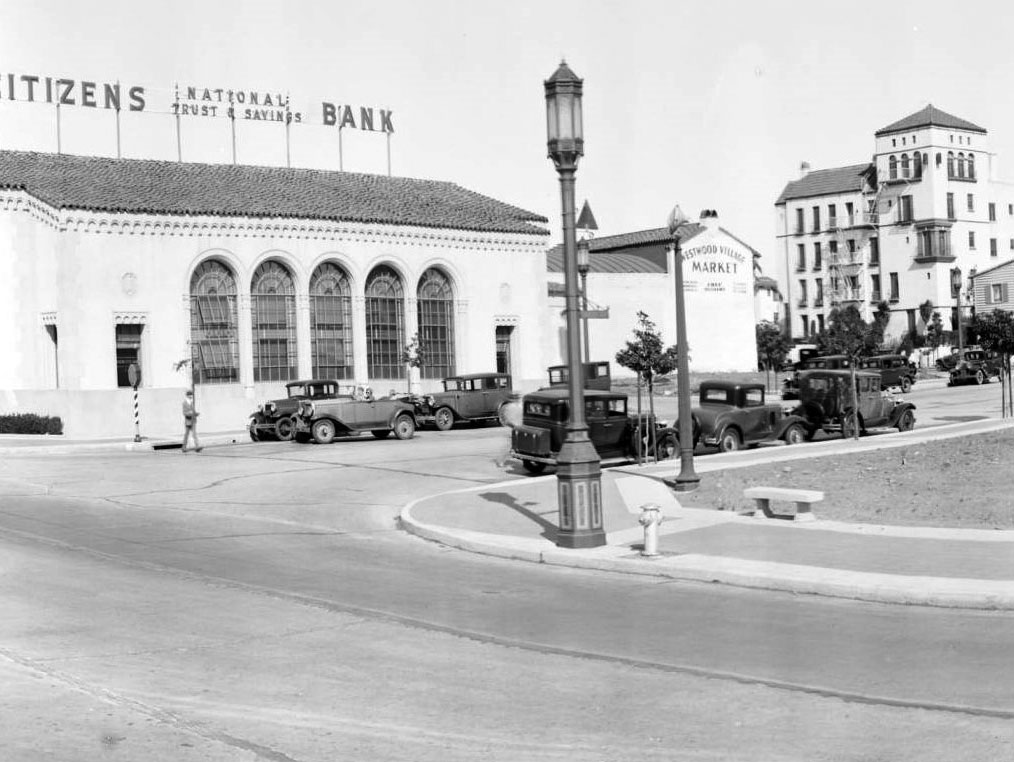 |
|
| (1932)* – View looking northeast at the intersection of Westwood Boulevard and Kinross Avenue where a “Westwood Special” streetlamp stands on the S/E corner. |
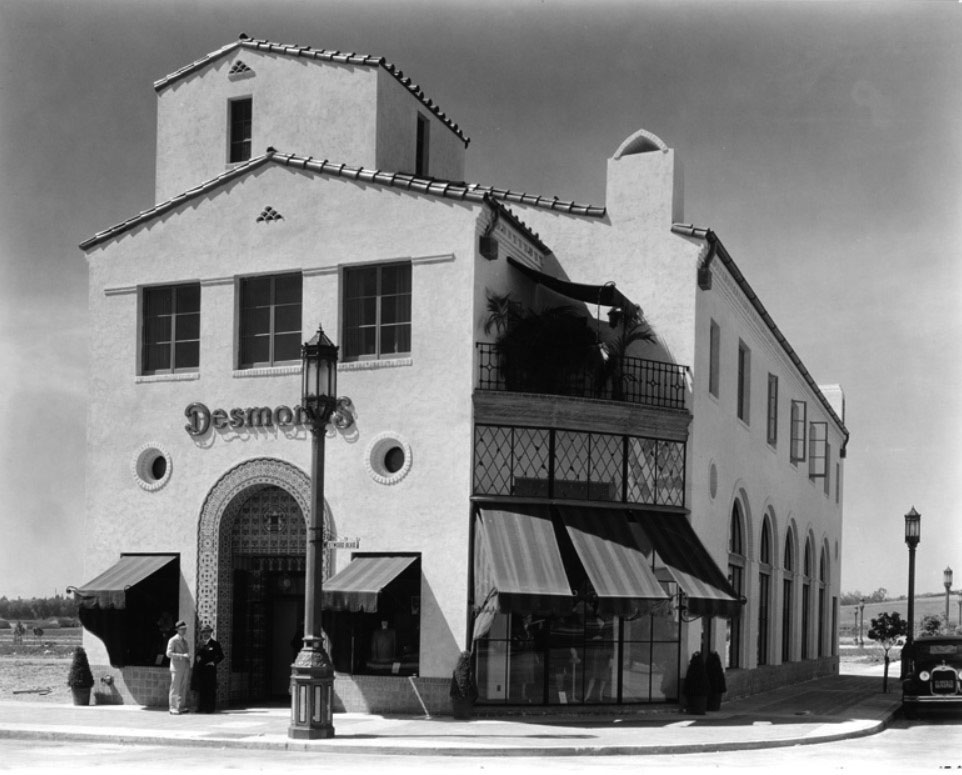 |
|
| (1929)* – A Westwood Special stands in front of the Desmond’s Building located at 1001 Westwood Blvd. |
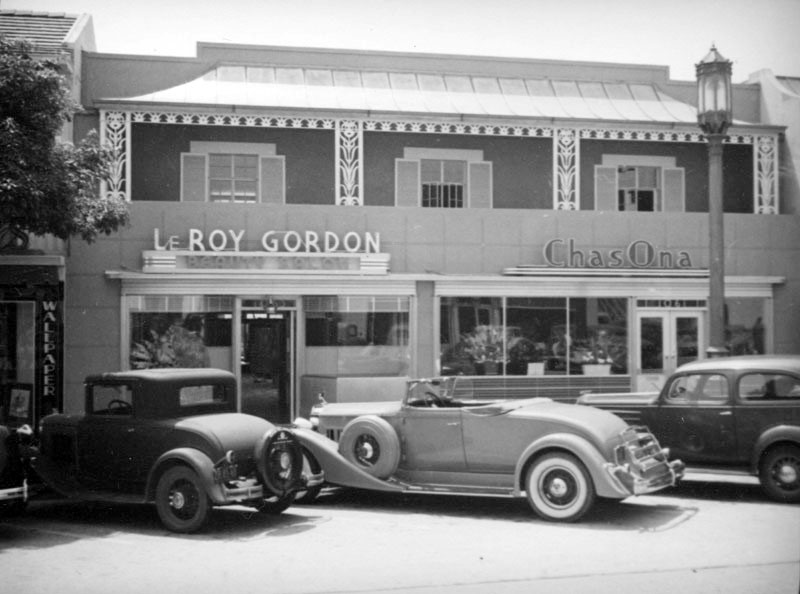 |
|
| (ca. 1937)* - A "Westwood Special" stands in front of two shops in Westwood Village: LeRoy Gordon and Chas. Ona, with cars parked diagonally in front. |
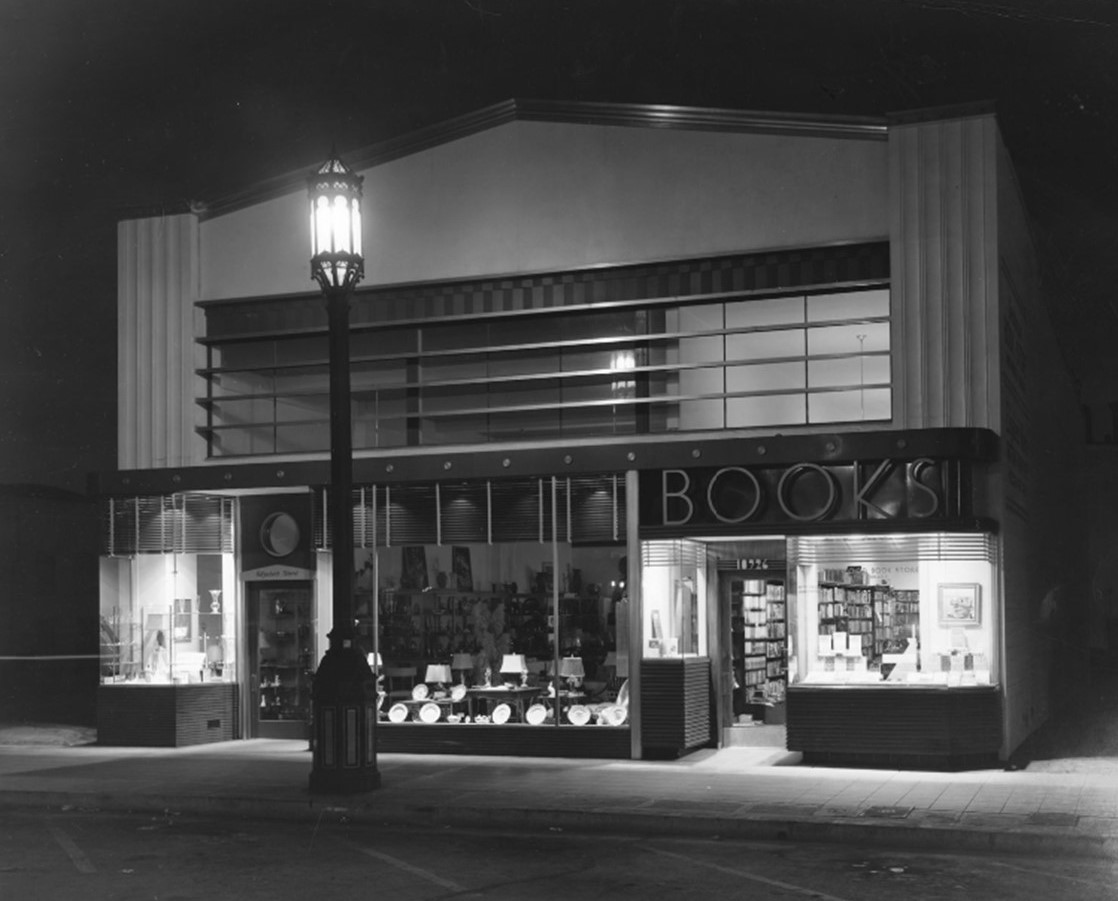 |
|
| (1938)^ – View showing an art deco style building located at 10926 Weyburn Avenue in Westwood Village. On the left is a lamp shop with plates and lamps in the display window. Next door, on the right, is the Westwood Bookstore which is still open late at night. A "Westwood Special" streetlight illuminates the building. |
Wilshire Specials
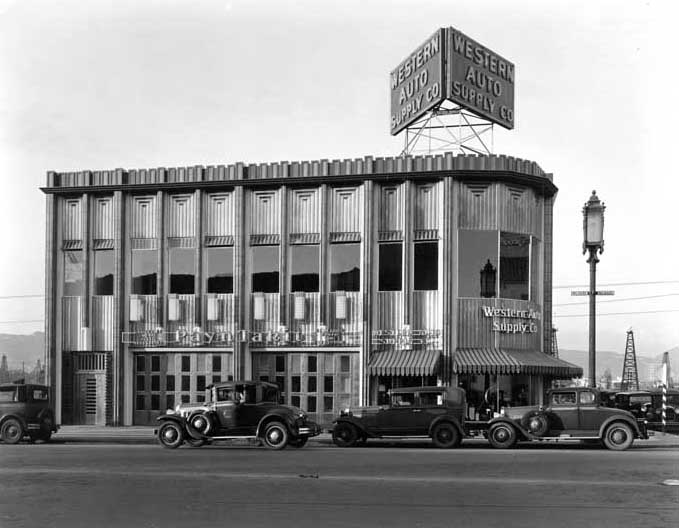 |
|
| (ca. 1933)^^^ - View looking north of the Western Auto Supply Co. Building located at 5655 Wilshire Boulevard. A tall "Wilshire Special" streetlight stands on the corner (Wilshire and Hauser). In the distance also stands an oil derrick. |
Historical Notes The Wilshire Special was predominantly seen on Wilshire Boulevared between the late 1920s thru the 1940s |
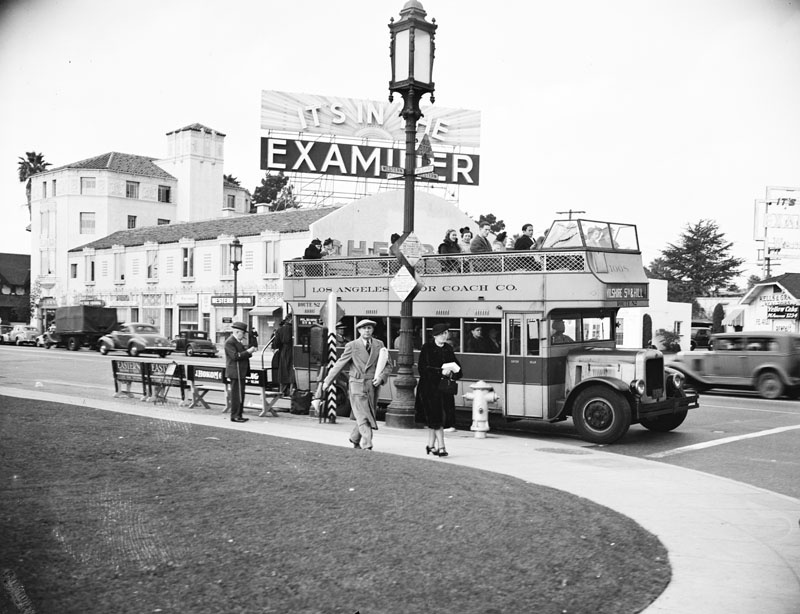 |
|
| (1937)^ - View showing a Wilshire Special standing on the corner of Wilshire and Western. Note the double-decker bus fill with passengers. This was the Route 82 motor coach that traveled from Wilshire to 5th and Hill. A very large marquee atop a building behind the coach reads: "It's in the Examiner", possibly making reference to the Herald Examiner newspaper. |
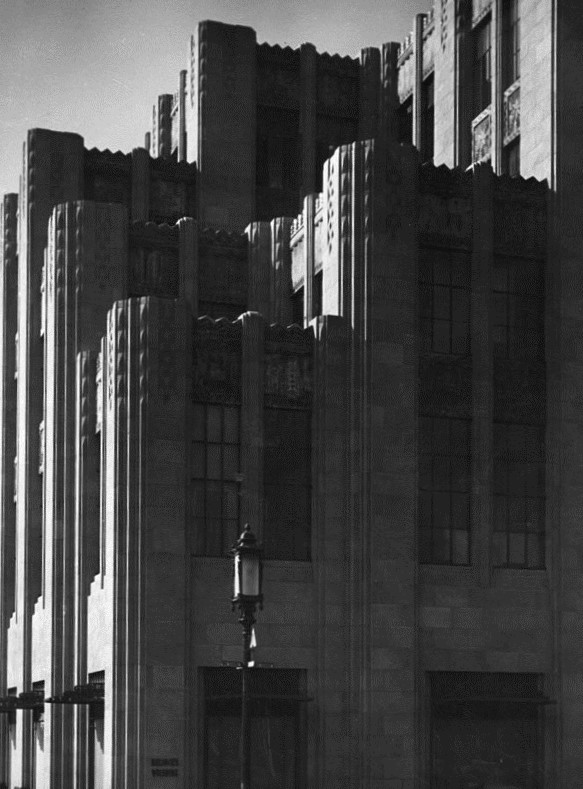 |
|
| (1938)^ - Close-up view of a portion of the western side of Bullock's Wilshire. An ornate “Wilshire Special” streetlight stands in front of the beautiful art deco building located at 3050 Wilshire Blvd. |
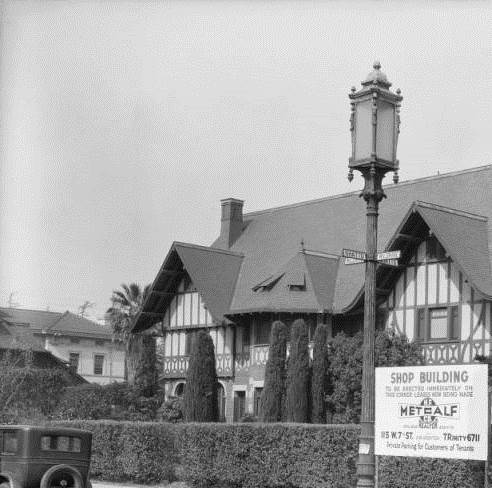 |
|
| (1931)*^ - Close-up view of another "Wilshire Special" on the corner of Wilshire and Shatto. Note how the street signs are attached to the post. |
Historical Notes Refurbished Wilshire Specials can still be found in downtown LA. (Click HERE). |
* * * * * |
Hollywood
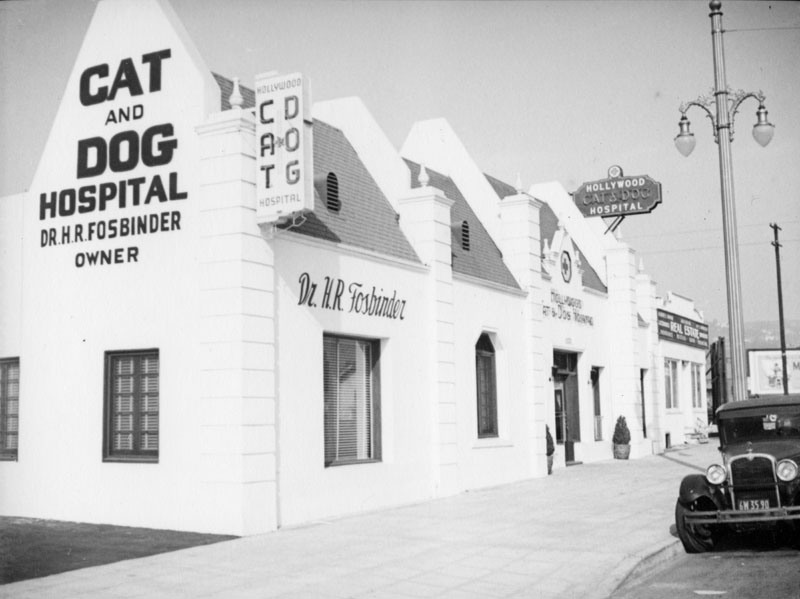 |
|
| (ca. 1937)^ - Dual-lamp electrolier with trolley cable connected to top of post in front of the Hollywood Cat and Dog Hospital located at 1151 North Highland Avenue. This building is still standing. |
Combination Streetlight, Trolley, and Power Poles
 |
|
| (1937)^*# - Looking north on Highland Avenue from Sunset Boulevard showing dual-lamp streetlights sharing space with power lines and streetcar cables. Hollywood High School can be seen at far left. In the center distance are the Hollywood United Methodist Church and the Hollywood First National Bank Building. To the right, on the NE corner, is Currie's Ice Cream parlor. |
Historical Notes The dual-lamp electroliers shown above were utilized in a most unique way. Cross-arms were installed on top of the electrolier post and power lines layed upon the arm. Also, streetcar wire ran across the street and was attached at both ends to the electroliers. |
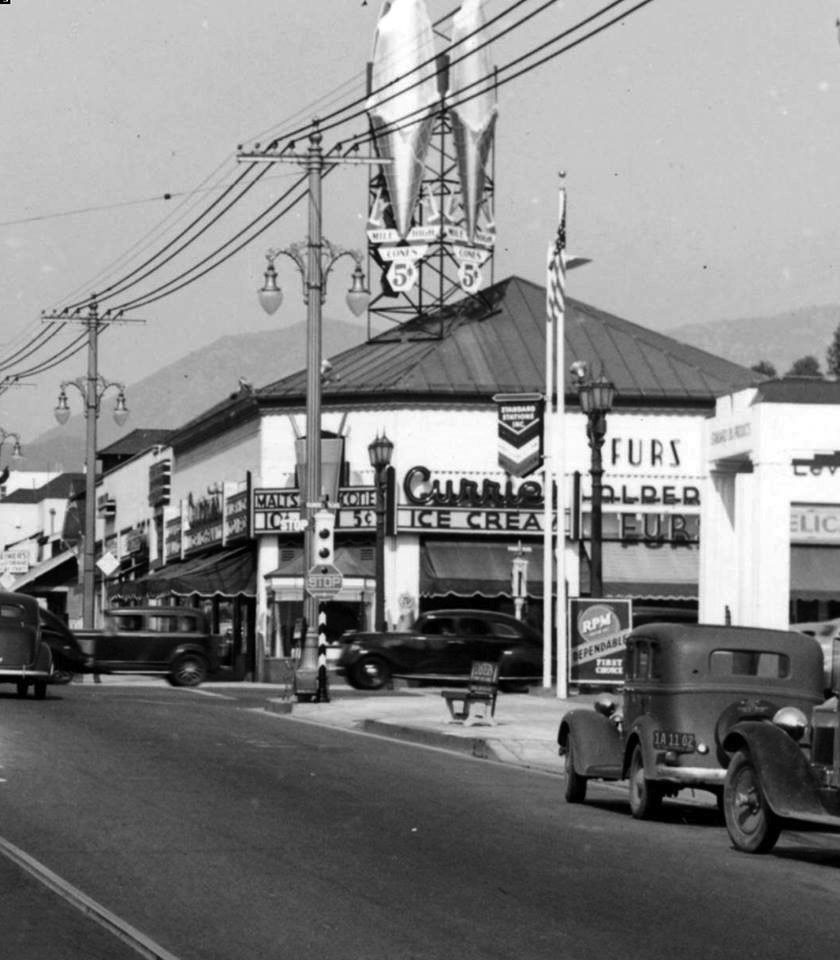 |
|
| (ca. 1936)* – Closer view showing the combination streetlight-power poles runing north and south on Highland Avenue. This view is looking north on Highland Avenue toward Sunset Boulevard with Currie's Ice Cream parlor seen on the northeast corner. |
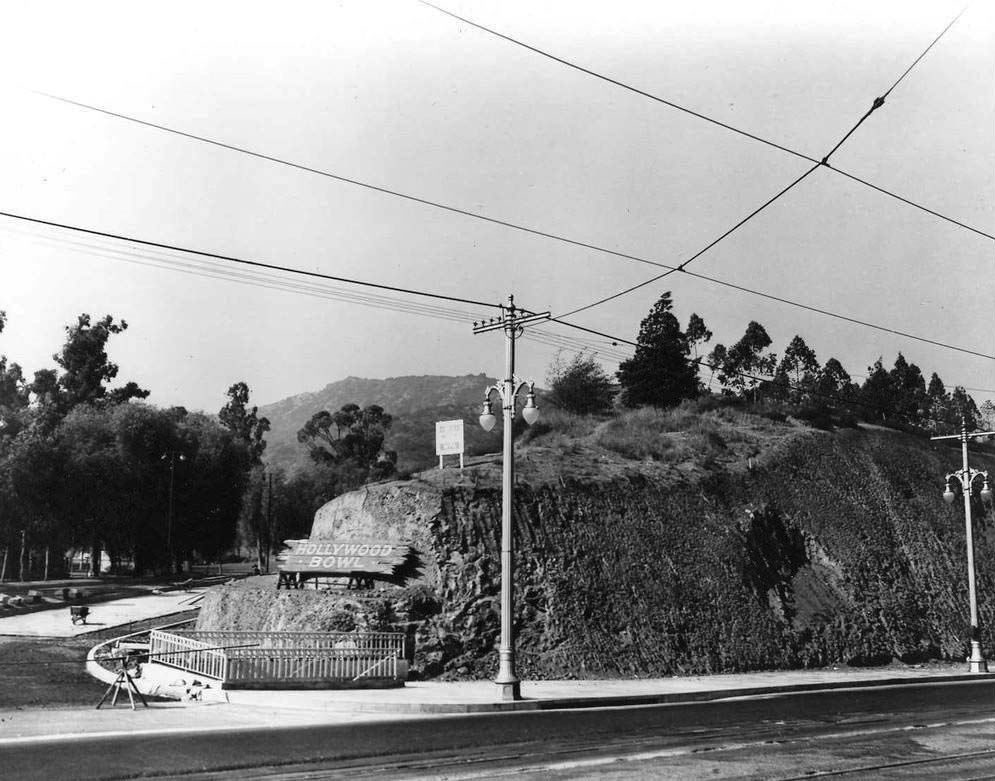 |
|
| (ca. 1930s)* – View showing combination streetlight, trolley, and power poles near the entrance to the Hollywood Bowl located at 2301 N. Highland Avenue. |
* * * * * |
 |
|
| (1937)* - View of dual-lamp style electroliers at the corner of Avalon Boulevard and West I Street in Wilmington. One side of the electrolier is capped off either for energy conservation or for keeping illumination levels to a minimum. |
| (ca. 1942)#*^ - View looking east from 6th and Beacon streets in San Pedro, with the Municipal Ferry building in the background. Note the ornate streetlights on both sides of the street. |
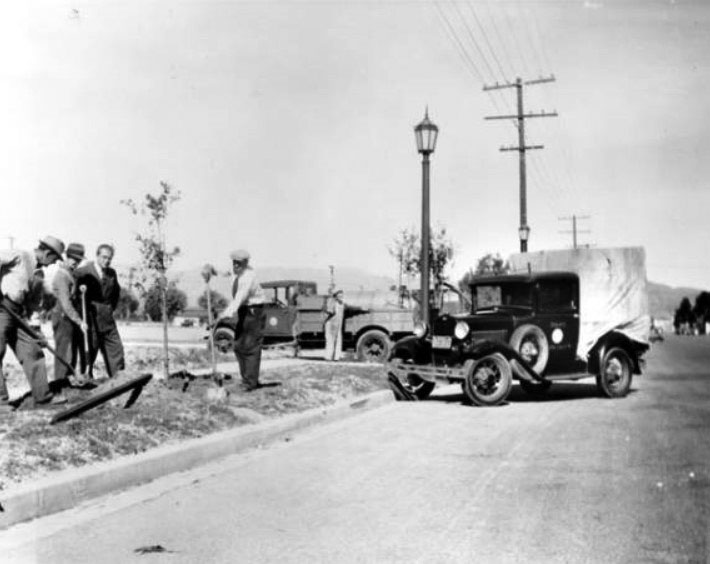 |
|
| (1938)#^ - Single-lamp Metropolitan electroliers stand on Reseda Boulevard between Parthenia Street and Roscoe Boulevard. Several men are seen planting trees. Carl S. Dentzel, a community leader, is visible at the center, wearing a suit. The other people in the photograph are from the Parks Department and Department of Forestry, City of Los Angeles. |
* * * * * |
UM-1906's - Westlake Area
 |
|
| (1931)^ – View looking north from 5th Street on Occidental Boulevard in the Westlake area. A row of 2-lamp UM-1906 streetlights stand in the center median in line with another row of palm trees. |
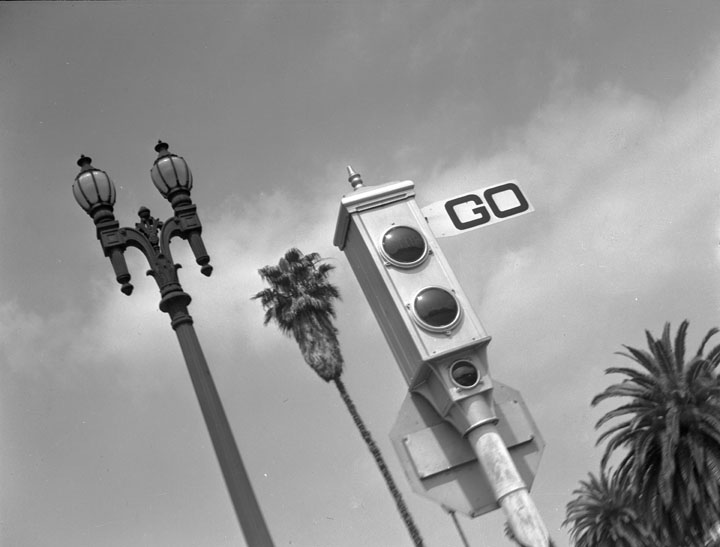 |
|
| (1937)* - Electrically operated Los Angeles traffic signal, with dual-lamp UM-1906 street light in background. |
* * * * * |
Dual Lamp UM-1906 - Downtown
.jpg) |
|
| (1940s)*^# – Postcard view showing a two-lamp electrolier (UM-1906) standing across the street from the Bullock’s Department Store at 650 S. Hill Street. |
Historical Notes Replacing the five-globe Llewellyn in Downtown Los Angeles and extending outward along several major streets, hundreds of dual-lamp electroliers (UM 1906's) were installed in the mid 1920's. |
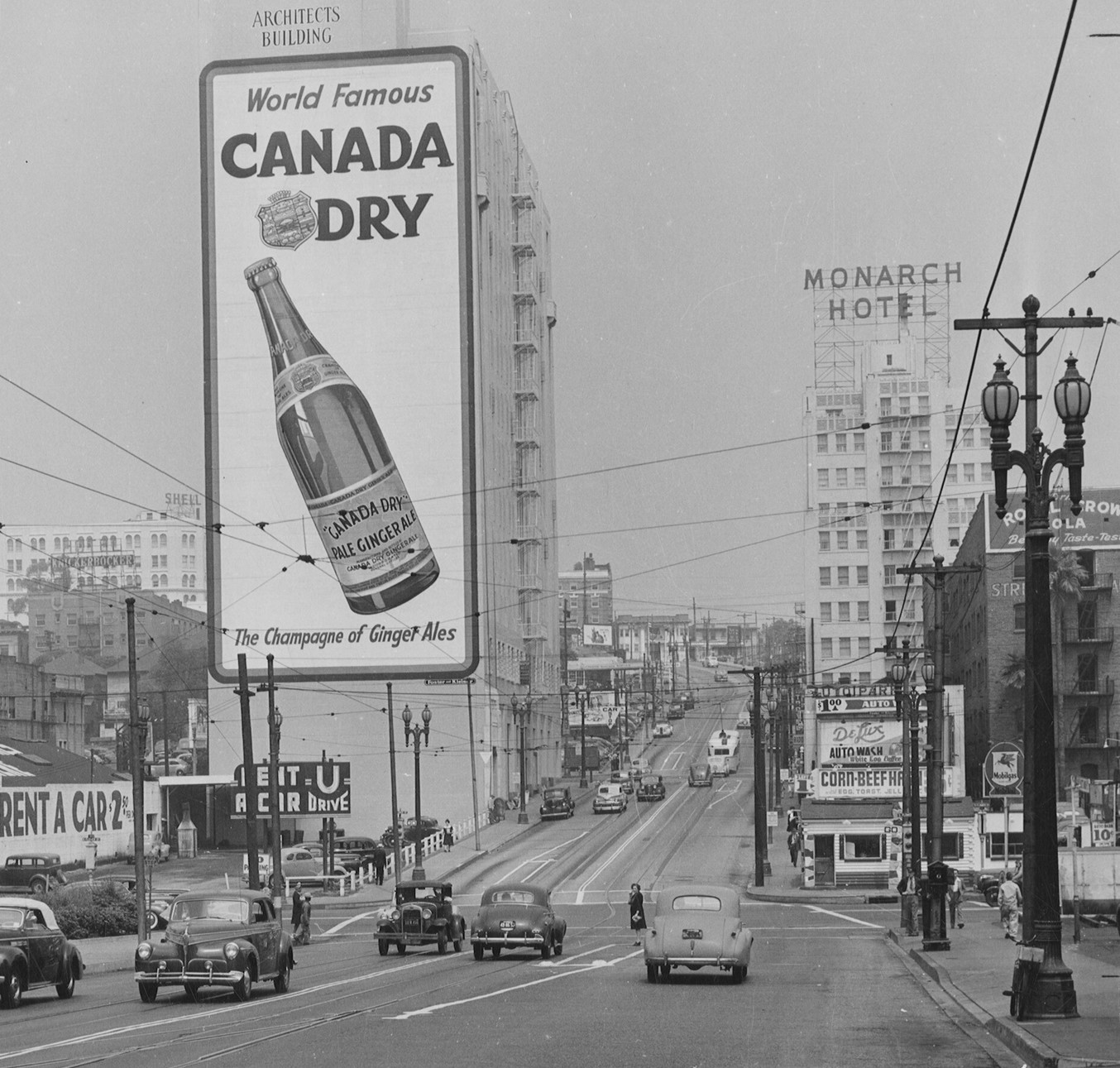 |
|
| (ca. 1944)* – Looking west on 5th Street toward Flower Street showing Dual-lamp UM-1906's lining both sides of the street. A larger than life for 'CANADA DRY GINGER ALE' advertising fills up the east face of the Architects Building, SE corner of 5th & Figueroa. Also seen here is the Monorach Hotel located on the NW corner of 5th and Figueroa. |
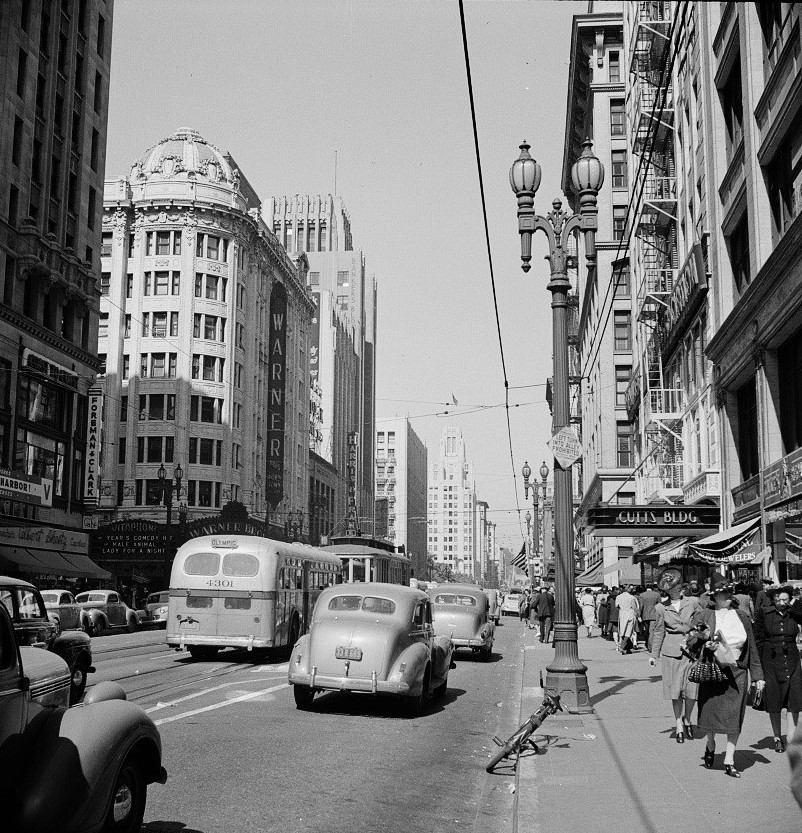 |
|
| (1941)* - View looking north on Hill Street toward 7th Street with the Warner Theatre on the NW corner. Dual lamp UM-1906s run up and down Hill Street. |
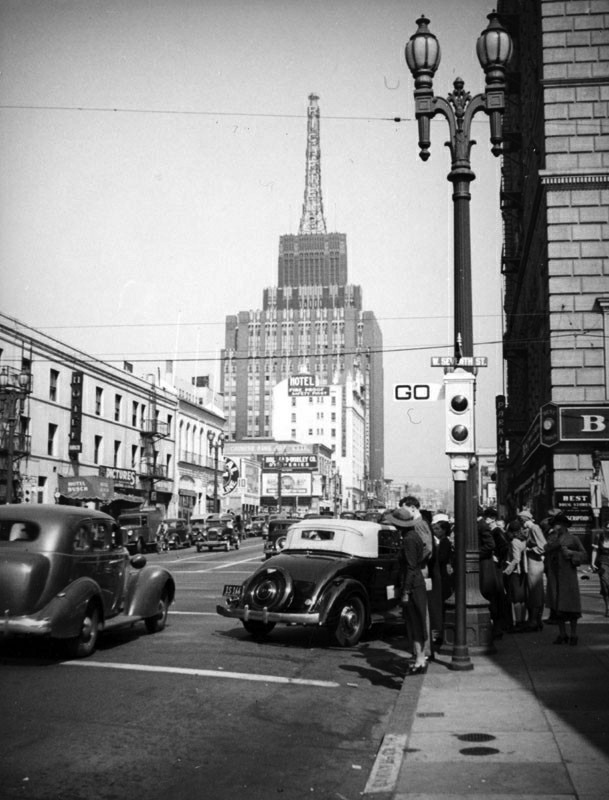 |
|
| (ca. 1940)^ – View looking north on Flower at 7th Street with the Richfield Oil Company Building (555 S. Flower St.) standing tall in the background. A dual-lamp streetlight (UM-1906) stands behind an old-style traffic signal (Semaphore). |
Historical Notes Los Angeles installed its first automated traffic signals in October 1920 at five locations on Broadway. These early signals, manufactured by the Acme Traffic Signal Co., paired "Stop" and "Go" semaphore arms with small red and green lights. Bells played the role of today's amber or yellow lights, ringing when the flags changed—a process that took five seconds. By 1923 the city had installed 31 Acme traffic control devices. ^* |
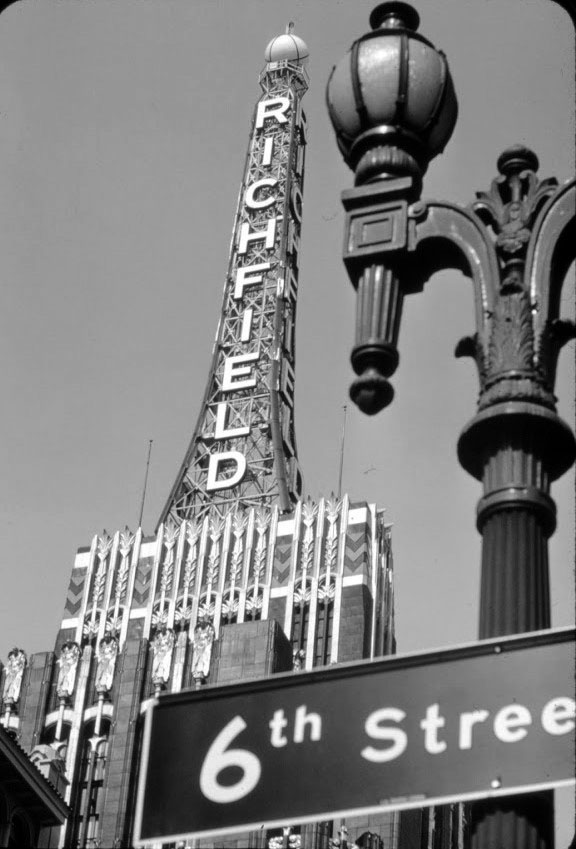 |
|
| (n.d.)^^* – View looking up at the Richfield Oil Company Building tower from 6th Street showing a close-up of the two-lamp ornate streetlight (UM-1906). |
* * * * * |
USC
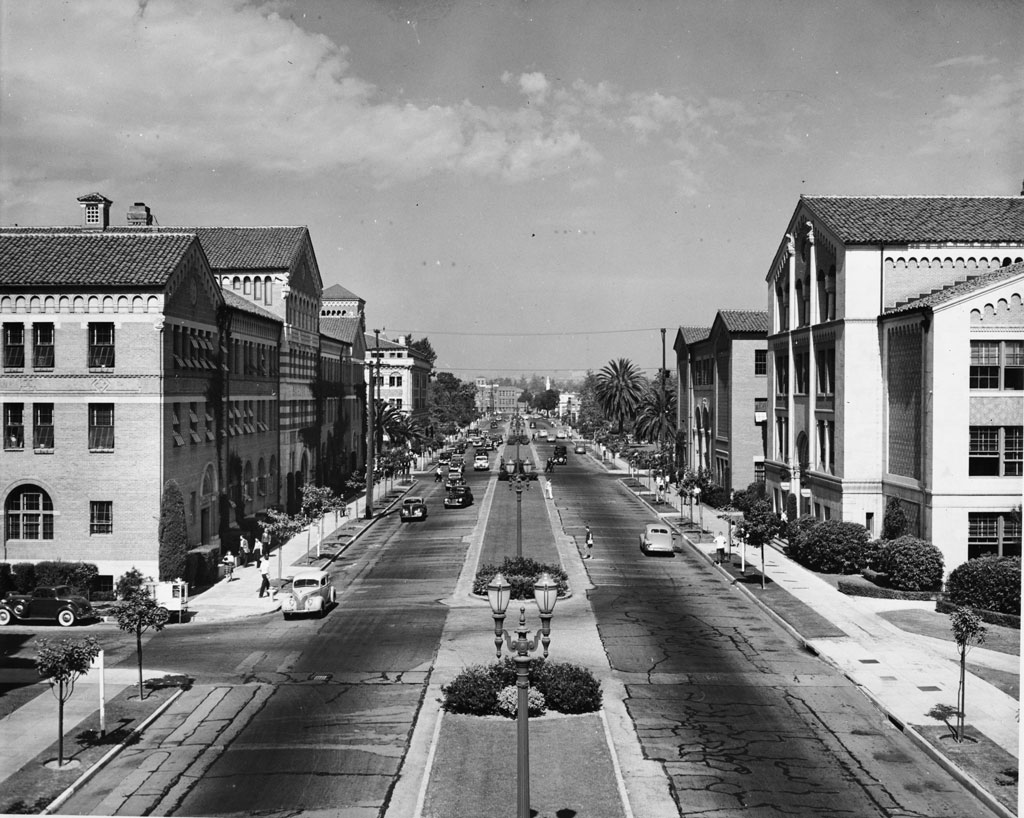 |
|
| (1940)^^ - Dual-lamp electroliers situated in the center median of Trousdale Parkway on the USC campus in 1940, when it was still a public street. The view looks northeast up Trousdale (then named University Avenue) from Exposition Boulevard. Click HERE to see more in Early Views of USC. |
Wilshire Special
 |
|
| (1940)* - Ornamental streetlight electroliers (Wilshire Special) on Wilshire Boulevard west of Rossmore. |
Contemporary Streetlight Maintenance
 |
|
| (2013)^^* – View showing two maintenance workers replacing a broken glass panel on a 'Wilshire Special', located in front of the Wilshire Grand Hotel. Photo by Gary Leonard |
 |
|
| (2020)* - Bureau of Streetlight Maintenance worker changes lamps of a Wilshire Double located on the South side of Wilshire Boulevard between Dunsmuir and Cochran Avenues. Photo by Glen Norman |
Historical Streetlight Maintenance
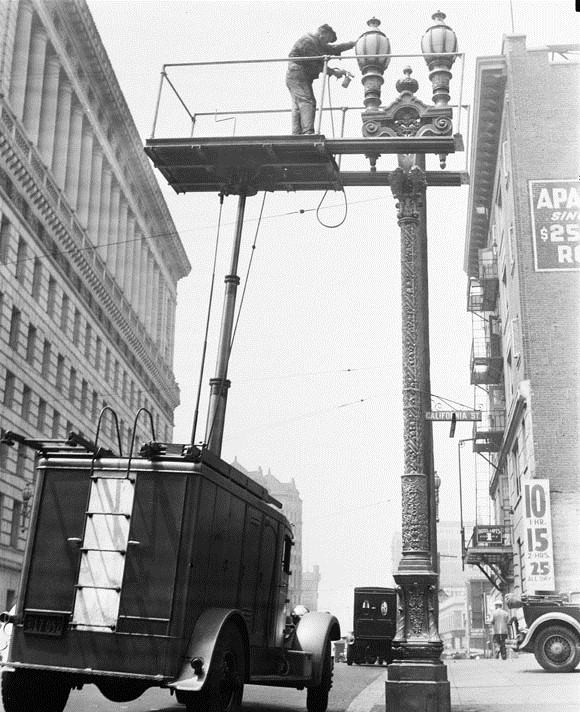 |
|
| (1935)* – Greatly facilitating the maintenance work on street light standards, a new five-ton tower truck was placed in service June 6th by the Power Bureau’s Street Lighting section. The first painting job assigned to the truck’s crew was to a dual-lamp electrolier called a Broadway Special, located on Broadway between California and Temple Streets (SW corner of Broadway and Caliornia Street). |
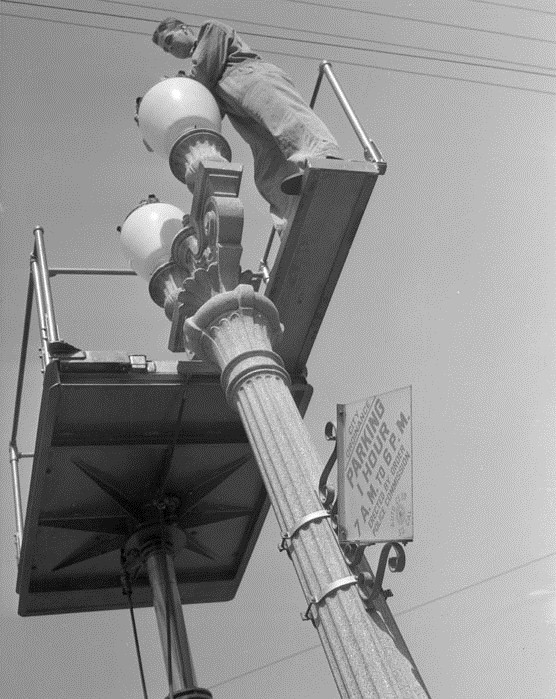 |
|
| (ca. 1940)* - Early DWP Streetlight Maintenance worker repairs an electrolier. |
* * * * * |
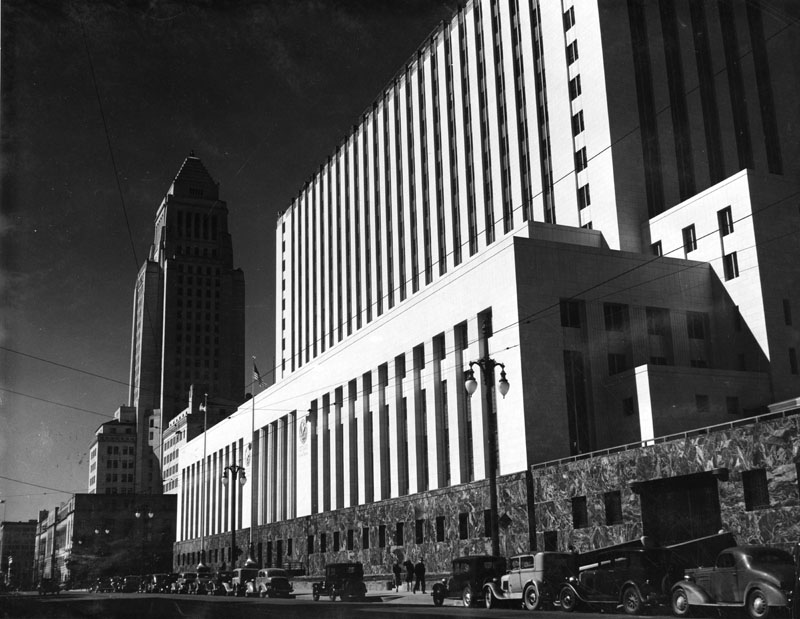 |
|
| (ca. 1940)^ - View of dual-lamp electroliers standing in front of the newly constructed Federal Courthouse. City Hall can be seen in the background. |
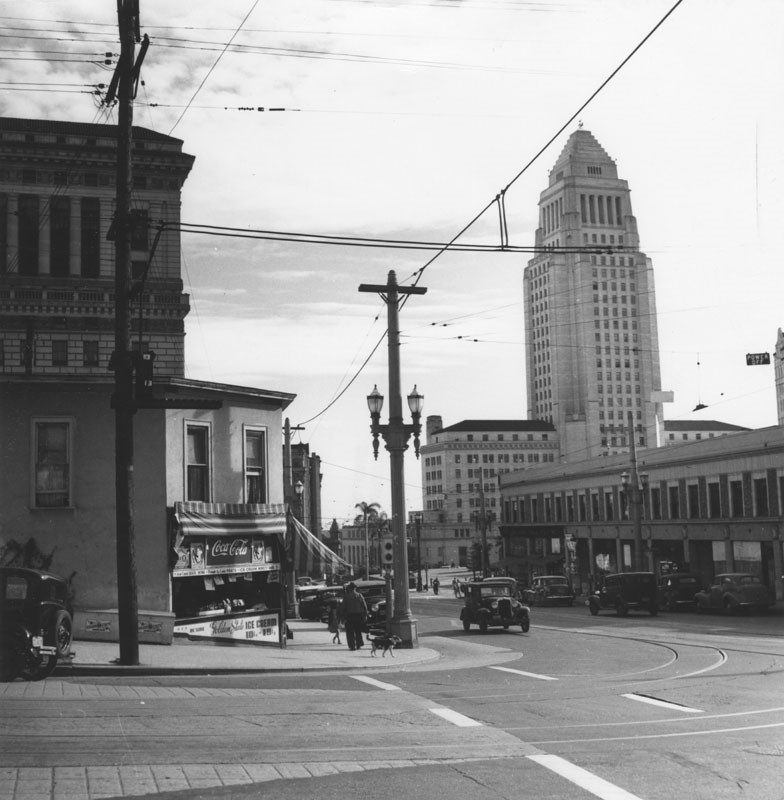 |
|
| (ca. 1940)^ - A dual-lamp electrolier is being utilized as a streetlight and a utility pole on the corner of Temple and Hill streets. In the background stands City Hall. Photo by Ansel Adams |
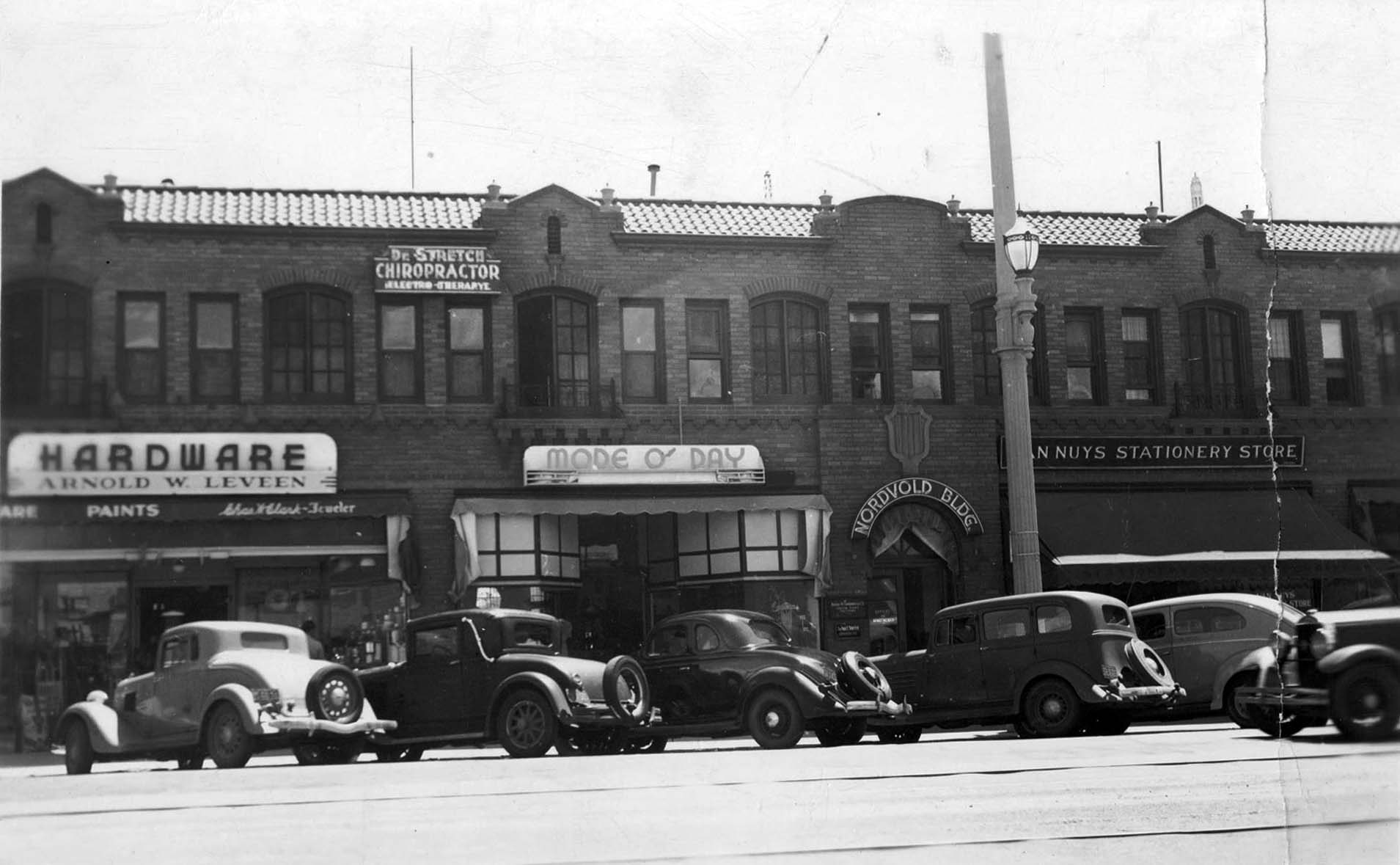 |
|
| (ca. 1940)**# - A single-arm streetlight post sits in front of the Nordvord Building located at 6420 Van Nuys Blvd., just north of Victory Blvd. This is the same type electrolier as seen in previous photo but with only a one arm extension. |
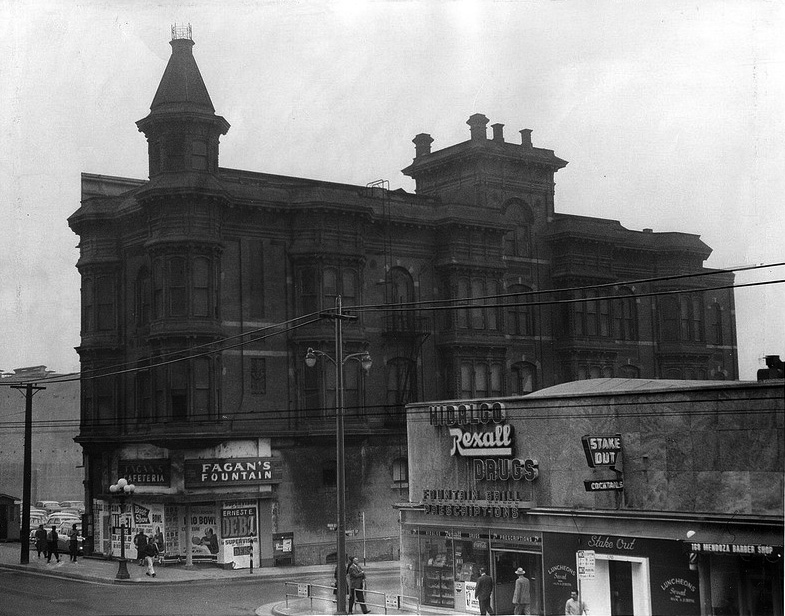 |
|
| (1955)^#^ - View of another dual-lamp electrolier that is being utilized both as a streetlight and a utility pole. It is located on the southeast corner of Market and Main streets across from City Hall. Today, Market Street no longer exists and City Hall East stands at this location. |
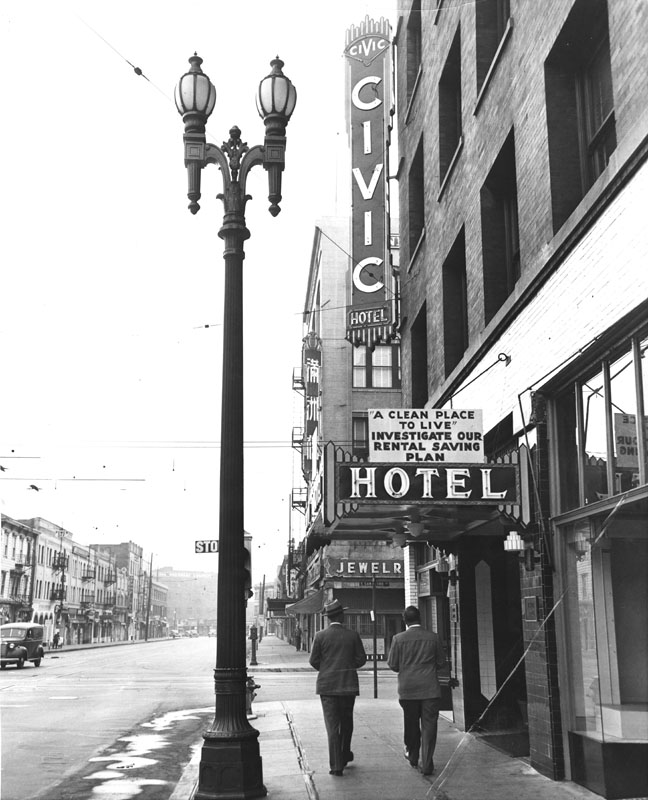 |
|
| (1942)^ - A dual-lamp electrolier (UM-1906) towers above the sidewalk as two men walk by near the corner of 1st and San Pedro streets on June 17, 1942. The streets look deserted. |
WWII Modified Streeltights
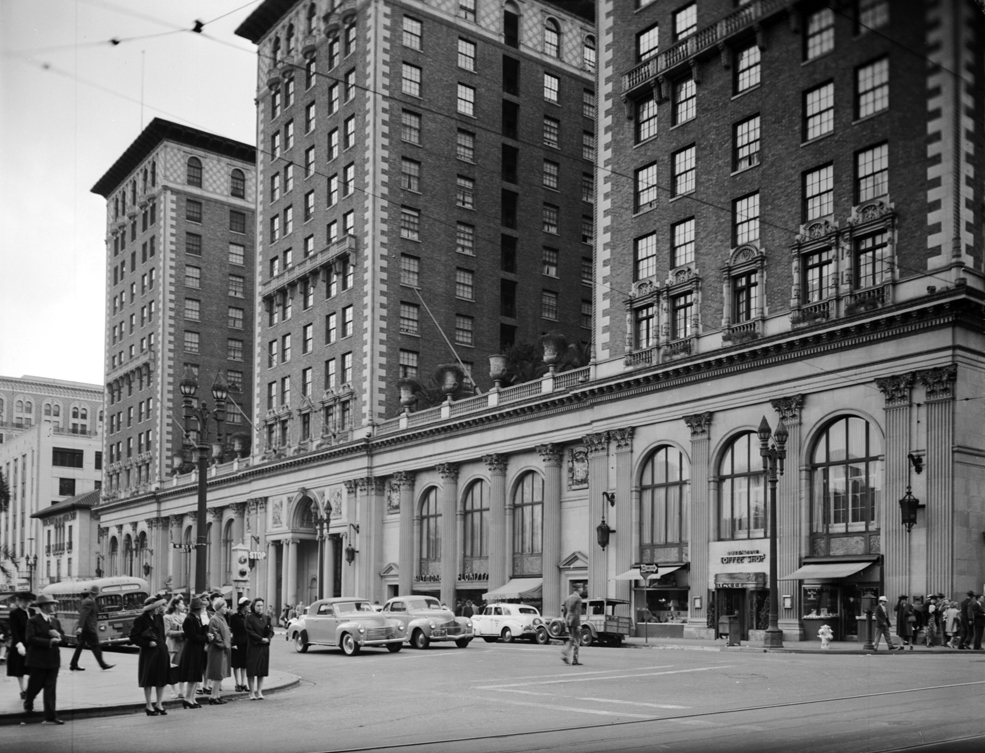 |
|
| (1943)*# - Two-lamp ornate electroliers in front of the Biltmore Hotel as seen from the corner of Olive and 5th Streets. Notice that the top of the streetlights are blacked-out (during WWII). |
Historical Notes During the War many streetlights throughout the City were blacked-out on top as a preventative measure. |
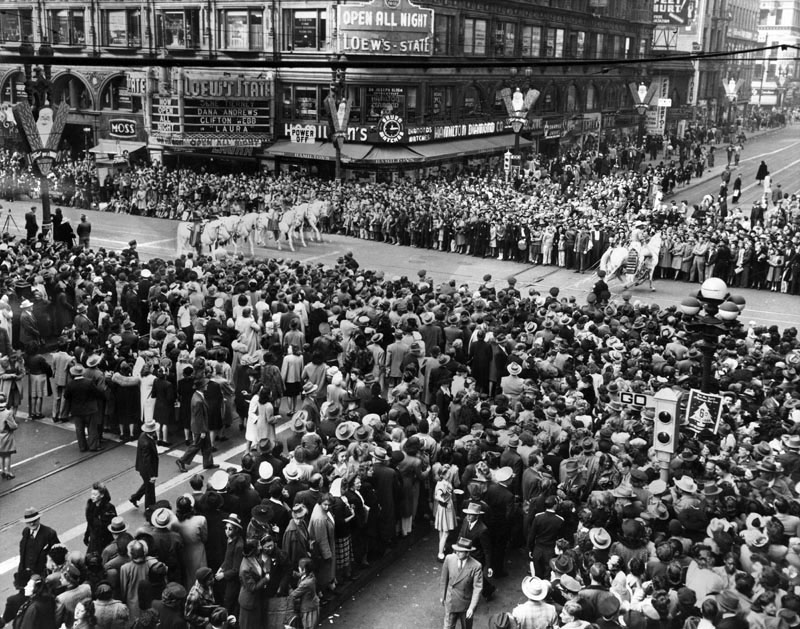 |
|
| (1944)^ - View of the War Loan Drive Parade at the busy intersection of Seventh and Broadway. In the lower right stands a 5-lamp electrolier with 4 of the 5 bulbs blacked-out on top. |
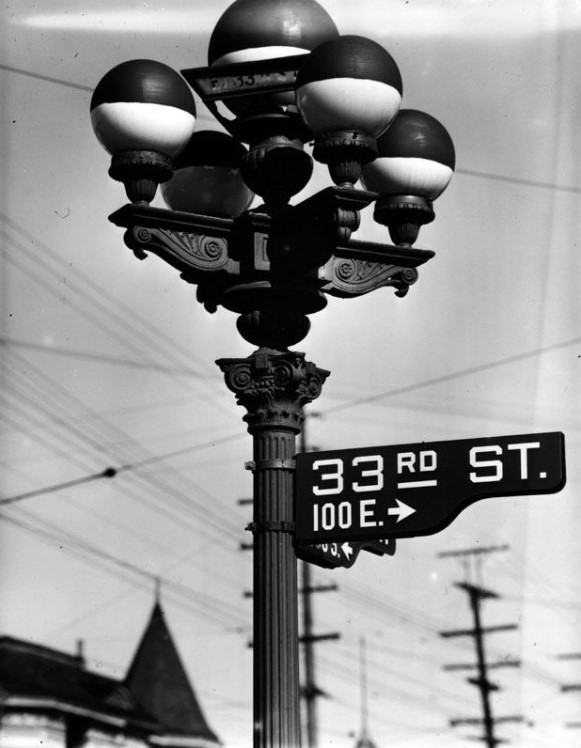 |
(ca. 1943)* - Close-up view of a five-globe Llewellyn streetlight located on the corner of Main and 33rd streets with all five bulbs blacked-out on top (during WWII). Note the old trapezoidal street sign imbedded just below the topmost globe.^^#
|
North Hollywood (UM-1931)
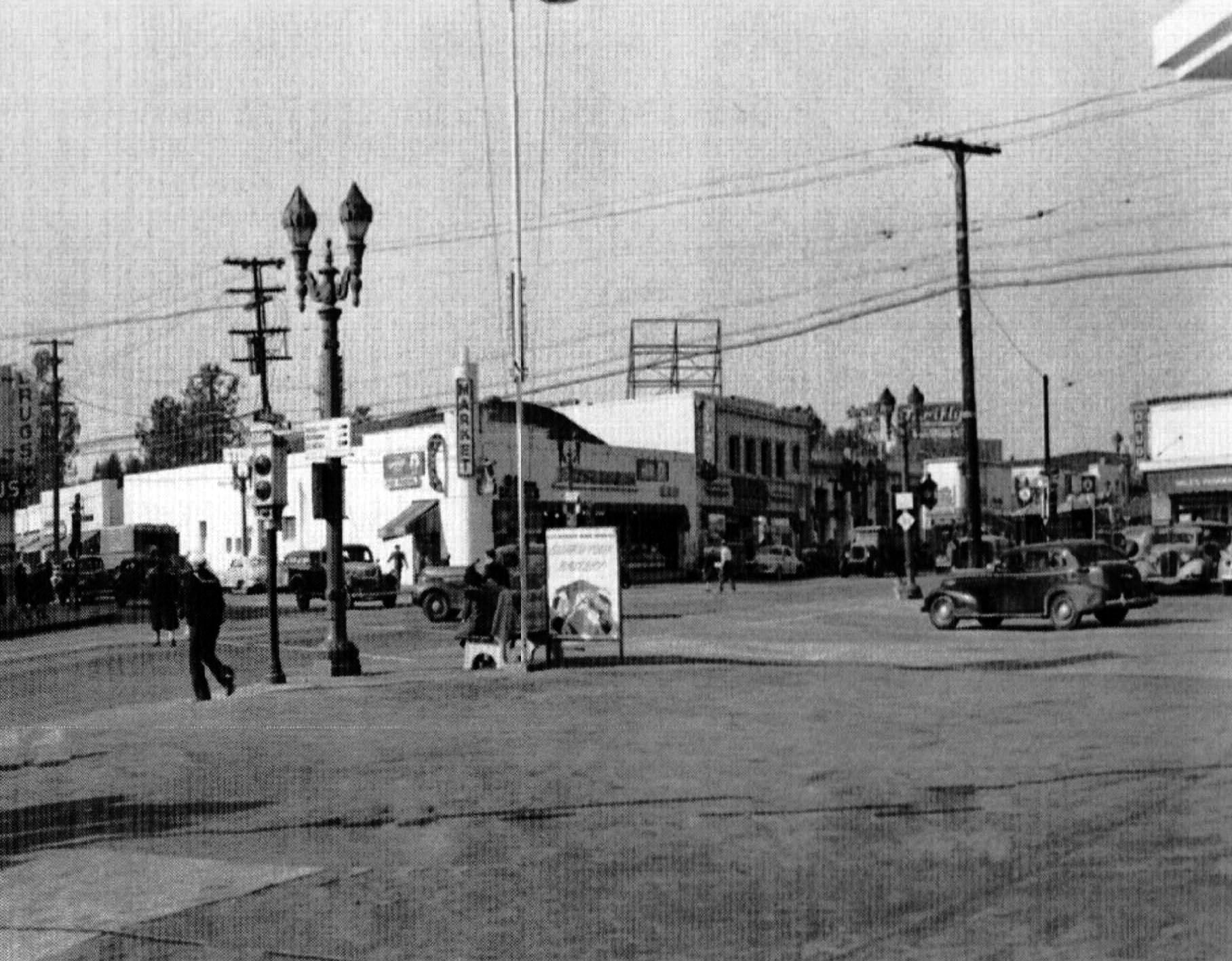 |
|
| (ca. 1945)^.^ – Ornate two-lamp electroliers (UM-1931) with tops blacked-out (WWII), located at the intersection of Lankershim and Magnolia in North Hollywood. The view is looking northwest with Fitzsimmons Market seen on the NW corner. |
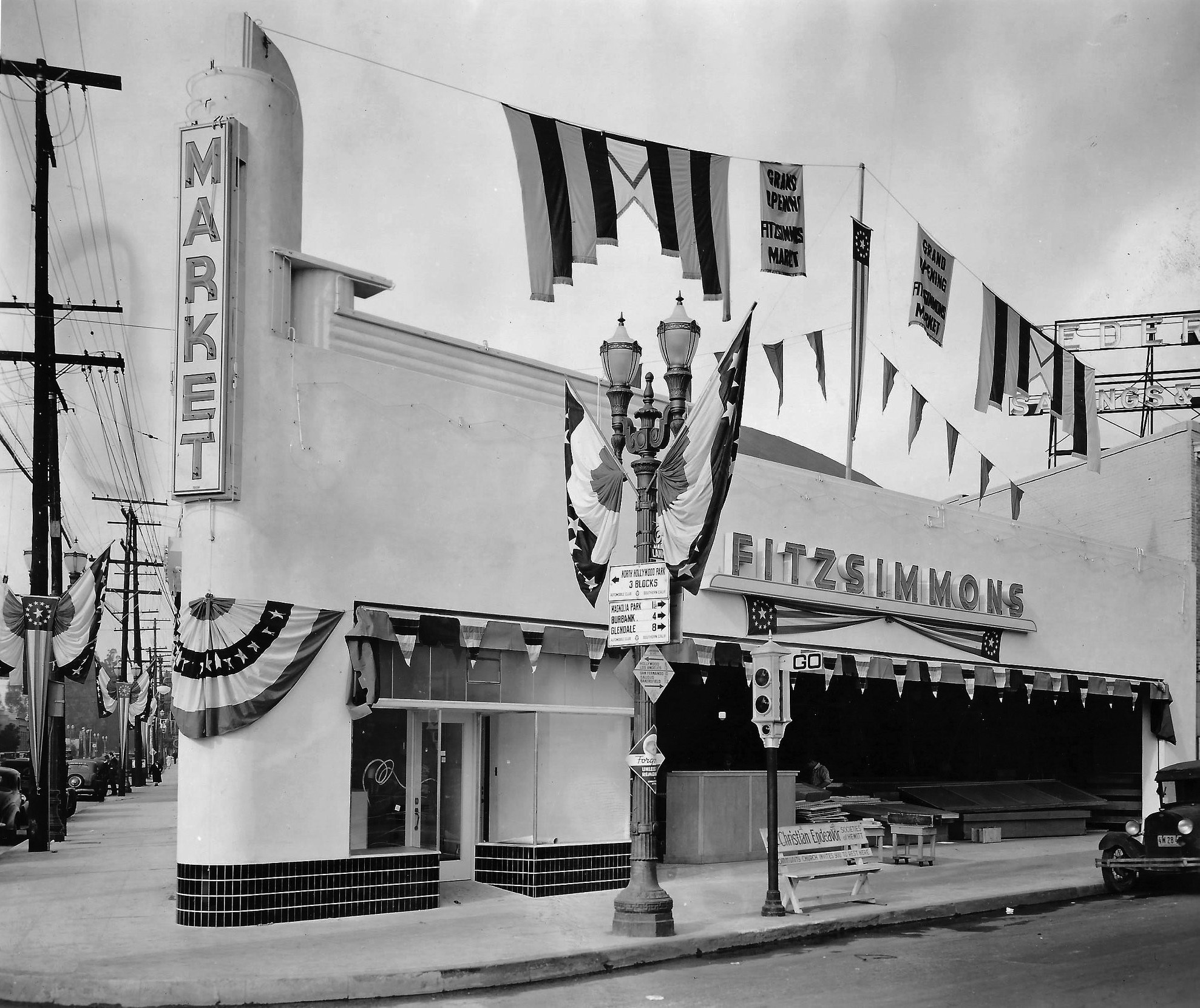 |
|
| (ca. 1940)^.^ - View looking at the NW corner of Lankershim and Magnolia showing Fitzsimmons Market being prepared for its Grand Opening. Note the Semaphore traffic signal* standing by the beautiful UM-1931 dual-lamp streetlight (without black-out tops; pre-WWII)). Sign on streetlight reads: North Hollywood Park – 3 blocks with arrow pointing to the West. Lower part of sign points to the East and reads: Magnolia Park – 1½ Miles; Burbank – 4 Miles; Glendale – 8 Miles |
Historical Notes *These early signals, manufactured by the Acme Traffic Signal Co., paired “Stop” and “Go” semaphore arms with small red and green lights. Bells played the role of today’s amber or yellow lights, ringing when the flags changed—a process that took five seconds. |
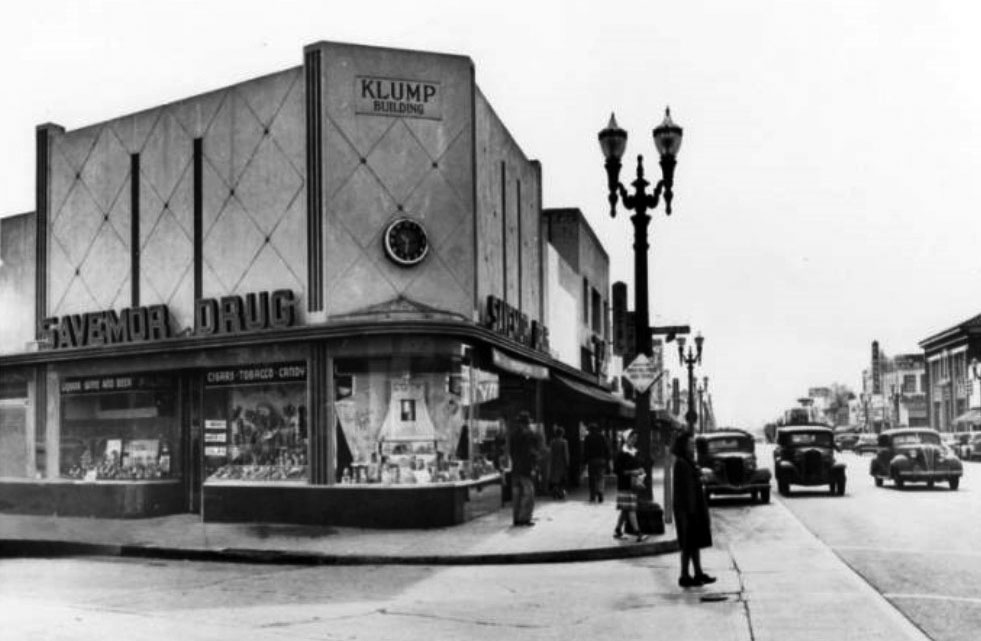 |
|
| (ca. 1946)* - View looking south on Lankershim Boulevard at Chandler Boulevard. Ornate two-lamp UM-1931 electroliers (without the black-out tops; post WWII) line both sides of Lankershim. |
Historical Notes 704 of the UM-1931s were shipped to Los Angeles by Union Metal between 1906 and 1930. They were installed in the North Hollywood, Boyle Heights and the Mid-City. |
Mid-City (UM-1931)
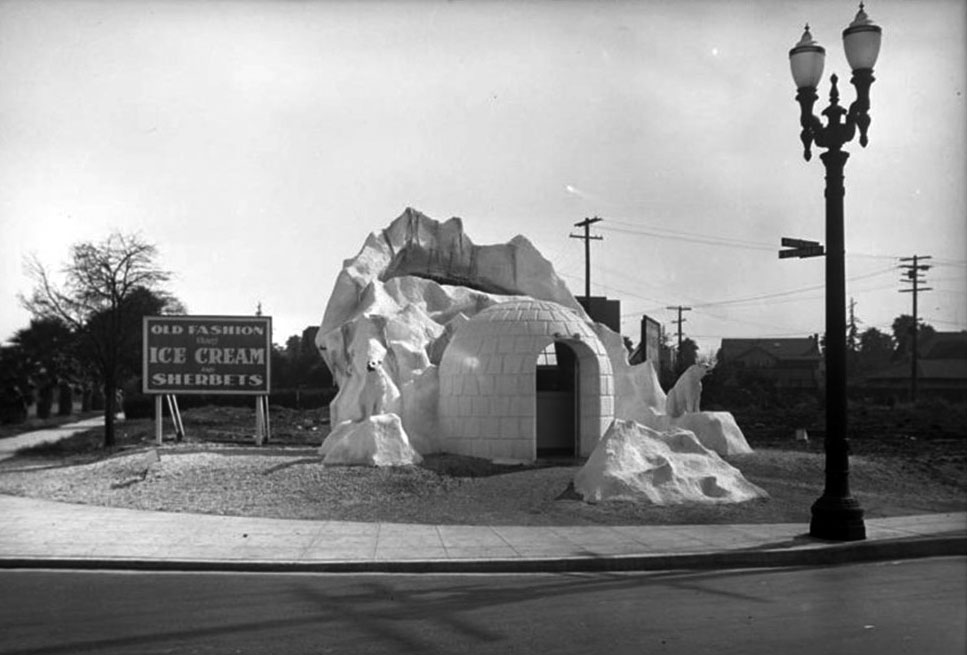 |
|
| (ca. 1930)* - View showing a dual-lamp Union Metal streetlight (UM-1931) located on the SW corner of Pico Blvd and Victoria Ave. |
Historical Notes In the above photo is an odd looking structure in the form of an Igloo. It was an Ice Cream parlor with the name of, you guessed it, “The Igloo”. Click HERE to see more. |
Bolyle Heights (UM-1931)
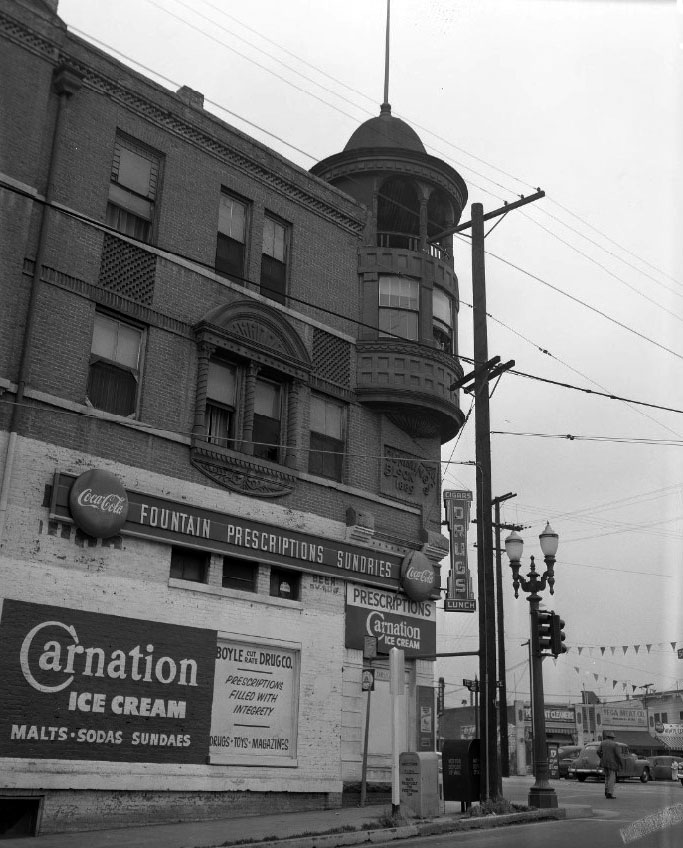 |
|
| (ca. 1950)^^+ - View looking at northwest corner of E 1st St. and Boyle Ave showing an ornate two-lamp UM-1931 electrolier similar to the one seen in previous photo. The building at the corner is the 1889-built Boyle Hotel which still stands today. |
* * * * * |
Ventura Specials
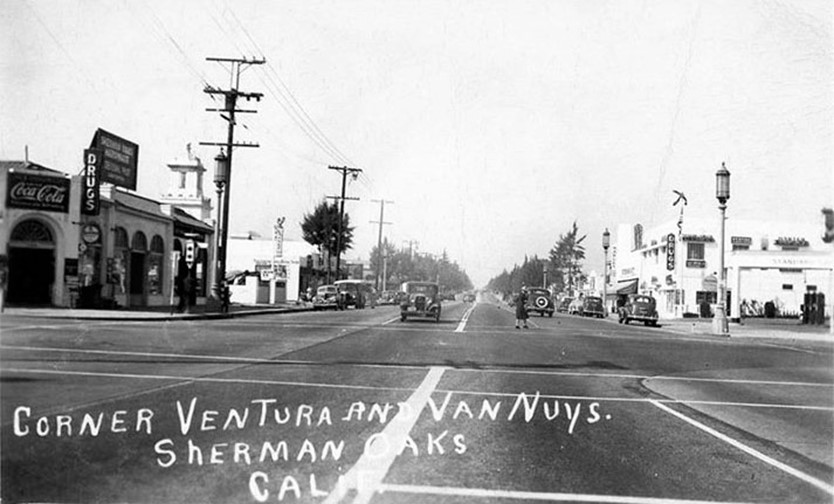 |
|
| (1940s)* - Looking west on Ventura Boulevard at Van Nuys Blvd in Sherman Oaks. “Ventura Specials” streetlights line both sides of the boulevard. |
Historical Notes The “Ventura Special" lined Ventura Boulevard from Sepulveda Eastward to Lankershim, and then Cahuenga Boulevard West from Lankershim to Hollywood Bowl. Although none of the full street lights survive, a few of the lanterns can be found on the Fletcher Drive Bridge over the L. A. River in Atwater Village. |
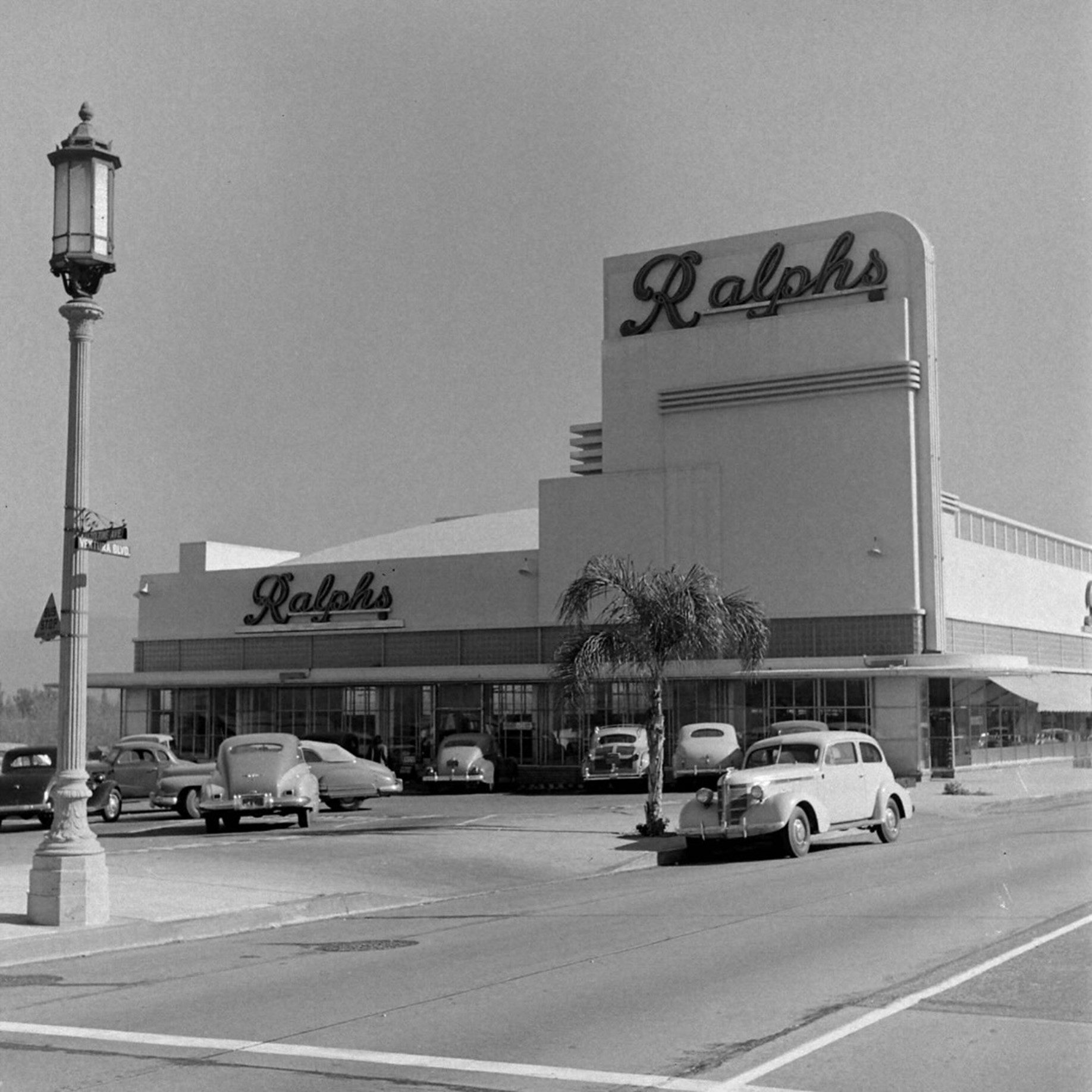 |
|
| (1948)* – A “Ventura Special” stands on the NE corner of Ventura and Hazeltine in Sherman Oaks in front of the Ralphs Market parking lot. |
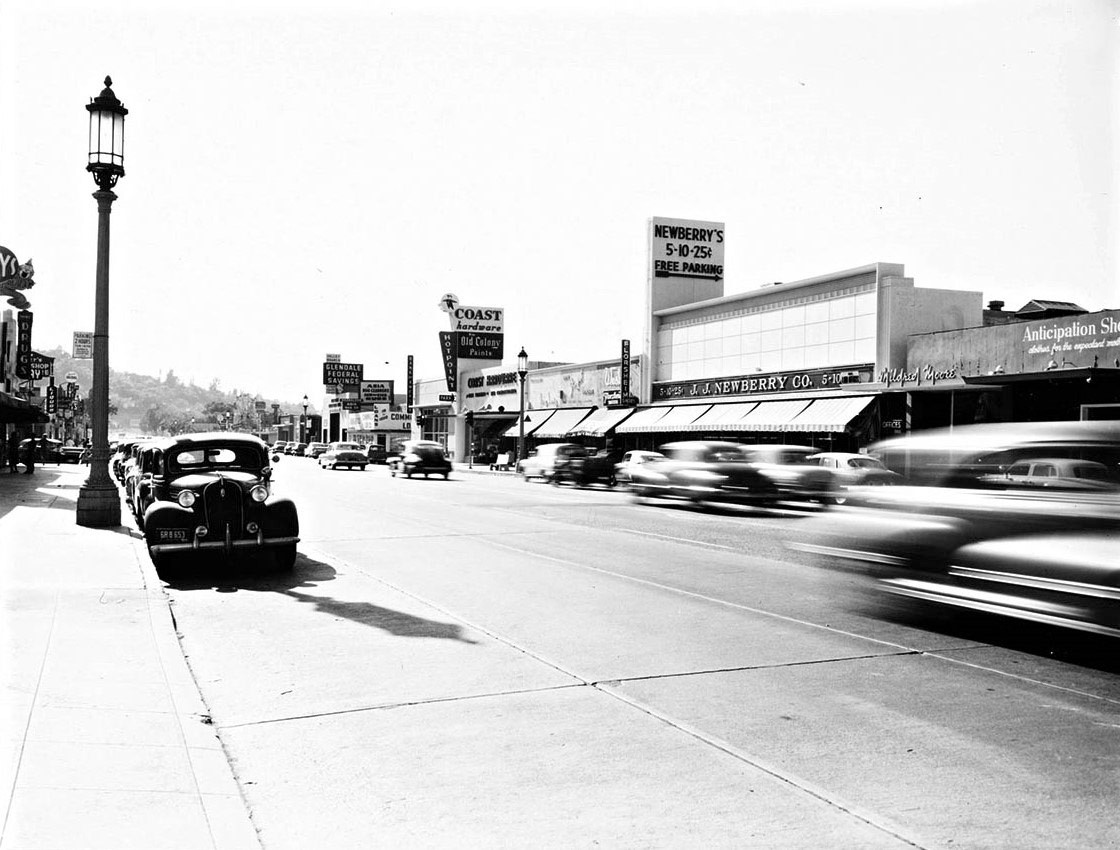 |
|
| (ca. 1950)* – Looking west on Ventura Boulevard in Studio City showing ‘Ventura Specials’ on both sides of the street. |
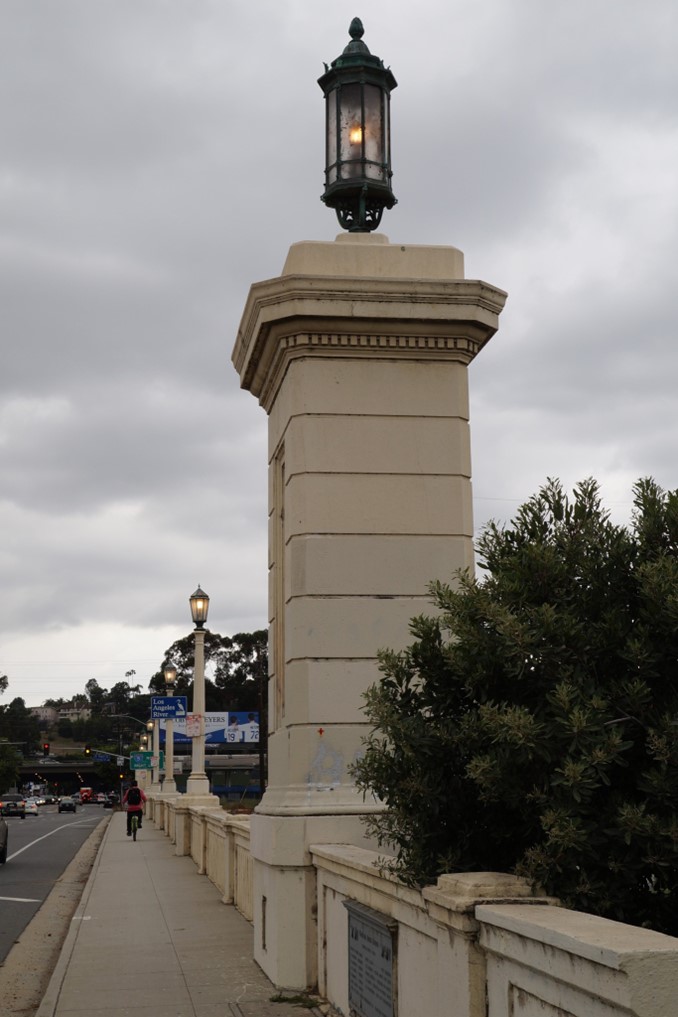 |
|
| (2023)* - The last remaining “Ventura Special” can be found on the Fletcher Drive Bridge. Photo by Glen Norman |
* * * * * |
Combination Streetlight Trolley Pole
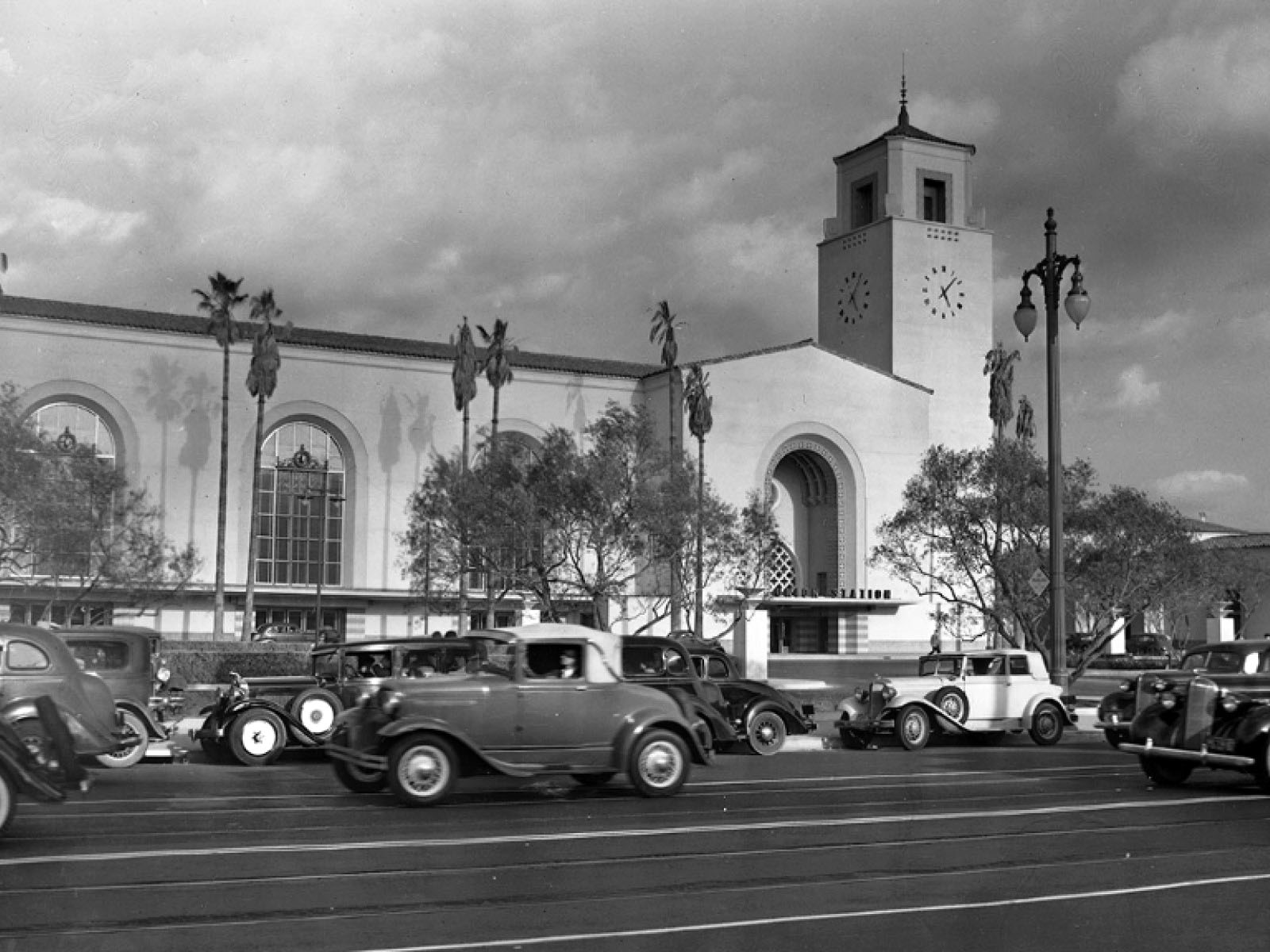 |
|
| (ca. 1939)^ – View looking across a busy Alameda Street with the new Union Station in the background. A combination streetlight trolley pole with dual-pendant style lamps is seen at right. |
Historical Notes Southern California was once home to the world's largest interurban electric railway system, the Pacific Electric Railway. Los Angeles also boasted the Nation's fifth largest urban trolley system, the Los Angeles Railway. This combination streetlight trolley pole on North Alameda Street is representative of many different styles of steel and concrete decorative poles used to support the 600-volt DC wires which supplied power to the streetcars and interurbans of the two companies. |
.jpg) |
|
| (ca. 1945)* - A decorative combination streetlight trolley pole is seen above. The dual-pendant style electrolier is still operating in front of Union Station (to the right and out of view). The United States Post Office Terminal Annex Building is seen across Cesar Chavez (formerly Macy Street). |
Historical Notes The Post Office Terminal Annex, a three-story building with two towers, was designed by Gilbert Stanley Underwood and built by Sarver & Zoss between 1939 and 1940. The building was known to open 24 hours a day and responsible for processing 2,000,000 mails per day including all incoming and outgoing mails in Los Angeles. It is located between Alameda Street and Cesar E. Chavez Avenue, across from the Los Angeles Union Station.^ |
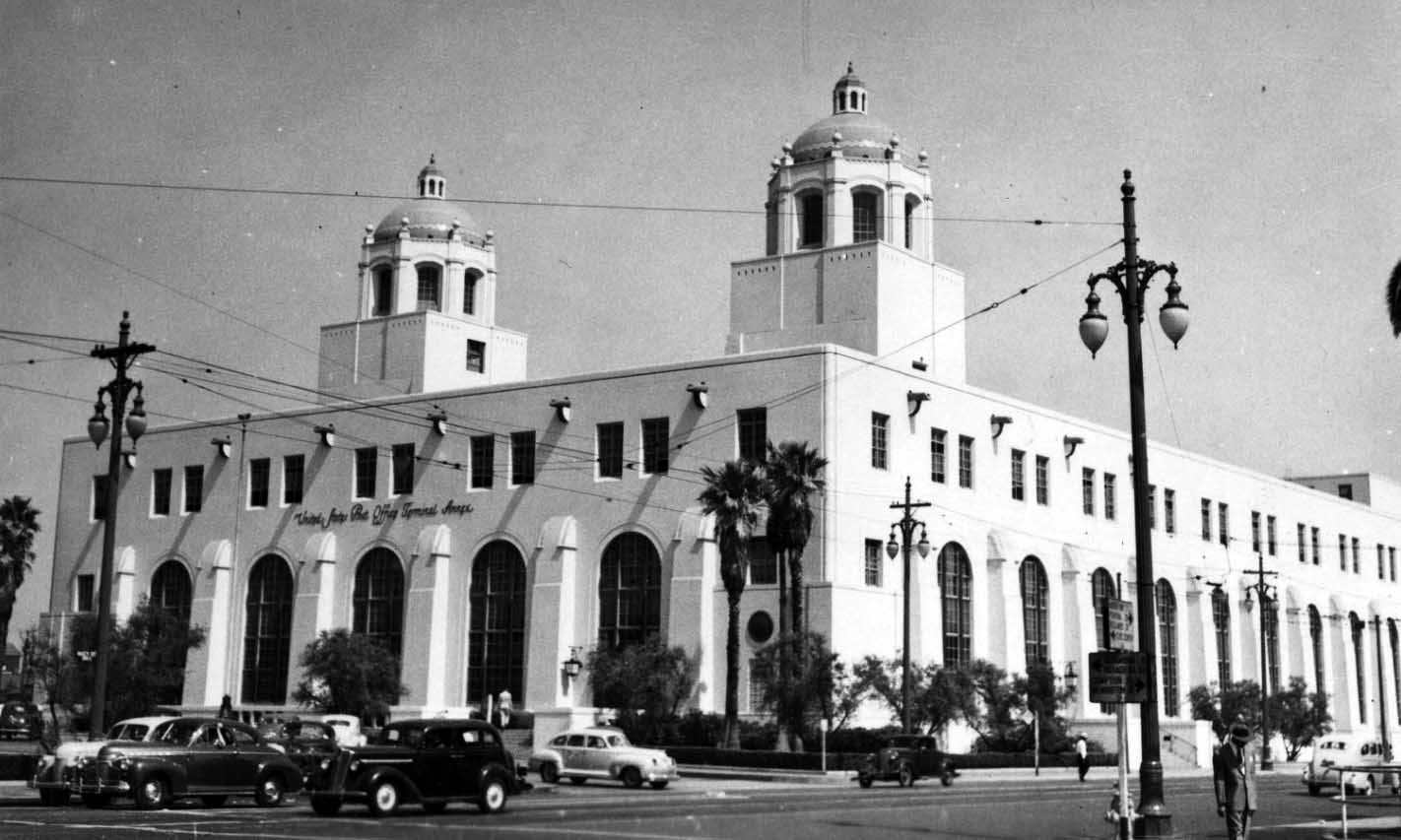 |
|
| (1940s)** - Cars pull out of the parking lot of the United States Post Office Terminal Building. Note the ornate dual-lamp tear drop decorative combination streetlight trolley pole. |
* * * * * |
Miracle Mile
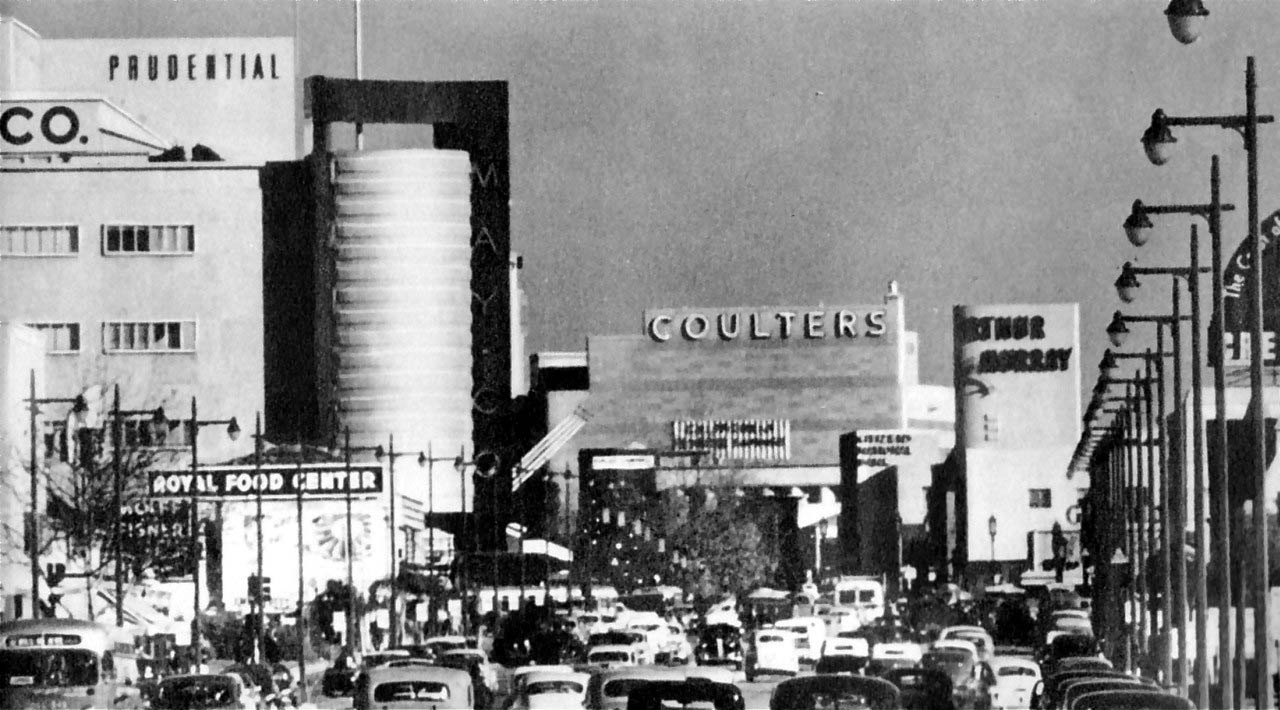 |
|
| (1940s)+## – Panoramic view looking east on Wilshire Boulevard through the Fairfax Avenue intersection. One arm streetlights line both sides of Wilshire. They appear to be spaced closer than they really are due to the telophoto shot. We can see the May Company department store (now part of LACMA and future home of the Hollywood museum of the Academy of Motion Picture Arts and Sciences), Prudential Building, Coulters department store, and the Arthur Murray dance studio. This “Miracle Mile” stretch of Wilshire Blvd is busy now but back then it looks positively jam-packed! |
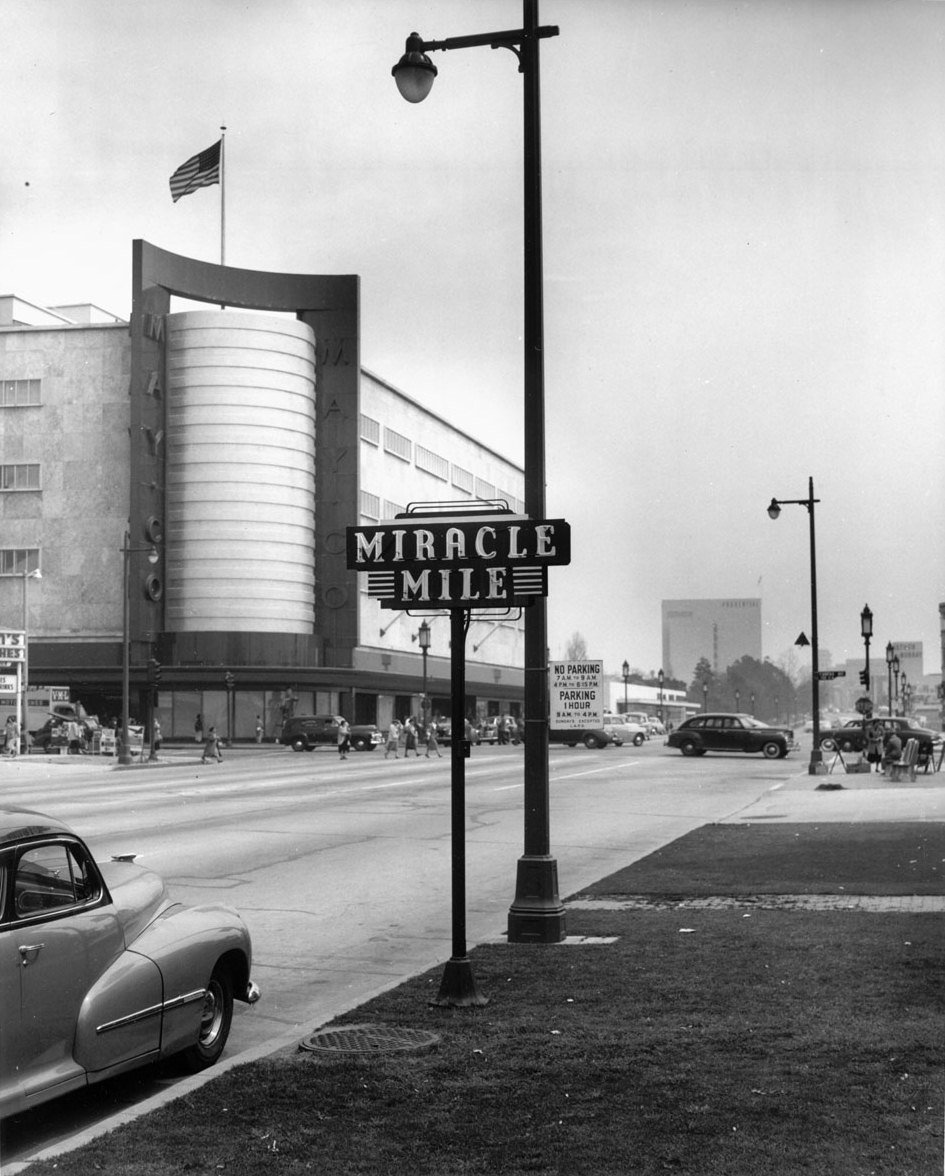 |
|
| (1948)*^ - View of the Miracle Mile and the May Company Building, looking east down Wilshire Boulevard at Fairfax Ave. Note how the design of the electroliers change from the east side of Fairfax to the west side. Click HERE to see more in Early Views of Wilshire and Fairfax. |
* * * * * |
'Metropolitan' Streetlights (Hollywood)
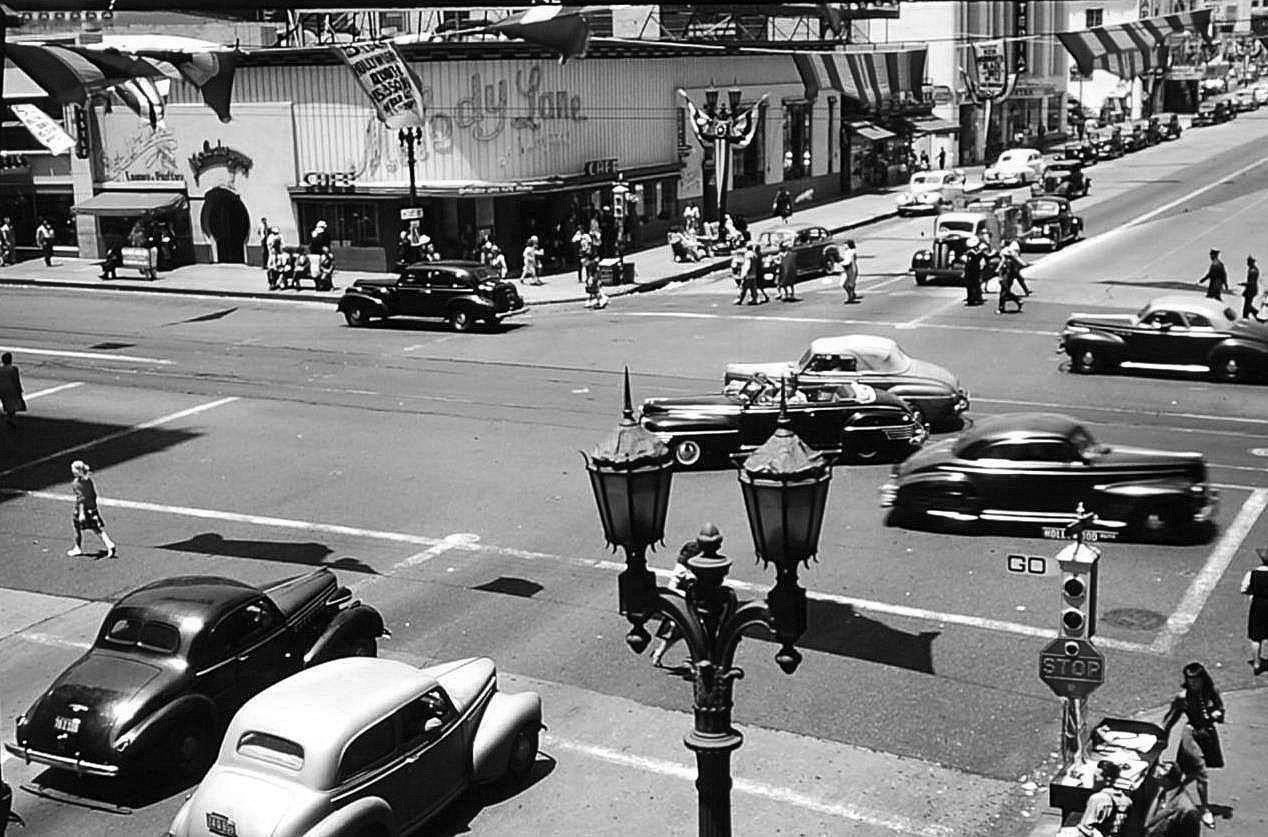 |
|
| (1947)^** - View toward the northwest corner of Hollywood and Vine, looking over an ornate two-lamp 'Metropolitan' streetlight. The traffic signal at lower right shows "GO" even though the intersection is full of cross-traffic. The famous Melody Lane Cafe can be seen on the NW corner. |
'Genie Lamp' Streetlights (Hollywood)
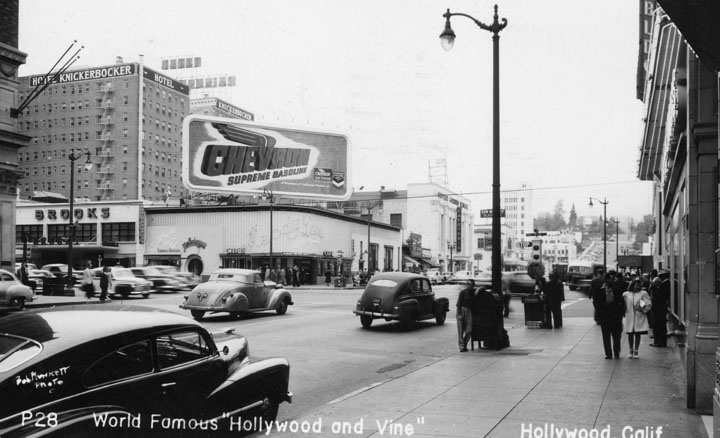 |
|
| (1949)^ - Curved one-arm electroliers on the corner of Hollywood and Vine in 1949. The view is north on Vine Street. Note that the streetlights at this intersection have been changed to single-arm pendant electroliers from two-lamp posts (see previous photo). |
Historical Notes The scroll arms (genie lamps) are in the style that began to appear just before WW2, but really took off post-war. Vine Street scroll arms first appeared in 1947. The Hollywood Blvd. group between Sycamore & Gower was particularly short-lived: 1947 & 1948, before being replaced with another design in the summer of 1948. |
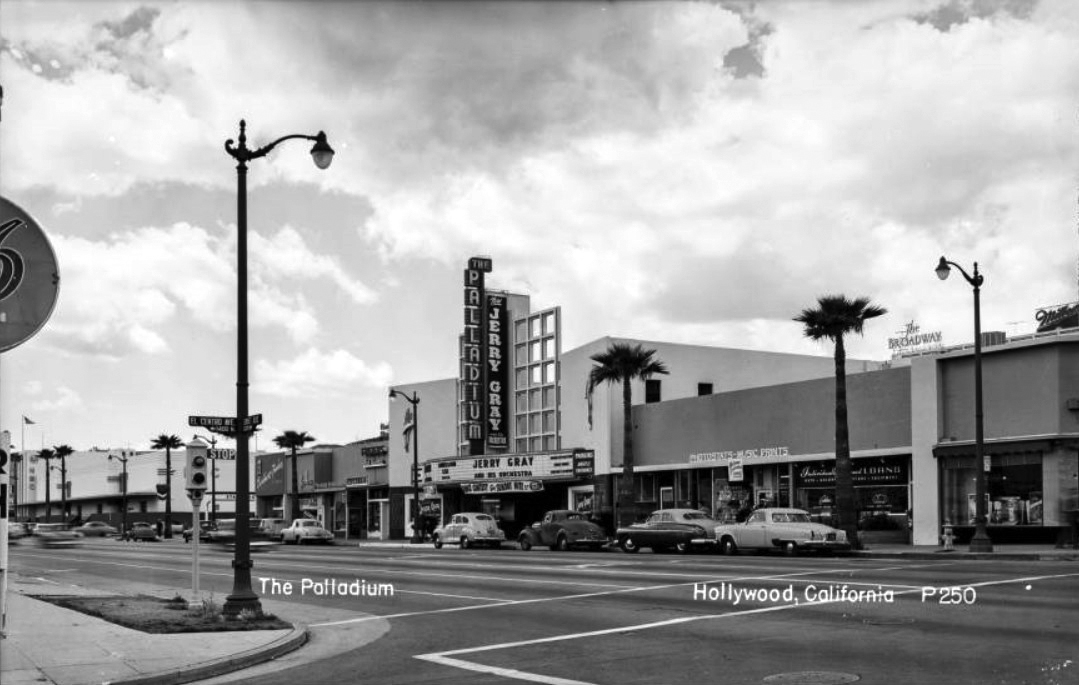 |
|
| (ca. 1950)^** – View showing electroliers with curved one-arm pendants connected to assemblies resembling a 'genie lamp' running down both sides of Sunset Boulevard in Hollywood. The view is looking NW from El Centro Avenue, with the Hollywood Palladium at center, Radio City NBC Studios at far left and the Broadway Building Sign in the distance at right. The Palladium marquee reads "Jerry Gray and his Orchestra" next to a storefront with a sign for Photostats - Music Prints". |
Historical Notes Several of these street lights can still be found on Sunset West of Vine Street with updated LED luminaires. The scroll arms and shafts date from about 1948; the bases are from a circa 1924 installation of Union Metal 'Metropolitan' street lights throughout Hollywood. |
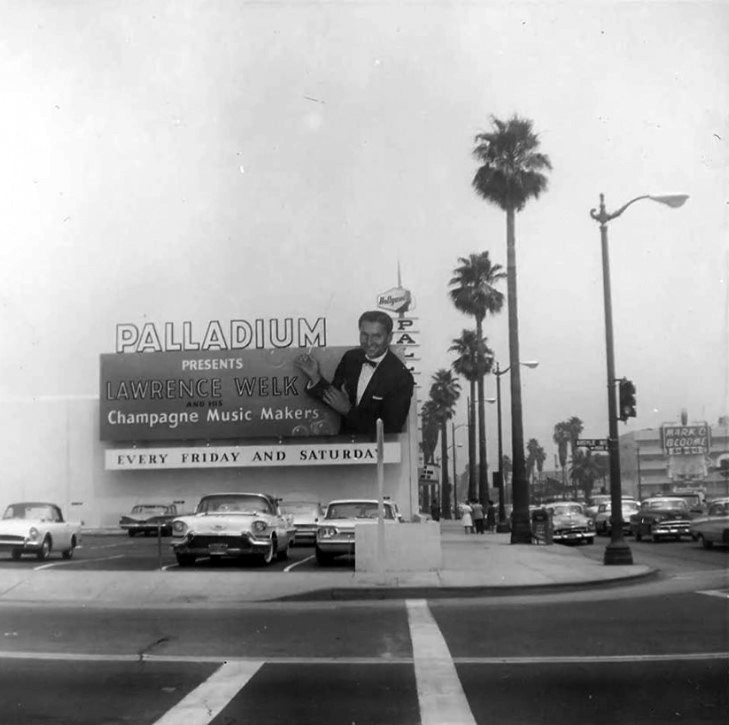 |
|
| (ca. 1959)^.^ – View looking east from Argyle Avenue showing electroliers running in line with palm trees along Sunset Boulevard. Note how the streetlight lamp design has changed when compared to previous photo. A large bilboard sign reading Palladium Presents Lawrence Welk and his Champagne Music Makers is seen on the west face ofthe Palladium building. Mark C. Bloome can be seen across the street (south side of Sunset). Click HERE to see contemporary view. |
.jpg) |
|
| (ca. 1952)* - View looking west on Sunset at Vine as seen from in front of NBC Radio City. Wallach’s Music City is seen on the NW corner. |
Hollywood Single-Arm Pendant
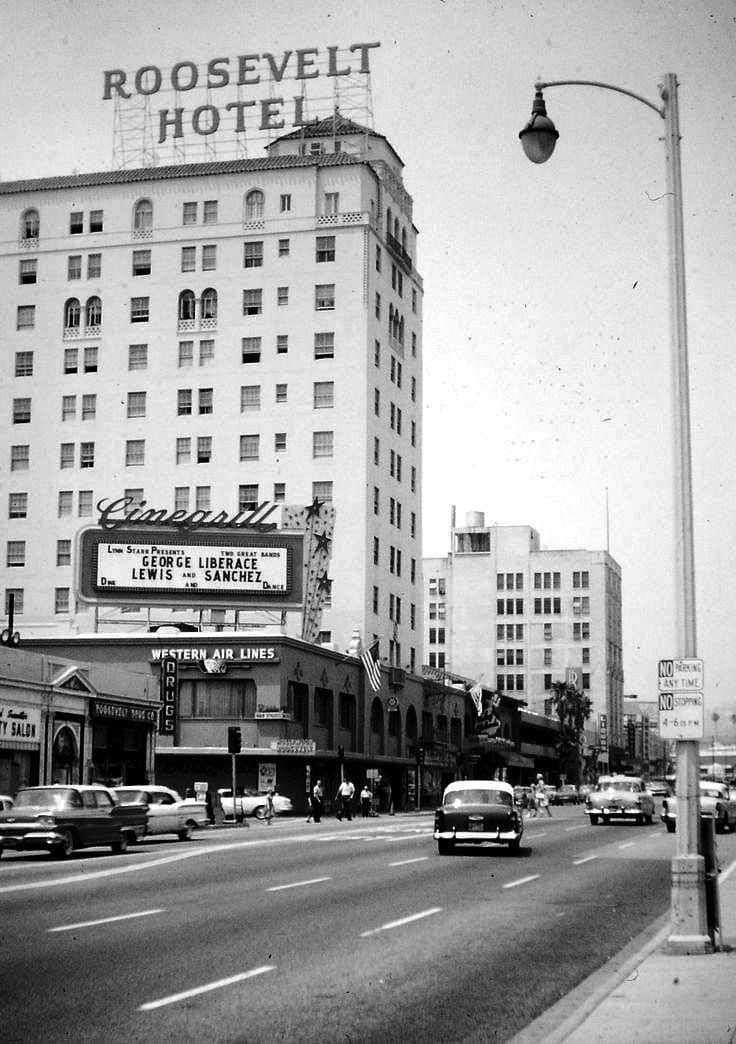 |
|
| (ca. 1958)* - A single-arm pendant electrolier stands tall on the north side of Hollywood Boulevard with the 1927-built Roosevelt Hotel seen in the background. |
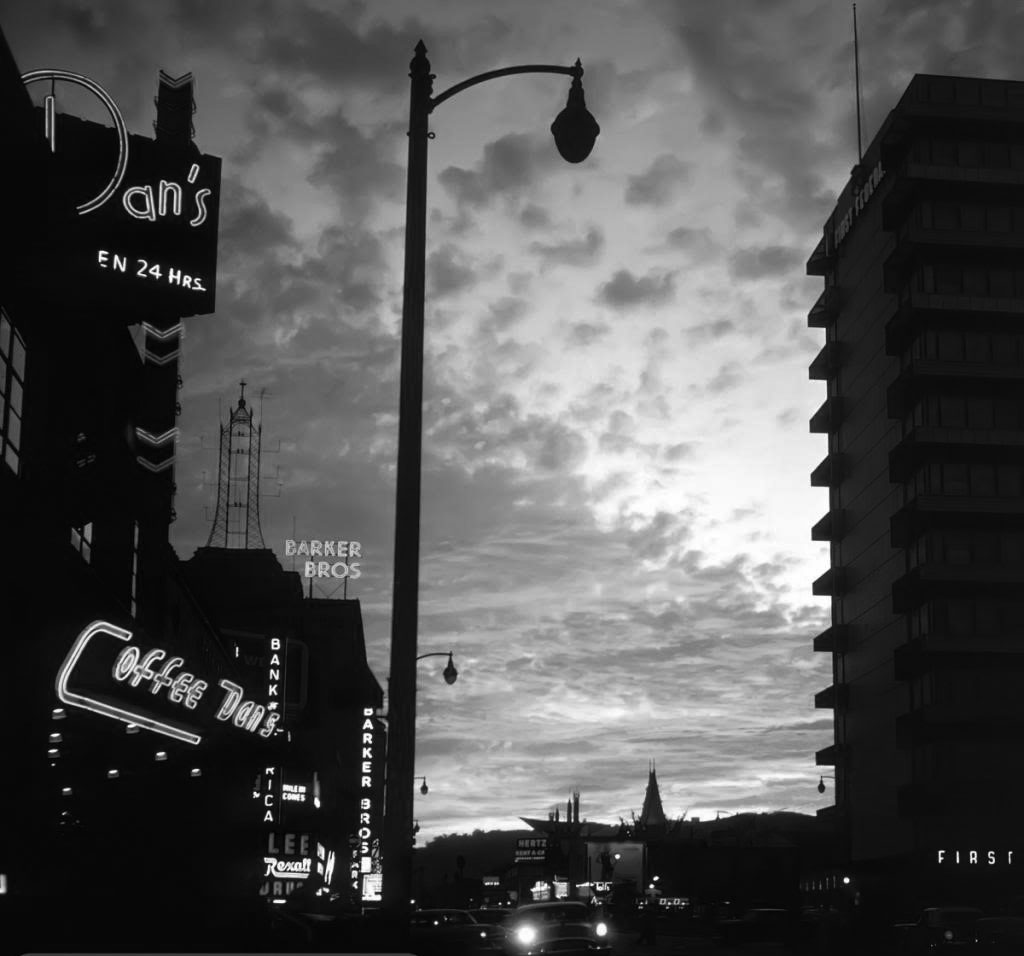 |
|
| (1959)*++– View looking west on Hollywood Boulevard at Highland Avenue showing single-arm pendant electroliers running down both sides of the Boulevard. The First Federal Savings and Loan Building can be seen at right (N/W corner), future site of the Hollywood and Highland Center, the current home of the Academy Awards. The Grauman's Chinese Theatre is seen in the distance. Coffee Dan's, on the left, was a familiar landmark in Hollywood for decades. |
Hollywood Metropolitan
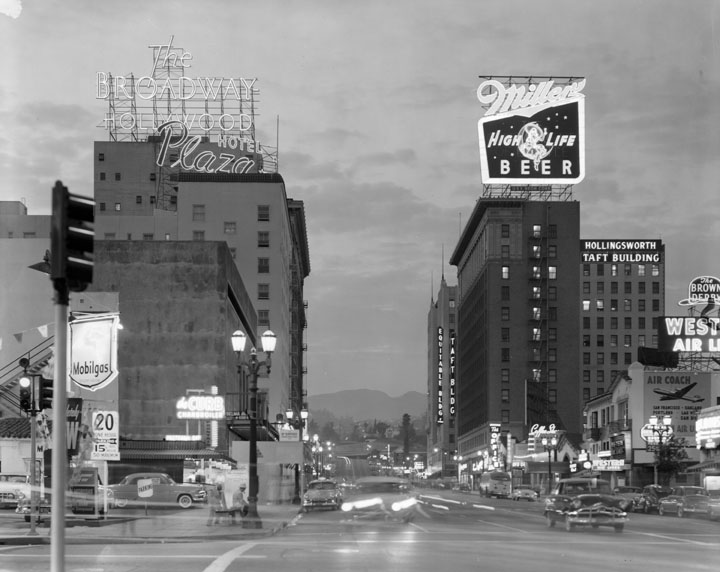 |
|
| (ca. 1950s)^ - View at dusk on Vine Street from Selma Ave. Two-lamp ornate 'Metropolitan' streetlights illuminate Vine St. along with the neon signs atop the buildings. |
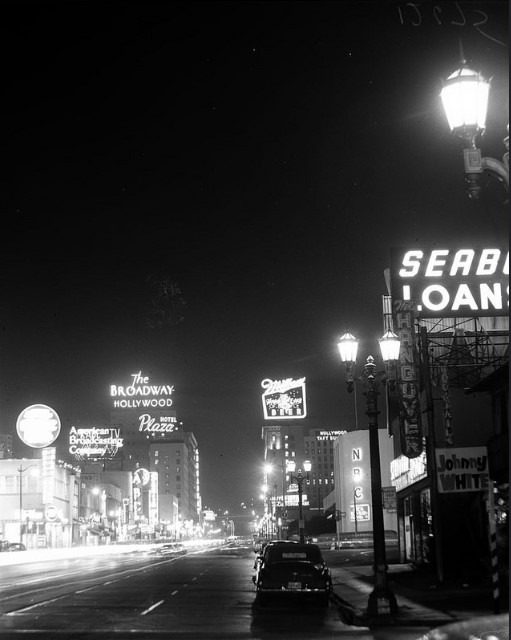 |
|
| (1950s)^^# - View of Vine Street looking north, ilumminated by both 'Metropolitan' streetlights and neon signs. |
GE Form 81 Teardrop Electroliers (Downtown)
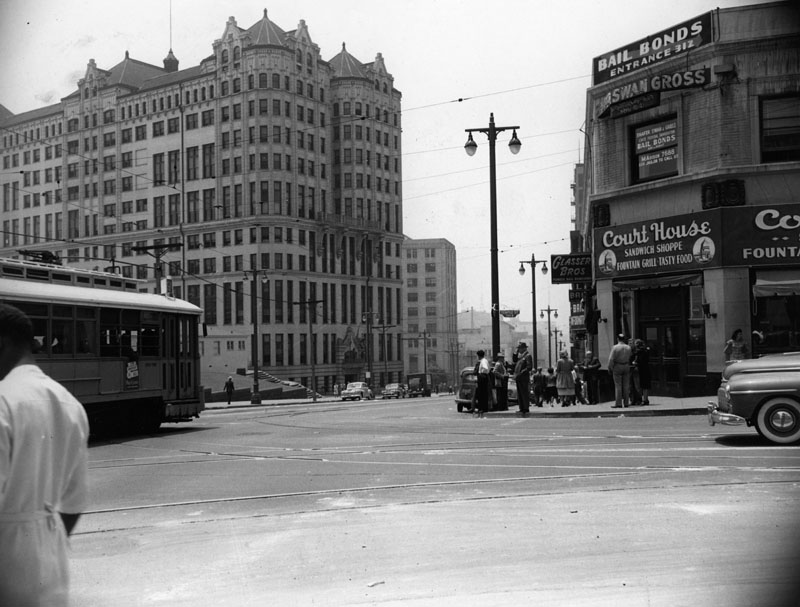 |
|
| (1945)* - Dual-lamp teardrop streetlights at Broadway and Temple in downtwon L.A. The Hall of Records Building is seen across the street. |
.jpg) |
|
| (ca. 1949)* - View showing a DWP streetlight maintenance worker changing out a GE Form 81 teardrop lamp. In the background can be seen the Municipal Water and Power office building (aka Merchants Trust Building) located at 207 S. Broadway. |
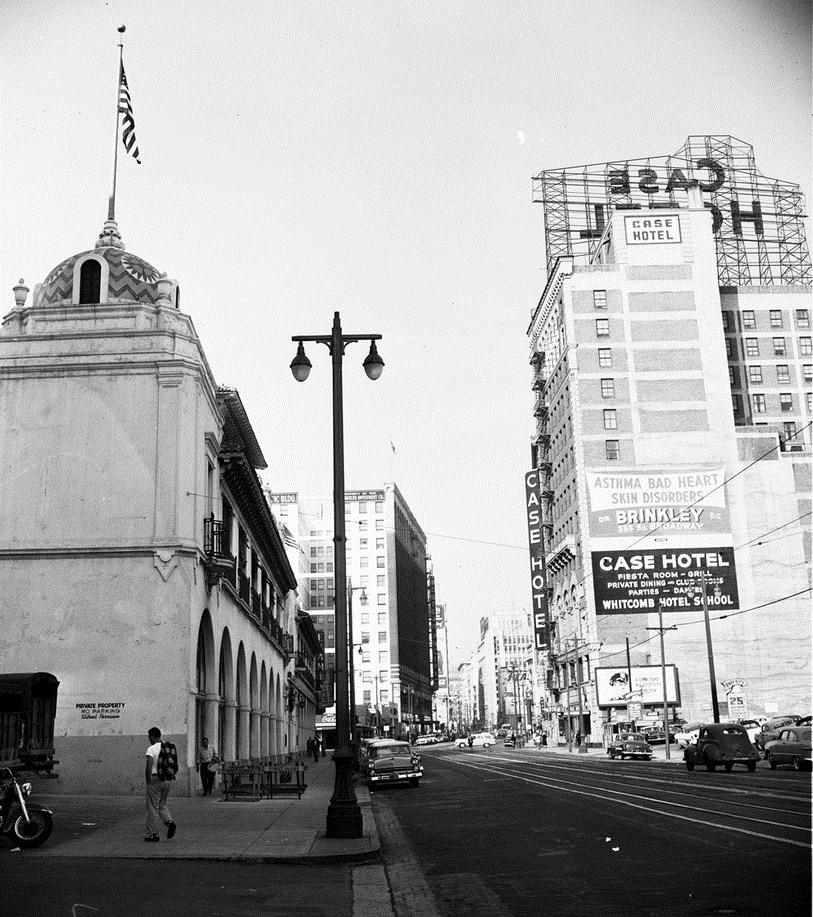 |
|
| (ca. 1950s)*^ - View looking north on Broadway toward 11th Street. A dual-lamp streetlight stands on the corner next to the Herald Examiner Building. The Case Hotel is seen on the southeast corner of Broadway and 11th. |
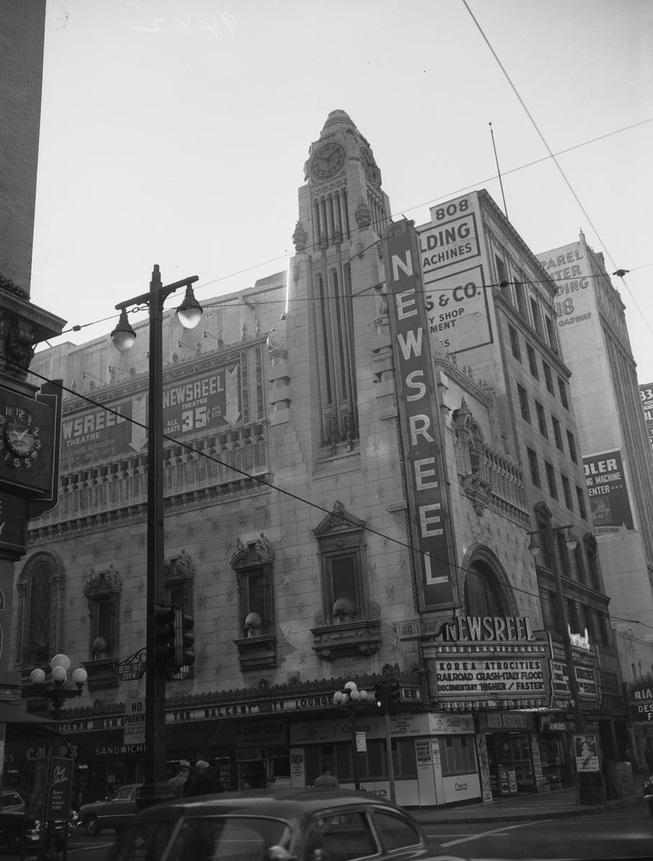 |
|
| (1951)*^ - View of the Newsreel Theater (aka Tower Theatre) on the corner of Broadway and 8th Street. Here we see the confluence of two types of streetlights: the ornate five-bulb lamps runing east-west on 8th Street and the newer GE Form 81 teardrop dual-lamp streetlights runing along Broadway. |
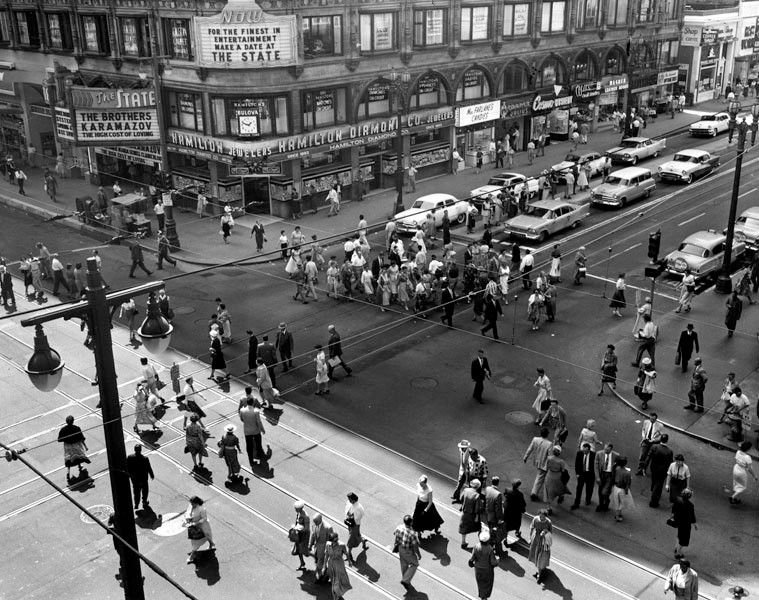 |
|
| (1950s)^ - View showing one of downtown's busiest intersections, Broadway and 7th Street, during mid-day. The State Theatre on the corner is showing "The Brothers Karamazov." Again, here we have the confluence of two different types of streetlights, one running up and down Broadway and the other down 7th Street. |
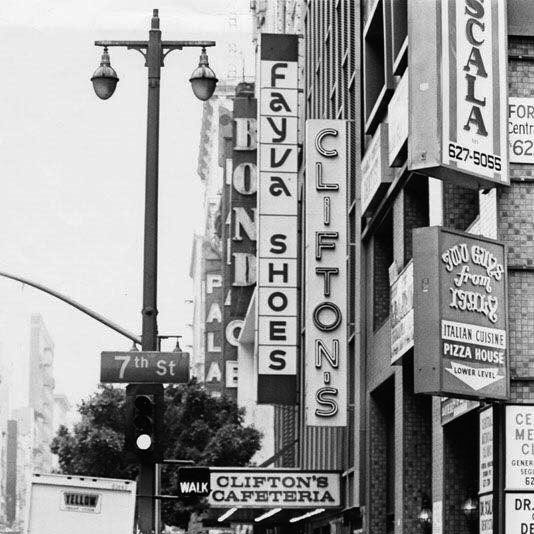 |
|
| (ca. 1980)^.^ – View looking north on Broadway from 7th Street showing a GE Form 81 teardrop dual-lamp streetlight in front of Clifton's Cafeteria. |
* * * * * |
.jpg) |
|
| (1952)*^ – Sometimes even streetlights get in the way. View shows Officer H.L. Chapman holding a license plate at the scene of a traffic accident (corner of 8th and Bonnie Brae streets) with a downed electrolier lying on the ground. |
* * * * * |
1st Street Dual-lamp Tear Drop Combination Streetlight Trolley Poles
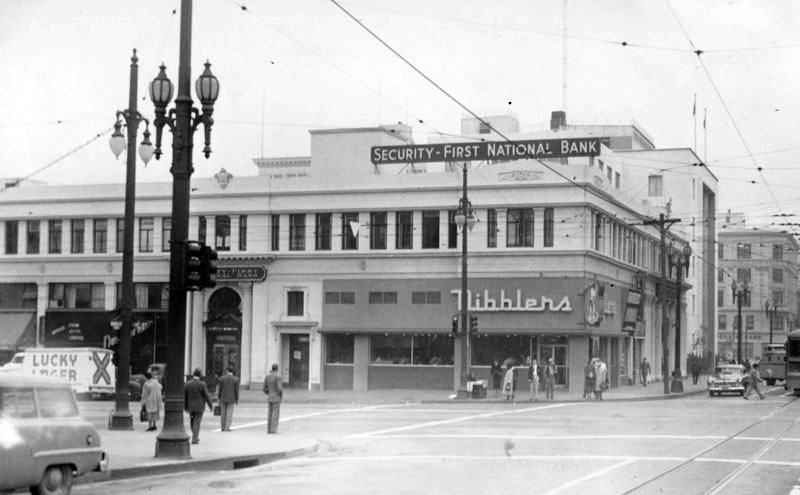 |
|
| (ca. 1953)^ - View is looking southeast toward the corner of First and Spring streets. The Nibblers Restaurant stands at that corner. Note how two different styles of streetlights come together at this intersection. Both are combination streetlight-trolley poles. |
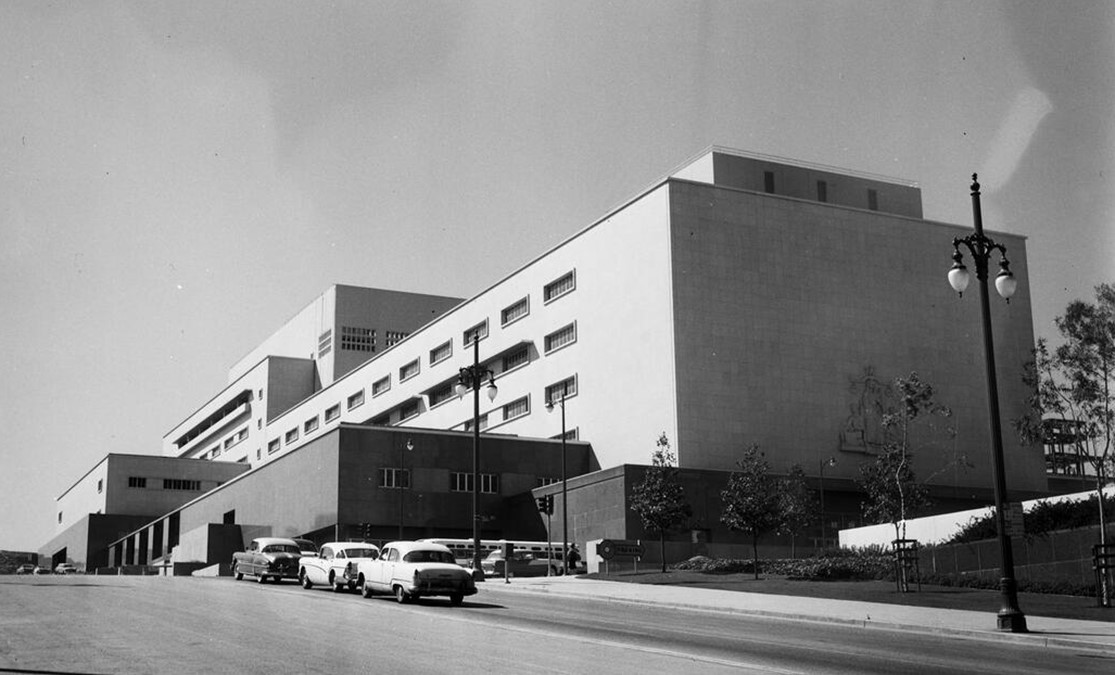 |
|
| (1958)* – Looking west from 1st and Hill streets showing the Los Angeles County Courthouse with dual-lamp tear drop decorative combination streetlight trolley pole running along 1st Street. |
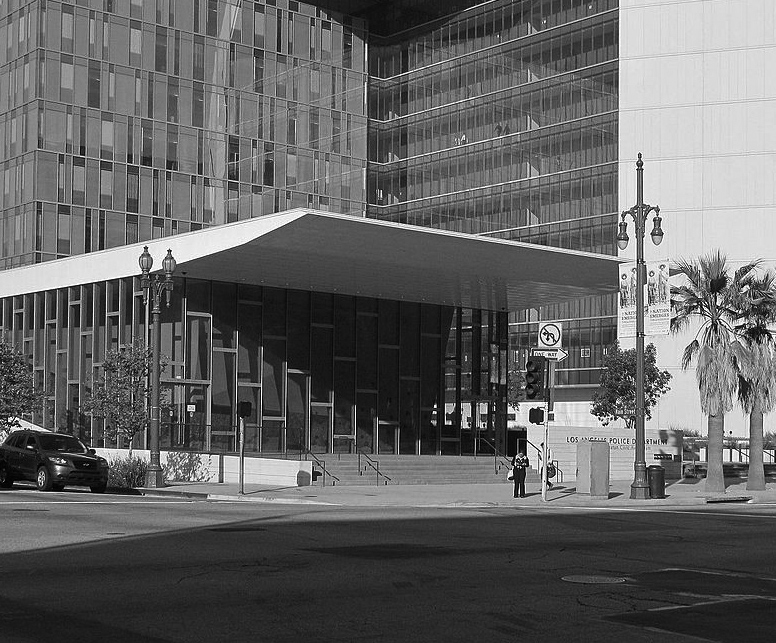 |
|
| (2012)*^ - Two different styles of streetlights front the new LAPD Headquarters Building, at the SW corner of First and Main streets. |
Freeway Lighting
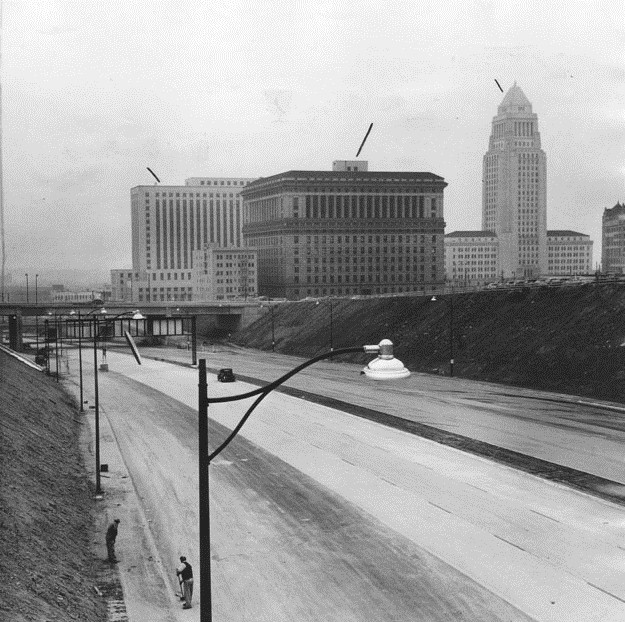 |
|
| (1951)^ – View showing new lights being installed on the Hollywood Freeway (101 Freeway), still under construction, with the Federal Courthouse, Hall of Justice, and City Hall seen in the background. Click HERE to see more on the construction of the Hollywood Freeway through the Civic Center. |
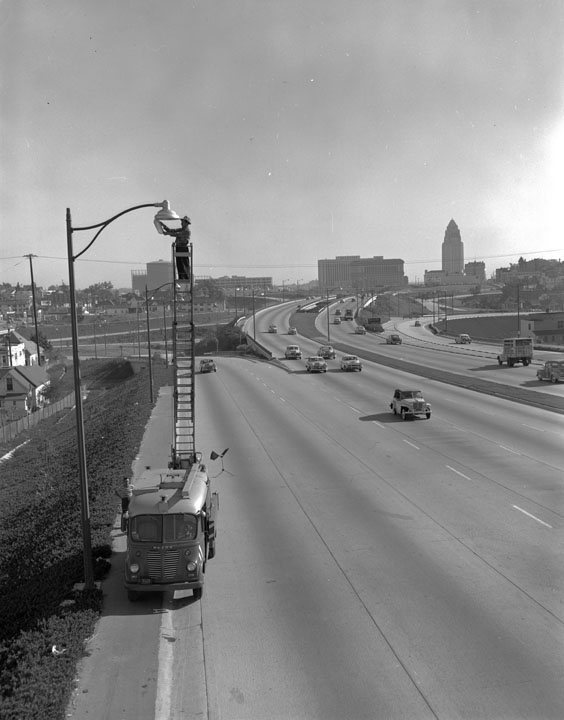 |
|
| (1952)* - View looking toward the Four Level Interchange on the Hollywood Freeway showing a Street Lighting Maintenance unit. Caption reads: Modern-day lamplighter seen against Los Angeles' downtown skyline is James Salazar of the Street Light Maintenance section. These lights on the Hollywood Freeway don't have to be lit by hand, of course, but they do require washing and globe replacement. On ground is Joe J. Restivo. Truck with electrically operated ladder is one of four used by the Street Light section. |
Historical Notes The Four Level Interchange was the first stack interchange in the world. Completed in 1949 and fully opened in 1953 at the northern edge of Downtown Los Angeles, it connects U.S. Route 101 (Hollywood Freeway and Santa Ana Freeway) to State Route 110 (Harbor Freeway and Arroyo Seco Parkway).^* |
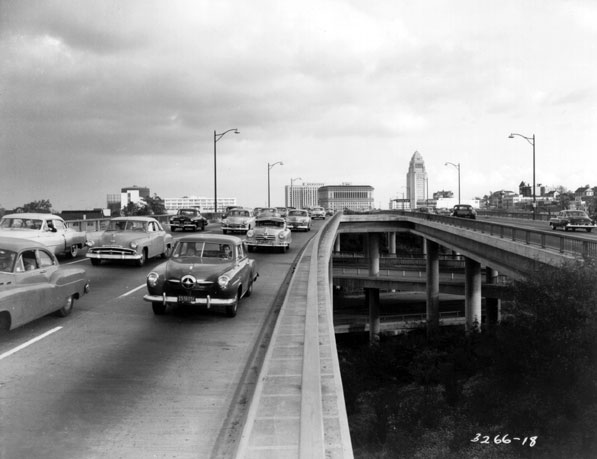 |
|
| (1953)^^ - View showing streetlights running along the outer sides of the Four Level Interchange, looking east toward City Hall. |
Historical Notes The interchange was constructed as a stack interchange because surrounding buildings and terrain made construction of a cloverleaf interchange impractical. The mainline traffic of US 101 is at the top of the interchange, above the ramps, a rarity in stack interchanges. Its distinctive architecture has long made it a symbol of Los Angeles' post-World War II development, and it appears on numerous postcards of the 1950s and 1960s.^* |
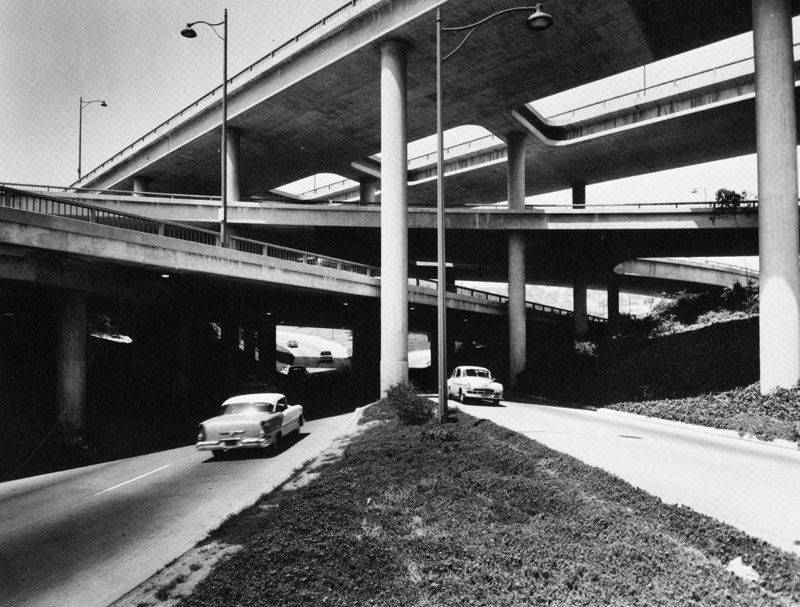 |
|
| (1954)^ - Streetlights are positioned to illuminated the lower sections of the Four Level Interchange. |
Historical Notes The Four Level, also known as the Stack, gets its name from its multi-tiered structure that separates traffic heading in each direction into dedicated lanes. On the bottom level are curved ramps for those changing from the 110 freeway to the 101. One level above is the main trunk of the 110 freeway, named the Arroyo Seco Parkway north of the interchange and the Harbor Freeway south of it. On the third level are the arcing flyover ramps carrying traffic from the 101 freeway to the 110. Finally, on the fourth and top level is the main trunk of the 101 freeway, named the Hollywood Freeway to the west and the Santa Ana Freeway to the east.^ |
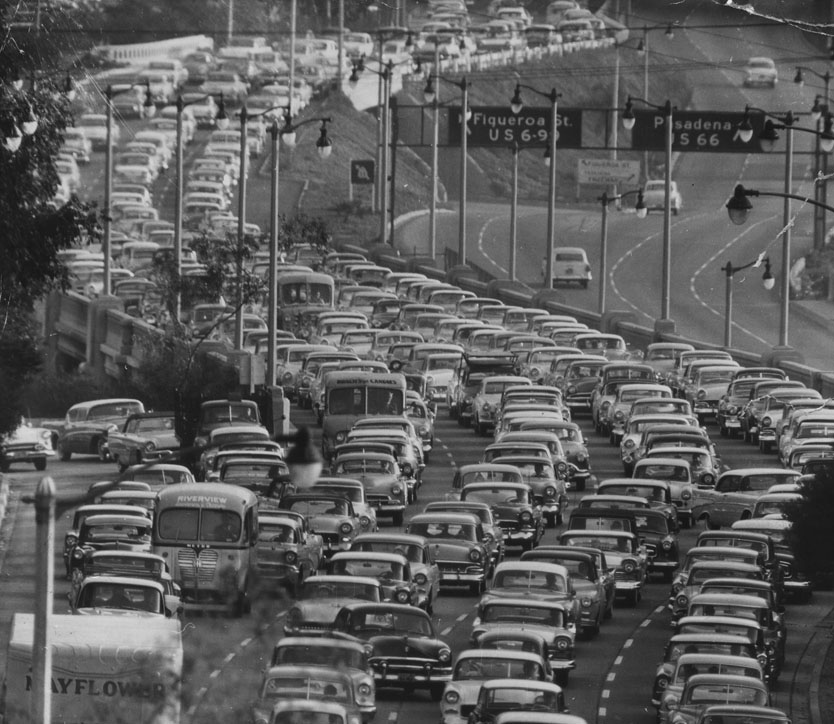 |
|
| (1956)^ – View showing single-arm pendant electroliers on the Pasadena Freeway with densely packed traffic travelling southbound as seen from Park Row Drive overlooking the Freeway near Civic Center. |
Historical Notes Between 1954 and 2010, Arroyo Seco Parkway was officially designated the Pasadena Freeway. In 2010, as part of plans to revitalize its scenic value and improve safety, Caltrans renamed the roadway back to its original name. All the bridges built during parkway construction remain, as do four older bridges that crossed the Arroyo Seco before the 1930s.*^ |
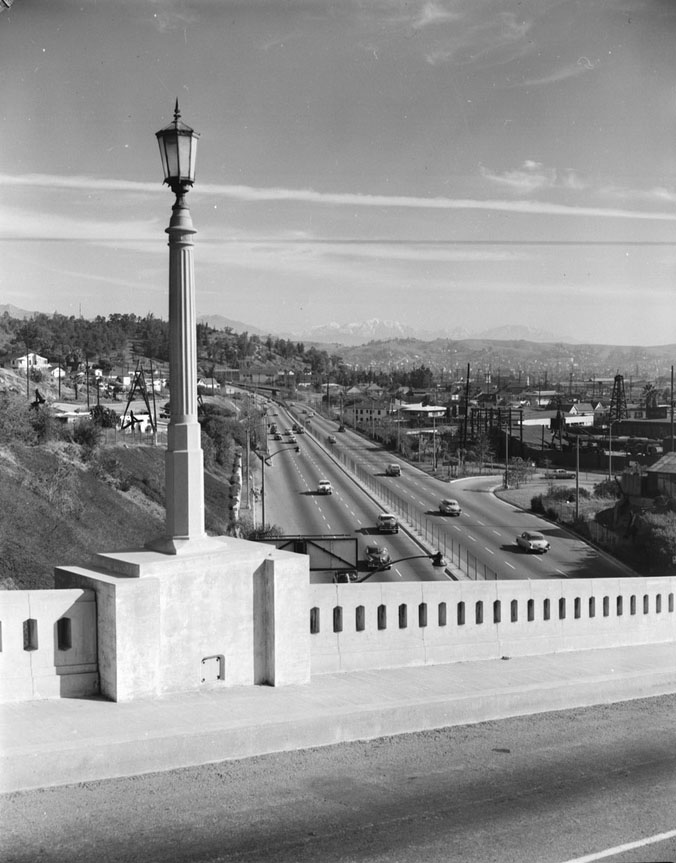 |
|
| (1955)*^ - A singular electrolier stands tall on top of College St. Bridge over the Arroyo Seco Parkway. The view is looking north. In the distance can be seen the San Gabriel Mountains partly covered with snow. |
Historical Notes See More Bridge Lighting (College Street Bridge; First Street Bridge; Fourth Street Viaduct; Fourth and Lorena Streets Bridge; Macy Street Bridge; Mulholland Bridge; Sixth Street Bridge; Washington Blvd Bridge) |
* * * * * |
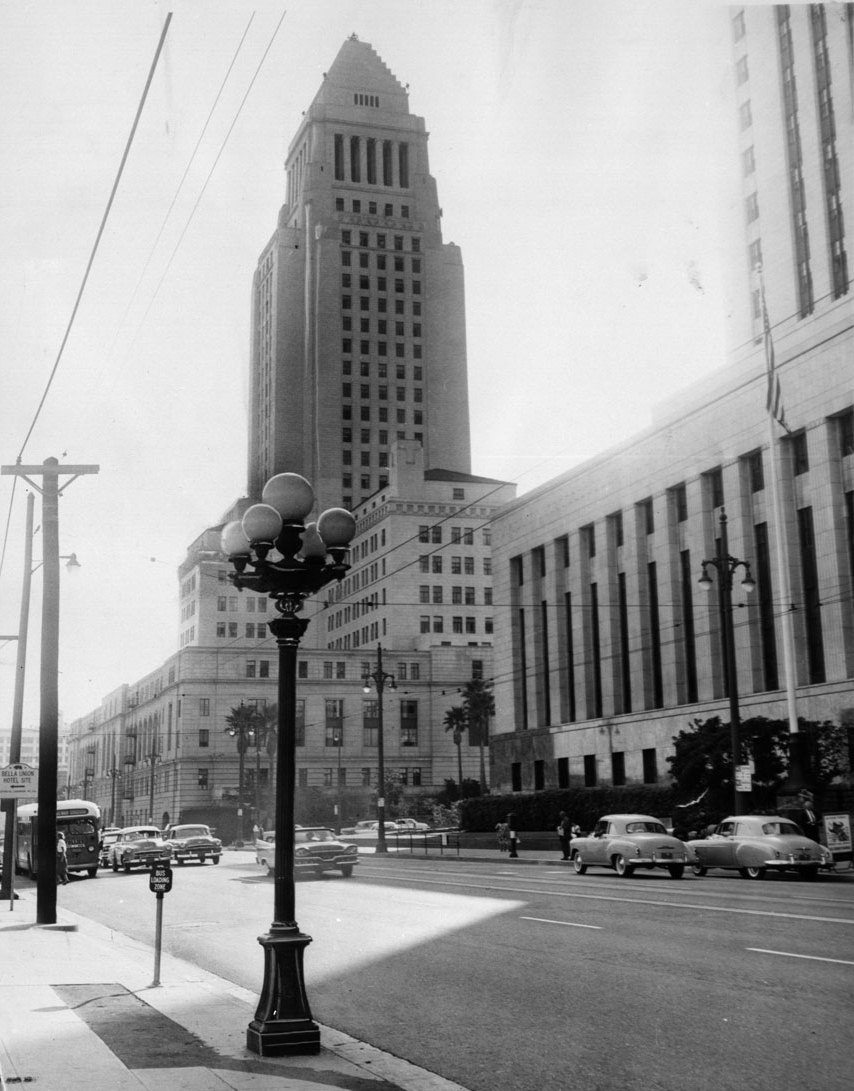 |
|
| (1959)*^ - A five-globe lamp post with City Hall in the background. Today, the last remaining of these ornate street lights can still be found in the gardens and malls adjacent to City Hall. |
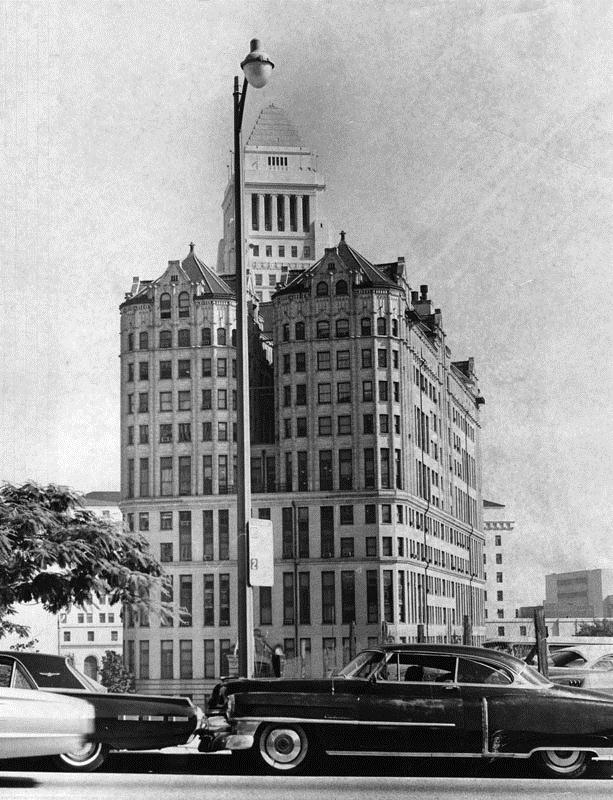 |
|
| (1965)^ - View of a single-post arm electrolier in front of the Hall of Records with City Hall in the background. |
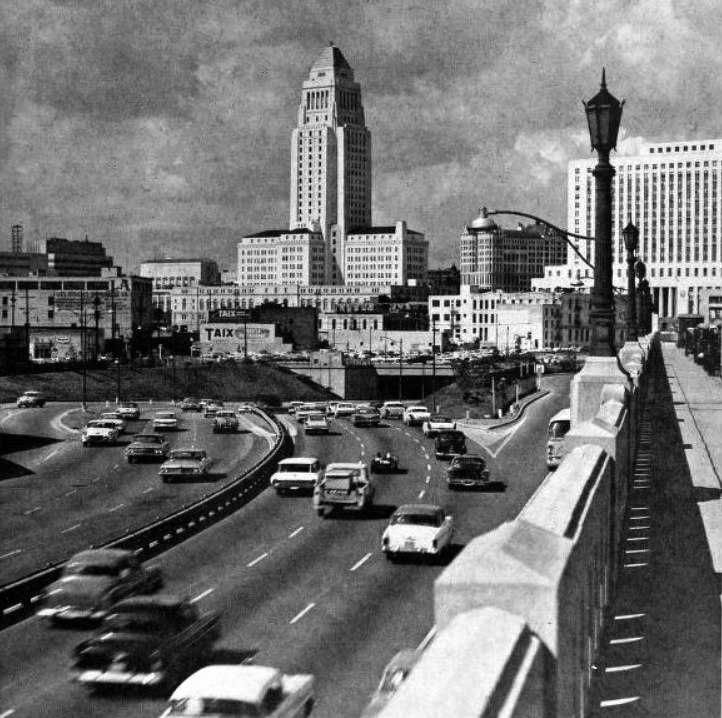 |
|
| (1962)^.^ - Santa Ana Fwy (US-101) at Union Station near Alameda St -- view looking southwest. ‘Metropolitan’-style electroliers line the concrete railing on the right. |
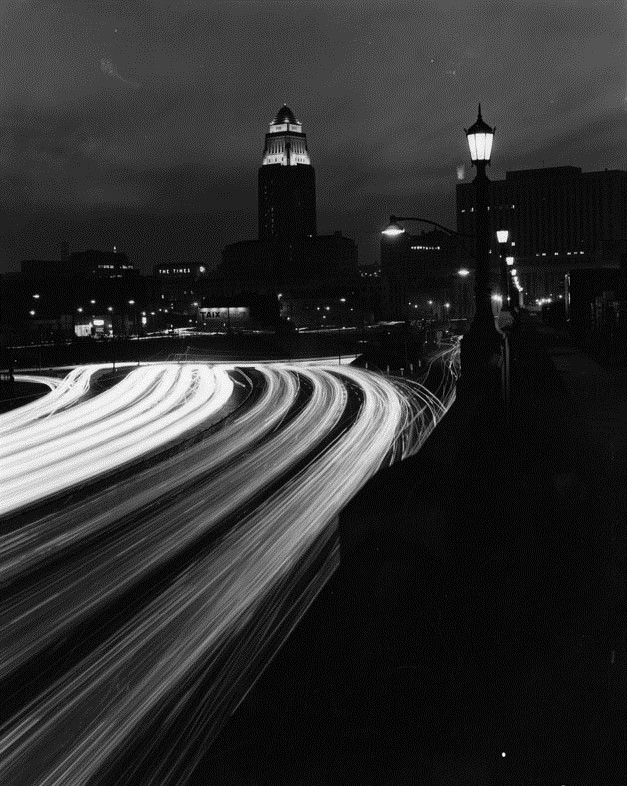 |
|
| (1962)^ - Nighttime view of Los Angeles and City Hall, looking southwest from the Union Station at the Santa Ana Freeway (same view as previous photo). A billboard for the French restaurant "Taix" and "The TIMES" up in lights on the top of a building appear in the background. |
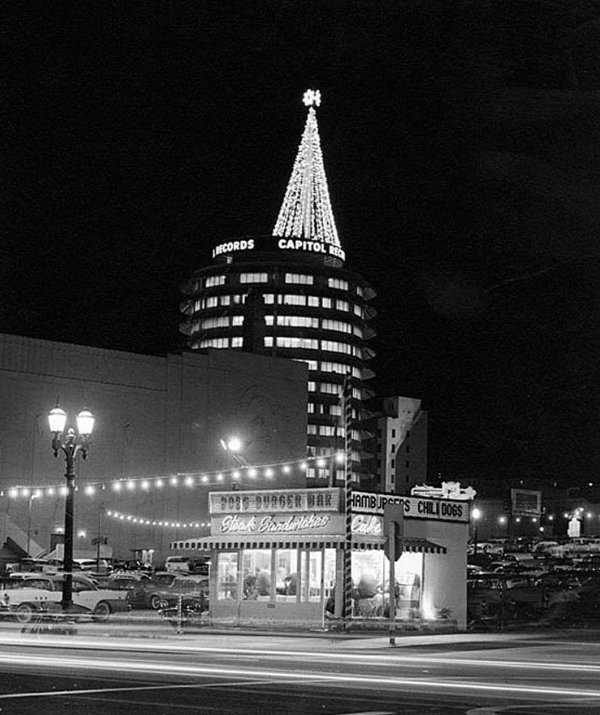 |
|
| (1962)#^* – View showing an ornate two-lamp 'Metropolitan' electrolier standing near the northwest corner of Hollywood Boulevard and Argyle Avenue. The Pantages Theatre is to the left and in the foreground stands a small hamburger stand. The Capitol Records Building, with Christmas Tree on top, is seen in the background. |
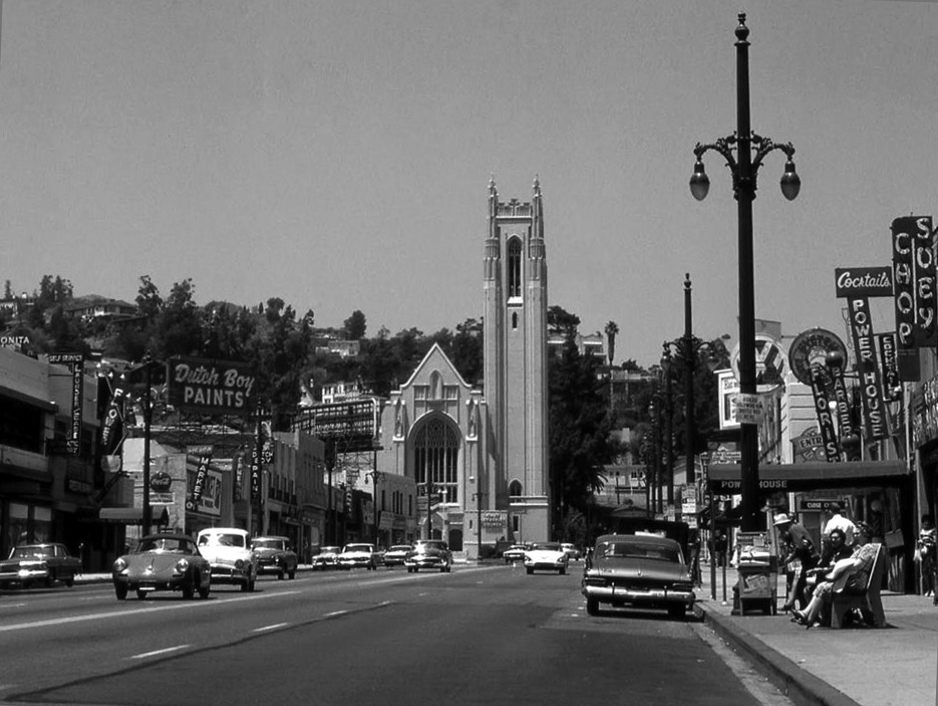 |
|
| (1960s)#** – An incandescent electrolier with dual-lamps, curved cross-arms, and extended post stands on the east side of Highland Avenue just north of Hollywood Boulevard. The Hollywood United Methodist Church can be seen in the background on the corner of Highland and Franklin. |
* * * * * |
The Davit Streetlight (aka Cobra Streetlight: 1950-1980)
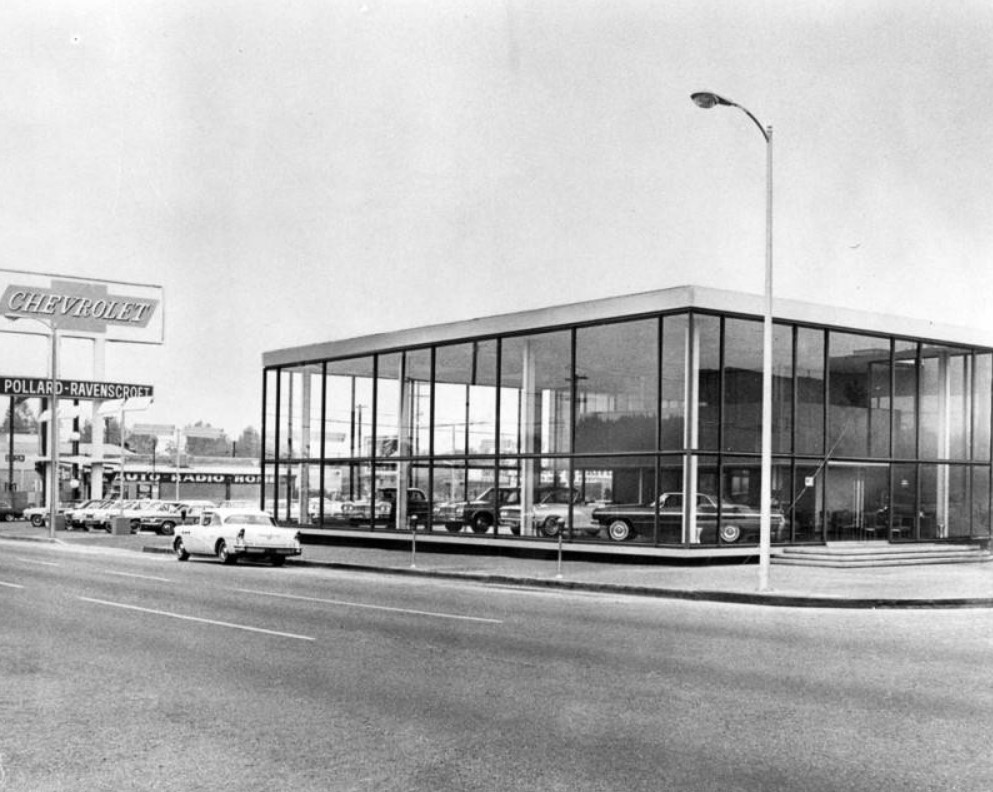 |
|
| (1964)* – View showing a Davit or Cobra-head street lamp in front of the Pollard-Ravenscroft Chevrolet dealership at 6001 Van Nuys Boulevard. |
Historical Notes The extended-arm electrolier that dominated the postwar period was called the Davit Streetlight. It was so named because of its resemblance to the arm hoist used for raising and lowering boats and anchors. Unlike earlier streetlights Its design was typically unornamented. |
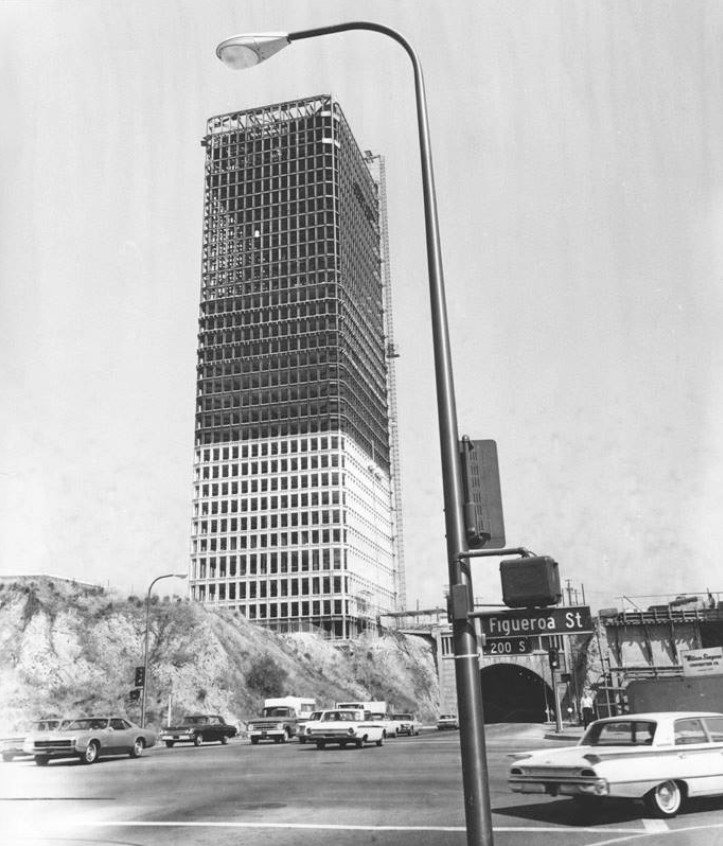 |
|
| (1968)#+ – View looking east toward the west end of 2nd Street Tunnel as seen from the southwest corner of 2nd and Figueroa where a davit-style sreetlgiht stands. In the background can be seen Bunker Hill Tower, still under construction. |
Historical Notes The Davit Streetlight used a different type of lamp, based on improvements in HID lighting technology. Lamps were horizontally-mounted, rather than vertically as with the earlier pendants. This permitted a larger lamp in a housing, or optical assembly, which included reflector and prisms to direct the light. Along with this change in the lamp size and orientation came improvements in the gasses used. |
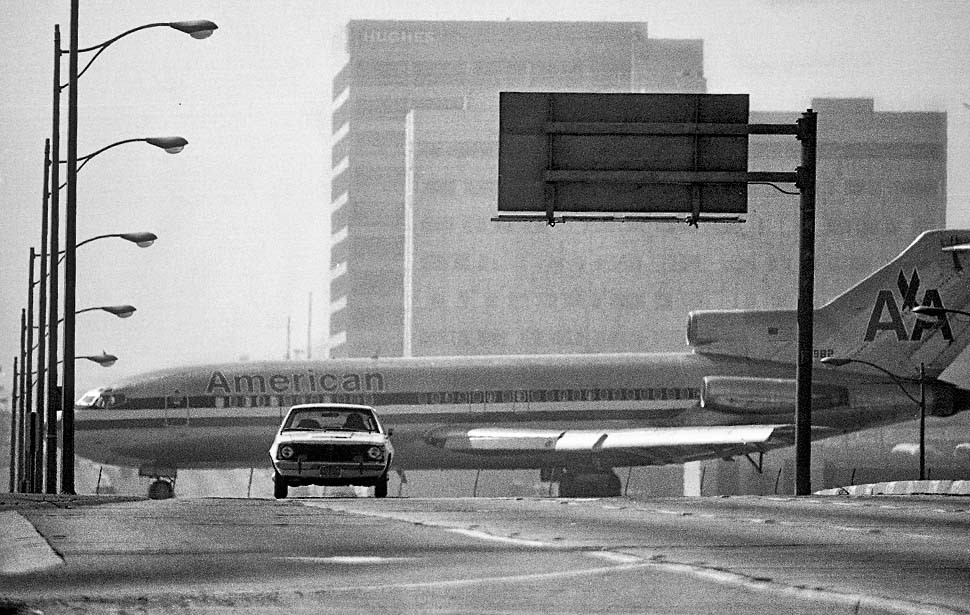 |
|
| (1976)^^# - View through a telephoto lens looking north on Sepulveda Boulevard showing an American Airlines jet crossing over the Sepulveda Tunnel - making for a good optical illusion. Davit-style streetlighs are sees on the west side of the street. Photo by Rick Meyer |
Historical Notes By the late 1970s, sodium had replaced mercury as the most common form of lamp. The result was a significant change in the height and spacing of street lights. The improvement in lighting power allowed the electroliers to be taller and placed further apart. Longer arms extended the lamp over the street, and the reflectors and prisms threw the light toward the center of the roadway. The horizontal orientation of the optical assembly, attached to a curved arm, inevitably gave this type of street light the popular name of cobra-head.^ |
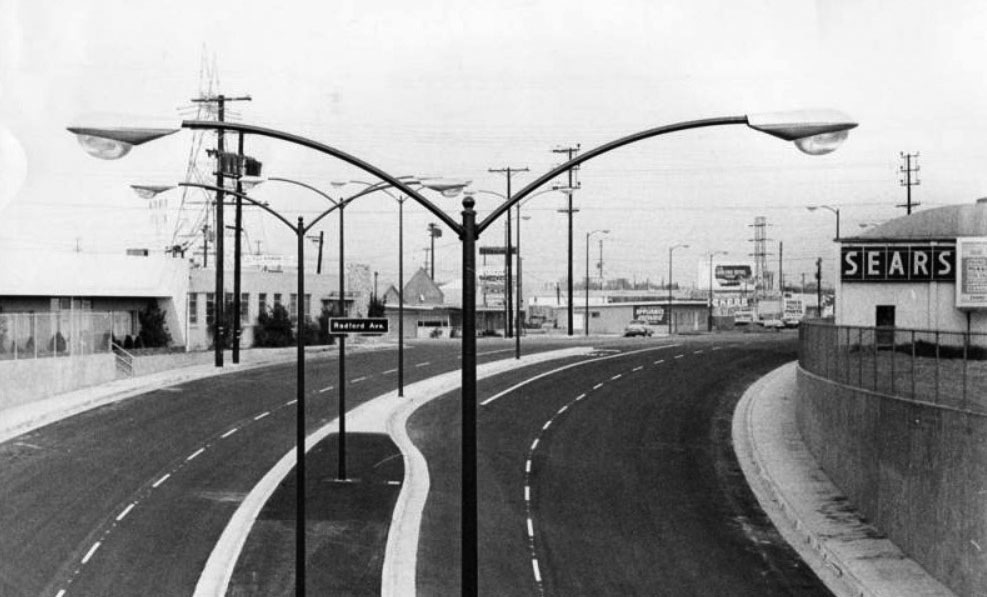 |
|
| (1963)* - View showing dual-lamp mercury vapor electroliers on Sherman Way between Lankershim Blvd. and Laurel Canyon Blvd. View is looking east on Sherman Way as seen from top of RR crossing. |
Historical Notes Mercury vapor lamps are more energy efficient than incandescent and most fluorescent lights, with luminous efficacies of 35 to 65 lumens/watt. Their other advantages are a long bulb lifetime in the range of 24,000 hours and a high intensity, clear white light output. For these reasons, they were used for large area overhead lighting, such as in factories, warehouses, and sports arenas as well as for streetlights.^ High pressure sodium lamps would replace the Mercury vapor lamps by the late 1970s. |
Montecito Heights, Los Angeles
 |
|
| (2019)^.^ – Beautiful nighttime telephoto view looking south on Monterey Road from Pullman Street showing dual-lamp electroliers lighting up the road below. Photo by Tony Valdez |
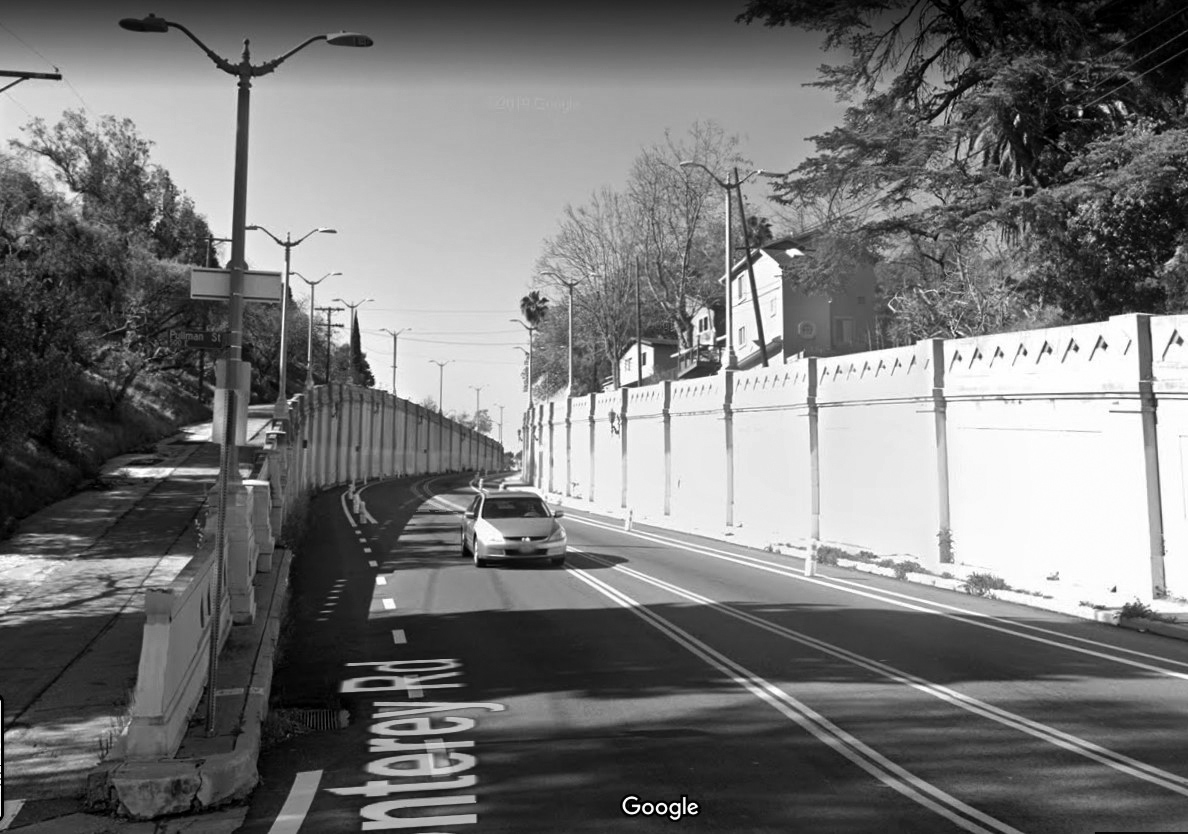 |
|
| (2019)**– Google street view showing the same intersection in daylight. Dual-lamp electroliers run along top of decorative concrete walls on both sides of Monterey Road at Pullman Street in Monecito Heights. |
Van Nuys Blvd Streetlights
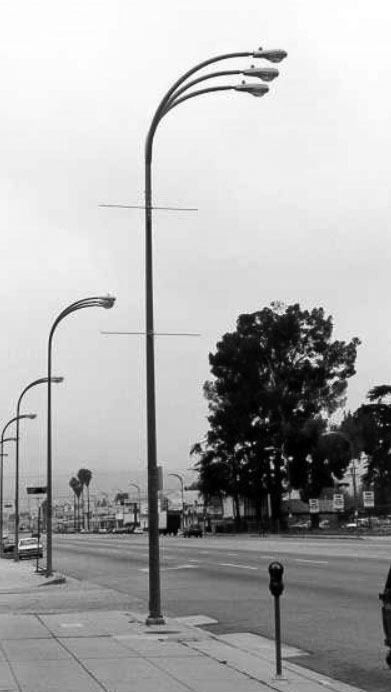 |
(1970s)^^ - View looking south on Van Nuys Boulevard showing the unique three-arm sltreetlights running down both sides of the street. |
Historical Notes These forked three-arm streetlights were chosen in the early 1970's by representatives of the Van Nuys business community to light Van Nuys Boulevard and Magnolia Boulevard. Originally, 1,000 watt mercury vapor lamps were used to provide on average five foot-candles. This turned out to be too bright and too costly from an energy level. Today, these three-pronged electroliers can still can be seen on and around Van Nuys Boulevard. However, the luminaires today are 250 watt high-pressure sodium. |
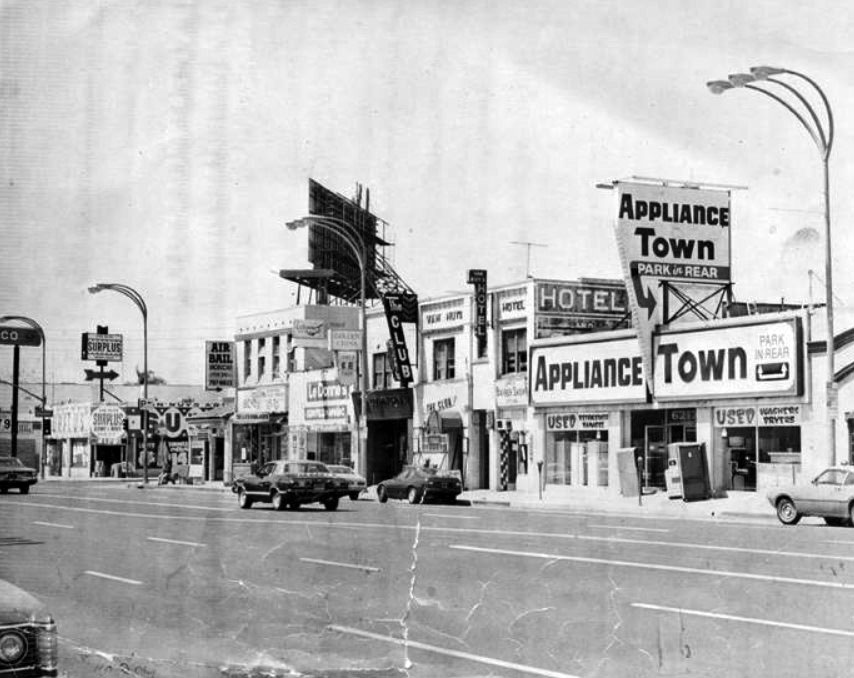 |
|
| (1970s)#^ – View looking southwest on Van Nuys Boulevard. Visible at center is 6211 Van Nuys Boulevard, known at that time as the Van Nuys Hotel. Note the forked three-arm streetlights running up and down Van Nuys Boulevard. Click HERE to see contemporary view. |
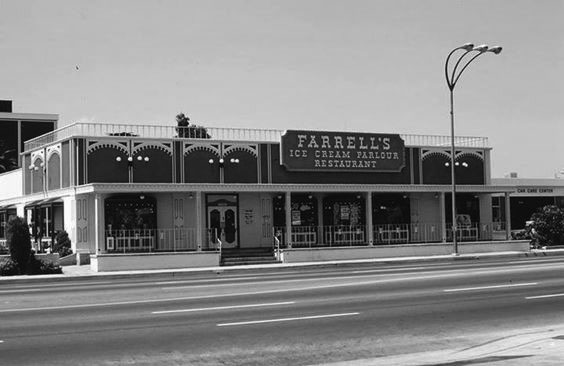 |
|
| (1978)* – 3-headed streetlight in front of Farrell's Ice Cream Parlour on Van Nuys Boulevard. At nighttime, this stretch of Van Nuys Boulevard was perfect for 'Cruising'. |
Hollywood Specials
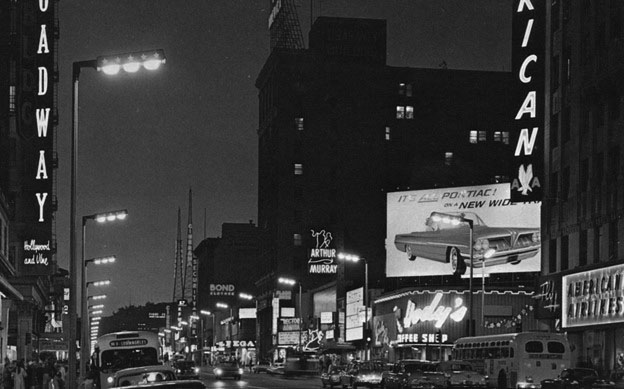 |
|
| (ca. 1964)* – View looking west on Hollywood Boulevard at Vine Street. The new 3-bulb ‘Hollywood Specials’ streetlights line both sides of the boulevard. The billboard above Hody’s Coffee Shop (NW corner of Hollywood and Vine) is advertising the new 1964 Pontiac convertibles. |
Historical Notes The most colorful of the postwar lights is the Hollywood Boulevard Special. Beginning around 1960 the existing electroliers on Hollywood Boulevard were reconstructed. The original pole bases and shafts were retained, but the lamps were replaced by luminaires on short arms. The Hollywood Special is a rectangular housing, over seven feet in length, in which three lamps are housed. The face of each side of the housing is adorned by red stars.^ |
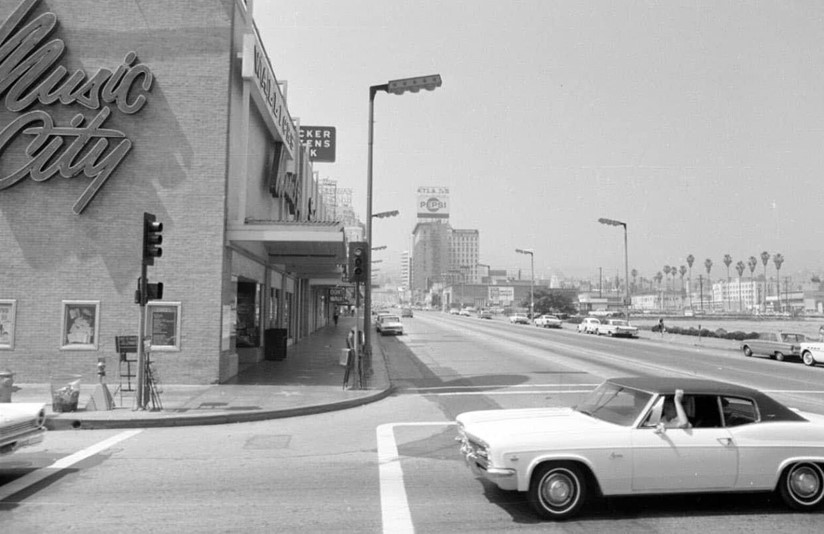 |
|
| (1965)* - Looking north on Vine Sreet at Sunset Blvd showing ‘Hollywood Special’ streetlights running on both sides of Vine as far as the eye can see. Also seen here is Wallichs Music City on the NW corner. Photo by Ed Ruscha. |
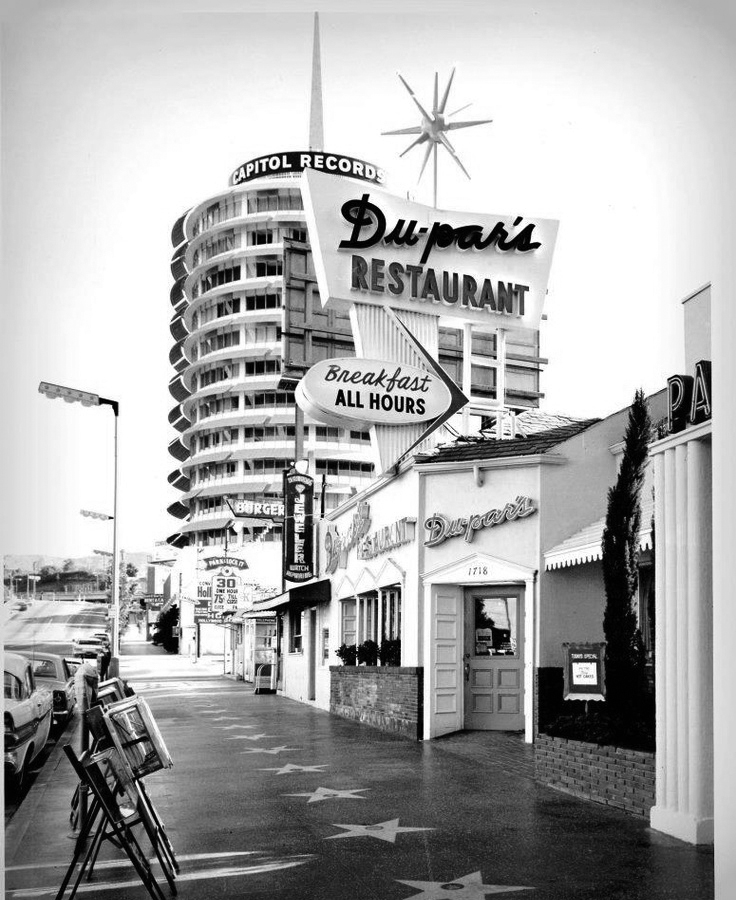 |
|
| (1960s)^ - Hollywood Specials with their 3-bulb design run along Vine Street in Hollywood. This view is looking north on Vine St. just north of Hollywood Blvd. Du-par's Restaurant is open for business: Breakfast ALL HOURS. In the background stands the iconic Capitol Records Building. |
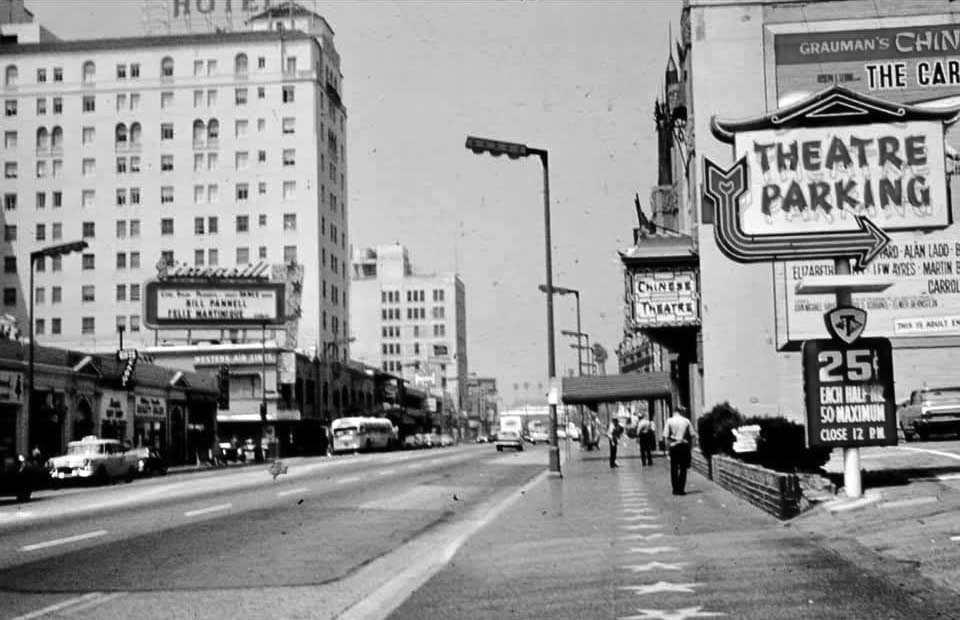 |
|
| (1964)^ – View looking west on Hollywood Boulevard from in front of Chinese Theatre parking lot showing Hollywood Specials streetlights as far as the eyes can see. The Roosevelt Hotel can be seen at upper-left. |
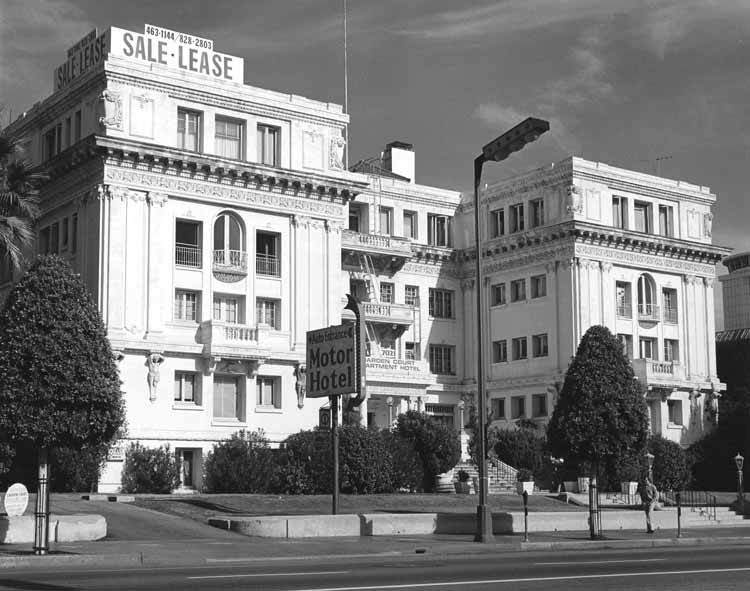 |
|
| (1976)* - View of a 3-lamp streetlight in front of the Garden Court Apartments (Hotel) on Hollywood Blvd. This unique electrolier (Hollywood Special) remained the predominant streetlight along Hollywood Boulevard for over three decades. |
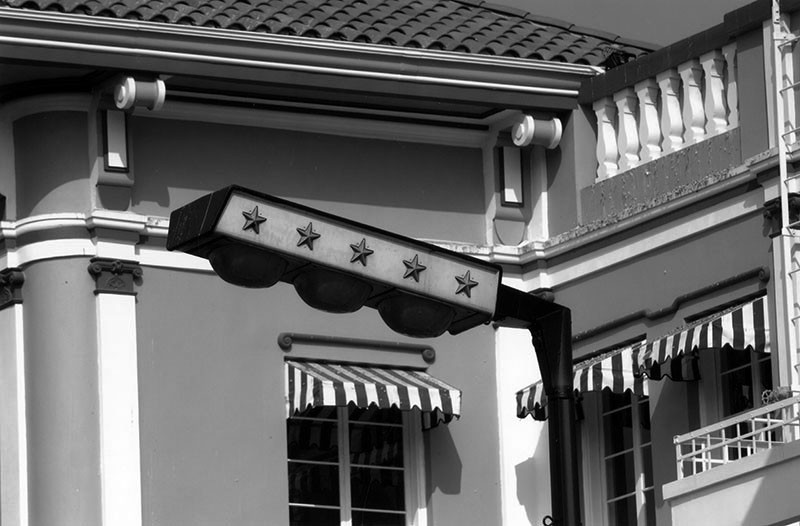 |
|
| (2005)^ - Close-up view of a Hollywood Special streetlight embellished with five stars along the side of its lamp housing. The building behind the streetlight is the Hudson Apartments (formerly The Historic Hillview Apartments), a 54-unit apartment complex located at 6533 Hollywood Blvd. |
 |
|
| (2005)^^*- Close-up view showing a Hollywood Special 3-lamp streetlight head being replaced in front of the Roosevelt Hotel. |
* * * * * |
Wilshire Double
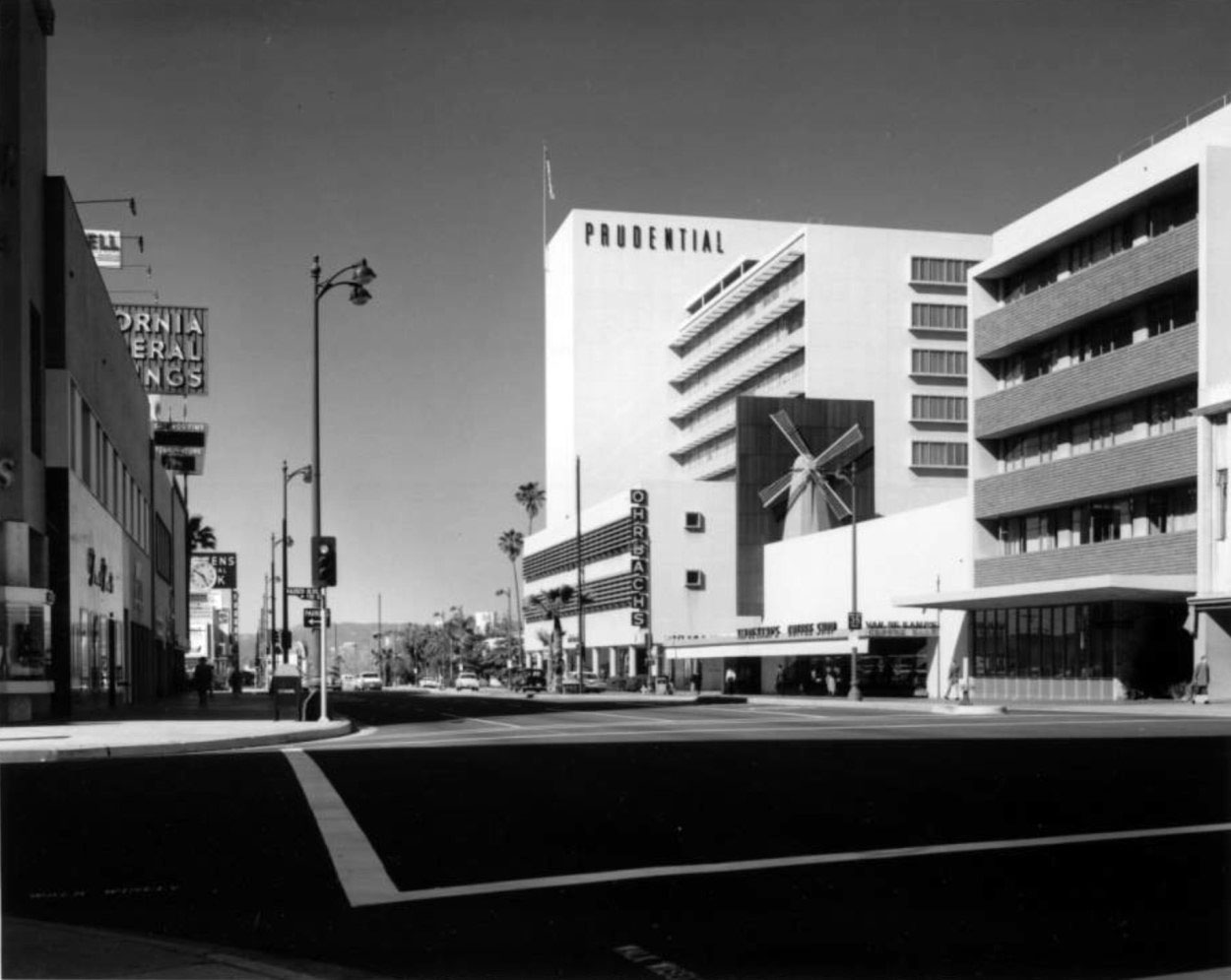 |
|
| (1959)^^ – View looking west on Wilshire Boulevard from Hauser Boulevard. A two-headed specialty light (Wilshire Double) lines both sides of the Boulevard. The windmill of the Van de Kamp's restaurant can be seen on the north side of the street with the Prudential Building behind it. |
Historical Notes An example of the transition from the pendant to the davit is the two headed specialty light (CD-950), dating from the mid-1950s, which can be found along Wilshire Boulevard, from Fairfax Avenue to beyond Wilton Place. It is significant for its use as an updated specialty electrolier to continue the tradition of the Wilshire Special of the late 1920s. While in form close to the pre-war pendants, the luminaires are not teardrop in shape, indicating the use of early optical assemblies. Also new is the side-by-side mounting, rather than the front-and back position as found in the Broadway pendants of the late 1940s.^ |
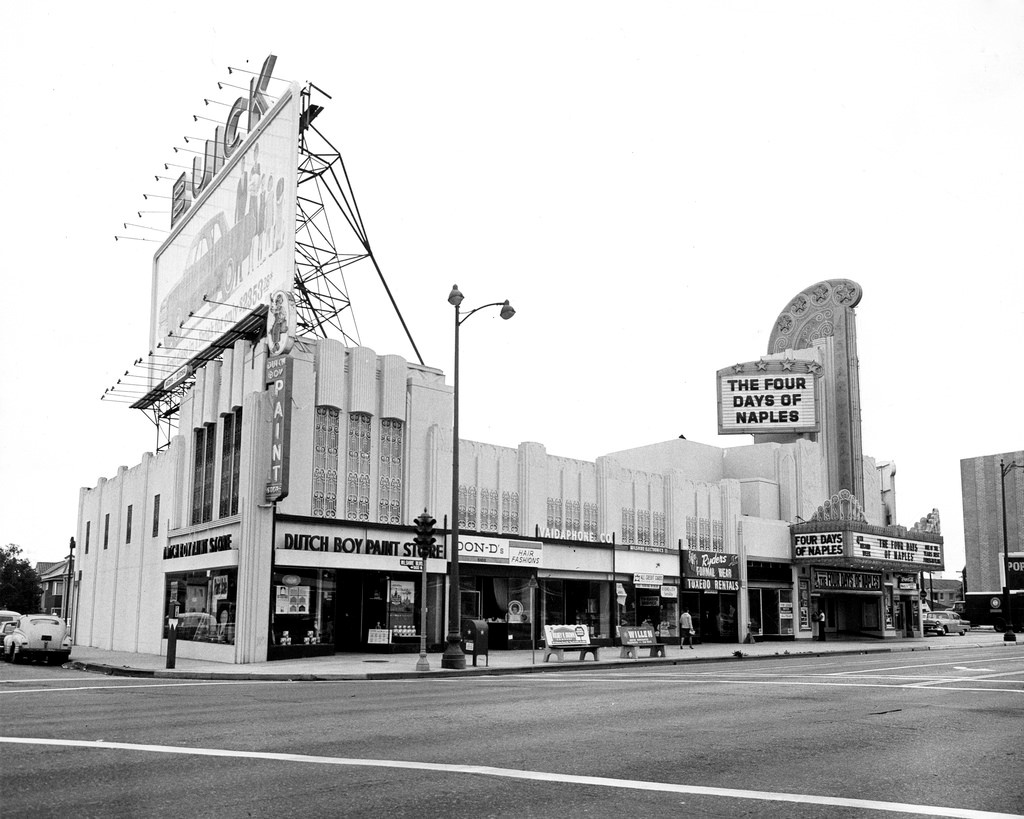 |
|
| (ca. 1962)^.^ – View looking at the southwest corner of Wilshire and Mansfield Ave showing the Four Star Theatre. Coincidentally, the theater is showing “The Four Days of Naples”. A Wilshire Double Streetlight stands in front of the Art Deco building. |
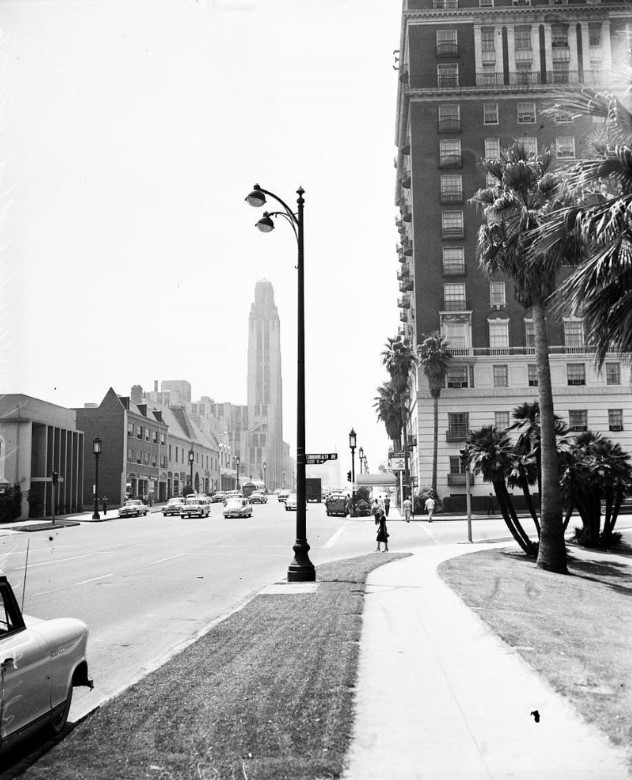 |
|
| (1956)*^ - View looking west showing a "Wilshire Double" electrolier on the NE corner of Wilshire Boulevard and Commonwealth Avenue. The old “Wilshire Special” streetlights are seen in the background. The Bullock's Wilshire Building tower stands in the distance while the historic Town House Building is seen across the street on the NW corner. |
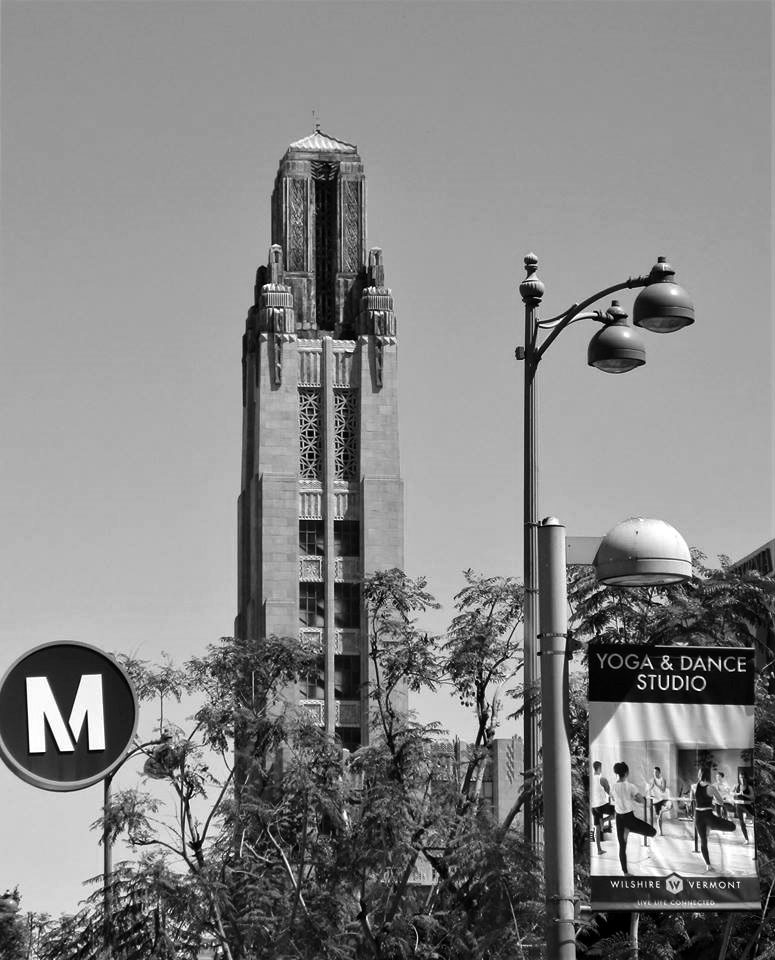 |
|
| (2019)^.^ - A Wilshire Double stands next to a lower profile electrolier in front of the Metro yard at Wilshire Blvd and Westmoreland Ave with the iconic Bullock's Wilshire Building in the background. Photo by Howard Gray |
Vine Double
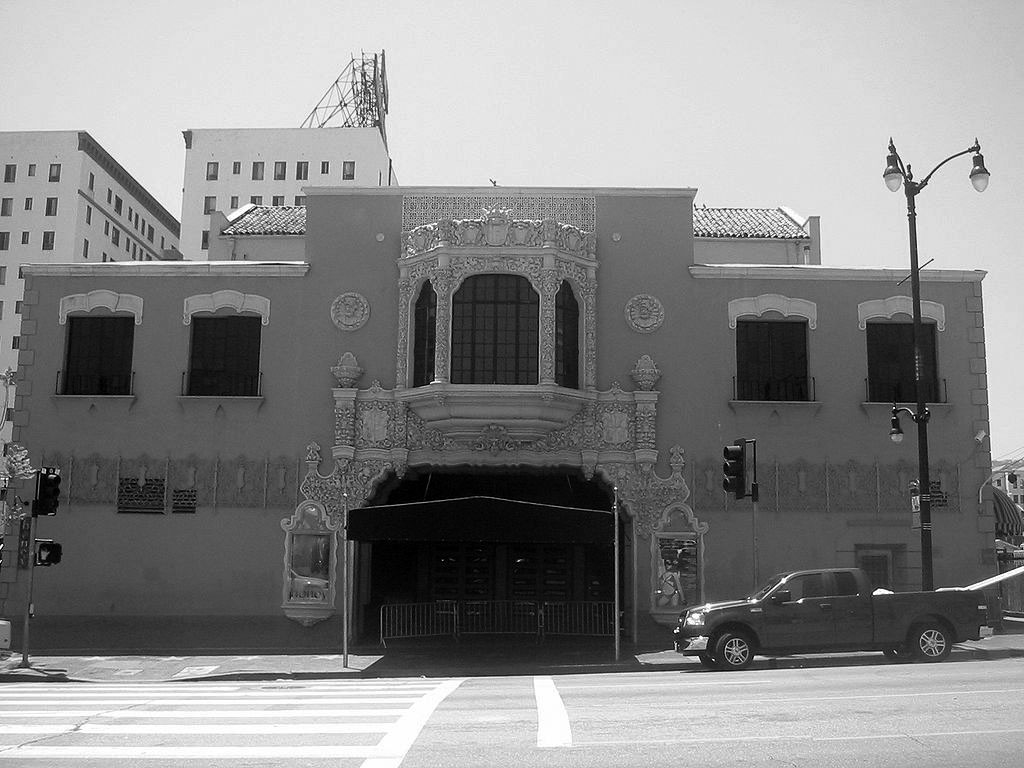 |
|
| (2007)^* - An double-headed electrolier stands near the front of the Avalon (formerly the Hollywood Playhouse) at 1735 N. Vine Street near Hollywood and Vine. The streetlight actually consists of three lamps. At the top, a dual-arm configuration has two lamps hanging over the street area. At the post's mid-span, another lamp extends out over the sidewalk. |
Historical Notes The double heads date from 2005, reminiscent of the scroll-arm teardrops that started populating the area around 1946. The shafts and bases on Hollywood Blvd. (dubbed the CD 920 by the LABSL) date from 1948. Vine Street didn't get its CD 920s until around 1960, when the famous 5-Star street lights were installed as part of the Hollywood Walk of Fame project. |
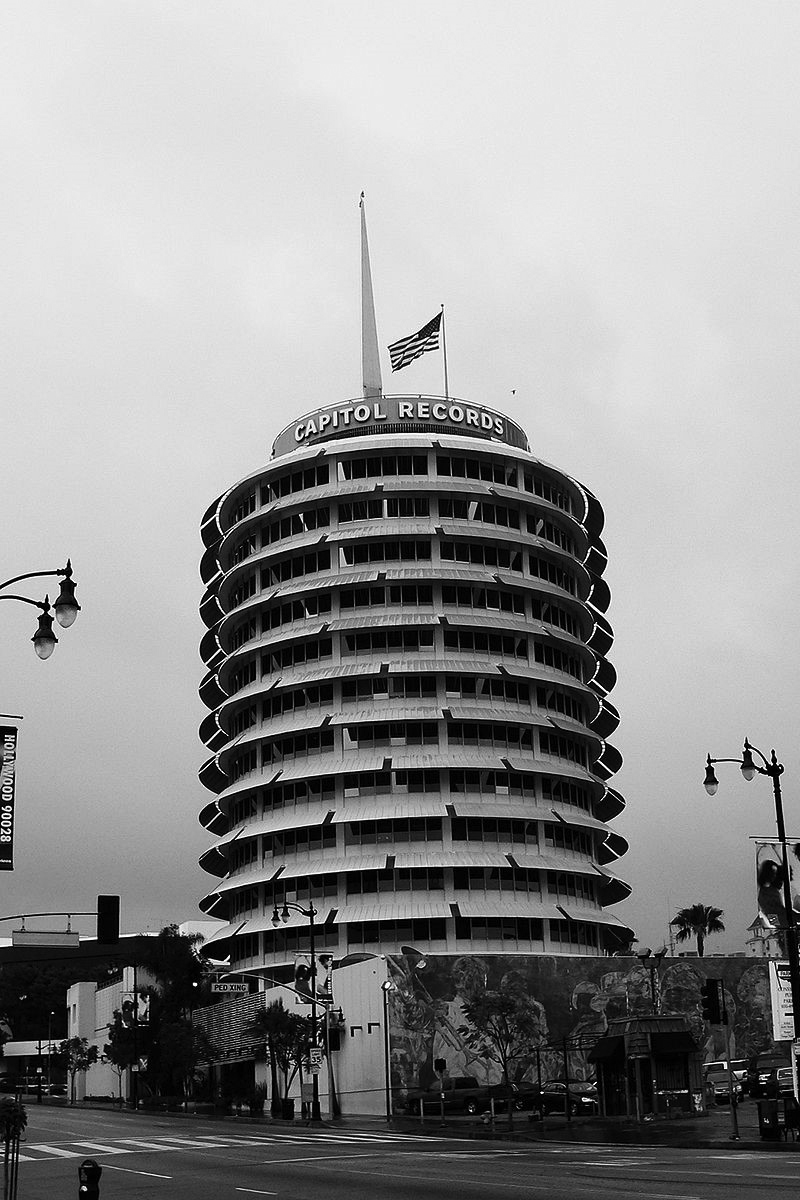 |
|
| (2006)*^ - View looking northeast showing "Vine Double" streetlights running down both sides of the street with the Capitol Records Building seen in the background at 1750 N. Vine Street. |
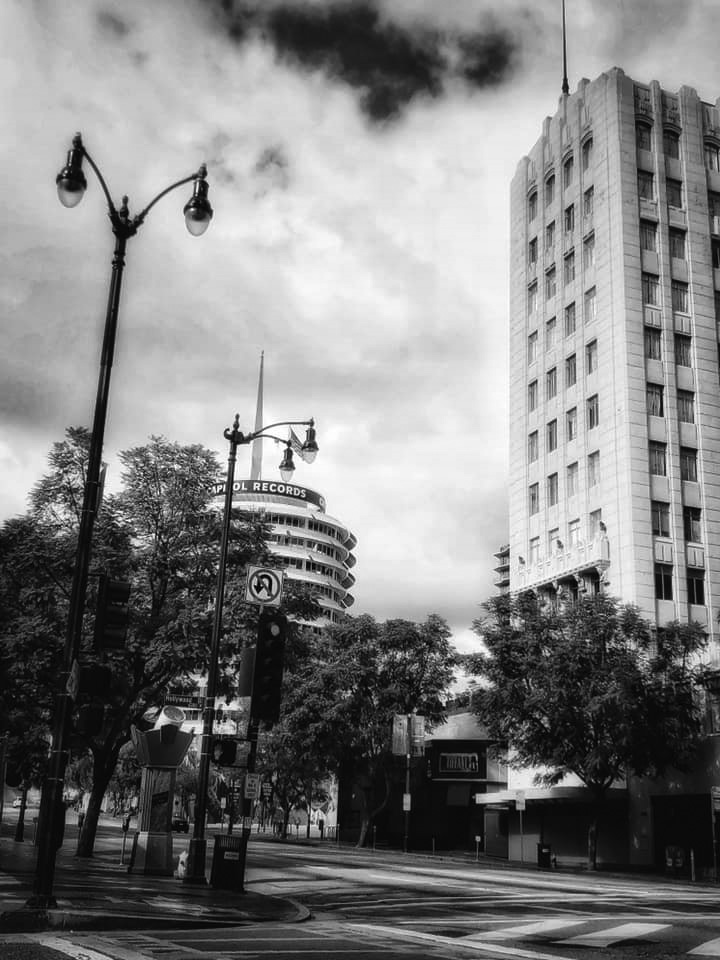 |
|
| (2020)^.^ - View showing a couple of “Vine Double” streetlights on the NW corner of Hollywood and Vine with the Capitol Records Building and the Equitable Building in the background. Photo by Carlos G. Lucero |
Historical Notes The curved two-arm pendants are connected to assemblies resembling a 'genie lamp'. |
 |
|
| (2022)^ - Clock and Lofts at Hollywood and Vine sign extends from the corner of the Equitable Building (NE corner of Hollywood and Vine). A “Vine Double” streetlight stands behind the sign. |
Historical Notes Hollywood’s historic Equitable Building has been transformed into condominium units with views of the Capitol Records tower and the iconic Hollywood sign. The original building was completed in 1930 and was home to the powerful Hollywood agent Myron Selznick. |
* * * * * |
Chinatown
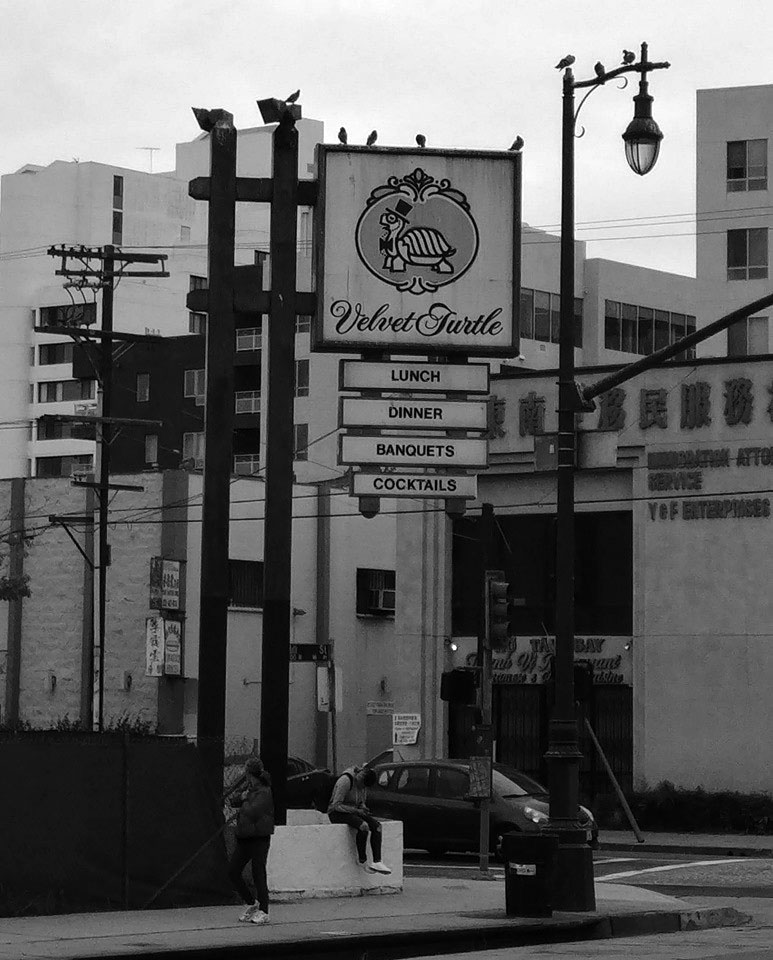 |
|
| (2019)^.^ – View looking at a combination streetlight-traffic signal on the NE corner of Hill and Ord streets in Chinatown. The ornate single pendant teardrop-shaped lamp is adjacent to a large Velvet Turtle Restaurant sign with pigeons on top of both. |
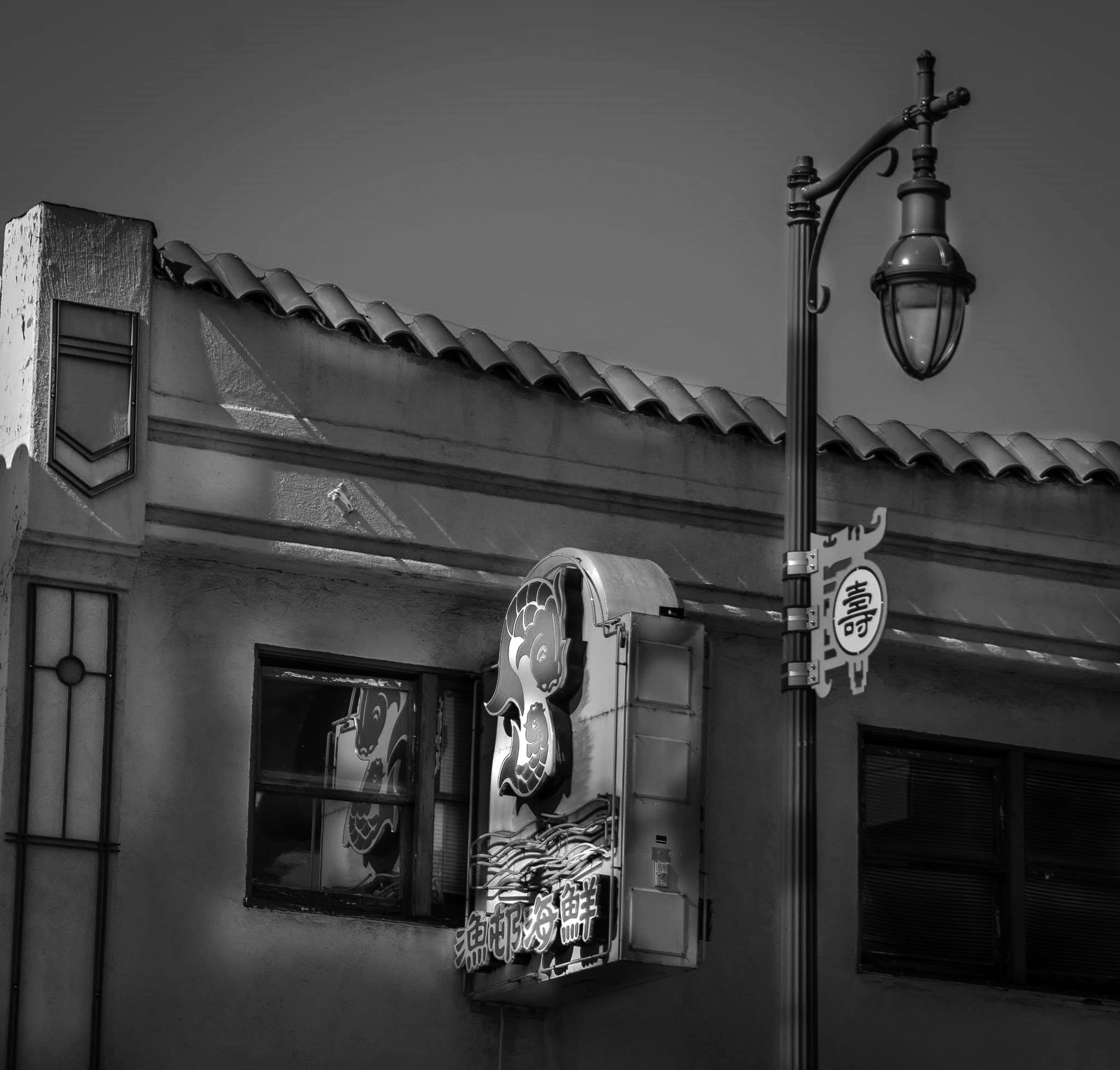 |
|
| (2021)* - Single pendant teardrop streetlight in Chinatown. Photo by Yevgeniy Durets |
* * * * * |
Mulholland Bridge Lighting
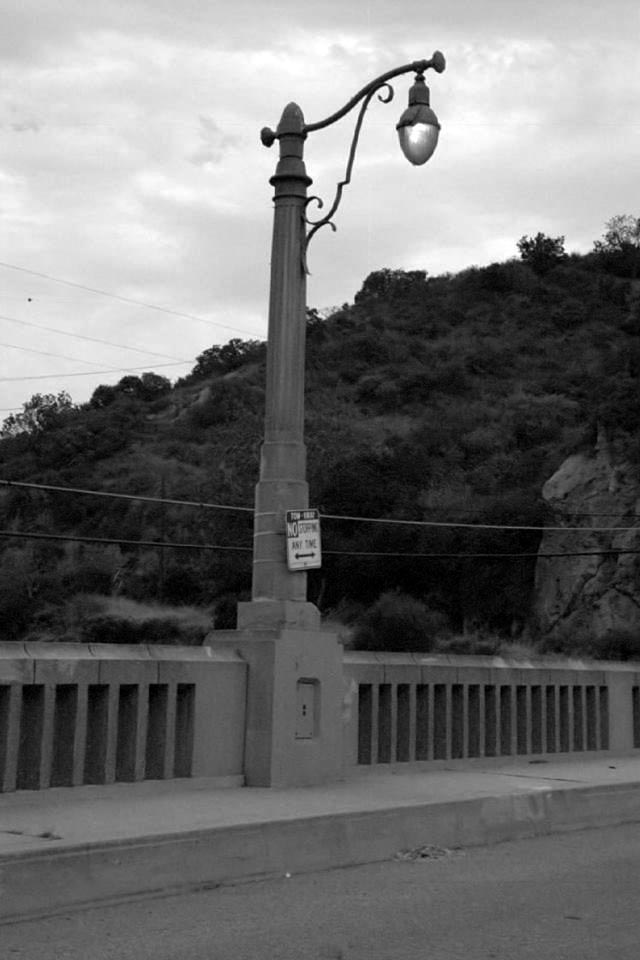 |
|
| (ca. 2003)^ – Streetlight on the Mulholland Bridge over the Hollywood Freeway in Cahuenga Pass. The pendant form teardrop-shaped lamp is facing downward and suspended from a short arm. |
Historical Notes The pendant could make good use of the early High Intensity Discharge (HID) lamps becoming increasingly common by the late 1930s. In place of a filament, the HID lamp ignited a gas. The most common in the early years of the HID was mercury vapor. It was a practical lamp by 1938, providing 400 watts of power. It had a life of almost four years, compared to the incandescent which could last six to eight months.^ |
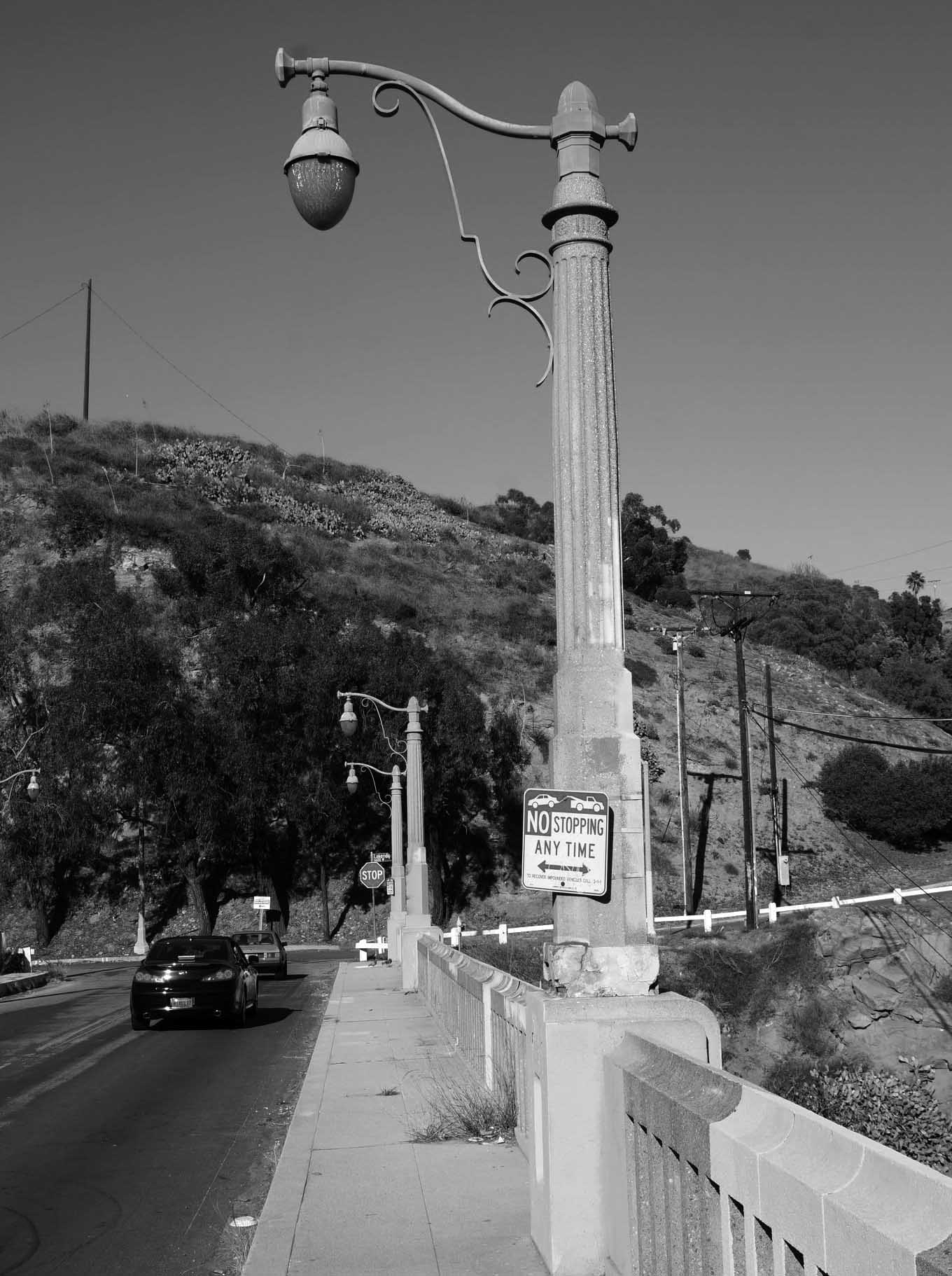 |
|
| (ca. 2010s)^ – Mulholland Bridge streetlights. Photo by Glen Norman |
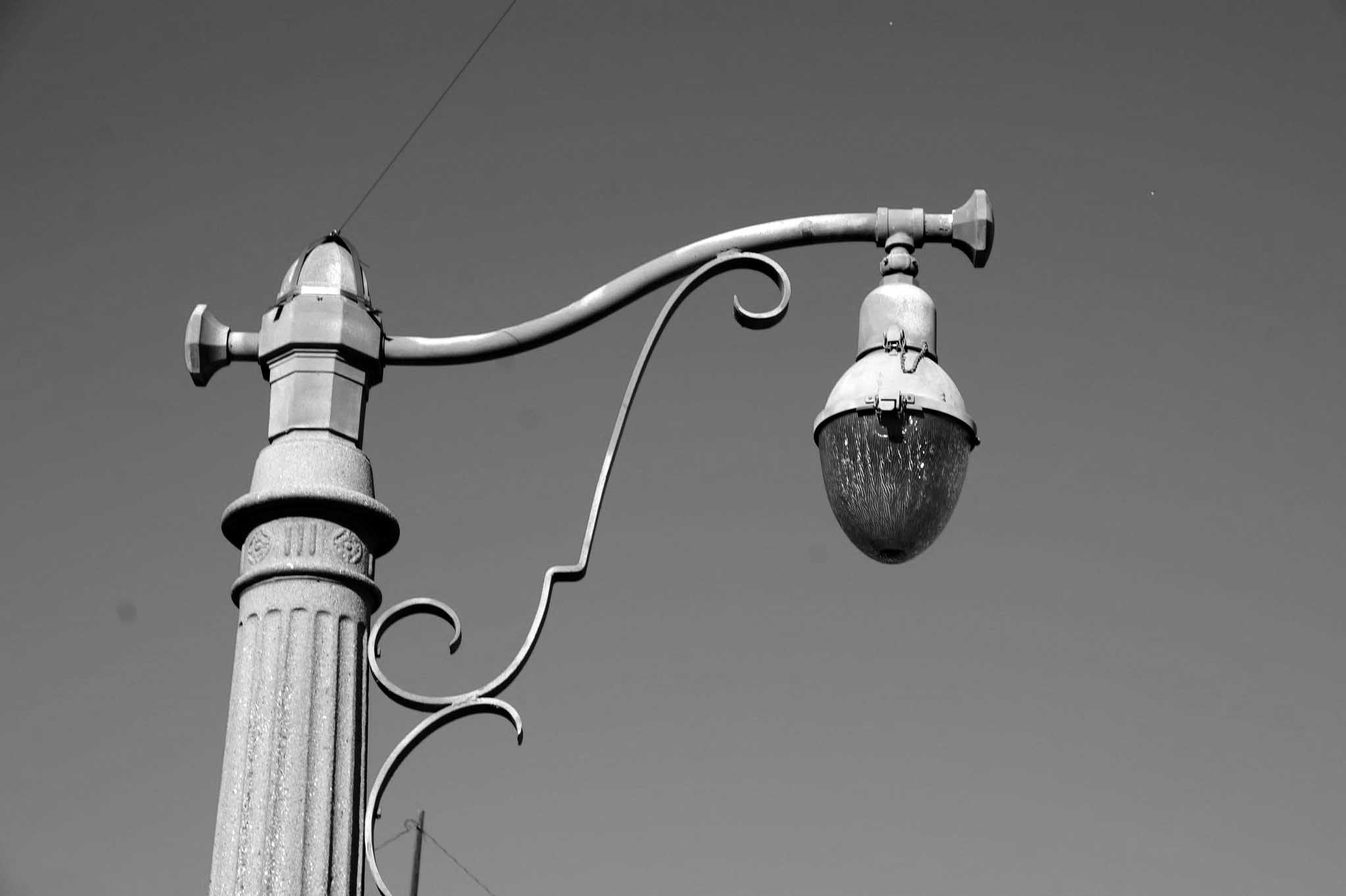 |
|
| (ca. 2010s)^ – Close-up view showing streetlight on Mulholland Bridge at Chauenga Pass. Simple but beautiful! Photo by Glen Norman |
Fourth Street Viaduct
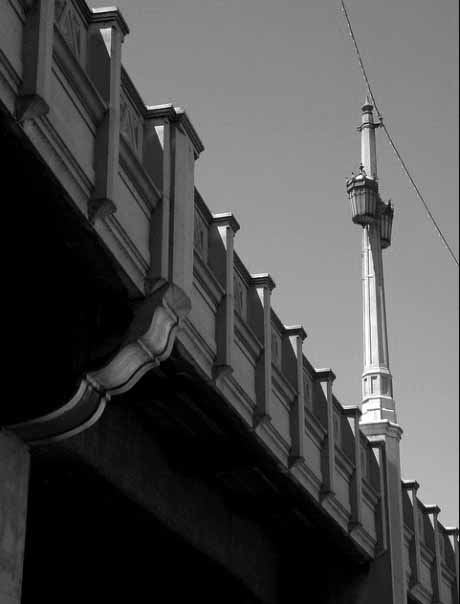 |
|
| (2008)*#*- View of the ornate dual-lamp streetlight on the 4th Street Viaduct near downtown Los Angeles. |
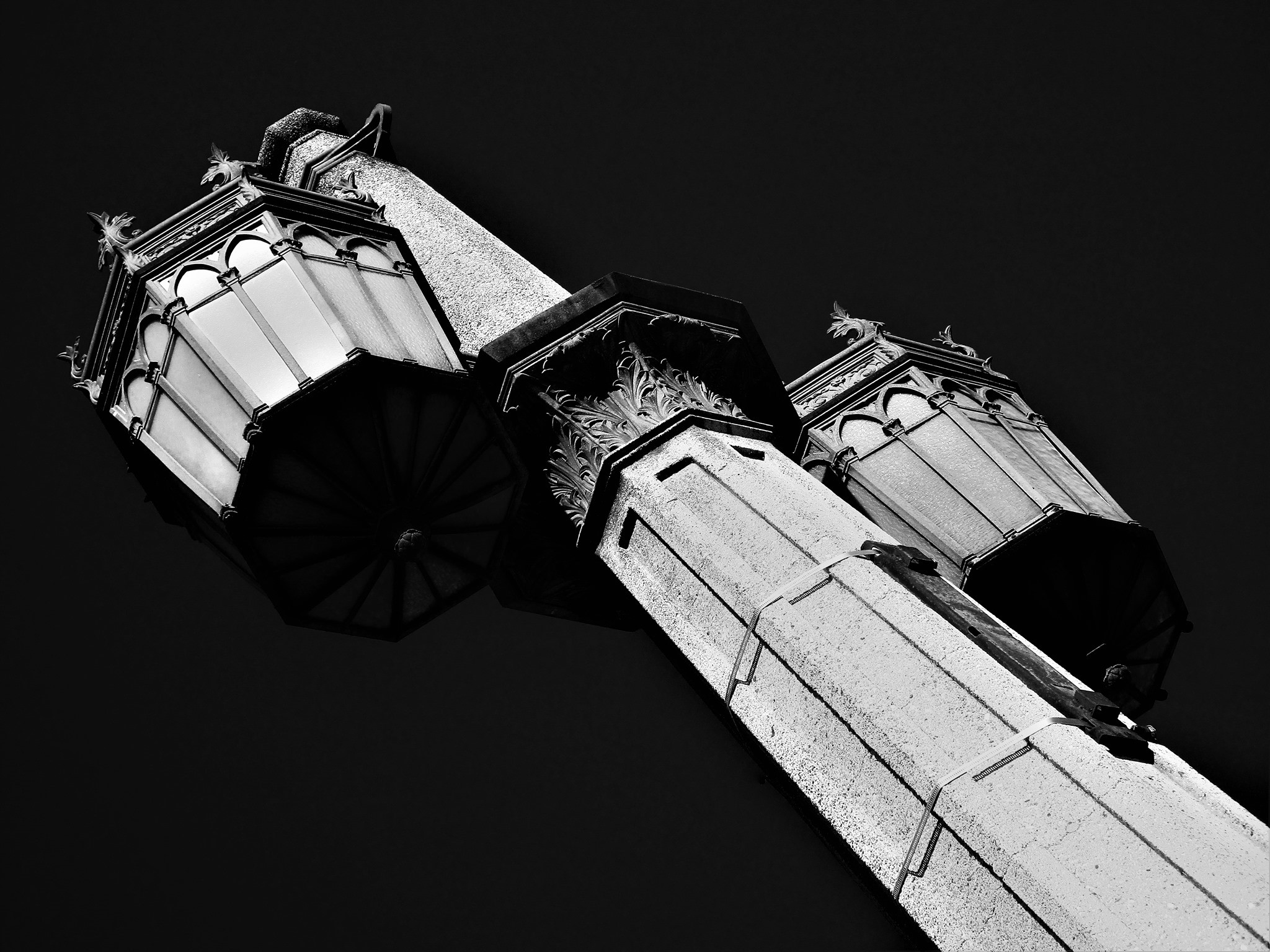 |
|
| (2020)^.^ - Looking up to the top of the ornate dual-lamp streetlight on the 4th Street Bridge. Photo by Howard Gray |
.jpg) |
|
| (2008)* - Detailed view of one of the beautiful sets of dual-lamp fixtures on the 1931 built 4th Street Viaduct (Bridge). Photo courtesy of Steve and Michelle Gerdes |
Historical Notes See More Bridge Lighting (College Street Bridge; First Street Bridge; Fourth Street Viaduct; Fourth and Lorena Streets Bridge; Glendale-Hyperion Bridge; Macy Street Bridge; Mulholland Bridge; Sixth Street Bridge; Washington Blvd Bridge) |
* * * * * |
Please Support Our CauseWater and Power Associates, Inc. is a non-profit, public service organization dedicated to preserving historical records and photos. Your generosity allows us to continue to disseminate knowledge of the rich and diverse multicultural history of the greater Los Angeles area; to serve as a resource of historical information; and to assist in the preservation of the city's historic records.
|
More Historical Early Views
Newest Additions
Early LA Buildings and City Views
History of Water and Electricity in Los Angeles
* * * * * |
References and Credits
* DWP - LA Public Library Image Archive
^ LA Public Library Image Archive
^^Bureau of Street Lighting Image Archive
#*Library of Congress: 4th and Lorena Street Bridge Light
#^San Fernando Valley History Digital Library - CSUN Oviatt
#+Facebook.com: Classic Hollywood/Los Angeles/SFV
***Huntington Digital Library Archive
*^^Nuestra Señora la Reina de los Ángeles - losangelespast.com
^^*Noirish Los Angeles - forum.skyscraperpage.com; Windsor-Wilshire
^^^California State Library Image Archive
^**Vintage Los Angeles: Trocadero Nightclub ; Hollywood and Vine
*^*Photo Ramblings - Garth Buckles
^*^Mail Online - Daily Mail Reporter
^#^LA Times: Amestory Building
*#*Flicker: smgerdes - 4th Street Bridge Lights
*#^LAPL-El Pueblo de Los Angeles Historical Monument Photo Archive
^#*Facebook.com - Los Angeles Theatres: Warner Bros. Downtown
**#San Fernando Valley Relics - Facebook.com: Van Nuys Blvd., Ca. 1940
^^#Flickr.com: Michael Ryerson
*^#Facebook.com - Bizarre Los Angeles
^*#California State Library Image Archive
*##Facebook.com: Garden of Allah Novels – Martin Turnbull
^##Boyle Heights History Blog: Introduction of Electric Light to Boyle Heights
+##MartinTurnbull.com: Fairfax and Wilshire
#*^Facebook.com - San Pedro's Original Website, San Pedro.com
#^*Facebook.com: West San Fernando Valley Then And Now
^* Wikipedia: Los Angeles Country Art Museum; Hollywood Playhouse (Avalon Hollywood); MacArthur Park
< Back
Menu
- Home
- Mission
- Museum
- Major Efforts
- Recent Newsletters
- Historical Op Ed Pieces
- Board Officers and Directors
- Mulholland/McCarthy Service Awards
- Positions on Owens Valley and the City of Los Angeles Issues
- Legislative Positions on
Water Issues
- Legislative Positions on
Energy Issues
- Membership
- Contact Us
- Search Index